

16 Ancient Rome Sites & Roman Landmarks to See in Rome, Italy (+Map)
By Author Jurga
Posted on Last updated: September 28, 2023

Ancient Rome – the civilization dating from the founding of the city of Rome in 753 BC until the collapse of the Roman Empire in the 5th century AD – has had a big influence on the world. It has inspired and influenced so many generations and continues to do so today…
No matter how many books you read and how many movies you saw, there is no better way to get acquainted with this fascinating culture than by visiting some of the ancient Roman landmarks in Rome, Italy!
In this guide, you can learn about the best Ancient Rome sites that you can still see in Rome today . Some of them – such as the Pantheon or the Colosseum – are world-known and are among the most popular places to see in Rome . Quite a few other remaining Roman landmarks are lesser-known and could be qualified as the hidden gems of Rome , often overlooked by tourists… But they are all worth seeing!
Whether you are fascinated by the Ancient Rome civilization, are interested in antique Roman architecture, or simply want to see some of the most impressive Roman landmarks and learn the stories behind them, this list will give you a good idea of the places that are worth visiting the most.
To help you plan your time, we also created a map indicating the best Ancient Rome landmarks in Rome . You can find this map at the bottom of the article.
Even if you just visit a few of these landmarks, you’ll appreciate so much better how special and unique Rome really is. It’s not for nothing that it’s called the Eternal City.
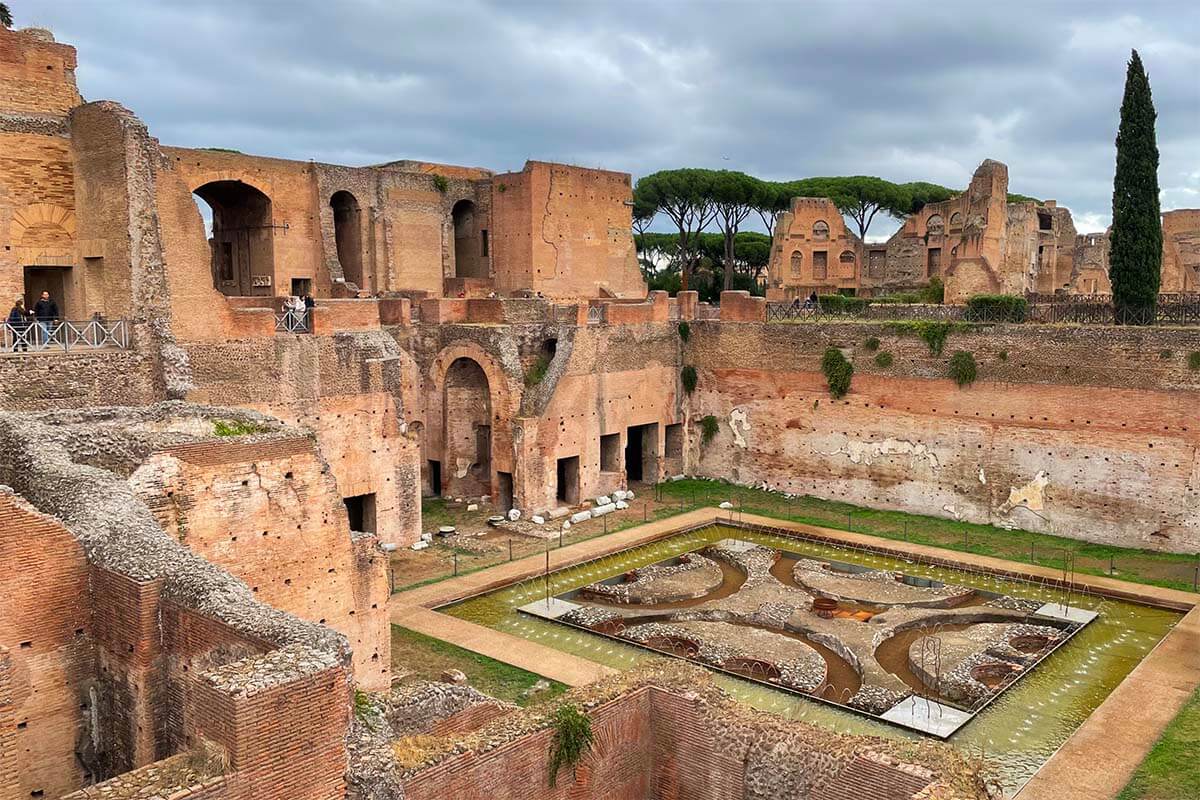
Good to know: Please note that in this guide we only mention some of the best-preserved and most important Ancient Rome landmarks that are located in or just near the city of Rome.
We also tried to sort this list by age, starting with the oldest Roman landmarks first. However, it’s not always possible to determine the exact dates. Furthermore, some archeological sites contain more than just one building (each dating from different periods), and others were built and rebuilt or their development spanned over several centuries…
So the timeline is only meant to give you an idea of how Ancient Rome developed over the centuries. It should give you a better insight into how old and unique these antique Roman sites really are…
Take a look!
Here are some of the best ancient Roman landmarks you can see in Rome today:
1. Palatine Hill & Roman Forum
The origins date from around the 10th century BC. Some of the oldest Roman temples (7-8th century BC) were located in this area as well.
The Roman Forum (Forum Romanum) and the Palatine Hill (Palatino) are among the oldest places in the city of Rome. It’s in this area that you’ll find most of the ancient Roman landmarks; too many to even try to list them here…
It’s believed that the founders of Rome – Remus and Romulus – were nursed by a she-wolf in a cave – Lupercal – that was located on the slopes of the Palatine. In 2007, this theory was once again confirmed when the archeologists found a vaulted sanctuary deep under the ground that could indeed be the Lupercal.
So if you are looking for the most ancient sites in Rome, this is as good as it gets. The Palatine is literally the birthplace of Rome !
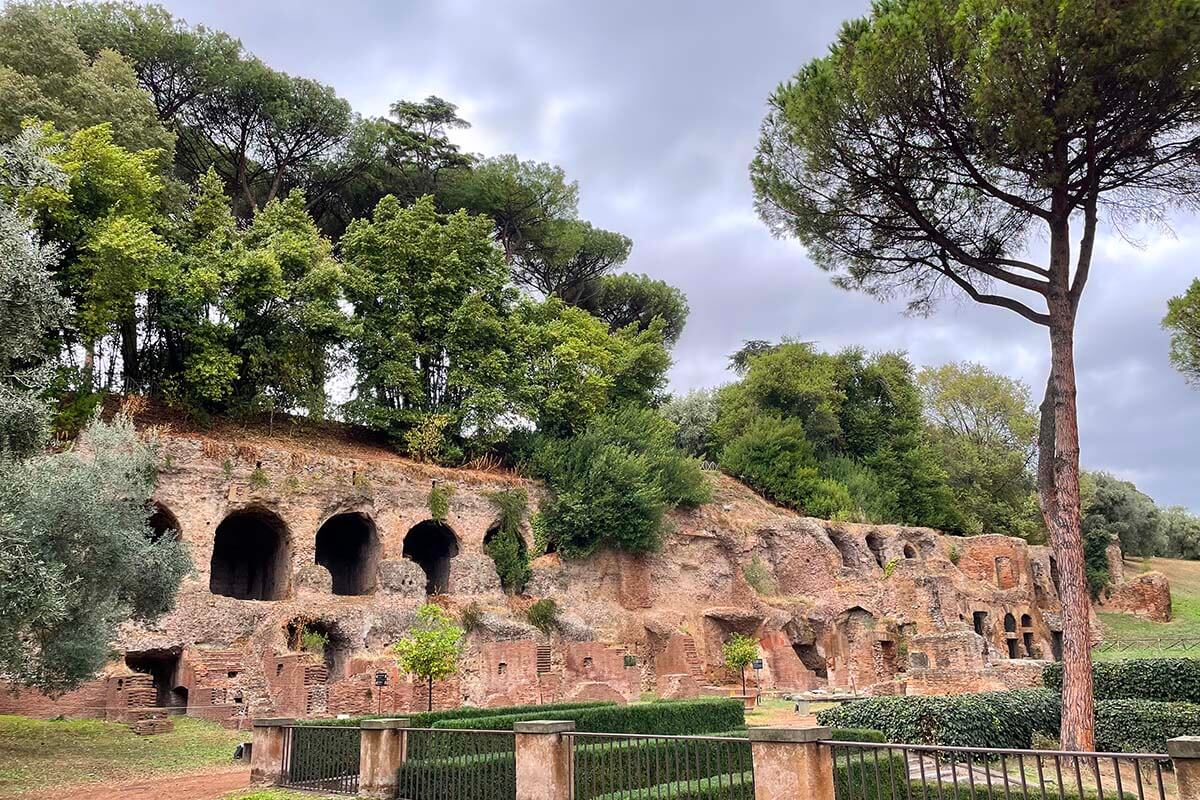
In Ancient Rome, the Palatine was one of the most desirable neighborhoods in the city. The rich and the famous built their palaces here and you can still see some very impressive ruins on the Palatine.
Right next to it is the Roman Forum, the bustling heart of ancient Rome. Today, this is a huge archeological site where you can see many of the oldest buildings and monuments of Rome.
How to visit: The Roman Forum and the Palatine are located right next to the Colosseum and an entrance to all these sites is included in the same ticket . You can just walk around on your own, but I highly recommend visiting here with a guided tour . There’s so much to see and it’s a fascinating site, but without knowing what you’re looking at, it’s just a bunch of ruins and stones…
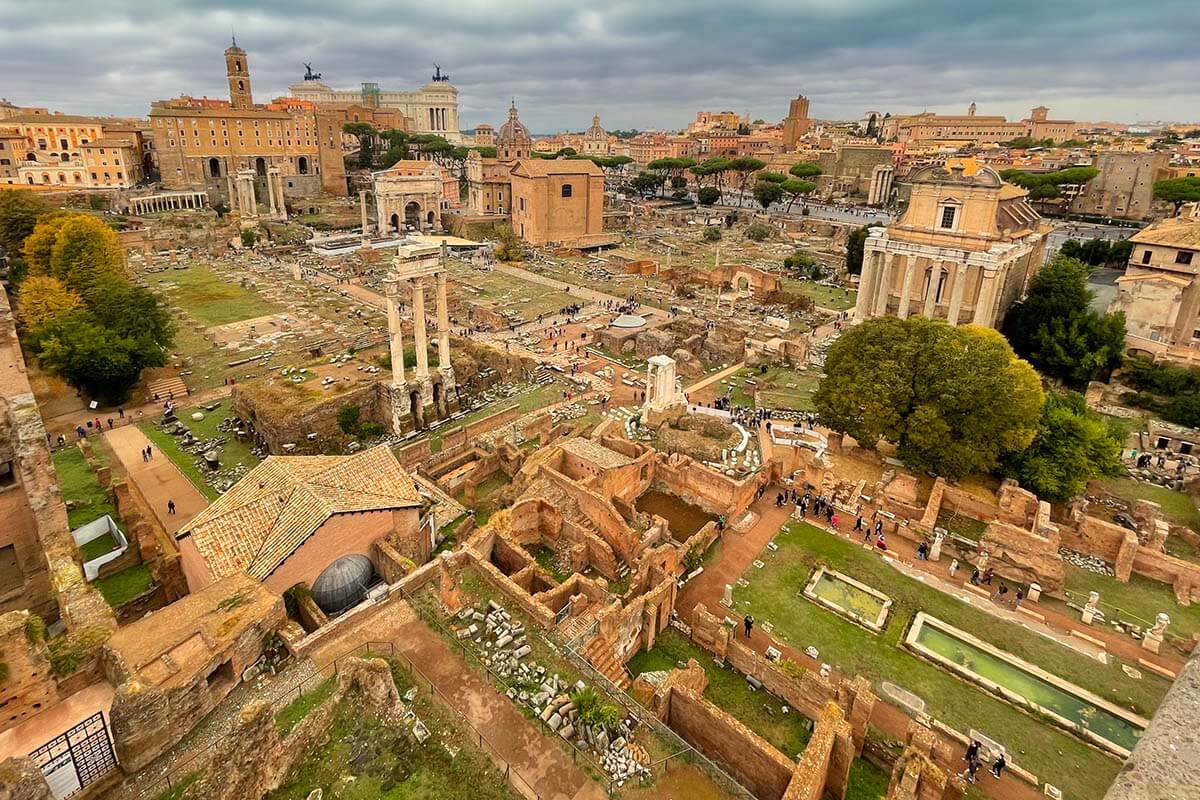
2. Ostia Antica
The origins date from the 7th century BC.
Ostia Antica was an old city, the commercial and military seaport of ancient Rome. The archeological remains found here date to the 3rd- 4th century BC, but some inscriptions are believed to be three centuries older than that.
This is one of the best-preserved ancient Roman cities and a great place to visit if you want to get a better idea of what life was like for ordinary folks in the old Roman times.
In its glory days (2-3rd century AD), over 100,000 people lived in Ostia. After the fall of the Western Roman Empire, the city slowly fell into decay. It was completely abandoned in the 9th century.
Big parts of the old city of Ostia are excavated and you can see the remains of old houses, shops, baths, but also docks and warehouses. One of the most impressive sites is the old Roman theater – Teatro di Ostia.
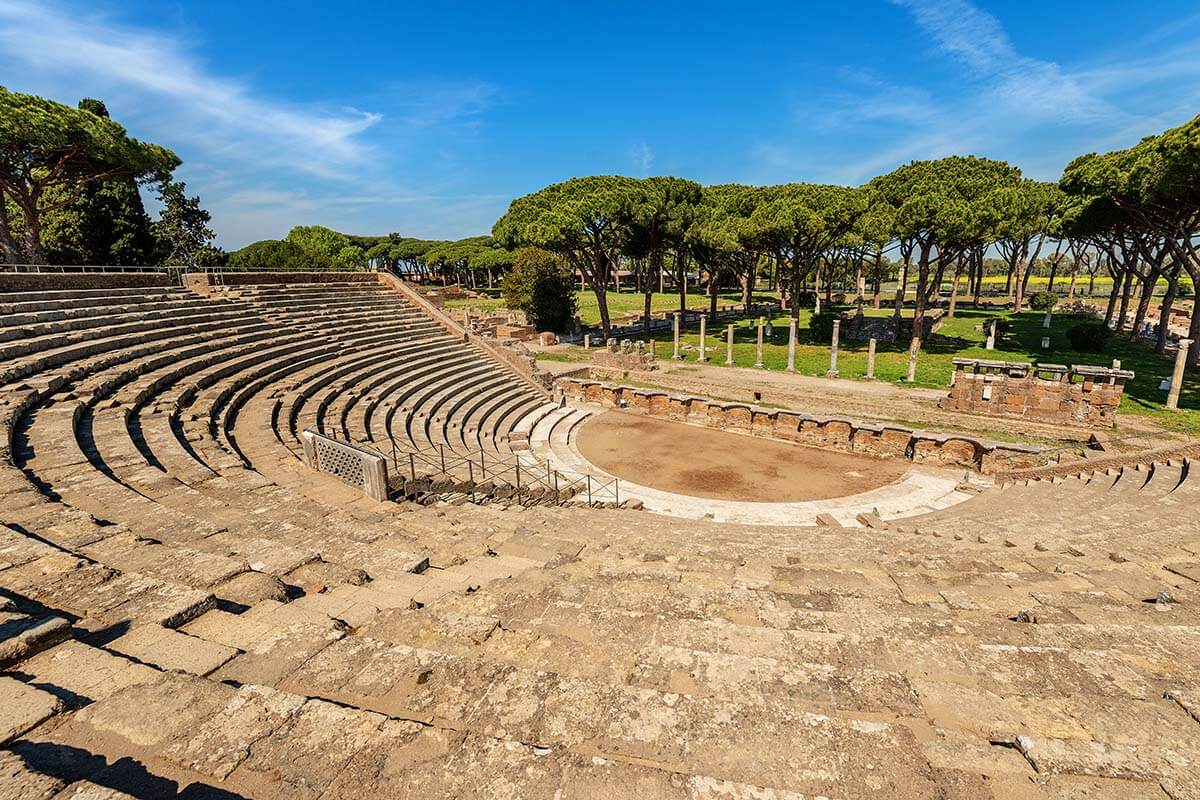
Ostia Antica is often compared to the more famous ancient Roman cities of Pompeii and Herculaneum.
However, these places are located close to Naples, a 2.5-3 hours drive from Rome (they can be visited as a day trip too , but you will need an entire day for that). Whereas Ostia Antica is just 45 minutes drive from the city center. In fact, it’s located very close to Leonardo da Vinci International Airport in Fiumicino.
How to visit: Ostia Antica is the only Roman landmark mentioned in this guide that is located quite a bit further from Rome’s city center. You can get here by taxi or by train, and there are also organized tours. The most popular option is this half-day guided tour by train .
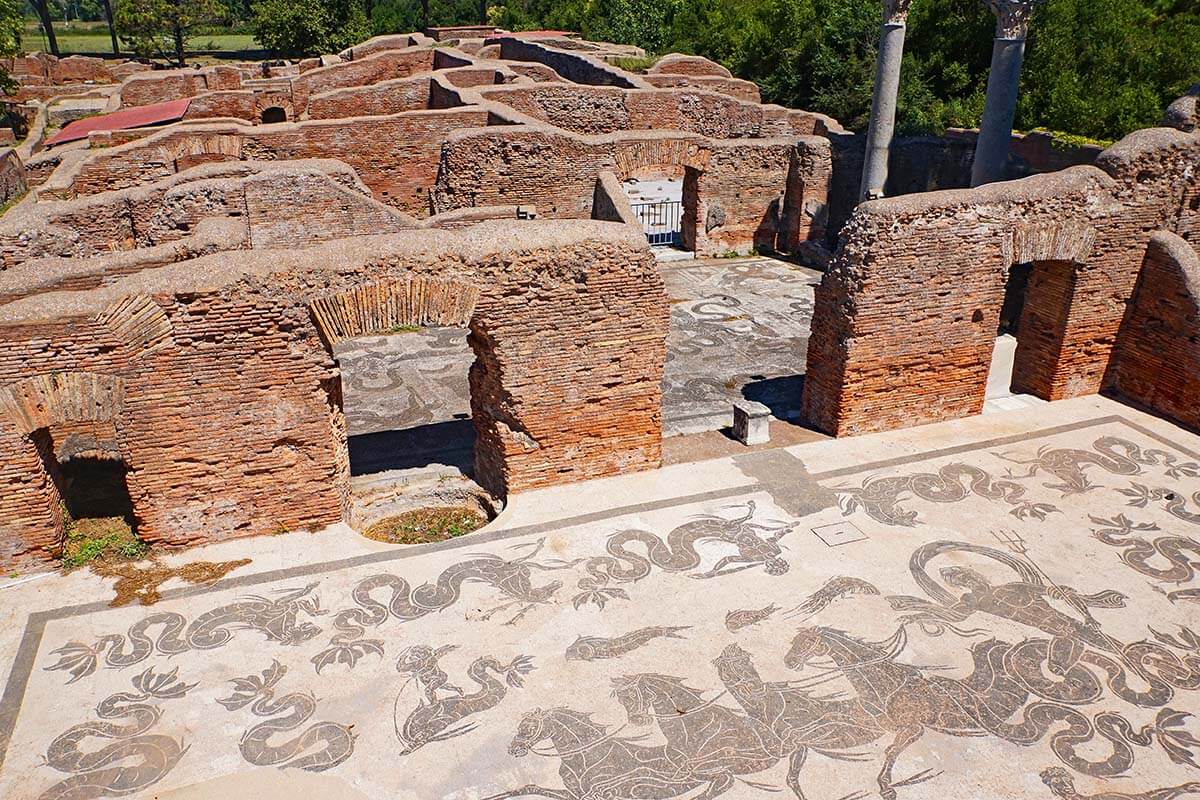
3. Circus Maximus
The origins of Circus Maximus date to Rome’s earliest days. The construction began around the 6th century BC.
Circus Maximus (Circo Massimo) was the largest stadium in Ancient Rome, mainly used for chariot races. It also served as the site of Roman Games, gladiator fights, animal hunts, etc.
Its current distinctive U-shape dates from the times of Julius Caesar who ordered the refurbishing of this arena at around 50 BC. At that time, the stadium could seat about 150,000 spectators.
After the Great Fire of Rome in 64 AD, Circus Maximus was rebuilt and reached its maximum capacity with place for about 250,000 people.
The last chariot races here were held in the 6th century, after which the ancient arena was pretty much abandoned. The area was cleared and turned into a park in the early 20th century and is nowadays sometimes used for concerts and other big outdoor gatherings. A small part of the ancient site is being excavated, but the majority remains under the ground.
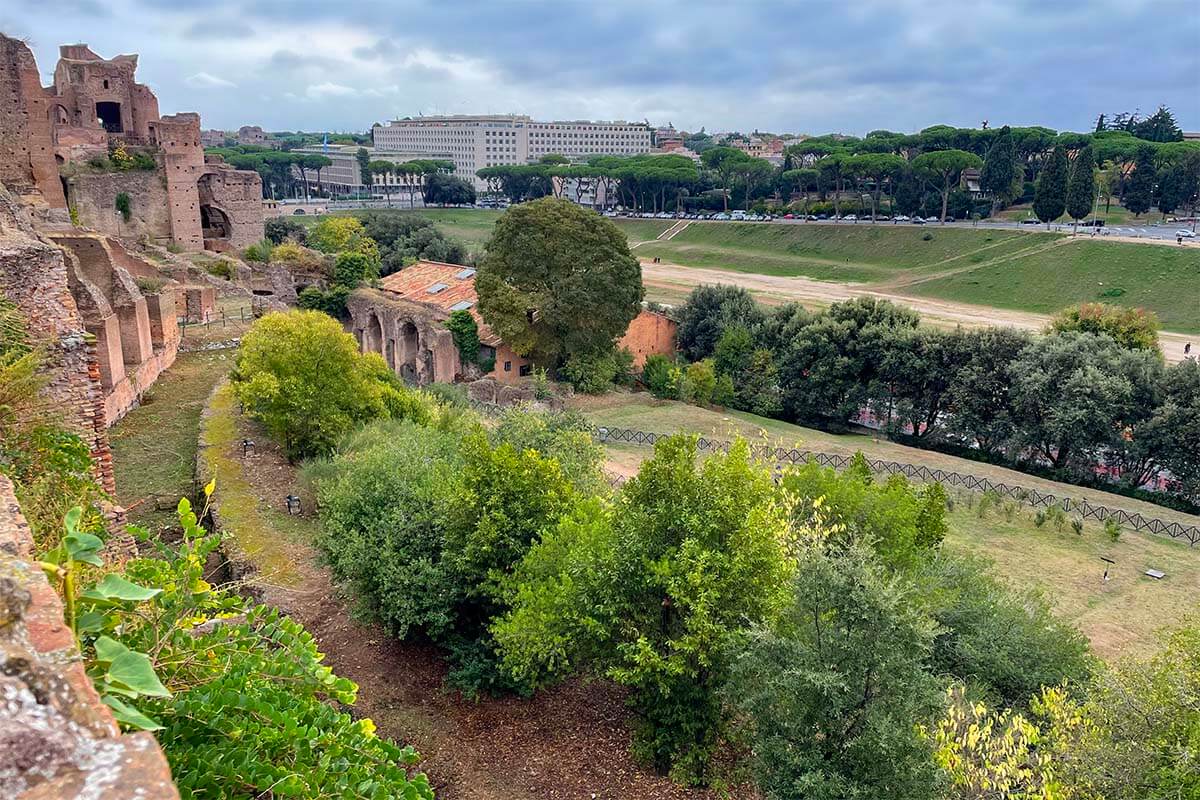
How to visit: Apart from the big open oval space in the middle of the city, there is actually not that much left of the ancient Circus Maximus nowadays. You can see it from an elevated angle from Palatine Hill, and you can also go for a walk here. Some tours also come here. It’s a good way to learn more about the place and the guides usually have pictures showing you what the place looked like, etc.
There may not be much left of it, but as you stand here, it’s easy to imagine a crowd of a quarter of a million people cheering at the chariot races: the noise, the dust, the excitement… It’s well worth seeing Circus Maximus, even if just from a distance. It’s yet another puzzle piece that gives you a better idea of what life was like in Ancient Rome.
TIP: If you are interested in a tour, we recommend this one that visits Circus Maximus and also the Baths of Caracalla (a very interesting ancient Roman site that you can read about further below).
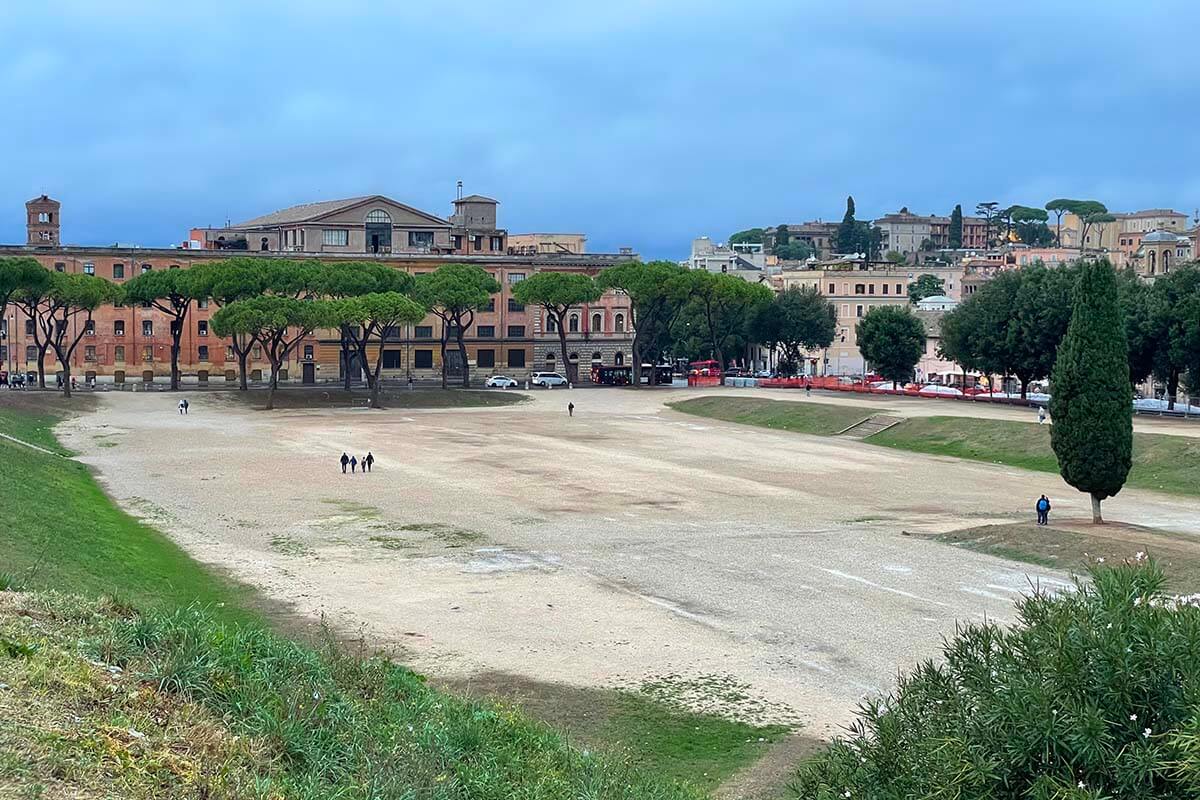
4. Appian Way
Built around 312-264 BC.
Appian Way (Via Appia Antica) is an ancient road that connected the city of Rome to Brindisi in Southern Italy, some 563 km (350 miles) away. Its main purpose was to help the army with the expansion of the Roman Empire.
To me, the Appian way feels the most authentic of all Ancient Rome sites that you can still see today. Built over 2300 years ago, some parts of this road look pretty much as they would have looked back in the old days. There are hardly any signs of modern-day life here, and if you’re lucky to visit on a quiet moment or go just a bit further from the city, you’ll likely be completely alone… It’s magical!
Appian Way is lined with ancient family graves and mausoleums, some of them still standing next to the road today (in the past, it was forbidden to bury people inside the city walls, and it was easy to have a family grave next to a major, easily-accessible way just outside the city).
As you walk or bike on Via Appia, you can easily imagine the Roman military marching here, horses and carriages driving up and down, and families visiting the graves of loved ones… If you’ve seen movies like Spartacus , vivid images of Ancient Rome come to life. It’s a really special place, and if you have a few hours extra, I highly recommend visiting here!
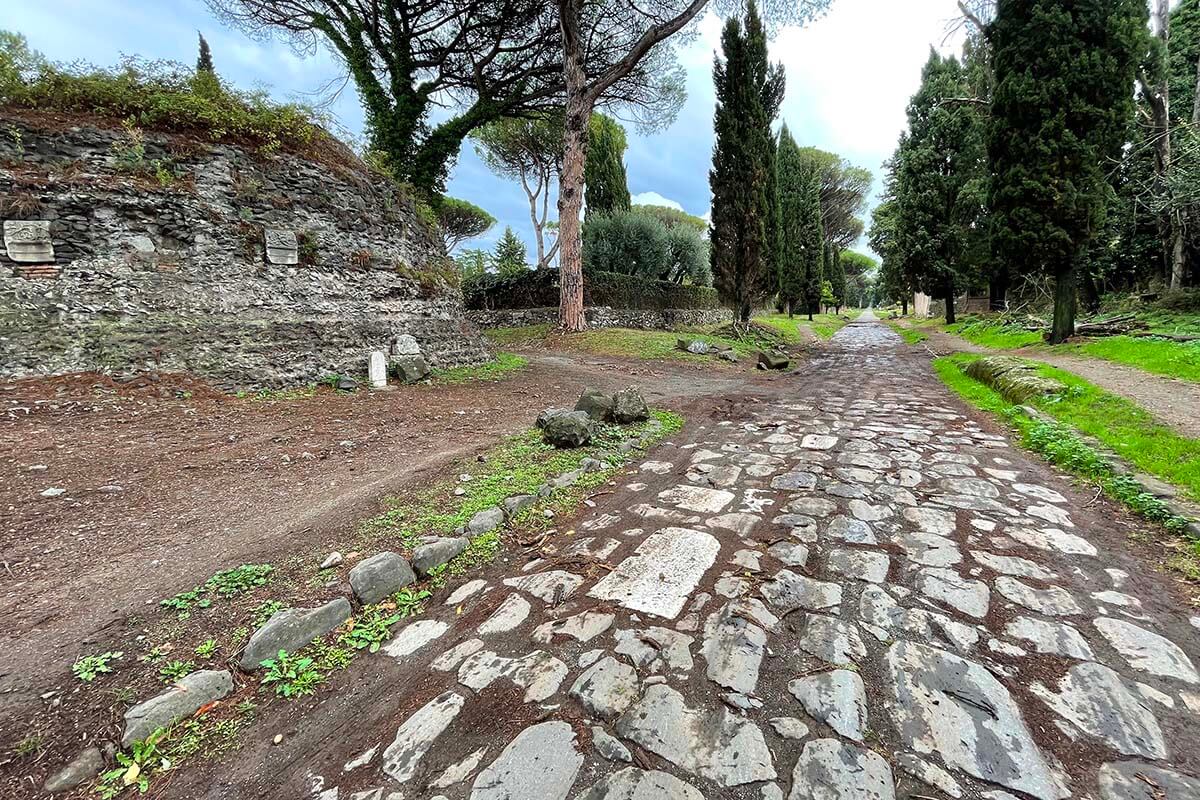
How to visit: The Appian Way is a long road that starts in Rome. The first part closest to the city has changed a lot and looks just pretty much like any other street. And while you don’t have to go very far to find some more authentic parts of this ancient way, it’s not really a place you can easily walk to. It’s best to come here by bus, on a tour, or by bike.
TIP: I highly recommend joining an e-bike tour . Not only is this the best way to get here and explore a bigger section of this unique road, but you’ll also see so much more! It’s also good to visit here with a local guide who knows exactly where to go and will bring you to the most authentic sights.
We visited the Appian Way with this great bike tour that also includes quite a few other ancient Roman landmarks mentioned further in this guide. Highly recommended!
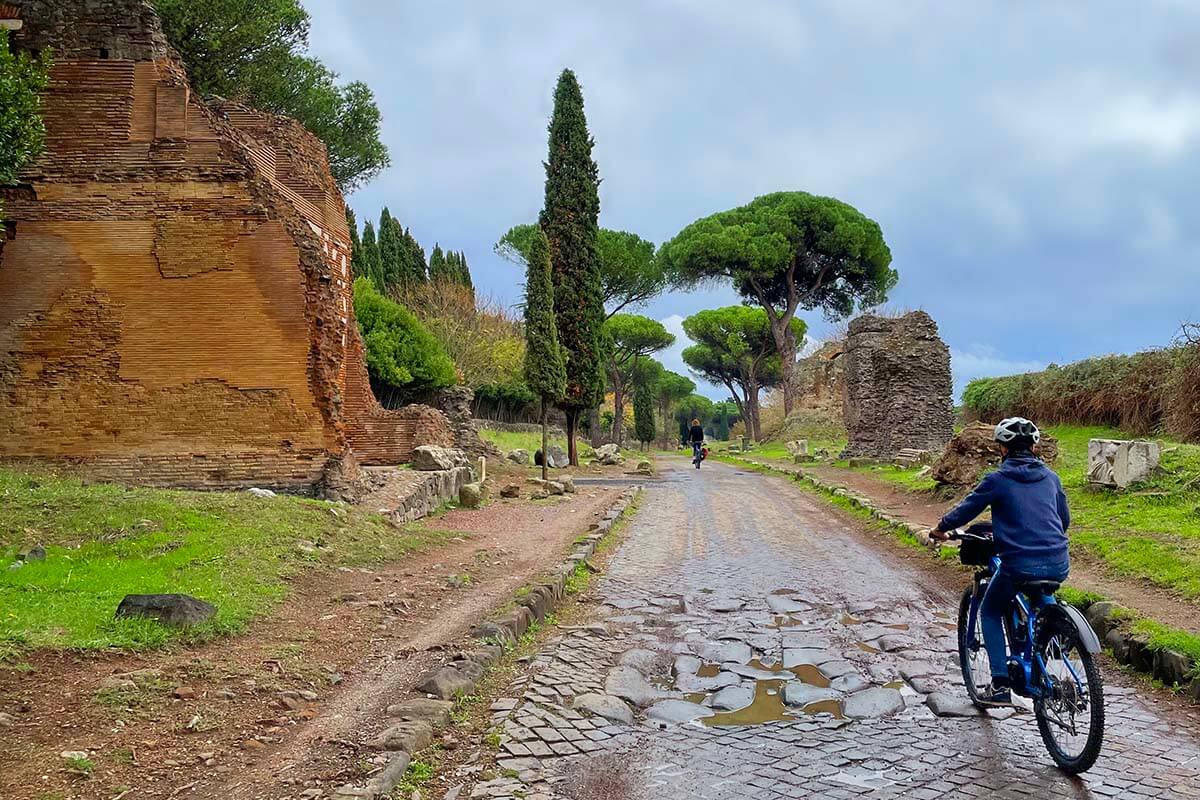
5. Park of the Aqueducts
Most Roman aqueducts date from the period between the 3rd century BC and 1st century AD. The oldest Roman aqueduct – Aqua Appia – was constructed around 312 BC, at around the same time as the Appian Way.
If you want to see more of the most authentic ancient Roman sights and get a bit more off the beaten path in Rome, definitely consider a visit to the Park of the Aqueducts (Parco degli Acquedotti) . This is antique Rome at its best, and without the crowds. In fact, you’ll likely have the park all to yourselves…
Here, you can see several ancient aqueducts dating from the glory days of the Roman Empire. Reliable water supply was of utmost importance for the quickly-growing cities, and a series of aqueducts were built in order to bring drinking water from the mountains into the city of Rome.
Parts of these ancient aqueducts survived to the present day, and you can admire some really fine examples of ancient engineering. Some aqueducts were tens of kilometers in length, and they were built with such a small gradient that was just enough to get the water flowing towards the city at a steady pace. It would be quite an achievement even nowadays…
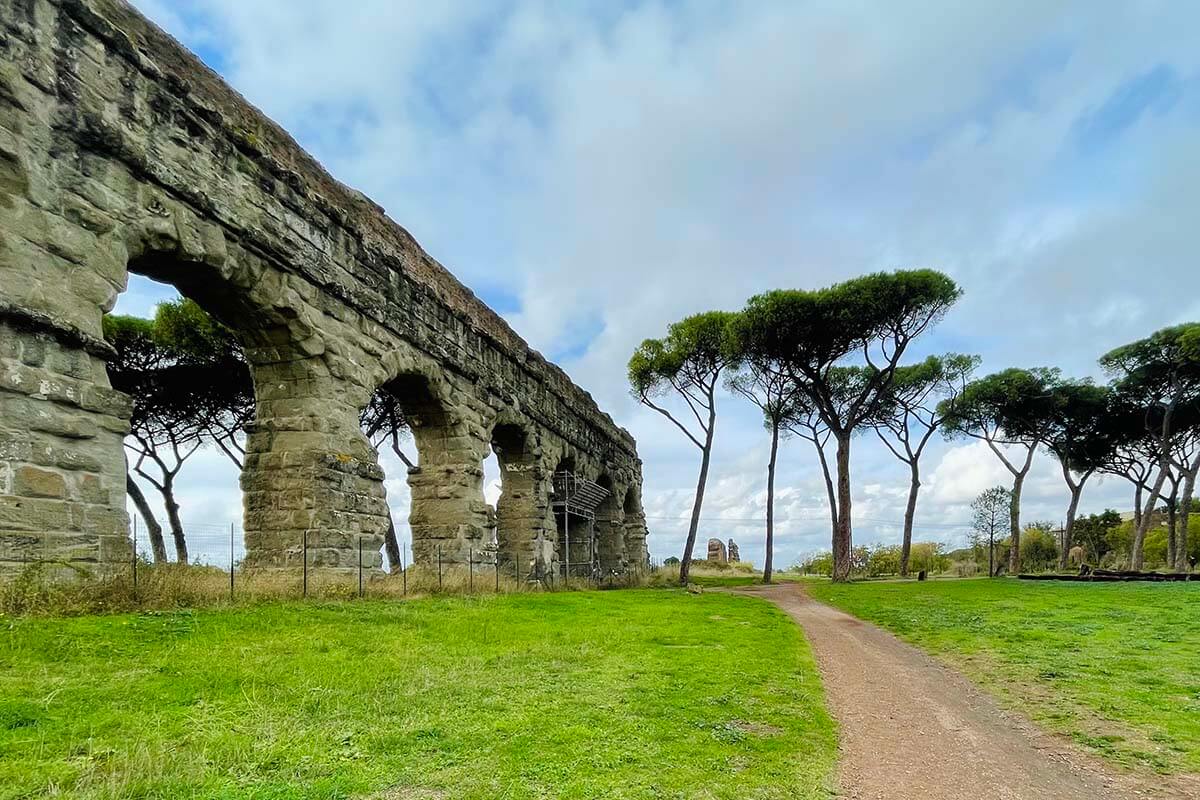
How to visit: Park of the Aqueducts is located on the outskirts of Rome, about 10 km from the city center. There’s a metro line running just nearby, so you could get here by public transport quite easily. However, it’s a massive park and so if you come on foot, you’ll need at least half a day to explore it. The best way to visit Parco degli Acquedotti is by bike.
We came here on the earlier-mentioned e-bike tour that also took us to Via Appia and ancient catacombs (see further below). It’s really one of the best ways to explore several of the best ancient landmarks in Rome in a short time!
TIP: One of these 2000-year-old aqueducts still supplies water to the famous Trevi Fountain today. If you don’t have the time to visit the Aqueducts Park, you could also opt to visit Vicus Caprarius (aka Trevi Underground) in the city center. Here, you can see one of the ancient aqueducts under the ground.
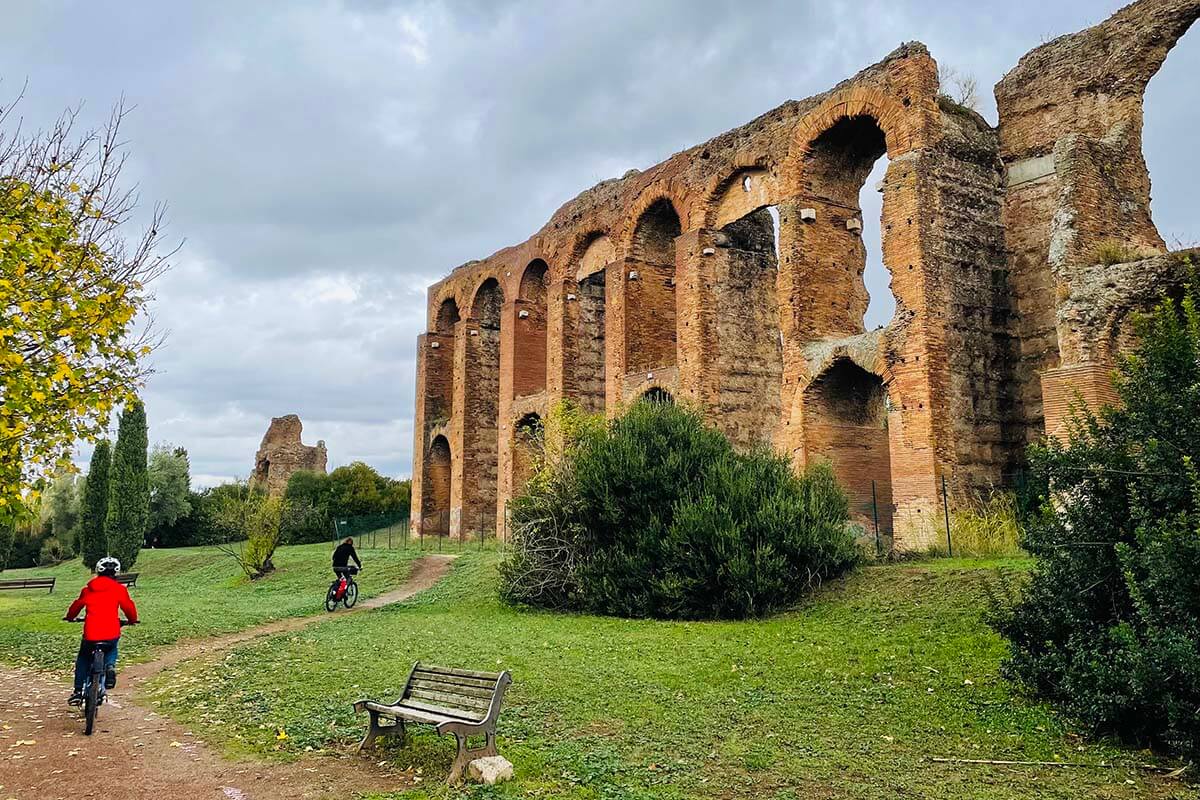
6. Largo di Torre Argentina
The ancient temples here date from the 2nd – 4th centuries BC.
Largo di Torre Argentina is a town square in the historic center of Rome. Some of the city’s most ancient temples are located here, and this was also the site of Rome’s 1st theater, the Theater of Pompey (55 BC).
The square is best known as the place where Julius Caesar was murdered by the members of the Roman Senate on the Ides of March (15 March) in 44 BC.
Most of the ancient buildings here are just ruins, but some of the remains of the temples can still be distinguished among the rest. The oldest temples are believed to date from the 4-3rd centuries BC, the others are from the 2nd century BC. They all date from pre-Christian times, but one of them was later rebuilt as a church.
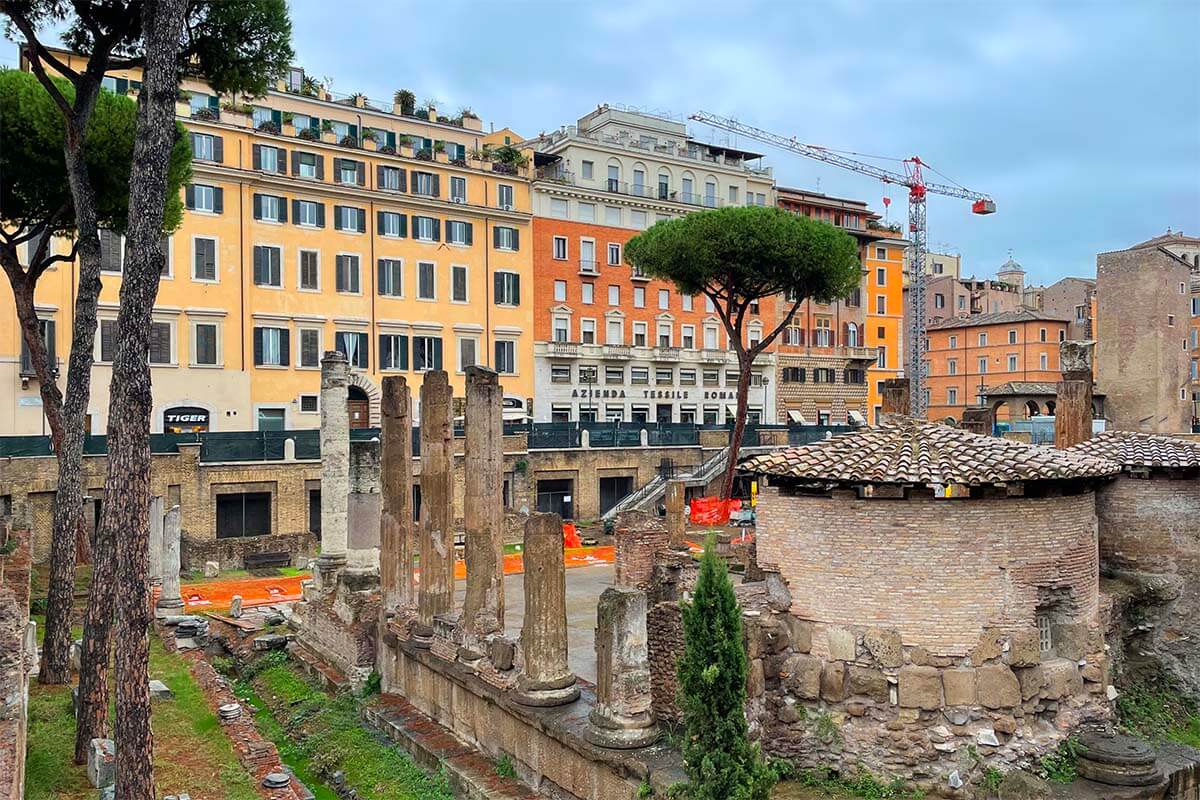
How to visit: Largo di Torre Argentina is a public square, just a few minutes walk from the Pantheon and other main sights in the city center. The archeological site has recently been made accessible to the public via a small walkway with several panels where you can learn about the history of this place. It’s free of charge and wheelchair-accessible.
You can also just walk all the way around the archeological site and easily see all the ancient buildings from the street. Some people come here to learn more about the death of Julius Caesar, others – for the ruins, and yet others for the cute cats that inhabit the area.
TIP: This amazing food tour we did in Rome also brings you to Largo di Torre Argentina and the guide gives some explanation about the sites you see.
LEARN MORE: Rome Street Food Tour with a Local Guide
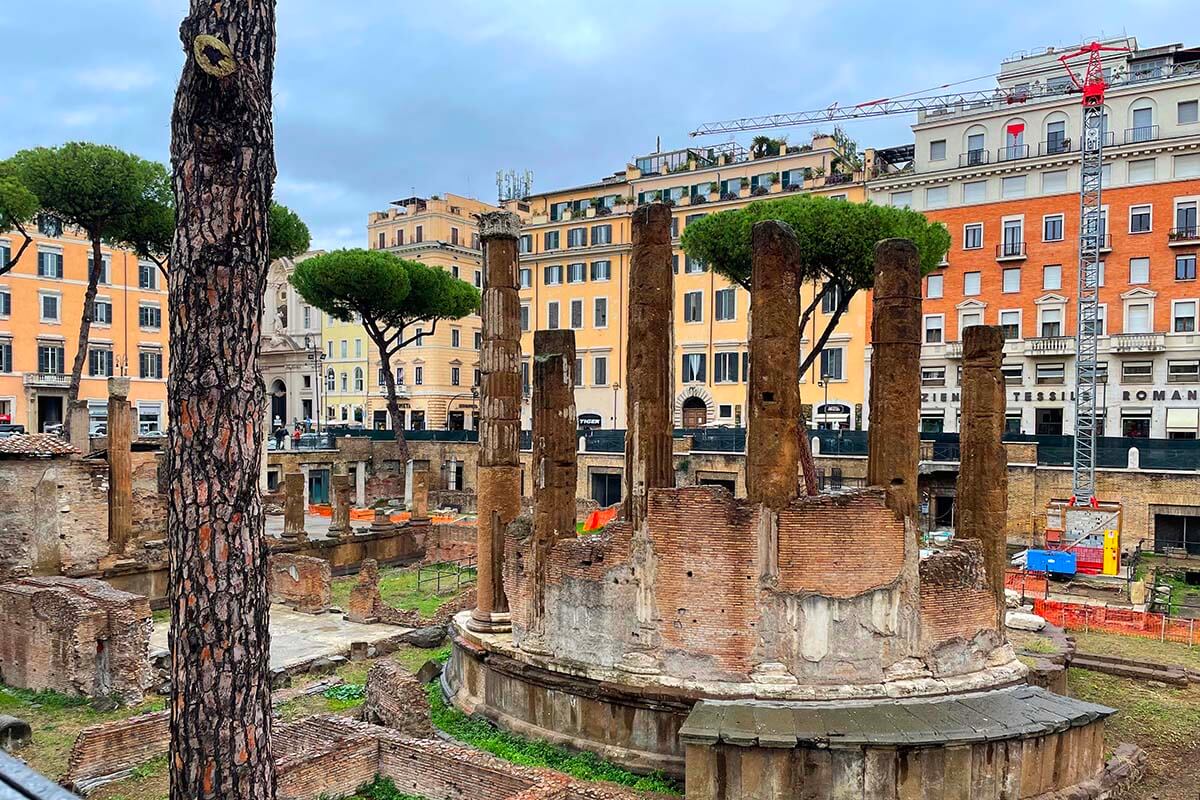
7. Pyramid of Caius Cestius
Built in 18-12 BC .
Looking somewhat out-of-place and totally different from anything else in Rome, the Pyramid of Cestius (Piramide di Caio Cestio) is one of the oldest and best-preserved landmarks in the city .
Just as the famous pyramids in Egypt, this one was also built as a mausoleum. Inside, is the tomb of Gaius Cestius, a wealthy Roman magistrate who died in 12 BC.
The pyramid of Cestius survived for over 20 centuries mainly because it was integrated into the city walls. You can still see one of the old city gates – Porta San Paolo (3rd century) – just next to the pyramid.

How to visit: You can see the pyramid from the outside at any time.
However, it is only open to the public a few days a month and if you want to visit inside, you’ll have to book it in advance. For more information, please consult the official website .
The chances that they are open just when you’re in Rome aren’t very high and it does require quite some planning, so this is one of those landmarks that you can best admire from the outside.

8. Theater of Marcellus
Built around 17-13 BC.
Marcello Theater (Teatro di Marcello) was the largest and most important theater in Ancient Rome, with space for almost 20,000 spectators. Its original construction looks a bit like the famous Colosseum, which was built almost 100 years later.
Built in the 1st century BC, this open-air theater remained in use until the early 4th century. Just like many old buildings in Rome, it was then looted and the stones were used for the construction of other buildings. What remained of it, was later used as a sort of an apartment building, and afterwards as a fortress.
Nowadays, the archeological site is a museum and it’s sometimes used for concerts as well. The upper part of the building still serves as residential apartments. Marcello Theater looks really impressive at night when it’s nicely lit.
In addition to the ancient theater, you can see lots of other ruins here as well that are yet several centuries older. The most notable is Portico of Octavia (2nd century BC) and also the Temples of Apollo Sosiano and Bellona (5th-1st centuries BC), plus Tempio di Giano (3rd century BC).

How to visit: You can see the theater of Marcellus from the street (the best view is from Via del Teatro di Marcello), but the archeological site can also be visited inside. It is normally open from morning to dusk and is free to visit.
There are informational panels and you can just walk through here when visiting the Jewish Ghetto or on your way from/to Circus Maximus or Bocca della Verità (Mouth of Truth).
TIP: Outside this archeological site, but also just near the theater, you’ll find several other lesser-known ancient Roman landmarks. This is the site of the cattle market Foro Boario (3rd century BC). Here, you can see the remains of two temples – Tempio di Portuno (2-3rd century BC) and Tempio di Ercole Vincitore (2nd century BC). If you’re in the area anyway, it’s worth checking them out as well.
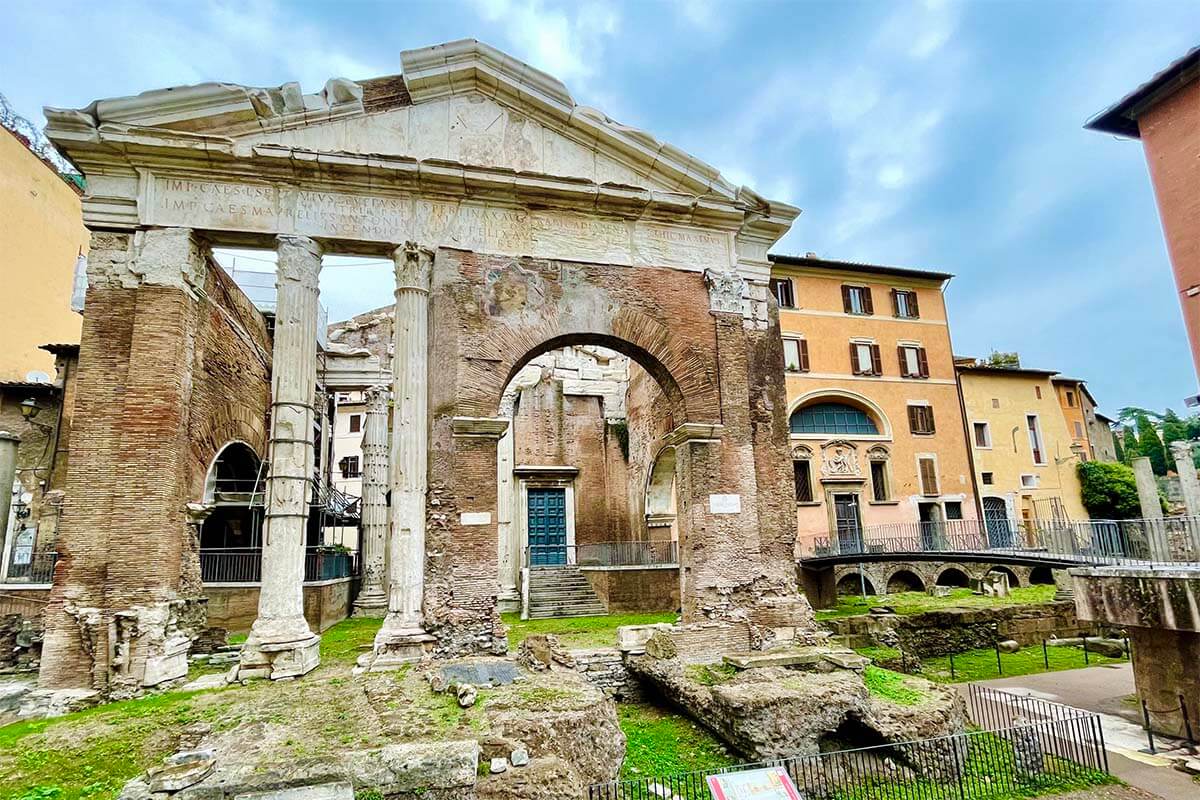
9. Domus Aurea
Built around 65-68 AD.
Domus Aurea , aka the Golden House of Nero , is another ancient landmark worth seeing in Rome. It’s located just a stone’s throw from the Colosseum that was built just a bit later.
After the Great Fire of Rome in 64 AD, Emperor Nero seized a huge centrally-located plot of land in order to build a lavish entertainment complex for himself and his guests. This started the rumors that he might have started the fire in the first place…
Domus Aurea was a lavish entertainment site with landscaped gardens, an artificial lake, fountains, pools, etc. The huge villa was richly decorated and had a rotating dining room with a golden dome with an oculus, a masterpiece of ancient engineering. The building materials included marble, gold, and mosaics made of precious stones and ivory, etc.
The Golden House represented the best of the Roman Empire’s art and engineering, but also the worst of its excesses. The project was hugely unpopular and after Nero’s death, a big part of the site was covered by ground. In fact, the Colosseum was built over the site of Nero’s artificial lake. The villa itself was still used by other emperors, but a few decades later it was also covered by ground and new bathhouses were built over it…
Covered by the earth, Domus Aurea remained very well preserved. It was rediscovered in the 15th century and became an inspiration to many Renaissance artists. However, the exposure to the elements has done a lot of damage, and because a large part of the site remains under what’s currently a park, it’s extremely difficult to preserve what’s left of it without causing a complete collapse.

How to visit: Domus Aurea is located at Colle Oppio Park; the entrance is on Via della Domus Aurea. You can visit a small part of the original site, partially underground.
The Golden Vault Room virtual reality experience gives a good idea of what this place must have looked like in the past. Here you can see the availability and book a guided tour.
TIP: If you have more time, we highly recommend opting for a guided tour that also includes the Virtual Reality experience !
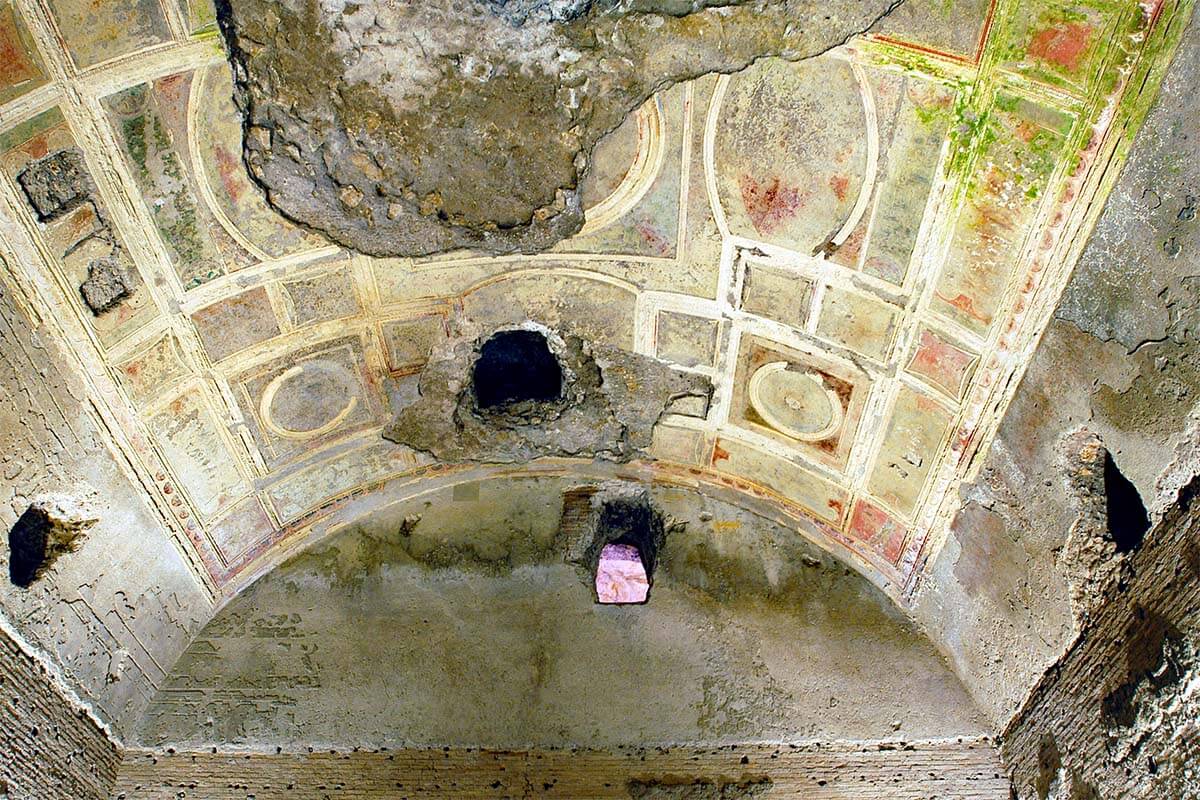
10. Colosseum
Built around 70-80 AD.
The Colosseum (Colosseo) is probably the most iconic and best-known of all Ancient Rome landmarks. Almost 2,000 years after it was built, it remains the symbol of the Roman Empire, but also of Rome as we know it today.
This was the largest and the most impressive ancient amphitheater. Despite being ruined by several earthquakes, plundering, and looting, the Colosseum still stands today. Built as an entertainment arena, it could seat some 50,000 – 80,000 spectators!
The main purpose of the Colosseum was to keep the regular people of Rome content by providing entertainment (remember the old Latin saying “panem et circenses” – bread and circuses). The amphitheater was used for public spectacles including gladiator fights, animal hunts, but also the recreation of sea battles and dramas based on ancient mythology.
A big part of this impressive building is quite well preserved and you can get a pretty good idea of what the original arena would have looked like. It’s really interesting to see all the different layers of the structure. So if you can, take the time to walk around it and explore deeper, – you’ll appreciate it so much more.
In addition to seeing the Colosseum from the outside, you really have to see the inside as well. Part of the arena floor has been restored and you can also take in the views from the upper levels.
It’s now also possible to visit the underground level which gives you a very unique insight into how the arena functioned. You can see where the wild animals were kept, where the gladiators waited for the fights, the mechanisms used to bring them upstairs, etc.
How to visit: You can see the Colosseum from the outside and walk all the way around it. But you’ll need a ticket in order to visit inside. This is one of the most popular Rome attractions in Rome and you really have to book your tickets or a guided tour in advance.
TIP: If you want to visit all the levels of the Colosseum including the underground, you’ll need to go with a guide. We opted for this tour which includes all the levels of the Colosseum, and also the earlier-mentioned Roman Forum and Palatine Hill, and I can highly recommend it.
LEARN MORE: Colosseum Levels & Best Ticket Options
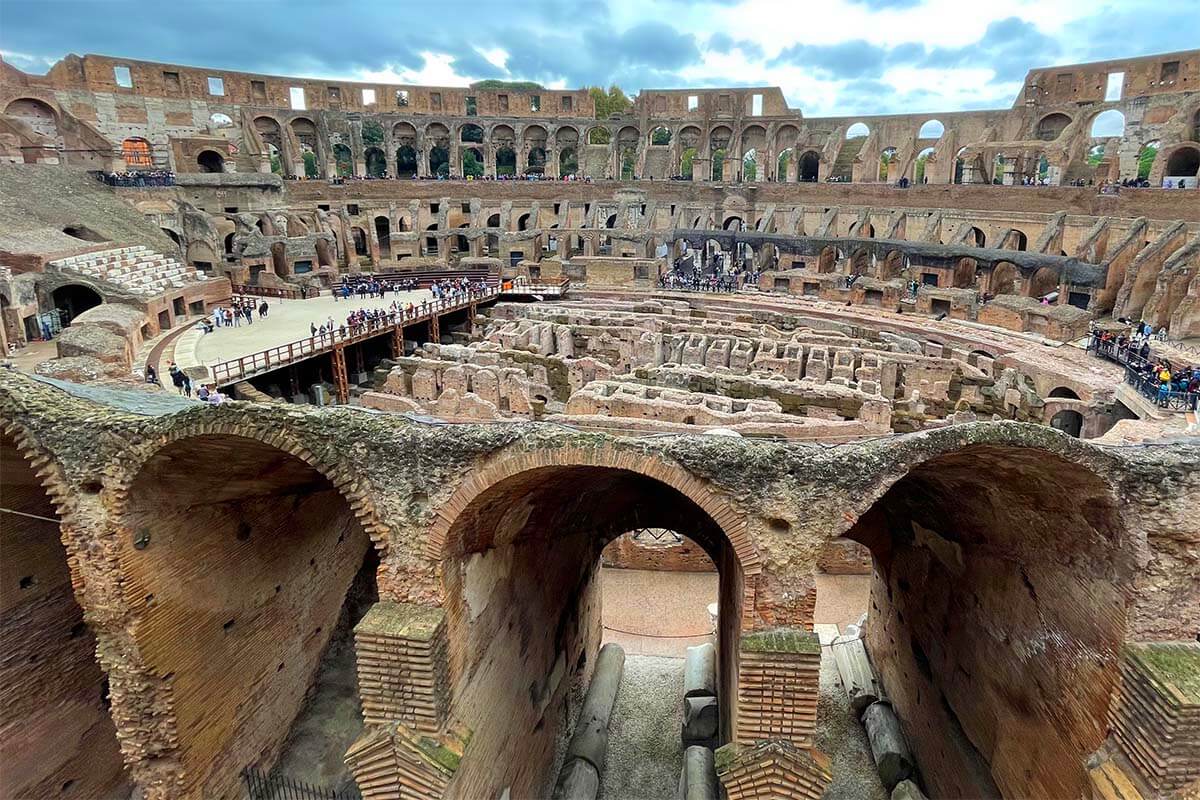
11. Trajan’s Market
Built around 100-110 AD.
Trajan’s Market (Mercati di Traiano) is a 2nd-century Roman market, often described as the oldest shopping mall in the world . It was part of a bigger complex – Trajan’s Forum – that was once the bustling center of the Roman Empire.
This architectural site is not only a fine example of ancient Roman architecture, but it also gives you a unique insight into the everyday life of the Roman people. It’s also a good place to see how the city has changed over the centuries.
The markets were mainly used in the 2-5th centuries. Later, new floor levels were added, a tower was built, and in the 16th century, there was a convent here… At the beginning of the 20th century, some of the recent additions have been demolished again, and an effort was made to restore Trajan’s Market and the surrounding area.
In 2007, the Museum of Imperial Fora was opened here, and you can now explore this unique site from close by. Walking on the original streets of ancient Rome – Via Biberatica and Via della Torre – is a really special experience. This is one of the places where you can truly feel the antique Rome around you. And despite its very central location, only very few tourists seem to find their way inside…
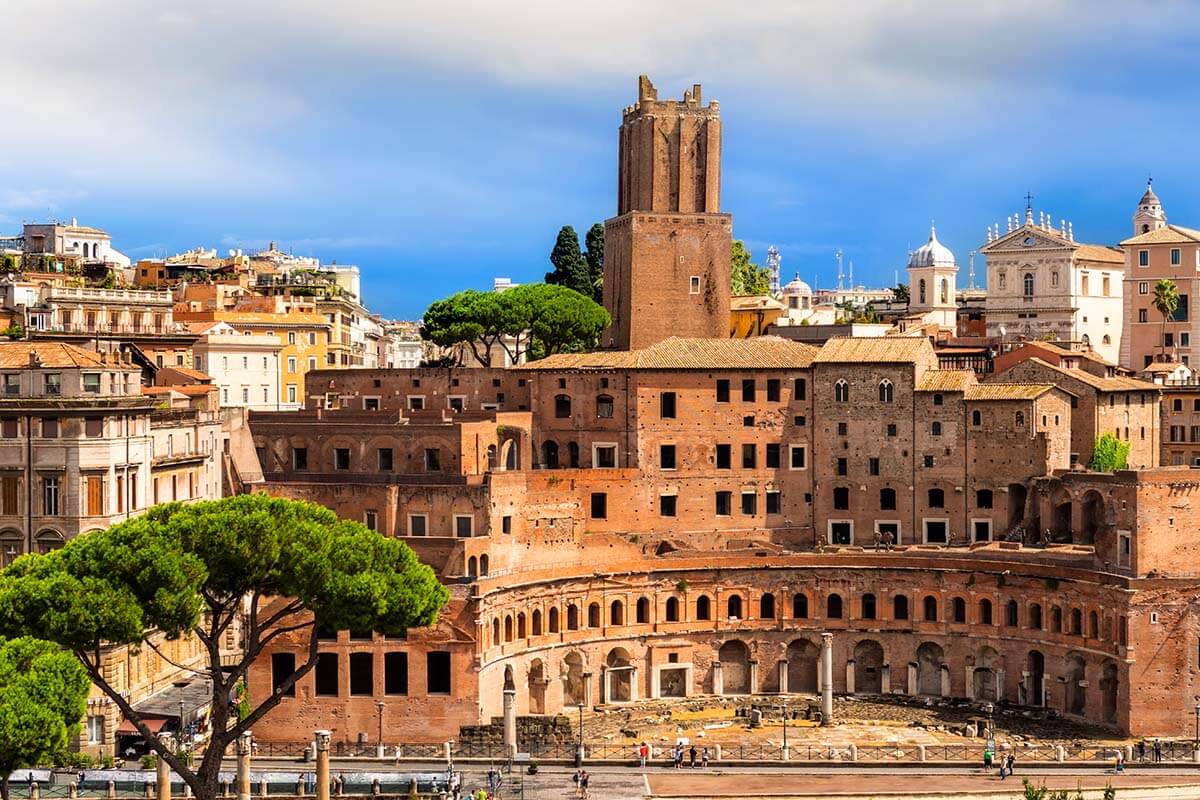
How to visit: You can see a big part of the Trajan’s Market archeological site from Via dei Fori Imperiali, the main street between Piazza Venezia and the Colosseum. However, if you want to learn more about it, walk on the ancient streets, and explore the most impressive parts, be sure to visit the Museum of the Imperial Fora in the Trajan’s Markets.
It’s open daily except for some public holidays. More info on the official website . The entrance here is included with this and several other city passes .
TIP: If you have more time to explore, get a ticket that includes a multimedia video . This video gives you a unique insight into what Trajan’s Markets looked like during the glory days of Imperial Rome.
In addition, as you walk on Via dei Fori Imperiali towards the Colosseum, you can see the ruins of the Forum of Augustus (2 BC) and too many other ancient ruins to even try to mention.
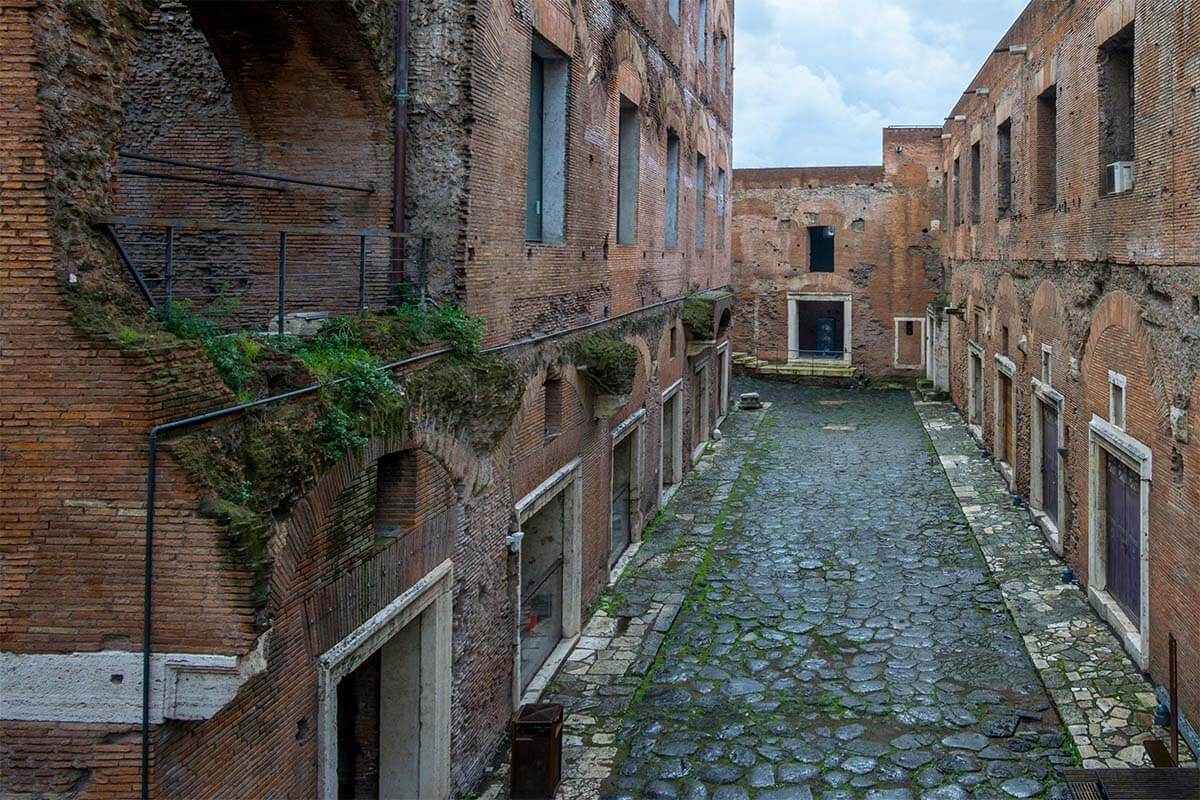
12. Pantheon
The origins go back to 27 BC, but the Pantheon as we know it today was built around 125-127 AD.
Built almost 2,000 years ago and still standing strong, the Pantheon is the best-preserved of all ancient monuments in Rome. In fact, the Pantheon is the oldest building in the world that is still in use today .
Dating from before Christianity, the Pantheon was originally built as a temple to all gods. However, it was later converted into a church (7th century). This saved the old temple from looters and plundering and helped preserve this unique monument through so many centuries.
The Pantheon has also served as the burial place for many artists and kings. Inside, you can see the tombs of Raphael, King Victor Emanuele II, King Umberto I, Queen Margherita of Savoy (after whom pizza Margherita was named), and several others.
World-known for its impressive oculus , the Pantheon has inspired many generations of architects and engineers, including Michelangelo who designed the dome of St. Peter’s Basilica in the Vatican. Michelangelo was so impressed by the unknown ancient architect and its genius dome structure that – out of respect – he made sure that his own construction was slightly smaller.
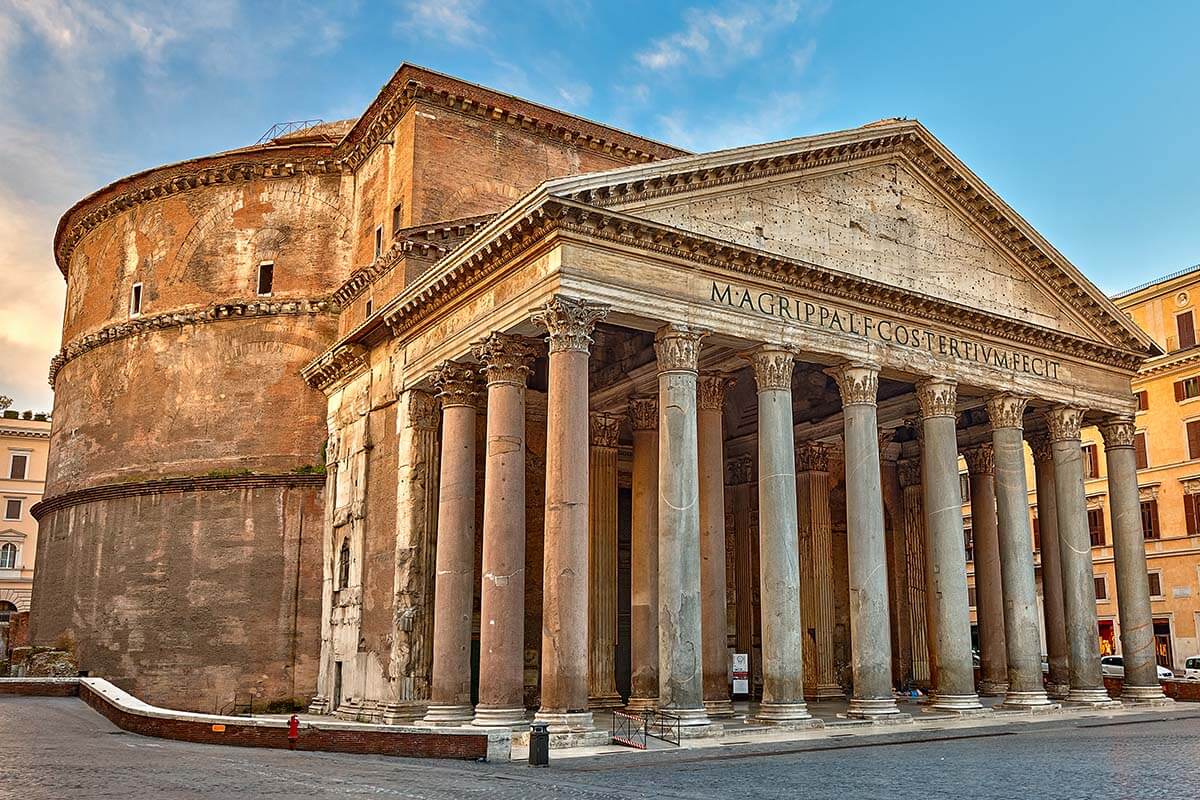
How to visit: The Pantheon is a working church, but it can only be visited for free during mass (and you won’t be able to walk around).
It’s open daily, and if you want to visit it as a tourist, you need to pay for a ticket. While you can ‘just’ queue at the entrance, we recommend getting a timed entry ticket in advance. The queues can be really long, there are multiple lines for cash and credit card payments, and it’s overall quite chaotic. Even with online reservation, you have to pick up an actual ticket at another location first (hopefully, they’ll change this in the future, but be sure to read the instructions!).
You can book the Pantheon tickets on the official website (which many of our readers find confusing), or on GetYourGuide or on Tiqets . GetYourGuide also offers free cancelation up to 24 hours before the visit. All online tickets include an audio guide.
TIP: If you want to learn more about this unique ancient landmark and visit without stress, you can also opt for a guided tour .
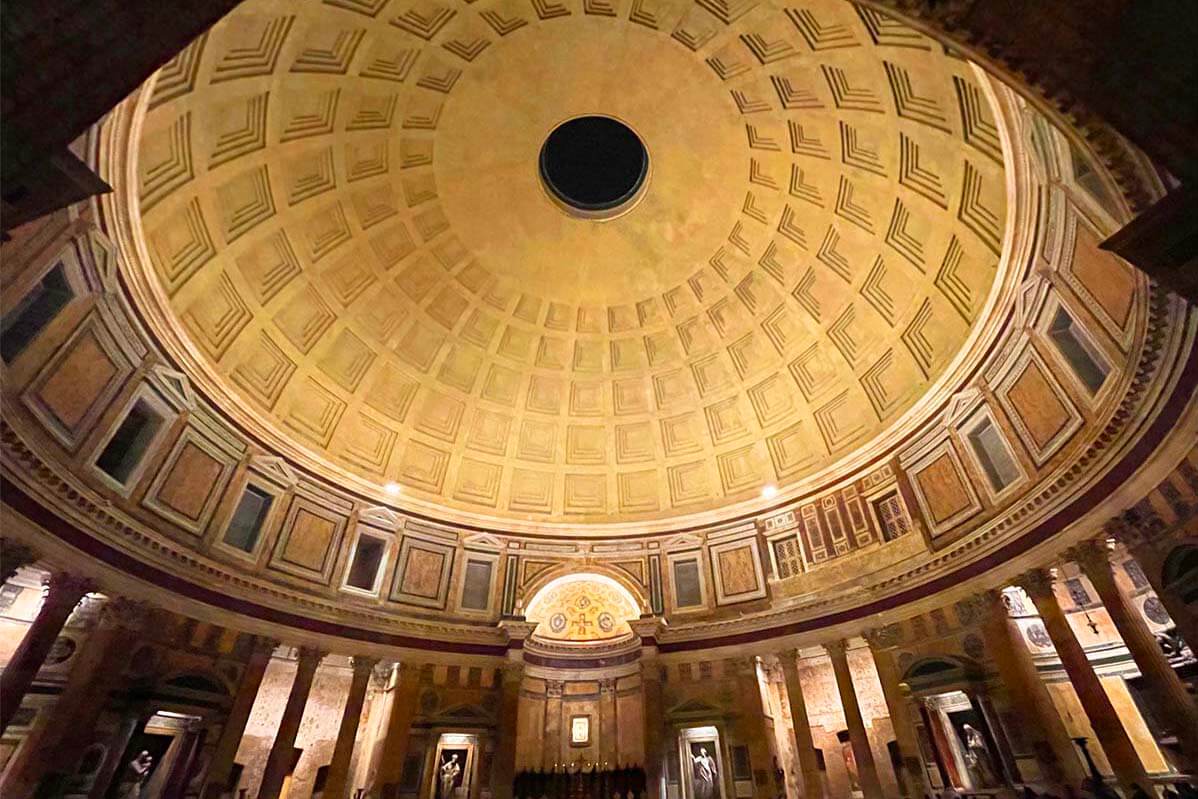
13. Castel Sant’Angelo
Built around 134-139 AD.
Castel Sant’Angelo (Mausoleum of Hadrian) is another ancient Roman landmark that you really can’t miss in Rome.
Once the tallest building in Rome, it might look a bit like a castle indeed, but it’s actually a tomb. This impressive mausoleum was built in the 2nd century for Emperor Hadrian and his family. The ashes of several other emperors were placed here as well, including Emperor Caracalla at the beginning of the 3rd century.
At the beginning of the 5th century, the mausoleum was looted and turned into a military fortress. In the 14th century, the building was turned into a castle and was subsequently used by various popes. A covered fortified corridor was built in order to connect Castel Sant’Angelo to the old St. Peter’s Basilica at the Vatican.
Nowadays, Castel Sant’Angelo serves as a museum. Inside, you can see some perfectly preserved frescoes from the Renaissance, visit the Chamber of Ashes where the emperors were incarcerated, and see the Papal Residence.
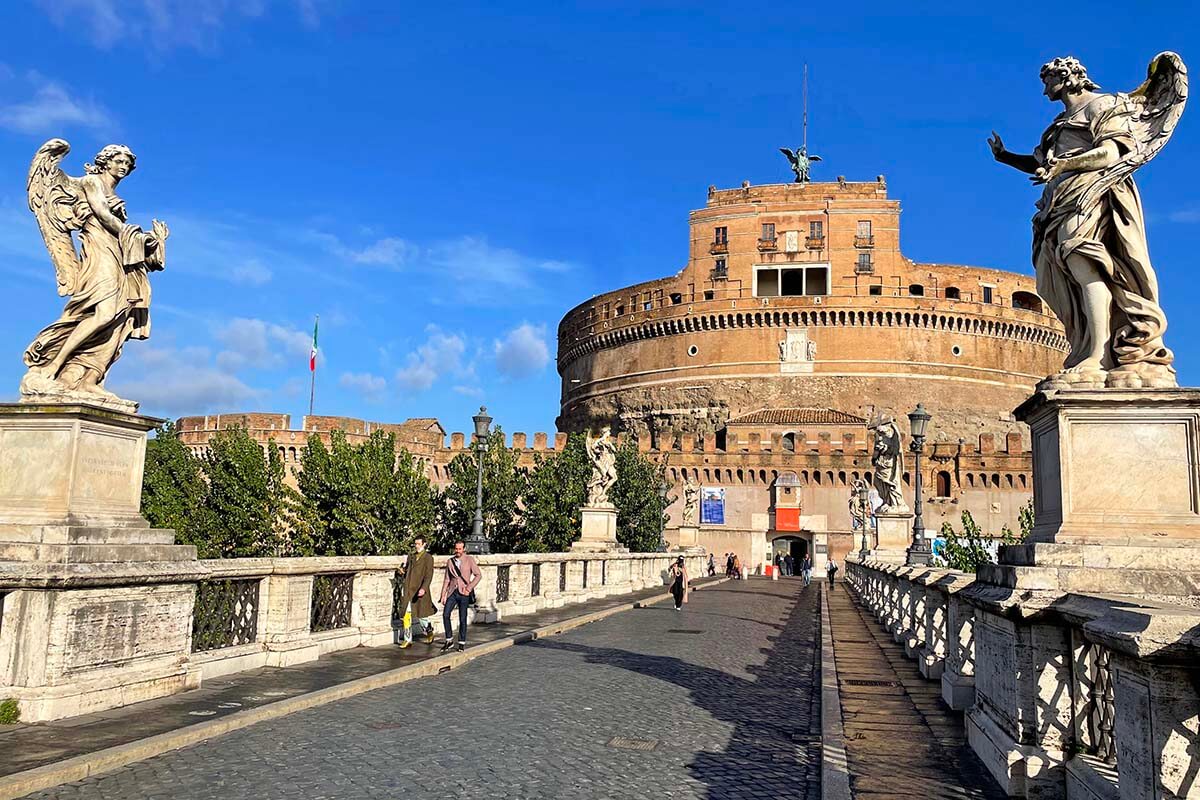
How to visit: You can just see the building from the outside, but you can also visit the inside. It’s located on the main route on your way to the Vatican.
You can get a fast-track ticket and visit on your own or join a guided tour. The entrance to the museum is also included with the Omnia Pass .
TIP: Don’t miss the panoramic views from the rooftop terrace of the museum. It’s one of the best viewpoints in Rome , offering amazing views of the River Tiber, the historic city center, and the Vatican.
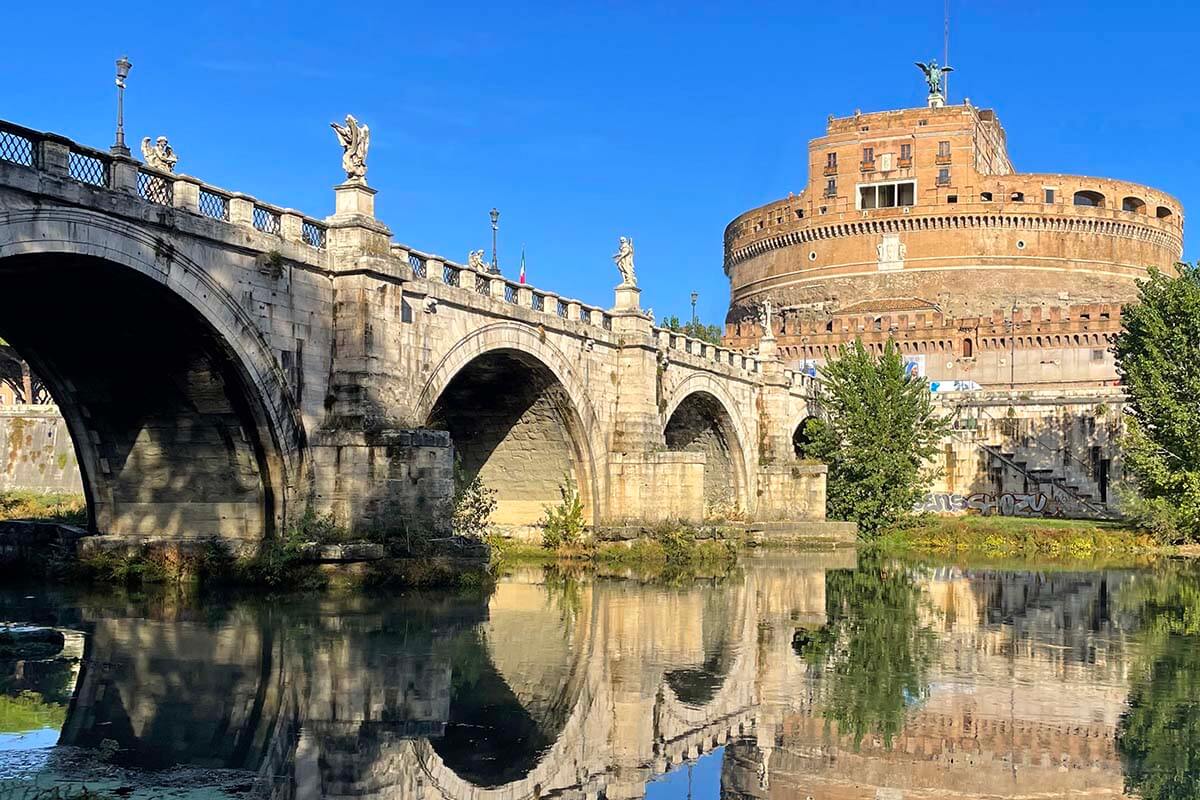
14. Catacombs of St. Callixtus
Built between the 2nd and the 5th century AD.
If you are looking for even-more unique sites to see in Rome, consider visiting some of the ancient catacombs (underground burial sites). There are over 60 known catacombs in Rome, with hundreds of kilometers of subterranean tunnels, and hundreds of thousands of graves. Some of these catacombs are open to the public.
Probably the most special and best-known are the Catacombs of St. Callixtus (Catacombe di San Callisto) , located next to the Appian Way mentioned earlier. This ancient site stretches for about 20 km (12 miles), is over 20 meters (65 ft) deep, and contains about half a million graves.
Several Popes were buried at this site and you can visit the crypt of the Popes . In addition, you can see the crypts of some early Christian martyrs, including the crypt of St. Cecilia . You can also walk around and explore underground galleries and see hundreds of – now empty – tombs around you.
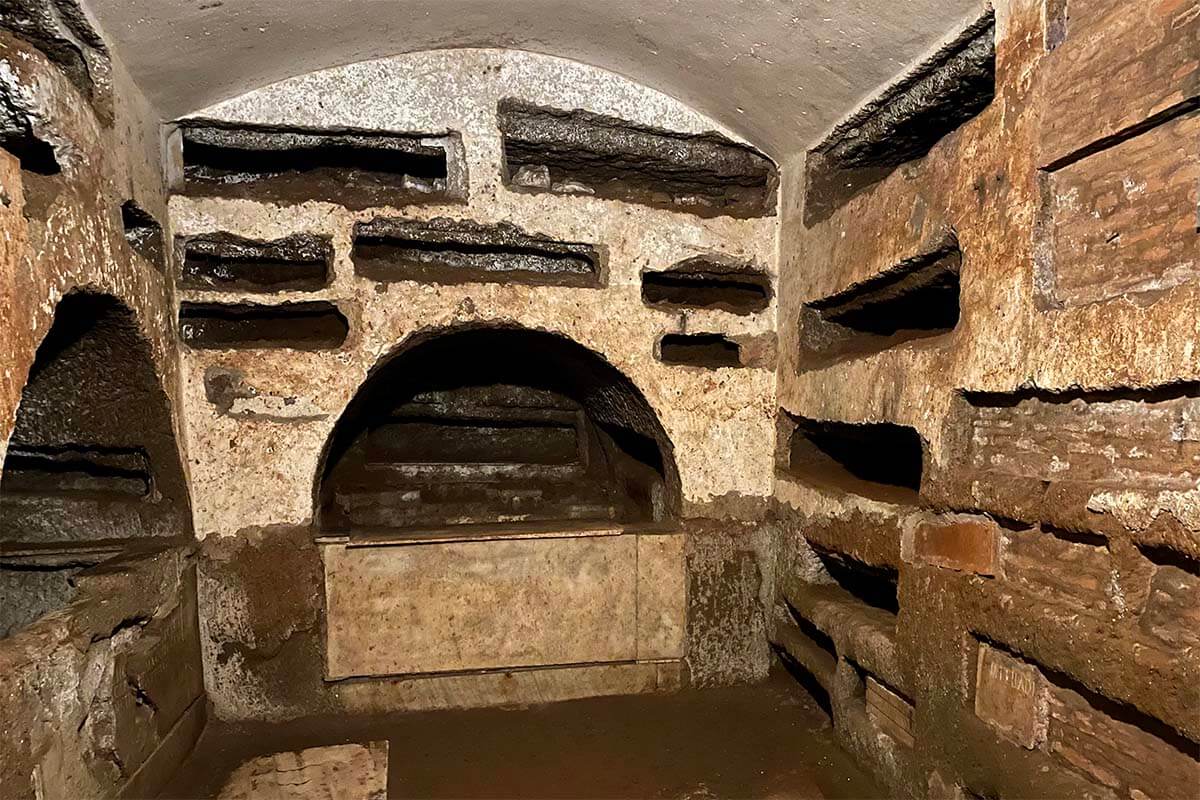
How to visit: You can only visit the Catacombs of St. Callixtus with an official guide (included in your entrance tickets ).
You have to make your own way to the catacombs (by car, by bike, or by public transport) and it’s essential to book a tour in advance or you risk not being able to visit. It’s a popular site.
TIP: There are also many guided tours from the city center that include a visit here, usually together with some other ancient sites. We visited St. Callixtus Catacombs with this e-bike tour that also took us to Via Appia and the Park of the Aqueducts.

15. Baths of Caracalla
Built around 212-216 AD.
Baths of Caracalla (Terme di Caracalla or Termae Anthoninianae) is one of my personal favorite ancient sites in Rome. This grand 3rd-century complex with remarkable ruins and some very well restored mosaics is absolutely impressive! You feel so tiny here and it makes you realize how advanced the Romans really were in architecture and engineering.
These public baths were built at the beginning of the 3rd century and were the second-largest bathhouse in Rome. In addition to the luxurious bathing houses, the complex also had several saunas, a sports center, and even an Olympic-size swimming pool. The site was surrounded by beautiful gardens and even had a library.
The baths were heated via a sophisticated underground oven system and you can still see the remains of it today. These Roman baths remained in use for about 300 years. Nowadays, it’s a working archeological site that is open to the public.
Visiting here gives you an amazing insight into yet another aspect of daily life in the glory days of the Roman Empire. And because the Baths of Caracalla are somewhat of a hidden gem and not many tourists come here, this is one of the ancient Roman sites with a more authentic feel.
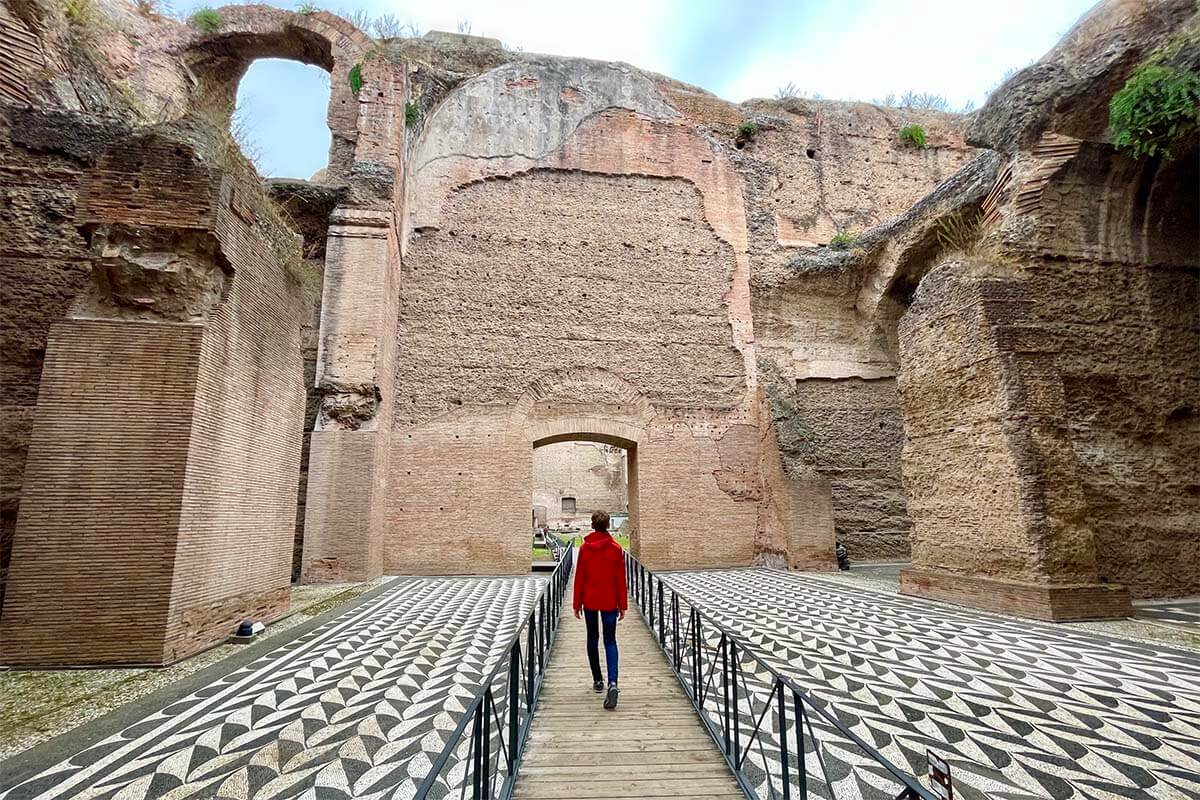
How to visit: The Baths of Caracalla are located a 10-15 minutes walk from the Circo Massimo metro station or about 20 minutes walk from the Colosseum.
You can see some ruins from the outside, but the best parts and the mosaics can only be admired if you actually visit inside.
Normally, you can just get your tickets on the spot. You can find more info on the official website (in Italian).
TIP: The earlier-mentioned guided tour is a great option if you want to visit the Caracalla Baths and Circus Maximus with a local guide.
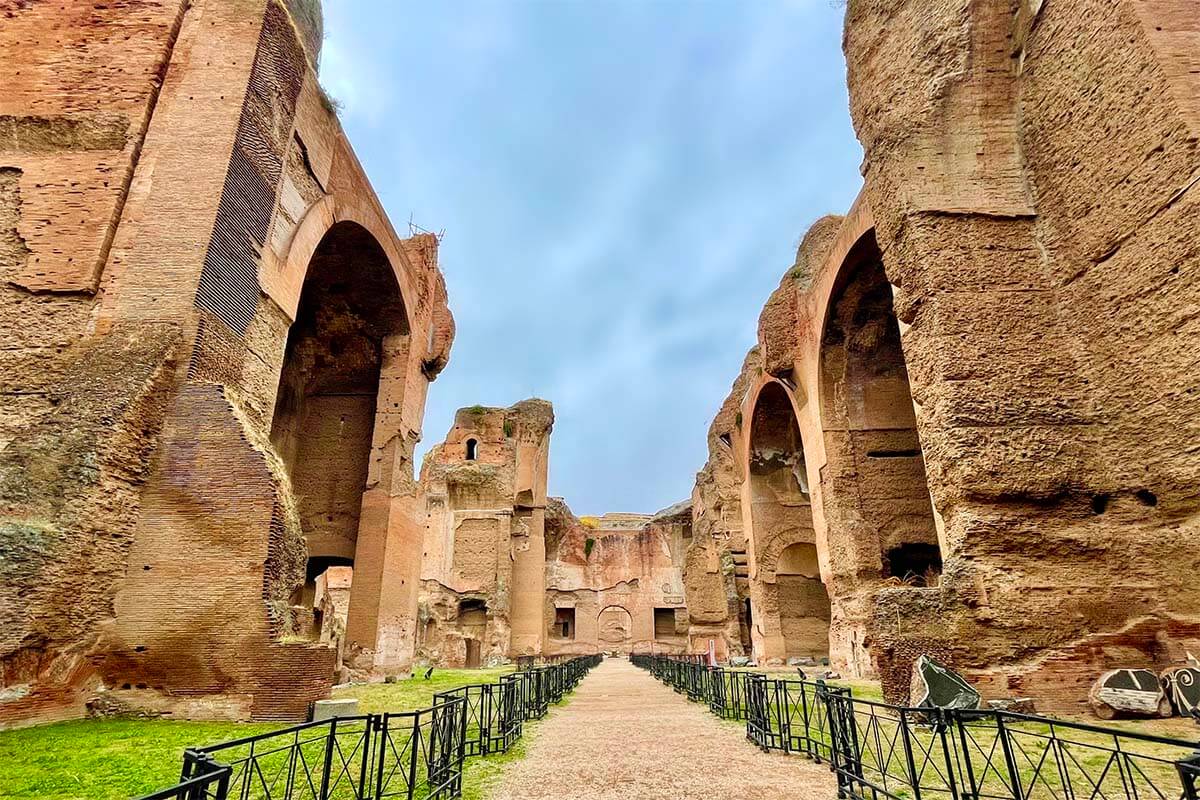
16. Baths of Diocletian
Built around 298-306 AD.
Baths of Diocletian (Terme di Diocleziano) were the largest and most impressive public baths in Rome. The site is just as grand as the above-mentioned Baths of Caracalla, and it also contained several hot and cold baths, but also open-air bathing pools, etc. It’s also believed to have housed a library.
Built at the turn of the 3rd – 4th centuries, the baths remained in use until the 6th century. Over the centuries, the site has been used for various purposes, with lots of construction in and around it shaping the new city of Rome. In the 16th century, a basilica was built here, and later a monastery was added as well. At a certain point, parts of the old bathhouse were used to store and sell grain and oil.
In the late 19th century, the monastery was abandoned. The Roma Termini railway station was built nearby, just as several hotels, palazzos, etc. In 1889, the remaining site of Diocletian’s Baths and the monastery was designated as a museum, part of the National Roman Museum .
This means that the site is quite well-preserved, many of the areas are covered with a roof, there are beautiful sculptures, mosaics, and other Ancient Rome artifacts. It has much more of a museum feel than the Baths of Caracalla, but is well worth visiting too!
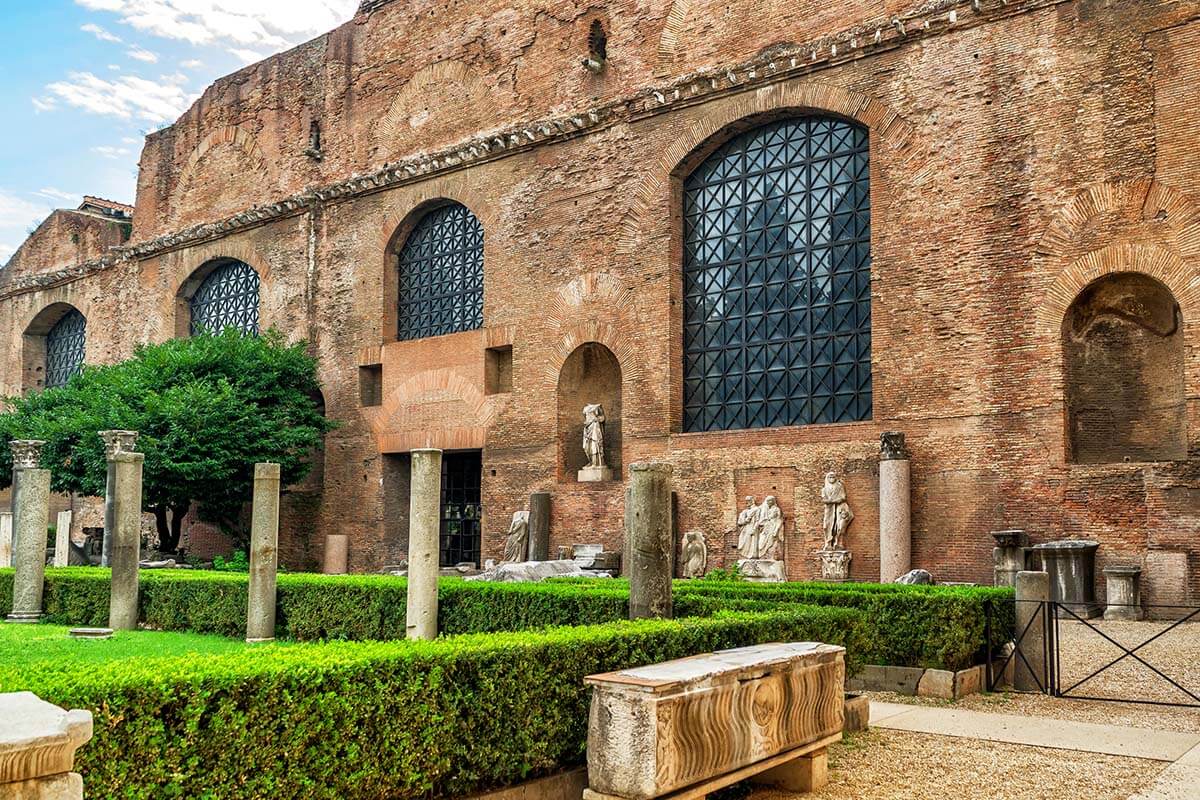
How to visit: The National Roman Museum – Baths of Diocletian section is quite centrally located, just next to the main train station in Rome.
It’s normally open daily except on Mondays, and you can just get a ticket on the spot. For more practical info, please see here .
TIP: The entrance here is also included with the Omnia Card .
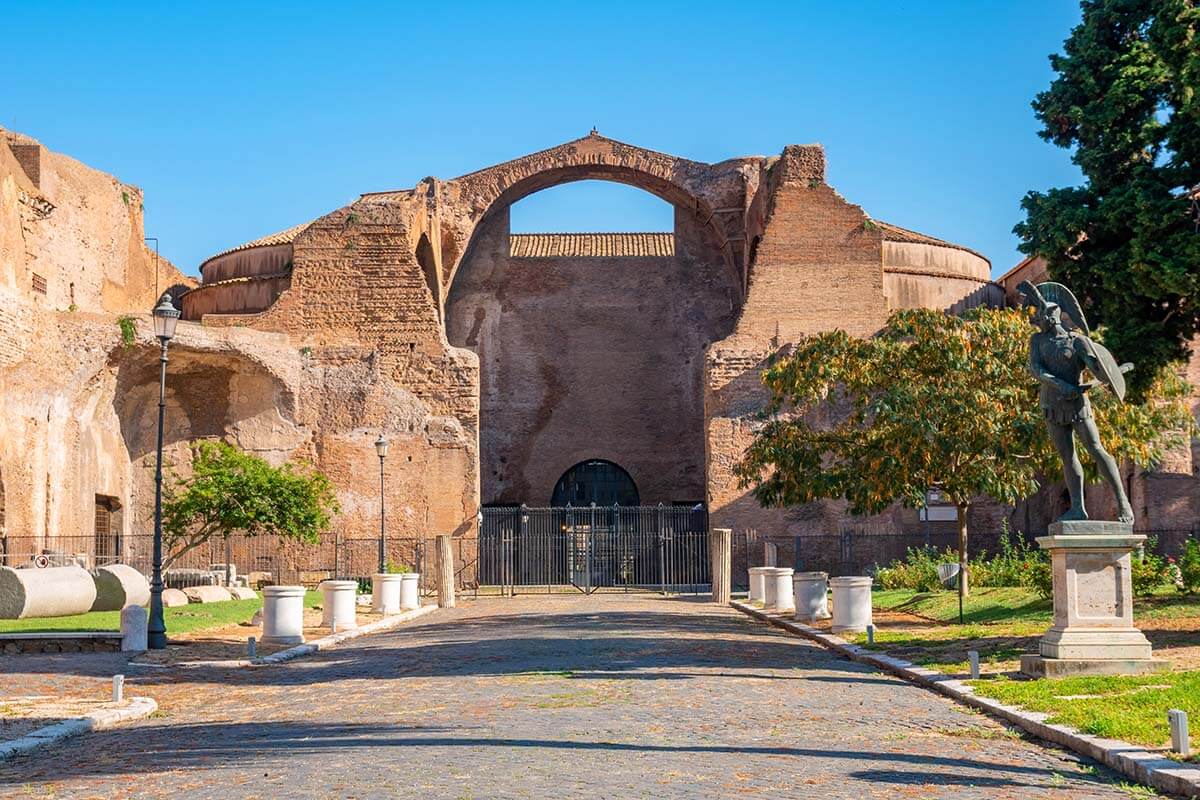
Map of the best ancient landmarks in Rome
To help you get a better idea of where all the sites mentioned in this guide are located, we created a map indicating the best ancient Roman landmarks in Rome.
This should help you plan your visit, and maybe you can include a few of these places in your itinerary when exploring the most popular sights and tourist attractions in Rome .
How to use this map: Use your computer mouse (or fingers) to zoom in or out. Click on the icons to get more information about each place. Click the arrow on the top left corner for the index. Click the star next to the map’s title to add it to your Google Maps account. To view the saved map on your smartphone or PC, open Google Maps, click the menu and go to ‘Your Places’/’Maps’. If you want to print the map or see it in a bigger window, click on ‘View larger map’ in the top right corner.
So, this is our guide to some of the most interesting ancient landmarks to see in Rome. I hope that this gives you a better understanding of when some of the oldest buildings were built, the stories behind the ruins you see, and inspires you to visit at least some of them.
There’s so much history and fascinating ancient sites everywhere you go in Rome, and that’s what makes the Eternal City one of a kind!
For more information and tips for your visit, please also see our itineraries and other guides to Rome via the links below.
Rome travel guides:
- Tips for Planning a Trip to Rome
- How to Get to Rome from the Airport
- How to Plan Your First Trip to Europe
- Must-sees: Best Things to Do in Rome
- Where to stay: Best Area to Stay in Rome
- Where to eat: How to find the best food in Rome
- Hidden Gems of Rome
- Best Views & Viewpoints in Rome
- Rome Underground Sites
- 1 Day in Rome (all the best places)
- 2 Days in Rome (the musts + a few hidden gems)
- 4 Days in Rome (top sights, hidden gems, a few more ancient landmarks)
If you found this post helpful, don’t forget to bookmark it and share it with your friends. Are you on Pinterest? Pin these images!
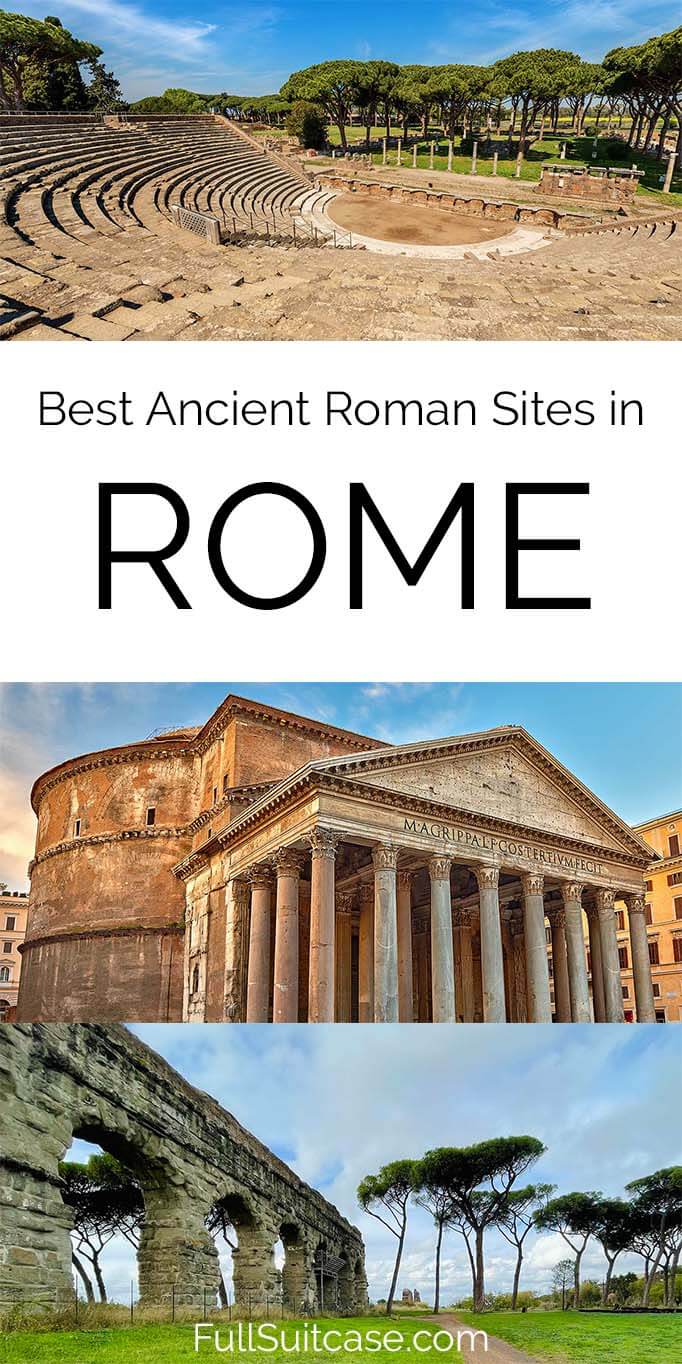
More travel inspiration and tips for Italy:
- What to see: Best Places to Visit in Italy & Most Beautiful Cathedrals in Italy
- Cities: Most Beautiful Cities in Italy
- Itinerary: How to See the Best of Italy in 2 Weeks
- Florence: Best Things to Do in Florence & One Day in Florence
- Milan: Best Things to Do in Milan & One Day in Milan
- Venice: Best Things to Do in Venice & One Day in Venice & Doge’s Palace (must-see!)
- Naples: Best Things to Do in Naples & One Day in Naples & Where to Stay in Naples & Best Day Trips from Naples
- Cinque Terre: One Day in Cinque Terre & Where to Stay in Cinque Terre & Info + Tips for Visiting Cinque Terre
- Tuscany: Most Beautiful Towns in Tuscany & Tuscany Itinerary & Montepulciano
- Siena: Best Things to Do in Siena & Siena Cathedral
- Amalfi Coast: Amalfi Coast Itinerary & Capri & Amalfi Coast Travel Tips
- Emilia Romagna: Emilia Romagna Itinerary & Best Things to Do in Bologna & Best Things to Do in Rimini
- San Marino: Complete Guide to Visiting San Marino
- Italian Lakes: Lake Garda & Lake Como & Bellagio & Best Lakes in the Dolomites
- Italian Mountains: Hiking in the Dolomites & Best Places in the Dolomites & Best Lakes in the Dolomites & Dolomites Accommodation Guide
- Food: Italian Food by Region
- … for many more guides and destinations, please see our Italy travel guide .
This site uses Akismet to reduce spam. Learn how your comment data is processed .
Friday 28th of April 2023
Thanks for this great guide, Jurga. It's so interesting to also see the timeline of the oldest places in Rome. I always thought that colosseum is the oldest building in Rome and had no idea about so many other places. I will try to visit Ostia Antica too and already booked the Appian Way bike tour that you recommended.
Thanks for the feedback, Evy, and have a great time in Rome!

27 Ancient Roman Ruins That Are A Must-See
It’s no secret to anyone that Rome is a top destination for archaeology buffs. From the Colosseum to the ruins of the ancient aqueducts scattered around the city, there is no city like Rome that better fits the moniker of an open-air museum. Our selection of the most interesting ancient Roman ruins will help you get around the precious sites that gave shape to the sophisticated Roman civilization.
Even admitting that there is hardly a site better than another, one can’t really deny that with a limited time, making a choice becomes necessary. Here are our suggestions of some pretty amazing archaeological sites in Rome you should include on your bucket list. Let’s dig in!
Table of Contents
Map of the most important ancient ruins in Rome
Fantastic archaeological sites to visit in Rome
Impossible not to start with the Colosseum . Arguably the most popular site in all of the city and the first landmark everyone rushes to, a visit to the Colosseum is a must for every first-timer.
A mighty amphitheater erected in the 1st century, this is where gory shows and fights between gladiators and gladiators against wild animals took place to please emperors and ordinary citizens.
There are many types of Colosseum tours , depending on how much you want to see, how much you are willing to spend and whether you are interested in accessing spaces usually closed to the public or staying within the general areas.

Roman Forum and Palatine Hill
Right next to the Colosseum and often included in the same tours are the Roman Forum and the Palatine Hill, two of the most important archaeological sites in Rome.
The cluster of buildings that includes temples, stores, and funerary altars were once the pulsing heart of ancient Rome. Now we can visit the forum and even see where Julius Caesar was cremated and where Romans still bring fresh flowers to his altar.
The Palatine Hill is believed to be the first settlement where Rome was founded and is a fantastic place to see ancient Roman imperial villas.
Together with the Colosseum, the Roman Forum and the Palatine Hill are the largest ancient site in central Rome. To visit, I recommend booking your ticket online especially if it’s high season such as summer or December .

Baths of Caracalla
A mighty witness to Romans’ love for taking care of themselves and enjoying some spa time, the Baths of Caracalla are great to visit and a fantastic hint to how gorgeous they must have been back in the day.
Mosaics, ornamental statues, arches, and vaults were part of the decorations of the different areas from the gym to the calidarium to the tepidarium .
The baths included also a library where the spa-goers could relax and part of the complex is Rome’s largest Mithra temple located underground.
I find the Baths of Caracalla one of the most fascinating ancient sites in Rome. It’s huge and well-preserved so that you can walk around the different rooms and halls, understand how they were set up and what was the path and routine.
Don’t miss visiting underground to see where the slaves would stay to continuously feed the furnaces with wood so that the upper floors and water would always stay warm.

Mausoleum of Augustus
Reopened in March 2021 after 14 years of renovation, the Mausoleum of Augustus is the monumental tomb of one of the most important figures of imperial Rome. A first circular corridor runs all around the central body where the funerary urns were kept, likely including also Augustus’ urn.
The largest circular tomb of the ancient world, this grand mausoleum reminds us of the Etruscan funerary monuments and was built by the same emperor as a celebration of defeating Mark Anthony and Cleopatra in the battle of Actium.
This is the funerary mausoleum of the Gens Julia-Claudia dynasty and some of the illustrious members that were buried here include Augustus himself, Marcello, his nephew who died prematurely, Livia, Augustus’ wife, emperor Tiberium, emperor Caligula and his mother, and emperor Nerva, even though belonging to the Flavia dynasty.
During our tour, we visited all the floors of the mausoleum and could see how it was adapted to other purposes throughout the centuries when local noble families interred the main body to make different uses out of the ancient structure.
This is how the mausoleum became a stronghold first, under the Colonna family, it was covered by a garden rooftop by the Soderini family, and even transformed into an amphitheater by the Portuguese-born Correa clan.

Make sure you read our selection of the most important buildings in Rome .
Teatro di Marcello
The building of Teatro di Marcello (the Theater of Marcellus) started under the rule of Julius Caesar and ended with his nephew Augustus. In 13 BC it was given its name as a tribute to Augustus’ nephew who died in Baiae near Naples in 27 BC.
Erected in the Campo Marzio area where, traditionally, theater plays had already been taking place, the Theater of Marcellus occupied an area of the Circus Flaminius where peasants and ordinary citizens participated in the city’s legislative and judiciary gatherings.

All around, porticoes and temples were erected similar to other peasant areas such as the Aventine Hill and the Forum Boarium. When Christianity took over, the theater was abandoned and used as a stronghold by patrician families. Today it can only be visited from the outside.
You can visit the Theater of Marcellus after a tour of the Colosseum or the Capitoline Museums and then, just crossing the small passageway of the original Roman pavement behind it, you will end up in the Portico d’Ottavia in the Jewish Ghetto.
Portico di Ottavia
Part of the same archaeological site of the Theater of Marcellus, Portico di Ottavia will introduce you to the Jewish Quarter. Built by Quintus Caecilius Metellus Macedonicus in 146 BC after his victory that resulted in turning Macedonia into a Roman province.
The sumptuous Porticus of Octavia was overlooking the Circus Flaminius from where triumphal processions would start. The beautiful Porticus included two large temples, one devoted to Juno Regina and one to Jupiter Stator.
The whole structure was later rebuilt by Augustus between 27 and 23 BC and named after his sister Octavia. In 203 AD, the Porticus of Octavia is renovated again by emperor Septimius Severus and his changes are most of the vestiges we can see today.
Originally, the structure was raised on a podium and included two temples, two libraries (one Greek and one Latin), and a Curia, the area for public gatherings.
The front facade featured at its center a monumental gateway in the form of propylaea as it was in Greek temples or buildings. In 19 AD an arch was built in honor of Germanicus right beside the propylaea.
Inside, the temple was like a museum hosting several works of art.
In the 8th century, they built the adjacent Sant’Angelo Church partially covering the northern part of the propylaea.
Today, the Porticus of Octavia is nicely nestled inside the Jewish Quarter, making it one of the easiest archaeological sites in Rome to visit. The site is open from 9 am to 6 pm (7 pm in summer) and you don’t need to book to enter. Being so close to a modern neighborhood, you can either visit before or after a delicious Roman Kosher meal.

Vicus Caprarius
Vicus Caprarius is a great and little-known archaeological site in Rome in the very city center, a stone’s throw from the Trevi Fountain . I, myself, discovered it recently and was very pleasantly surprised. Among the names they gave to this site is “city of water” ( la città dell’acqua ) and once inside, it’s easy to understand why.
Set up on the cistern of Aqua Virgo, the ancient aqueduct that through its branches and new parts supplies water to the Trevi Fountain and other important fountains in Rome.
Even though water is really an important feature of this archaeological site in central Rome, it’s not the only thing you will see as also other parts of the neighborhood have been dug in the area.

Aqua Virgo Ancient Ruins
More than in a single site, the remains of Aqua Virgo ancient aqueduct are ancient Roman ruins scattered around the city. Apart from the site mentioned above where is the aqueduct’s cistern, two of the best places to see this ancient piping system are next to the Trevi Fountain in Via del Nazareno 9 or on the underground floor of La Rinascente shopping mall in Via del Tritone. In both places, you can see the arches of the waterway.
To access the ruins in Via del Nazareno you need to call Rome municipality at 060608 and the visit is paid (4€ per person), while to see the ruins inside the department store is free.
The experience inside La Rinascente is very interesting because along with the ruins, a multimedia installation runs repeatedly and tells visitors the story of the area and of the other ancient Roman remains that were found here including a domus, an insula, and parts of other aqueducts.
These were all re-buried but archaeologists managed to study them and gather the information we can learn via the multimedia show.

San Clemente Basilica
Just behind the Colosseum, San Clemente is a medieval basilica steeped in history gifting us with a fascinating experience. Before making your way underground, take a tour around the street-level church for some austere ecclesiastic architecture.
Time to dive into some ancient history, now, visiting the early-Christian 4th-century basilica under the medieval one and taking a walk around an ancient Roman neighborhood.

In these ancient Roman ruins, you will see a magnificent example of the Mithra temple and school, the archaeological site of the Roman mint, and the tiny alleys of an authentic Roman district.
San Clemente Basilica is one of those precious Roman ancient sites to visit that are also easy to reach because a short stroll away from the Colosseum. Unfortunately, it’s not allowed to take pictures.
Santa Cecilia in Trastevere Basilica
Hands-down one of my favorite experiences in Trastevere , visiting the undergrounds of Santa Cecilia Basilica will reveal an ancient domus complete with baths, an insula , and the entrance to a taberna (shop). On your way around one of the most interesting ancient Roman ruins, you will also see pieces of a mosaic floor and remains of working tools and jars.
Between the modern church and the ancient Roman findings, visitors will marvel at the arches, vaults, and pillars of the beautiful crypt where the tomb of the saint is kept. Before leaving the area, check if there is a long queue standing in front of Da Enzo al 29, one of Trastevere’s best restaurants and if there isn’t, enjoy a fantastic traditional Roman meal.

Vatican Necropolis
If you decide to visit the Vatican , you will soon realize that there are so many places to see that you can hardly do it in one day. However, if you can afford some extra time or if you are an archaeology buff, the ancient Roman necropolis under St. Peter’s Basilica won’t leave you unimpressed.
Sprawling besides the circus emperor Caligula built on the gardens he had inherited from his mother Agrippina that later became Nero’s Circus where Christians were persecuted and where Peter was allegedly killed, a tour around the necropolis will show a great deal of Roman and early-Christian history. I’ve been once but wouldn’t mind visiting again since there is so much to learn and understand.
Hadrian Mausoleum
Known as Castel Sant’Angelo, the scenic mausoleum on the banks of the river is also known for having been the papal residence and public prison. But it was built as the funerary monument to emperor Hadrian and a visit shows the centuries of history and kingdoms Rome has endured. Plus, a beautiful view of Saint Peter’s dome.
Due to the many layers of history that the Hadrian Mausoleum went through and the many functions it covered, during your visit, you will see remnants from very different periods, not just from imperial times, when it was built.
Parco degli Acquedotti
If you have ever thought about studying or reading about the fantastic feats of public engineering represented by the ancient Roman aqueducts, a visit to southern Rome’s Parco degli Acquedotti along the Appian Way will be utterly fascinating.
With the juxtaposition of six of the main 11 waterways such as Aquae Marcia, Tepula, Iulia, Claudia, Anio Novus, and Anio Vetus (the latter only underground), you can enjoy your visit to one of the largest ancient sites in Rome with a walk or by renting a bike. This is a lovely park to relax also for families with kids and you can either visit independently or by joining a private guided tour .
Very close, and somehow connected to the experience is also Parco di Tor Fiscale where Aqua Claudia and Marcia intersect in two places and Aquae Tepula and Iulia that cross them forming a polygonal shape. This area is called Barbaric Camp because it’s where the Ostrogoths settled when they besieged Rome in 537.

Sant’Agnese Fuori le Mura Complex
The beautiful and historically layered Sant’Agnese Fuori Le Mura Complex lies in Via Nomentana and is one of the must-see ancient Roman sites. All around the modern church are important early-Christian sites that include large catacombs, a graveyard, the ruins of a 4th-century basilica, the crypt where the young martyr Sant’Agnese is buried, and the 4th-century Mausoleum of Costanza, the daughter of Constantine the Great.
The strong devotion Costanza felt for Sant’Agnese martyr was what pushed to her build this complex. It’s thanks to her, in fact, that we have the archaeological Roman ruins of the 4th-century basilica as well as her own funerary monument beautifully decorated with the finest mosaics. Whether you are after art or history, the complex of Sant’Agnese Fuori Le Mura is one of those ancient Roman ruins you don’t want to miss.

St. Paul Outside the Walls Undergrounds
Underneath the important Basilica of San Paolo Fuori le Mura is a vast ancient Roman site that you can access from the cloister of the church. This is a very interesting archaeological area because you can wander around it and see vestiges from different eras.
Starting from the earliest ecclesiastic complex dating back to the 5th and 6th centuries, you will also view the remains of some houses historians think are from a project by Pope Symmachus to give shelter to the poor people of the area.
Access to the Basilica is free of charge, but to enter the cloister that gives you also access to the archaeological site costs 4€.
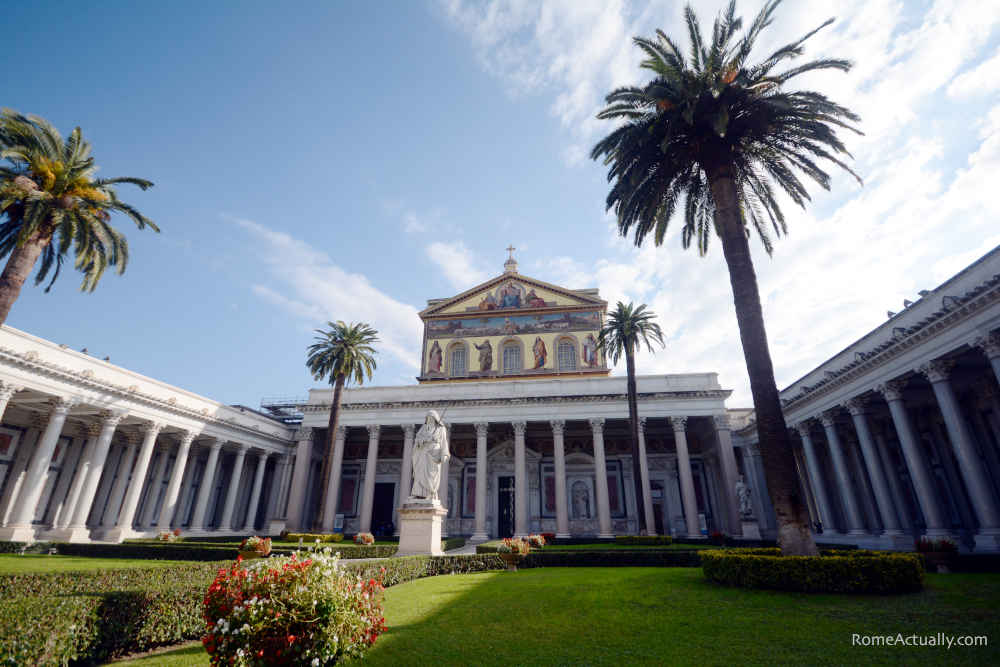
Stadium of Domitian
Have you noticed that Piazza Navona has an oval shape? Wondering why? Because it was built on top of a vast stadium wanted by emperor Domitian in an effort to shift his fellow citizens’ interest from the gory shows of the Colosseum to more well-behaved Greek sports disciplines.
The imperial effort went unsuccessful for the most part, but the remains we can see today from Via di Tor Sanguigna of Domitian’s Stadium show a finely decorated theater with carvings and ornamental statues. Visitors can also watch an interesting representation of how both the stadium and the city of Rome were at the time of Domitian.

Rome’s Catacombs
Even though scattered all around the city, I gather Rome’s Catacombs in one paragraph because they are quite a lot and belong to pretty much the same period of time, the early Christianity in the city.
From Priscilla Catacombs near Villa Ada Park to the huge San Callisto’s in the Appian Way, visiting Roman ancient burial sites is very fascinating to understand an important part of the local history and society in what it concerns both the Christian persecutions, the cult of the dead and the transition from paganism to Christianity.
Rome’s Mithra Temples
Similar to the Catacombs, also the sanctuaries devoted to the Persian god Mithra are several in Rome so even though placed in several locations, I think it’s less confusing to gather them under the same roof.
Apart from the one mentioned above located below San Clemente Basilica, most Mithra temples are underground and often open to the public only after previous booking and request to the Council (060608) or to a certified guide. Those that are worth a visit are the ones of the Baths of Caracalla, the Circus Maximus and underneath Palazzo Barberini .
Pyramid of Caestius
Located in the Testaccio neighborhood near Ostiense, Rome’s Pyramid is pretty difficult not to notice since it’s huge and stands out from all the other buildings in the area. It was built by Caius Cestius between 18 and 12 BC at a time when the Egyptian style was very popular in Rome.
Unfortunately, it’s not always open so if you want to enter, you should call Rome municipality at 060608 for inquiries. Otherwise, you can go see it from outside and maybe enter the adjacent Protestant Cemetery where you will also stumble upon the sweet cats of the Pyramid’s colony that often jump into the graveyard to relax.
Trajan’s Markets
At this site, you will be visiting an archaeological area and a museum, the permanent exhibition of Imperial Fora, the huge archaeological park along Via dei Fori Imperiali connecting Piazza Venezia with the Colosseum.
The area housed shops and administration offices and what we call the Trajan’s Markets was where they managed all the activities related to the Trajan’s Forum. The tour includes traditional and interactive panels as well as multimedia presentations showing how the Imperial Fora were in their heyday.
You will see parts of decorations, pillars, temples, columns, sculptures, capitals from all the imperial fora including the ones of Julius Caesar, Augustus, and Nerva, apart from Trajan’s one. As a big perk, when visiting this archaeological site, you can also enter the ruins of Trajan’s Forum.

Domus Aurea
Relive the splendor of Nero’s Domus Aurea he built for himself after the devastating fire that in 64 AD destroyed much of Rome’s city center. This was the sumptuous home emperor Nero built for himself and included a large complex of gardens and other areas destined for the entertainment of the family or for residential purposes.
Occupying a surface of more than 50 hectares over the Palatine and the Esquiline Hills, according to historians, the Domus Aurea was the largest and most opulent residential mansion ever built in Rome.
Even though after Nero’s death his successors tried to erase everything linked to him also by looting its residence from all its decorations, today it’s possible to visit what’s left of it and see how it was back in the day thanks to the immersive multimedia Domus Aurea Experience. Here for more info .
Circus Maximus
Not far from the Colosseum, the Circus Maximus was a huge oval-shaped racecourse for chariots. Today is mainly used as a park, for relaxing, and running, and also for public events such as concerts, New Year’s celebrations, and for festivals and activities the council organizes on the occasion of Rome’s birthday on April 21st .
Since on the actual site there is no illustrative panel, a nice way to enjoy your visit and see how it looked like back in its heyday is to join the recent Circo Massimo Experience sponsored by Rome Council, a tour of the place with the aid of Zeiss VR devices for multimedia reconstruction. Click here for more info on timing, prices, and how to book.
Nearby, you can visit the Baths of Caracalla and, if you happen on the weekend, you can visit one of the best food markets in Rome , Mercato Campagna Amica al Circo Massimo (Via di S. Teodoro 74).
Domus Romane of Palazzo Valentini
Not far from Piazza Venezia is Palazzo Valentini (Via Foro Traiano 85), a 16th-century palace now the seat of Provincia di Roma. In its undergrounds, it’s possible to visit the ruins of an ancient Roman domus , a patrician house belonging to a powerful family from imperial times, probably of a senator, that still preserves mosaics, colorful flooring, and finely decorated walls, and shows even the remains of a private thermal bath.
Diocletian Baths at Museo Nazionale Romano
Museo Nazionale Romano is a museum in Rome spread into several locations. The main one is next to Stazione Termini and is staged all around the huge Diocletian Baths, the ruins of which you can visit during your tour. The museum itself, even though not an archaeological site, displays arguably the world’s largest collection of ancient Roman findings, tools, mosaics, decorations and more.

Crypta Balbi
On the other hand, Crypta Balbi is located in Via delle Botteghe Oscure between Largo Argentina and Piazza Venezia. Standing right next to the theater Lucius Cornelius Balbo built in the 13th century BC, the crypt was a covered porch to serve as a protection for the citizens waiting to enter the nearby theater in case of rain or as a refreshing point for the breaks during the plays.
Largo Argentina
Largo di Torre Argentina is an important sacred area of Ancient Rome consisting of four large temples. One of the first temples built here dates back to the 3rd century BC and was commissioned by the naval commander Gaius Lutatius Catulus after his victory against the Carthaginians.

The second temple was erected in the 2nd century BC at the request of Quintus Lutatius Catulus and lies near the oldest of all the temples of Largo Argentina, the one devoted to Feronia, ancient Sabine divinity, built between the 4th and 3rd centuries BC.
Largo Argentina is also famous for being the place where important Roman statesman and commander Julius Caesar was murdered and for hosting one of Rome’s largest feline colonies.
As a fantastic update, the important Roman archaeological site of Largo Argentina has been finally opened to visitors who can access and have a tour around it for 5€ per person. In summer, it’s open until 7 pm, and in winter, until 4 pm (last entrance, an hour before closing time).
Insula of the Ara Coeli
It’s such a pity that this wonderful place is hardly noticed by the crowds. Probably its position slightly hidden from the main route or its being below modern-day street level are the culprits for it being so out of the radar even though one of the most important ancient ruins in Rome and revealing of the urban planning and development of Roman times.

To face the increasing overcrowding of the city between republican and imperial times, Romans started to build tall blocks of flats that would develop vertically instead of horizontally. From the street, if you look down over the fence, you can see all four floors the insula was originally built with, the shops ( tabernae ) of the ground floor, and beautiful frescoes on the upper level.
About The Author: Angela Corrias

Visiting Rome in May – All You Need To Know (2024 Edition)
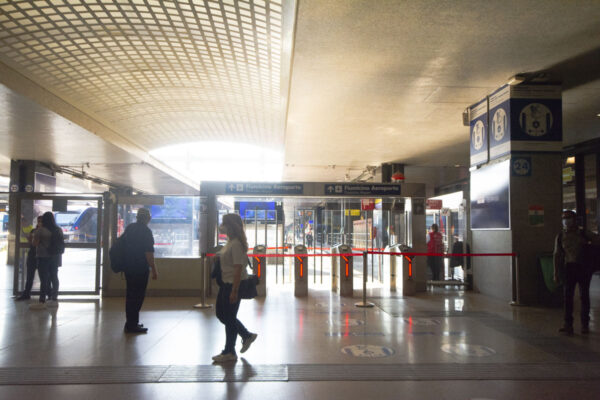
Traveling from Rome Termini to Fiumicino Airport – All You Need to Know
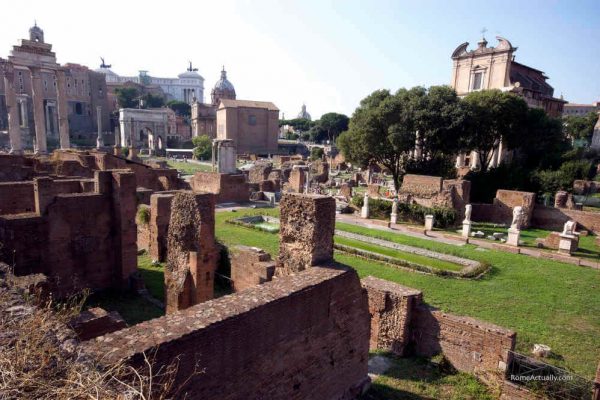
Birthday of Rome, All You Need to Know About the 21st of April in Rome (2024)
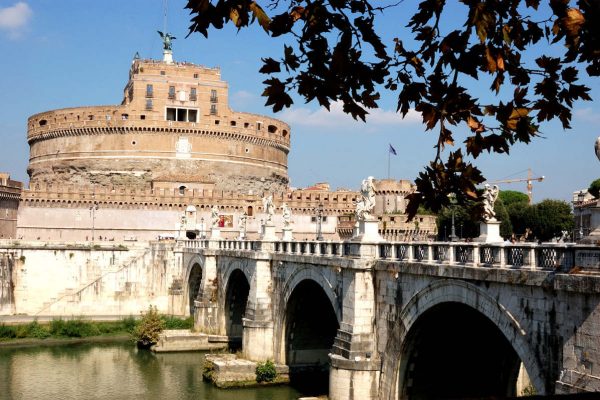
Rome in 2 Days: How to Make the Best of a Weekend in Rome
Leave a Comment Cancel reply
This site uses Akismet to reduce spam. Learn how your comment data is processed .
Privacy Overview

30+ Ancient Roman Ruins & Archaeological Sites In Rome
If you’re a history buff, you’ll definitely want to check out my guide to 30 must-see Roman ruins, archaeological sites, and historic landmarks in Rome, Italy. These attractions are some of the best ways to experience the city’s rich history.
Rome is a city filled with magnificent ancient sites and can be overwhelming to navigate. Essentially, the city itself is a sprawling outdoor museum that transports you to a bygone era at every turn.
With so many incredible ruins to explore, you’ll want to plan your visit carefully to make the most of your time.
Many of these Roman ruins tell great stories: Roman armies vanquishing foes, heros cementing legacies, and dedications to gods to seek their protection.
If you listen closely, you can hear Julius Caesar and his cohorts speechifying, promenading, and leading victory parades through the Roman Forum.
READ : History of the Rise and Fall of Ancient Rome
2,000 years ago, Rome was synonymous with “civilization.” You were either civilized or you were a barbarian to be defeated.
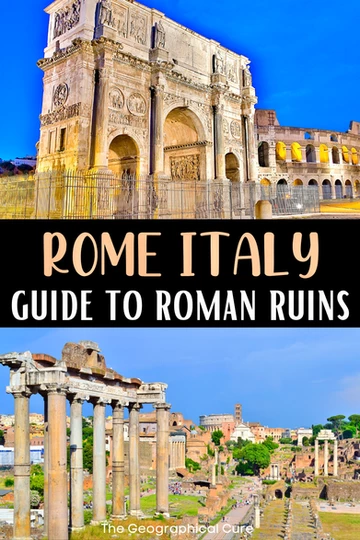
To attest to their then-civilized nature, ancient Romans left a raft of fascinating ancient buildings, temples, forums, and sculptures.
Some are hulking ruins. Others are well preserved and offer a secret peak into Rome’s tumultuous past and controversial rulers.
Let’s tour the 31 most interesting ruins in Rome that should be on your Italy bucket list .
Roman Ruins And Archeological Sites In Rome Italy
Here are my picks for the 30+ must visit Roman ruins in Rome.
1. Domus Aurea: Nero’s Underground Golden House
Nero’s Golden House was once the grandest building on earth.
It’s not your typical Roman tourist site, and is an often overlooked hidden gem in Rome. Domus Aurea is an excavation in progress, one of Rome’s best Roman ruins and archaeological sites.
Built by Emperor Nero between 64-68 AD in the heart of imperial Rome, the sprawling property covered up to 300 acres. The facade and walls were adorned with frescos, gold leaf, glass mosaics, pearls, and marble. In natural light, it had a golden hue.
READ : History of the Roman Emperors
But little of this wealth survived Nero’s rule. As Nero’s extravagance and tyranny spun out of control, rivals condemned both his reign and his emblematic palace.
For a decade after his death, the palace was looted, destroyed, and filled in with brick. But the vivid frescos by the artist Famulus couldn’t be pried off the walls.
At the end of the 15th century, the Domus Aurea was discovered by accident when a young man fell into a crevice. To his surprise, he found himself surrounded by paintings.
At first, the palace ruins were thought to be caves or grottos. Artists like Michelangelo and Raphael flocked to see the ancient frescos.
In the 18th century, proper excavation of the Golden House began. Now, you can visit (with a hard hat) on the weekends. The crown jewel is the Octagonal Room, which represented a revolution in architectural style and technique. Here’s my compete guide to Domus Aurea .
Thanks to YouTube, you can also take a virtual tour of the ruins of Domus Aurea, still an excavation in progress, and see how it would’ve looked looked almost 2,000 years ago in ancient Rome.
Click here to book a guided tour of Domus Aurea. Click here to book the virtual reality experience.
2. Domus Transitoria, Nero’s First Palace
Before there was Domus Aurea, there was Domus Transitoria. Nero’s first palace was built between 60 and 64 BC. The palace had a short life. It was destroyed in the great fire of Rome in 64 BC.
Like Domus Aurea, Domus Transitoria was a massive and lavishly decorated palace, connecting the Palatine Hill and Esquiline Hill. It was dubbed the Transit House.
According to Seutonius, Domus Transitoria was characterized by all the pomp, gold, and luxury one typically associates with grandiose Neronian architecture.
Domus Transitoria was just opened in April 2019. You enter and descend a staircase to inspect the site underground.
Virtual reality headsets bring the dank place to life, allowing visitors to see vignettes of the palace in its former glory.
You can take this YouTube virtual tour to see the ruins and a glimpse of what the palace looked like in ancient Rome.
3. Pantheon: Rome’s Most Perfect “Ruin”
Without a doubt, the Pantheon is the best preserved building from ancient Rome.
You’d don’t have to wrinkle your brow or struggle to conceptualize anything, as with many ruins. It’s all before you.
The Pantheon was a temple dedicated to all of the gods. It was originally built by Augustus’ right hand man, Marcus Agrippa in 27 BC.
The pediment still proclaims that “Marcus Agrippa, three times consul made this.” But Agrippa’s version was destroyed by fire.
In 120 AD, the Pantheon was rebuilt by Hadrian. The well traveled emperor, a true Grecophile, reimagined it as an oversized Greek temple.
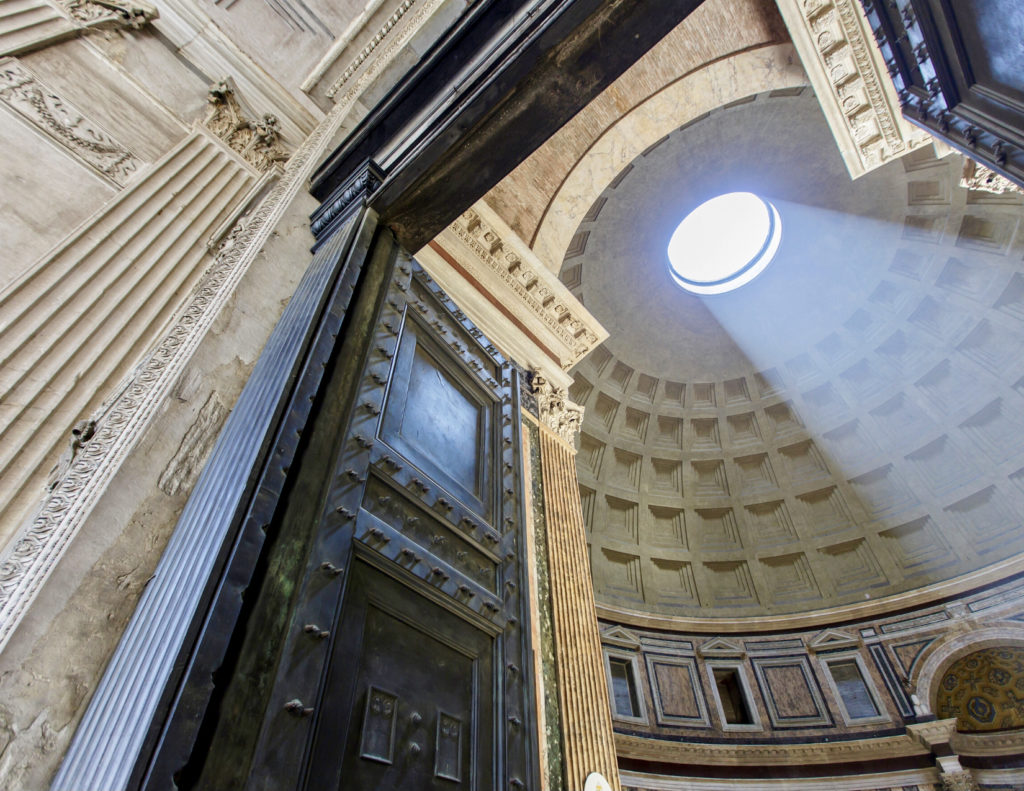
It has 40 foot tall Corinthian granite columns from Egypt, a pediment, and portico. It was considered a masterpiece of engineering and mathematical precision.
The Pantheon’s most emblematic feature is its perfect unsupported spherical dome. At the time, it was a major architectural breakthrough. The dome became the model for Michelangelo’s dome for St. Peter’s Basilica and for Brunelleschi’s dome for Florence Cathedral .
The dome is made of lightweight concrete, a Roman invention. The concrete gets increasingly thinner as the height of the dome increased.
The coffered ceiling also reduced the weight without compromising the dome’s structural integrity. At the top is the oculus, or eye, which is the Pantheon’s only source of natural light.
After the fall of Rome, the Pantheon became a Christian church, which helped save it from looting at first. But eventually the interior, marble, and gold were all looted in the 7th century, although the marble floor is recreated.
The Pantheon is filled with tombs of important Romans, including the artist Raphael.
You can take a 360 tour of the Pantheon here . And here’s a fantastic video from Smarthistory with shots of the Pantheon and an explanation of its importance.
Here’s my complete guide To the Pantheon . Click here to book a guided tour of the Pantheon.
4. Baths of Diocletian: Largest Baths in Ancient Rome
Rome took its baths seriously. They were places to swim, bathe, and socialize. The Baths of Diocletian were built by Emperor Maximian to honor his co-Emperor Diocletian.
Constructed between 298-306, the Baths of Diocletian were Rome’s largest bath complex. They were meant to surpass the Baths of Caracalla and could accommodate 3,000 citizens.
Ironically, Diocletian never saw the baths. Diocletian was a colorful man with a big ego, who thought he was a living god. Having successfully divided the empire to make it easier to manage, he governed in the east or camped out in his swishy palac e in Split Croatia .
The baths were built using the typical bath design of Roman times — with a frigidarium (cold), tepidarium (warm) and caldarium (hot), large bathing chambers, and gymnasiums.
There were smaller rooms for private bathing, changing, and meetings. On the ruins of the frigidarium, Michelangelo was commissioned to build a church, the Basilica of Santa Maria deli Angeli e dei Martiri.
Today, the Baths of Diocletian are part of the National Roman Museum. The baths aren’t particularly conveniently located. They’re in northeast Rome near the Termini station. The upside is that you can experience ancient ruins without the crowds.
Here’s a good YouTube video guide of the site. You can also explore the baths in Google Art & Culture .
Click here to book a skip the line ticket and guided tour for the baths.
5. Roman Forum: the Epicenter of Ancient Rome
I advise having a guided tour for the Roman Forum . It’s vast and there’s not much signage. It will be difficult to divine what you’re looking at without a guide to decipher the lovely rubble.
The forum is a rectangular valley running from Arch of Titus to the Capitoline Hill. The main road is the Via Sacre.
The forum was the beating heart of Rome, the seat of power, and its central showpiece. It was a grandiose district consisting of white temples, grand basilicas, and vibrant public spaces.
The Forum was the scene of political upheavals, funerals, and triumphant parades. Before the Colosseum was built, it even hosted gladiatorial battles.
Stroll by the Basilica of Constantine, the Temple and House of the Vestal Virgins, the Temple of Venus and Rome, the Basilica of Constantine, and the 3 columns of the Temple of Castor and Pollux.
You’ll also find the ruins of the Temple of Caesar . It was built by Augustus after Caesar’s assassination. Inside, in a small apse area, is a mound of stone and dirt covered with coins and flowers. This is the altar holding Caesar’s ashes and marks his grave.
You can take a virtual tour of the forum on Google Arts & Culture , with almost 300 different items to eyeball. You can also take a 360 tour on 360 Cities or a virtual walking tour with Pro Walks.
Most tickets include entry to the all the imperial ruins — Colosseum, Palatine Hill, and the Roman Forum. There are plenty tour options you can choose from.
They all vary slightly in duration and what you see. So pick one that best suits your sightseeing agenda.
I’ve done the fourth and seventh one on this list and loved both tours.
- skip the line entry tickets to all 3 sites
- tickets + a 2 hour guided tour for all 3 sites
- 3 hour guided tour and entry to all 3 sites
- tickets & tour of all 3 site s + underground Colosseum access
- Colosseum tour with entry tickets for Palatine Hill and the Roman Forum
- 4 hour private day tour of Ancient Rome
- skip the line private guided tour with an art historian
- skip the line private tour of all 3 sites + the underground Colosseum
6. Colosseum: Into the Gladiators’ Lair
Formally named the Flavian Amphitheater, the Colosseum has stood in Rome for almost 2,000 years. It’s the most instantly recognizable monument from the classical world.
Despite the ravages of time, the Colosseum is an incredibly well-preserved piece of Rome’s fascinating history.
Emperor Vespasian began constructing the Colosseum in 72 AD. It was finished by his son Titus in 80 AD. Domitian subsequently added the hypogeum, or basement.
In its glory days, the Colosseum was a vivid white with painted trim and frescoed hallways. There were monumental statues of the Greek and Roman gods in the arches of the middle two stories. The top story had a retractable canvas awning to shade spectators.
The Colosseum hosted the popular “games,” a form of ancient theater re-creating far flung lands and mythological themes for the masses. There were many variations.
The spectacles pitted men against men, men against beasts, and beasts against beasts. There was a menagerie of beasts — lions, giraffes, crocodiles, dogs, rhinos, elephants, etc.
The best way to visit the Colosseum, and go behind the scenes, is on an Underground Colosseum Tour. You’ll visit parts not accessed by the standard tickets, like the hypogeum and third ring.
You can tour the Colosseum on Google Arts & Culture , where there are over 200 photos. You can take a virtual walking tour of the Colosseum on its official website. Or take a 360 virtual tour on Air Pano.
Here’s my complete guide to the Colosseum , with must know tips for visiting. You can book guided tour of the Colosseum or a tour that also includes the underground gladiator area of the Colosseum .
7. Theater Of Marcellus: A Romantic Facade
Located in the Jewish Ghetto neighborhood of Rome, the Theater of Marcellus is easily overlooked by most tourists. But I walked past it everyday on the way home to my Air Bnb in Trastevere on my last visit.
The monument isn’t far from the gigantic white Monument of Victor Emanuel. And it looks like a mini-Colosseum.
The Theater of Marcellus is truly ancient. Julius Caesar launched construction and his heir Augustus inaugurated it in 12 BC. It could seat 20,0000. As you walk around it, you’ll see both Doric and Ionic columns. There are ruins piled up all around it.
Unfortunately, you can only admire the exterior and walk along the amphitheater edge. In the 4th century BC, the theater started to crumble. Thereafter, it was used as a stone quarry and repurposed, like so much else, for other buildings in Rome. In the summer, there are sometimes concerts outside.
Today, the Theater of Marcellus is a building that’s half private and half public. If you look at the photo, you’ll see luxury apartments lining the top.
8. Augustus’ Mausoleum: Family Tomb of Julio-Claudian Dynasty
Augustus’ Mausoleum is the family tomb of Rome’s first emperor. As mentioned above, Augustus ruled between 63 BC and 14 AD and was the great nephew and heir of Julius Caesar.
His mausoleum was built around 28 BC after the Battle of Actium. It was inspired by the mausoleum of Alexander the Great in Egypt.
The mausoleum was a burial place for Augustus, his wife Livia, and the other Julio-Claudian emperors. Not much has survived from its former grandeur and it’s original appearance is unknown. The mausoleum is closed to the public.
Though it was in ruinous condition, a 6.5 million euro restoration began in 2016 and was is only partially complete as of the summer of 2023. 50% of the structure is long gone — pillaged and destroyed.
The renovated monument opened to the public in March 2021 with a 3D experience, much like Domus Aurea. Hopefully, excavations will be fully complete in the summer of 2024.
Click here to book a skip the line ticket. Here’s a YouTube video of Rome’s mayor showing off the restored mausoleum.
9. Ostia Antica: an Alternative to Pompeii
Founded in 4th century BC, Ostia Antica is an ancient harbor town about 40 minutes outside Rome. It’s a pretty adorable town too, with warm orange stone buildings.
In ancient Rome, Ostia served as a naval base. Later, it became important commercially. This was where food and grain supplies arrived to feed Roman citizens.
There are some impressive preserved ruins. It’s similar to Pompeii — the excavation of an entire ancient city.
You get to wander around the ancient town at will.
Along the way, you’ll see a necropolis, an amphitheater, ancient temples and gates, the Baths of Neptune, statues, mosaic floors, and the forum. Mosaics were used to inform illiterate Romans about the purpose of a given building — tavern, baths, brothel, etc.
Click here to book a guided walking tour. You can also book a half day guided tour from Rome .
You can explore Ostia Antica virtually on Google Arts & Culture .
10. Baths of Caracalla, Termi di Caracalla
The Baths of Caracalla are another must visit Roman ruin in Rome. The baths were inaugurated by Emperor Caracalla in 216. The massive complex is one of Rome’s best preserved ancient sites.
Construction began in 206 AD, under the direction of Emperor Septimius Severus. His son, Caracalla, finished it 10 years later, after killing his brothers to seize sole power.
The baths could accommodate 1600 people. The original brick walls are still standing, a towering shell. They were once covered in stucco and marble. But that was long ago carried off by looters.
The sculptures and mosaics from the Baths of Caracalla have been moved to museums. The famous Belvedere Torso is now in the Vatican Museums .
The Farnese family pillfered and excavated the baths. The Farnese Bull and the Farnese Hercules are in Naple’s Archaeological Museum. Two fountain shaped bathtubs are now in the Piazza Farnese in Rome.
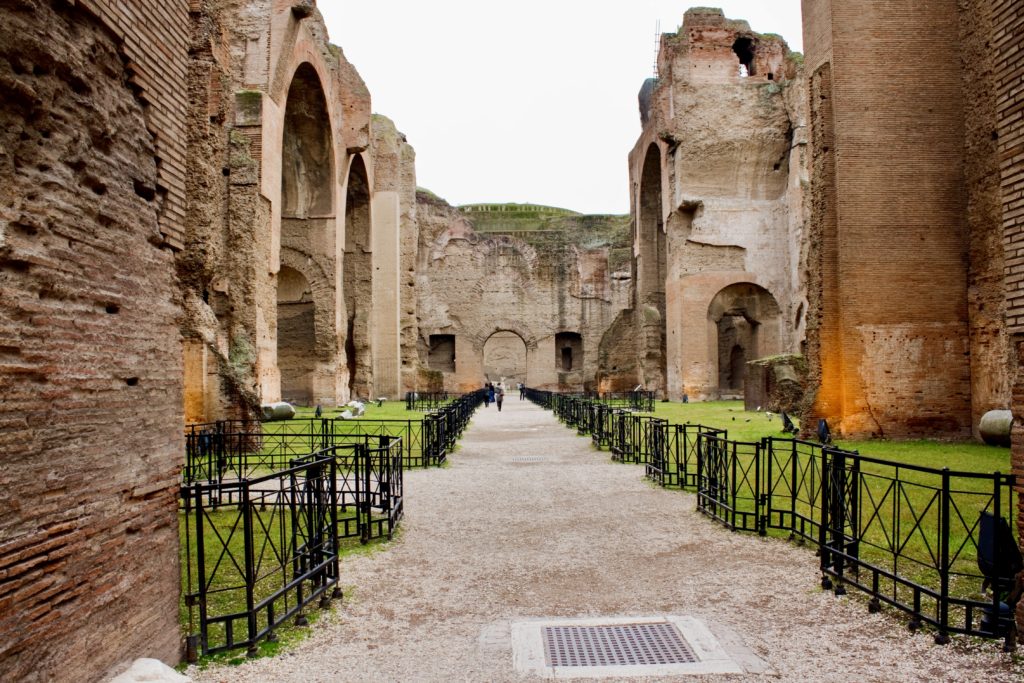
The large rooms at each end of the structure were used for exercise. In between was a long pool flanked with changing rooms and decorated with mosaics.
You can still see the black and white floor mosaics. To keep cool in the summer, the Romans played games in the pool on tables.
Tourist can even visit the underground tunnels of the bath complex, where slaves kept the baths going. You can also don virtual reality googles.
Here’s my complete guide to the Baths of Caracalla . You can book a small group or private tour of the baths. You can also book a tour that includes both the baths and the Circus Maximus . You can also visit the baths with the Roma Pass .
Every summer since 2014, the Baths of Caracalla are the backdrop for open air night at the opera performances . You can read about it and see shots virtually on Google Arts & Culture . You can also take a 4D tour of the Baths of Caracalla on Rome’s Coop Culture website.
11. House of Augustus, Palatine Hill
For nearly 2,000 years, the House of Augustus on Palatine Hill lay hidden. Archaeologists only discovered the ancient home in the 1960s.
The House of Augustus marked the transformation of Palatine Hill from a residential area into an imperial seat.
The House of Augustus is located on the most sacred area of the Palatine Hill, near the symbols of Roman power.
It was built near the Temple of Apollo (which Augustus could access by ramp from his peristyle) and on top of the sacred Cave of Lupercal, where the She Wolf of Rome nursed the twins Romulus and Remus.
Comprising two levels, the House of Augustus served as Augustus’ primary residence during his reign. It was arranged around two courtyards, linked by an open promenade. Emperor Domitian, a more megalomaniacal sort, demolished much of it when he built his massive palace.
The western end of the house held the domestic rooms. The eastern end held the public reception rooms. By far the most elegant room is the Emperor’s Study, where Augustus burned the midnight oil.
Protected behind glass, the walls are beautifully decorated with stylized winged obelisks, gryphons, and floral elements. The colors are bold — green, black, green, and yellow.
The House of Augustus is most celebrated for its lavish red Pompeian frescoes. They’re the best preserved frescos from ancient Rome, superior even to those in Pompeii. They’re the real reason you should visit the House of Augustus.
Most of the frescos are executed in the Second Pompeian Style, called the “Architectural Style.” It began in Pompeii, became the fashion, and was then adopted by Augustus.
The style emphasized architectural features and illusionistic compositions. Artists used columns, faux marble blocks, and stoas to frame fantastic images. The use of vanishing points made the walls seem three dimensional.
You can only visit Domus Augustana with a special ticket and a reservation. It’s not included in the standard ticket giving you access to Palantine Hill.
Access is via small groups of 20 on a 75 minute guided tour, with specific time slots on certain days. There are informative audiovisual and laser displays.
Click here to pre-book a guided tour of the House of Augustus. Here’s a YouTube video on the House of Augustus and the House of Livia (discussed below). Here’s my complete guide to the House of Augustus .
12. House of Livia, Palatine Hill
If you book a special ticket to see the House of Augustus, you’ll also see the House of Livia. Livia was Augustus’ third wife.
When Augustus fell in love with the beautiful young woman, they both divorced their respective spouses to marry. Livia’s son from her first marriage, Tiberius, became Augustus’ heir and the second emperor of Rome.
First excavated in 1839, Livia’s House was attributed to her when her honorific name was found stamped on a lead pipe. Built in the first century BC, Livia’s house was actually a bit larger and grander than her husband’s house.
The best preserved section is the atrium and three adjoining rooms. The central room (the tablinum) was the most richly decorated. Known as the Room of Polyphemus, it had mythological frescos showing Mercury kidnapping the nymph Io.
In the dining room, there was a stunning garden fresco that made the walls almost disappear. The fresco has flowering trees, blossoms, and flying birds in all varieties of nature.
The colors are delicate in faded purple, blue, yellow, and white.
The original of this fresco was moved to the Palazzo Massimo all Terme, one of Rome’s best museums . A replica is now in the House of Livia on Palatine Hill.
Here’s Smarthistory’s video about the magnificent garden fresco.
13. Domitian’s Palace, Palatine Hill
Domitian’s Palace is a Roman ruin that was built circa 81 AD by Emperor Domitian. He hired master architect Rabirius to create a massive imperial palace.
It was so grand that one poet remarked that it “made Jupiter jealous.” It was the residence of Rome’s emperors for three centuries.
Unlike previous emperors, Domitian wasn’t interested in public architecture. A megalomaniac, he viewed himself as “lord and god” and wanted the public to know it.
The palace contained many large spaces, including a basilica, receptions rooms, an audience hall, a stadium, a sunken garden, peristyle courts, and baths.
The part of the palace above the Circus Maximus was added by Emperor Severus. The Circus Maximus was a long oblong course for chariot racing. If the gladiator show at the Colosseum was sold out, the citizens would come here for entertainment.
Inside, the palace was decorated with reflective surfaces, probably white marble or selenium. A paranoid Domitian wanted to be able to spot any potential enemies and see what people were up to.
Each public room had apses, where Domitian could sit on a throne and be worshipped.
14. Arch of Constantine: Symbol of Christianity
The Arch of Constantine is a triumphal arch dedicated to Emperor Constantine the Great. It represents a seismic shift in history, when the western world became Christian.
Until 312 AD, Rome was a pagan empire. But a small, obscure, and previously persecuted sect was becoming more popular, Christian monotheists.
In 312, Emperor Constantine saw a vision of a cross in the sky. The next day, he defeated his rival Maxentius, becoming sole emperor. His first task as an agent of change was to legalize christianity.
The Arch of Constantine is on the Via Triumphalis in Rome, between the Colosseum and the Roman Forum. It’s approximately 21 meters high and 25 meters wide.
It’s decorated mostly with recycled carvings from other buildings and from different times. Because of this, some art historians have criticized the arch as poor craftsmanship.
But Constantine deliberately wanted reliefs from other great eras. To unscore this point, there are statutes of the great emperors on the arch, putting Constantine in good company. As a usurper himself, it was important to also be a symbol of reverence.
You can take a 360 tour of the Arch of Constantine here .
15. Arch of Titus
This intricate triumphal arch marks the entry into the Roman Forum. Emperor Domtian built it to celebrate his brother Emperor Titus’ destruction of Jerusalem in 71 AD.
The reliefs inside feature scenes of the Roman troops sacking Jerusalem, soldiers carrying bodies and taking items from the Temple in Jerusalem, and the first depiction of a menorah. The arch was intended to exalt the mythological status of the Flavian dynasty.
It was a terrible monument for Jews. In antiquity, Jews refused to walk under the arch because of it subject matter.
You would think the monument was anti-Semitic. But at the time, it was just business as usual — Rome putting down a rebellion, which was more about taxes than religious differences.
You can take a 360 virtual tour of the Arch of Titus.
16. Castle Sant’Angelo: Fortress Museum
Castle Sant’Angelo is also known as Hadrian’s Mausoleum. Hadrian built it on the banks of the Tiber River in 139. It’s a magnificently preserved ruin from Ancient Rome.
Hadrian also erected the Bridge of Angels, which connected central Rome to his mausoleum. The bridge is now lined with 10 angels, designed by Bernini and commissioned by Pope Clement IX. Each statue holds an object of Christ’s passion.
READ : Guide To the Bernini Trail in Rome
The cylindrical castle was richly decorated. Originally, it was faced with travertine marble, pilasters, and bronze. By the 5th century, the mausoleum was converted into a miltary fortress.
It was renamed Castle Sant’Angelo in the 5th century. Legend holds that the Archangel Michael appeared above the castle, sheathed his sword, and magically put an end to the plague.
In the 14th century, Castle Sant’Angelo was turned into a papal residence. A covered corridor connected it to St. Peter’s Basilica. Popes fled there during sieges.
In the 15th century, at the direction of the notorious Borgia pope, Alessandro VI, the castle became battle ready. He also installed sumptuous papal apartments decorated with frescos by Pinturicchio, who also decorated the Borgia Rooms in the Vatican Museums .
In 1536, a marble and bronze statue of Archangel Micheal was perched on top. There are gorgeous 360 views of Rome and St. Peter’s Basilica from the Terrace of the Angel. The museum also has a bar/coffee shop with splendid views.
You can take a virtual 360 tour of the Castle Sant’ Angelo here or check out this BBC documentary on the famous Roman monument.
Here’s my complete guide to the Castle Sant’Angelo , which is almost one of Rome’s hidden gems since so few venture inside.
In high season, you may want to book a skip the line ticket . Click here to book a guided tour with fast track access.
17. Mouth of Truth: Roman Lie Detector
This sculpture is a Pavonazzzo marble mask called la Bocca della Verita, the Mouth of Truth . It has the ambiguous face of an unknown pagan god with an open maw. It’s located in the portico of Santa Maria Church.
Legend holds that, in medieval times, the carved mask was a device for determining whether a person was telling the truth.
Suspicious people were brought to the sculpture. They took an oath and put their hand inside the gaping mouth while being interrogated.
If the detainee was being truthful, the mouth wouldn’t moved and you could keep your hand. If you were lying, the mouth would slam shut and bite off the hand.
The legend became famous via Hollywood. In the 1953 film Roman Holiday , the Mouth of Truth was used as a storytelling device.
I’m not sure this sculpture is worth a trip in and of itself. It’s been theorized to be a possible drain cover or fountain decoration. And the line for testing your hand can be long.
18. Trajan’s Market: World’s First Shopping Mall
Trajan’s Markets is a large complex of ruins that was part of Trajan’s Forum. This forum was the largest and most advanced of six imperial forums in Rome, as befitting Rome’s most popular and powerful emperor dubbed the “best leader.”
Trajan’s Market was built in the 2nd century AD by Trajan’s favorite architect, Apollodorus of Damascus. It’s affectionately called the world’s “first shopping mall.”
Trajan’s Market was a dense complex. It was once 6 stories with 150 shops and offices, set into the side of Quirinal Hill.
The structure is remarkable. It shows that Romans didn’t just build with columns and pediments. Powered by concrete, this urban structure was light filled, with windows and atriums.
Click here to book an entry ticket. You can also take an amazing virtual tour of Trajan’s Market from your couch.
19. Trajan’s Column: War Diary
Trajan’s Column was part of Trajan’s Forum. It’s probably the best preserved victory column in Rome, though it’s similar to the column for Marcus Aurelius in Piazza Colonna. Built in 113 AD, the column was a tour de force of Roman propaganda art.
The column celebrated Trajan’s defeat over the Dacians. It depicts the campaigns he fought against them, the fortifications that were built, the Dacian themselves, and their weaponry.
The column consists of 22 layers, one yard each, spiraled around a 125 foot high column. The emperor’s ashes were buried in the foundation after his death.
You wouldn’t know it, but there’s a staircase inside that takes you up to the top. Atop the column, there’s a statue of St. Peter. During the Renaissance, it replaced a statue of Trajan.
Here’s a great video showing and explaining Trajan’s Forum.
20. Catacombs of Priscilla
Dating back almost 2,000 years, the Catacombs of Priscilla are a series of catacombs built by early Christians. Known as the “Queen of the Catacombs” since antiquity, the catacombs house the bones of early popes and many Christian martyrs.
The Catacombs of Priscilla are considered one of Rome’s most interesting underground sites, hidden away under Villa Ada Park.
After five years of conservation and restoration, the Priscilla Catacombs opened to the public in 2018. Lasers were used to clean the religious frescoes on the walls.
Click here to book a guided tour of the catacombs. A new function on Google Maps allows you to take a limited tour of the of the vast complex. You can also see the frescos on this Smarthistory video .
21. Hadrian’s Villa: an Easy Day Trip From Rome
Built in 118-133 A.D, Hadrian’s Villa is an important archeological complex. It’s the largest and most spectacular villa of ancient Rome, three times the size of Pompeii. Hadrian’s Villa is an easy day trip from Rome , just 30 minute away.
It reflected the power and glory of ancient Rome and one of that world’s most important leaders, Emperor Hadrian. And it was designed by Hadrian himself, just like the Pantheon.
Hadrian’s Villa is a sprawling luxury palace. It was designed on a vast scale to reflect the power, elegance, and excess of the Roman Empire.
Though it’s called a “villa,” Hadrian’s Villa is more accurately a miniature Rome that covers nearly 300 acres. It’s dotted with 30 large structures — palaces, libraries, baths, living quarters, dining pavilions, and sculptural gardens.
Hadrian’s Villa was originally intended as a secret escape from the political complexities of a bustling Rome.
But Hadrian loved his villa so much that he moved in and used it as the seat of government in his last decade, much like Louis XIV governed France from Versailles.
Here’s a great Smarthistory virtual tour of Hadrian’s Villa. While you’re in Tivoli visiting Hadrian’s Villa, you should also visit the Renaissance era Villa d’Este .
Here’s my complete guide To Hadrian’s Villa . Click here to book a wonderful guided day tour from Rome.
22. Arch of Janus
The Arch of Janus is the only surviving four way marble arch in Rome. It’s close to the Mouth of Truth, if you’re visiting that. Built in the 4th century, the arch has four facades. It was supposedly built from pieces of other ruins.
The Arch of Janus is built over an ancient drain to the Tiber River. It’s thought to have been a boundary marker, rather than a triumphal arch.
The Arch of Janus now stands in front of the Palazzo Rhinococros. In 2012, the building was purchased and restored by Fendi heiress, Alda Fendi. It’s the newest hotspot/art space in Rome, with cultural and residential spaces that opened in 2018.
A resin sculpture of an endangered white rhino now stands guard in the square, symbolizing the union of the old and the new. Inside the palazzo art gallery, there’s a Michelango sculpture, Crouching Boy, on loan.
23. Forum of Augustus
The Forum of Augustus is one of the Imperial Fora from Ancient Rome. This forum was built after a young Gaius Octavius defeated Brutus and Cassius in the Battle of Philippi. Octavius was avenging the murder of Julis Caesar.
Before the battle, Octavius vowed that, if he won, he would build a temple to Mars Ultor, which translates to the Avenger. After winning the battle, Octavius kept his promise.
He located his forum next to Caesar’s. At the center was the Temple of Mars Ultor. The long sides of the forum sported colonnades.
The once richly decorated Hall of the Colossus held a colossal statue of the Genius of Augustus. Remains of the statue are in the Museum of the Imperial Fora.
There is also the remains of the Great Wall toward the Suburra. The wall was intended to protect the forum from an overpopulated part of Rome subject to frequent fire. It’s one of the most impressive ruins in the Imperial Fora.
The Temple of Mars Ultor once held colossal statues of Mars and Venus, linking Augustus with the gods. Archaeologists think there may have been a third statue depicting a deified Julius Caesar.
In general, the forum functioned as a military, administrative, and political center. It was a gallery of statues and place to hold important ceremonies.
It was also a place for Senate deliberation. Military commanders would make sacrifices to Mars before going off to battle.
24. House of the Knights of Rhodes
The House of the Knights of Rhodes is perched right above the Forum of Augustus. It’s a little known hidden gem in Rome .
This impressive building, known as the House of the Knights of Rhodes, was built in the 13th century by the Knights of Rhodes. It’s been controlled by the Knights of Malta since 1946.
The building features a massive five-arched loggia, which was once used by the pope to receive blessings from the citizens while overlooking the city.
If you’re interested in visiting, note that the House of the Knights of Rhodes is only open to the public by reservation on Tuesdays and Thursdays. Inside, you’ll have the chance to see several interesting rooms, including the Hall of Honor, the Byzantine Hall, the Sala della Loggetta, and the Palatine Chapel, which is dedicated to St. John the Baptist, the patron saint of the knights.
To catch a glimpse of the house from the outside, head to Via dei Fori Imperiali, which offers an excellent vantage point.
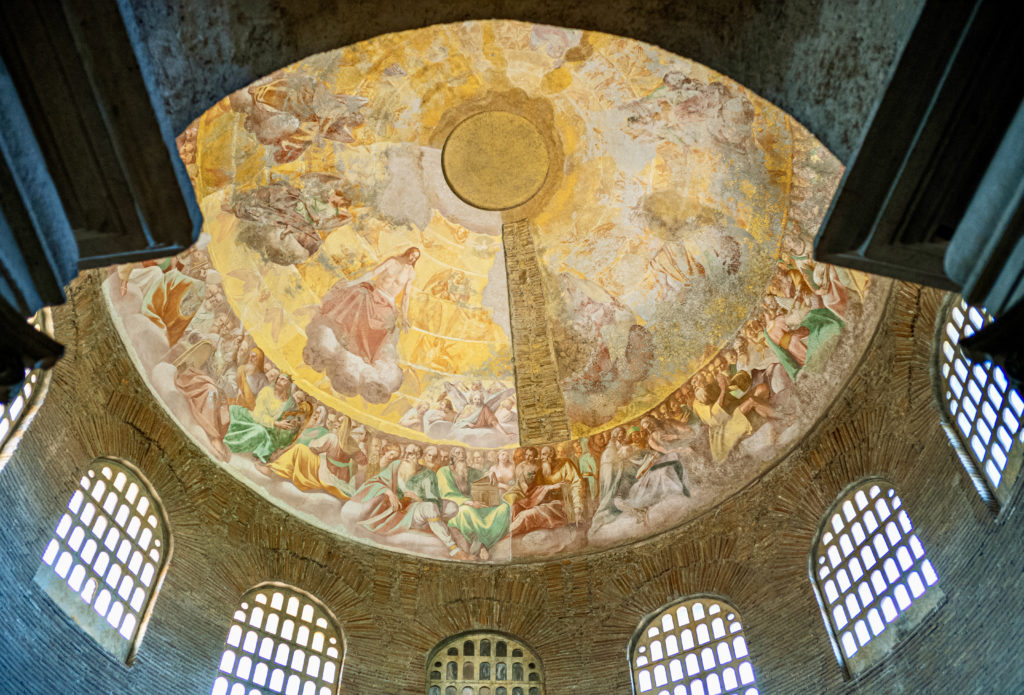
25. Church of Santa Costanza
This church is traditionally identified as the mausoleum of Constantina, the daughter of the Emperor Constantine. It was likely built by Constantine at the behest of his daughter.
But, after excavations in 1992, some historians speculate that the mausoleum may have been built 30 years later by Emperor Julian for his wife Helena. It officially became a church in the 13th century.
This 4th century mausoleum is considered a fine example of early Christian architecture. It is a circular brick rotunda covered by a dome with a vestibule porch.
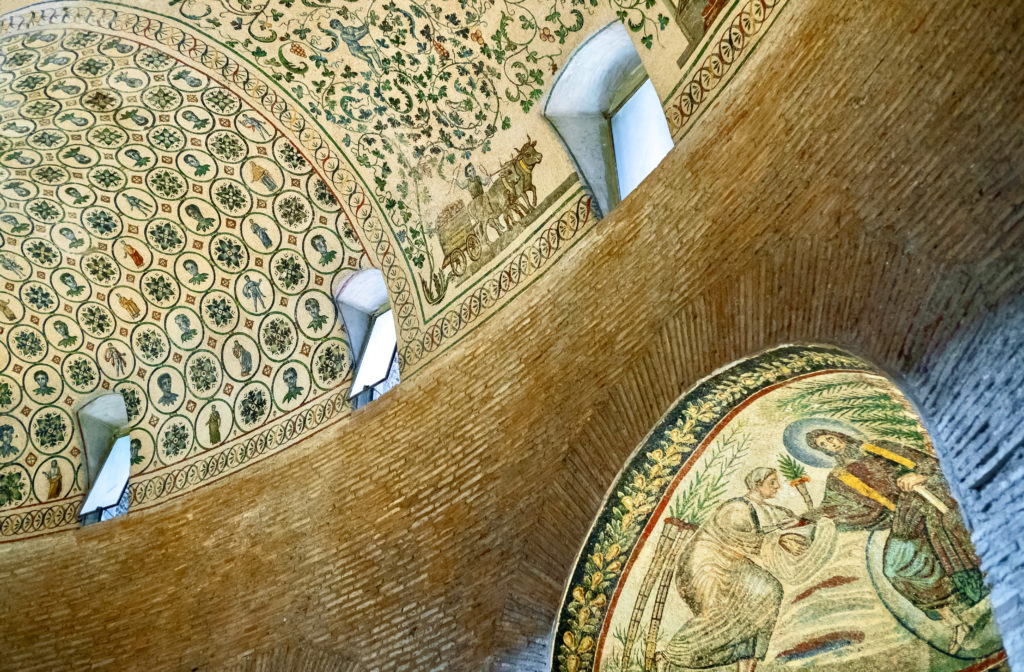
Inside, 12 pairs of Corinthian columns are arranged in a ring. 12 clerestory windows that let light into the interior.
The mausoleum was once elaborately decorated. Originally, the cupola, vault, and niches were covered with early Christian mosaics.
You can still see some in the vault and several niches. They were restored in 1840.
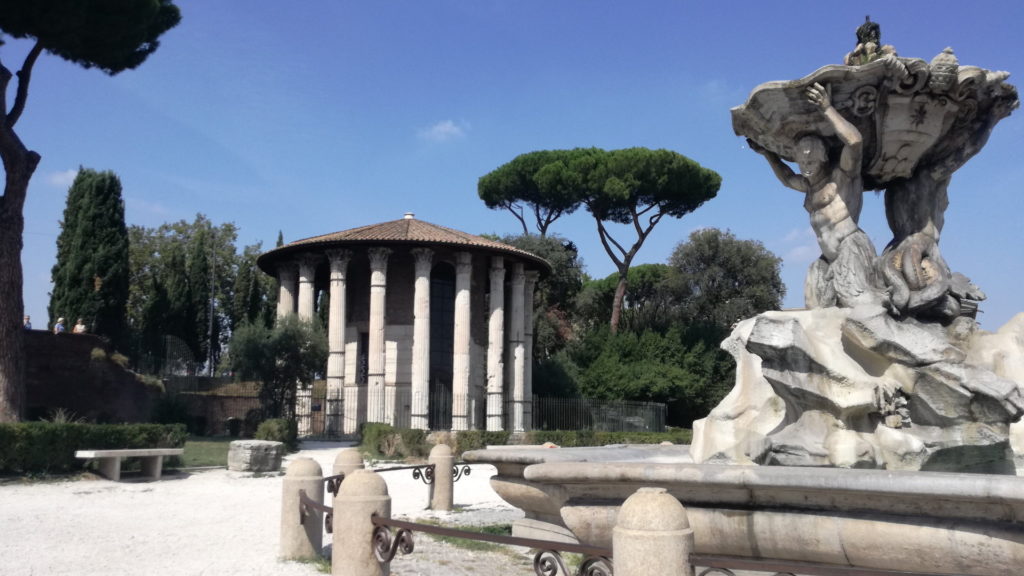
26. Forum Boarium
The other Roman forums get all the love, and so they should. Whereas these famous forums are named for emperors, the Forum Boarium is named … for cattle.
The forum is a Roman ruin that was once the true commercial heart of Ancient Rome. It was the working man’s forum where the docks were located.
The most notable buildings on this forum are the Temple of Hercules (shown above) and the Temple of Portunus.
The Temple of Hercules is the oldest surviving marble building in Rome. Hercules, of course, was the legendary hero of superhuman strength. The Mouth of Truth was likely once located in this temple.
Portunus was the god of gateways, locks and livestock. He might not be the most glamorous god of the Roman pantheon. But he did his job well, granting good luck to the all important merchants.
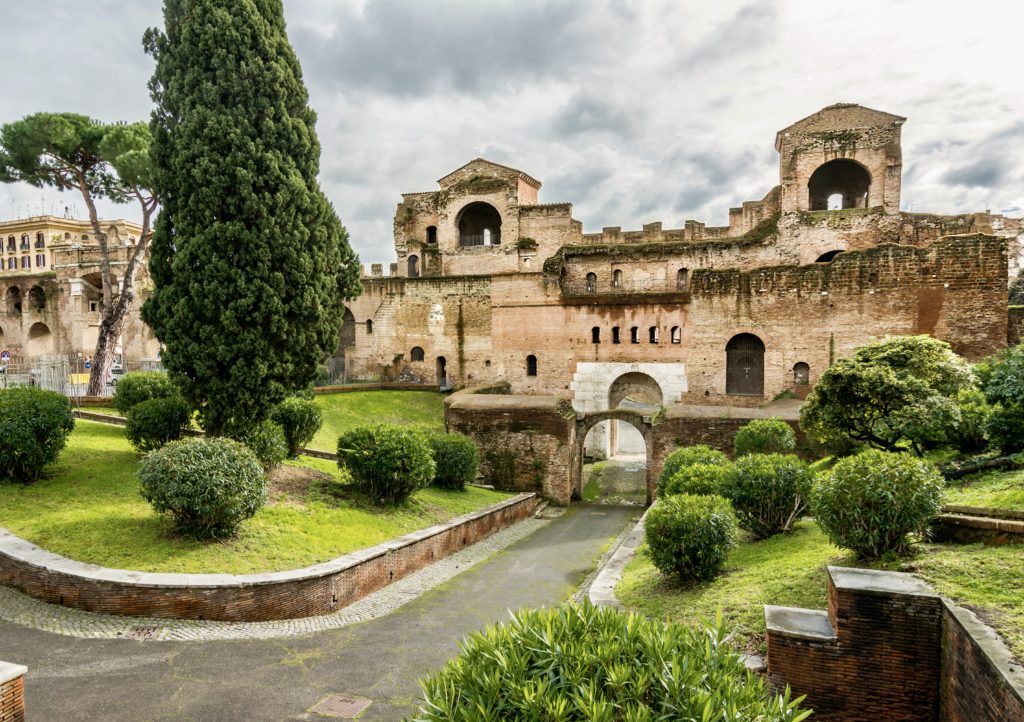
27. Aurelian Walls
The Aurelian Walls in Rome are the biggest, but most neglected, ruins from Ancient Rome.
The walls date from the 3rd century. They were 12 miles long and 26 feet high, with 14 gates and 380 watch towers.
The Aurelian Walls take their name from Emperor Aurelian, a warrior emperor who sought to protect Rome from barbarians when the empire teetered on collapse.
The emperors Arcadius and Honorius made further reinforcements. The two main gates were transformed into self sufficient fortresses. The height of the walls was increased to about 52 feet.
The walls survived the fall of Rome, though parts of the wall were later torn down during the Middle Ages. They continued to serve a defensive function, until they were breached in 1870. This marked the beginning of the unification of Italy.
Here’s my complete guide to the Aurelian Walls .
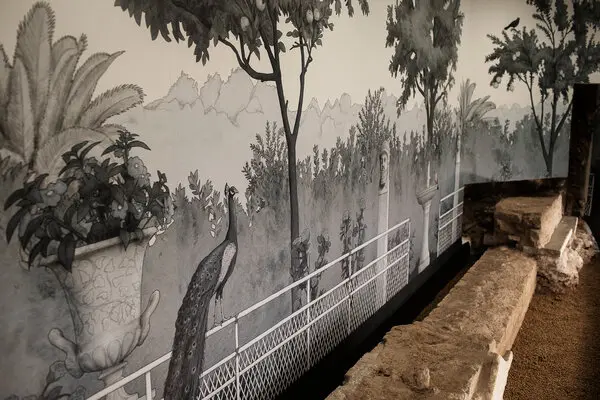
28. Caligula’s Garden Of Delights
Caligula was the fourth of the Caesarian emperors. He’s mostly known as a combustible lunatic and tyrannical ruler who married often and never forgot a slight.
During the four years he occupied the throne, Caligula had a favorite hideaway. It was an imperial garden called Hour Lamiani on Esquiline Hill.
The garden was essentially a wildlife park, filled with shrines, banqueting halls, orchards, and fountains. Exotic animals completed the tableaux. They were used for private circus games.
Archaeologists discovered the Roman ruins of the lavish garden complex under a 19th century apartment building during excavations in 2006-15.
In April 2021 the Nymphaeum Museum of Piazza Vittorio was opened. You can see highly decorative frescos, mosaics, ceramics, jewelry, pottery, and animal bones.
They paint a vivid picture of wealth and opulence of imperial Rome and the appetite for luxury of Caligula.
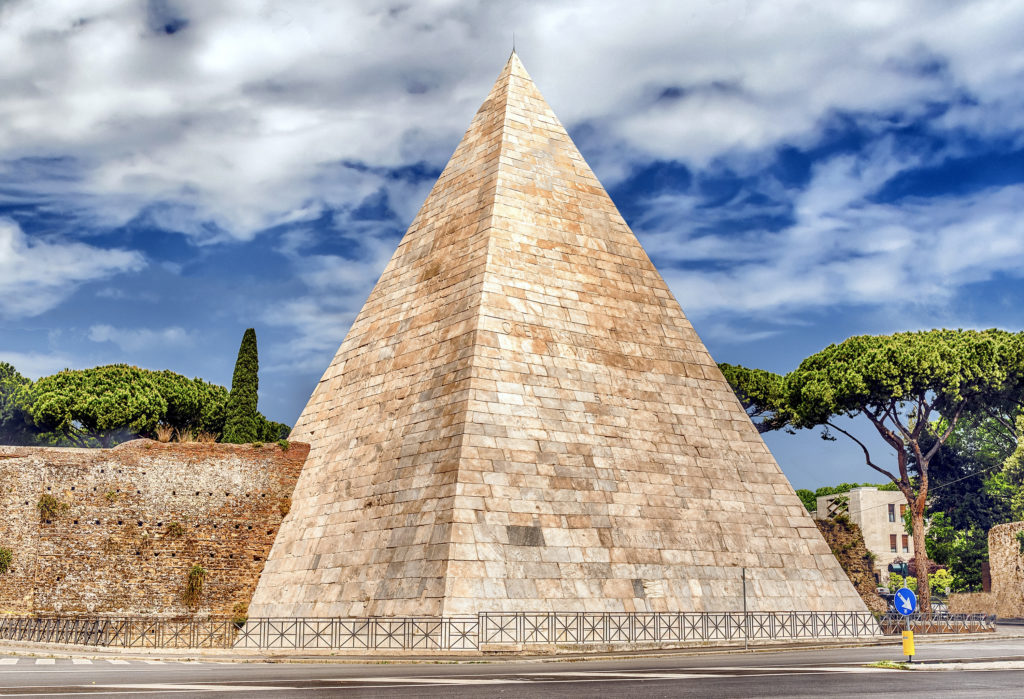
29. Pyramid of Cestius
Rome was a little obelisk crazy in its heyday. Egypt was downright fashionable and astonished wealthy and Rome aimed to emulate its example.
In fact, Rome has more obelisks than the country of Egypt. 8 are Roman and 5 are Egyptian. They’re a symbol of what Rome once was — the cultural hub of the known world.
The Roman pyramid was most likely built between 18 and 12 B.C. during the reign of Augustus. The pyramid is 120 feet high and covered in white Carrera marble.
You can tell it’s not the real deal. The pyramid is too steep and pointy, compared to the real Egyptian pyramids of Giza.
Cestius was built as a tomb for a wealthy Roman under the sway of all things Egyptian. The tomb was long ago ransacked.
The pyramid was excavated and restored in the 16th century. Many of the columns and sculptures that once surrounded it are in the Capitoline Museums .
You can visit the pyramid on a guided tour . If you want to visit solo, reservations must be made in advance.
30. Ara Pacis
Another Roman ruin to visit in Rome is the Ara Pacis monument. The Roman Senate commissioned this Altar of Peace in 13 BC to honor Emperor Augustus.
It’s a piece of Roman propaganda. Augustus had just defeated the barbarians. His victory marked the beginning of the Pax Romana, a 200 year golden age where arts and architecture flourished.
The altar was once part of a large complex. But the Ara Pacis Museum opened in 2006 and is dedicated to this single monument.
The museum is housed in a modern glass and steel pavilion designed by American architect Richard Meier. It’s light and airy.
The monument is adorned with imagery and wonderful relief carvings depicting the history of Rome and Augustus’ accomplishments. The message was clear. Rome was safe and stable under Augustus.
If you don’t want to pony up the rather outrageous entry fee, you can admire the ornate altar through the windows or take the museum’s virtual tour here .
But if you do want to go inside, click here to book a skip the line ticket for the museum.
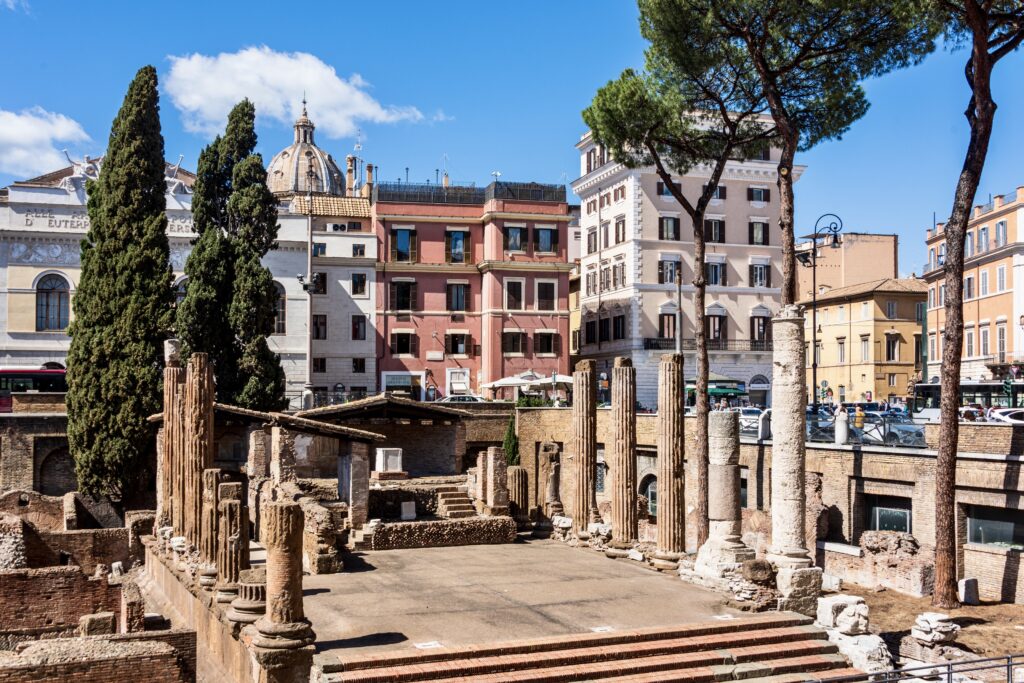
31. Largo di Torre Argentina
Largo di Torre Argentina is an archaeological site in the heart of Rome just minutes from Piazza Navona . Excavations have revealed the remains of four Republican-era Roman temples and part of the ancient Theatre of Pompey.
This is ancient stuff, dating from the 3rd century B.C. For history buffs, this is also the place where Julius Caesar was (most likely) assassinated in 44 BC.
Apart from its historical importance, Largo di Torre Argentina is also known for its association with cats. The square has become a sanctuary for stray cats. There is a designated area called the “Roman Cat Sanctuary.”
In the past, visitor could only gaze at the ruins from an observation platform at street level. But the ruins just opened to the public for the first time in June 2023. Now, you can go below and stroll along new walkways.
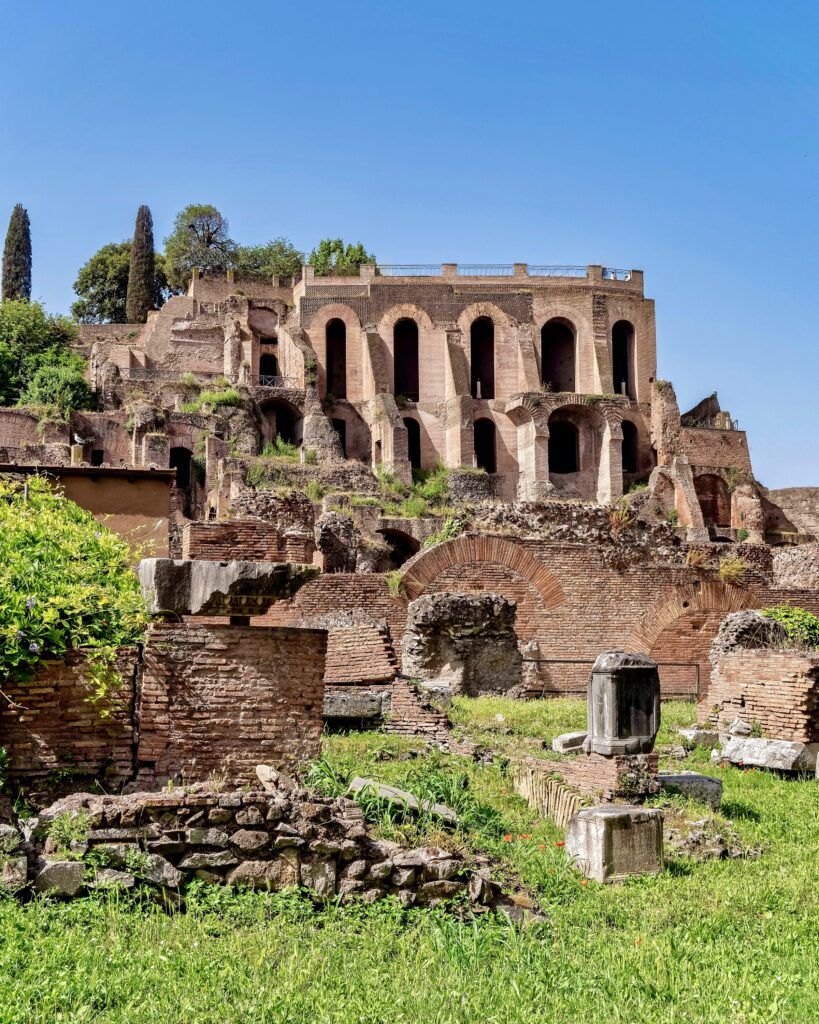
32. Domus Tiberiana
Another Roman ruin on Palatine Hill is Domus Tiberiana. It was the first official imperial palace in Rome.
The palace was built during the reign of the Roman Emperor Tiberius (14-37 AD). Tiberius used as a residence before he became emperor. And it became the designated abode of the designated heir to the empire.
Until recently, it had barely been excavated as it was overlaid by the Farnese Gardens in the 16th century. In September 2023, it will reopen to the public after more than 40 years of restoration.
I hope you’ve enjoyed my guide to the must visit ancient Roman ruins of Rome. You may enjoy these other Rome travel guides:
- 8 ways to spend 1 day in Rome
- 3 day itinerary for Rome
- 5 day itinerary for Rome
- 1 day itinerary for Vatican City
- Hidden gems in Rome
- Best museums in Rome
- Guide to the Borghese Gallery
- Guide to Palatine Hill
- Guide to the Roman Forum
- Guide to the Colosseum
- Walking tour of central Rome
If you’d like to visit must see ruins and historic landmarks in Rome, pin it for later.
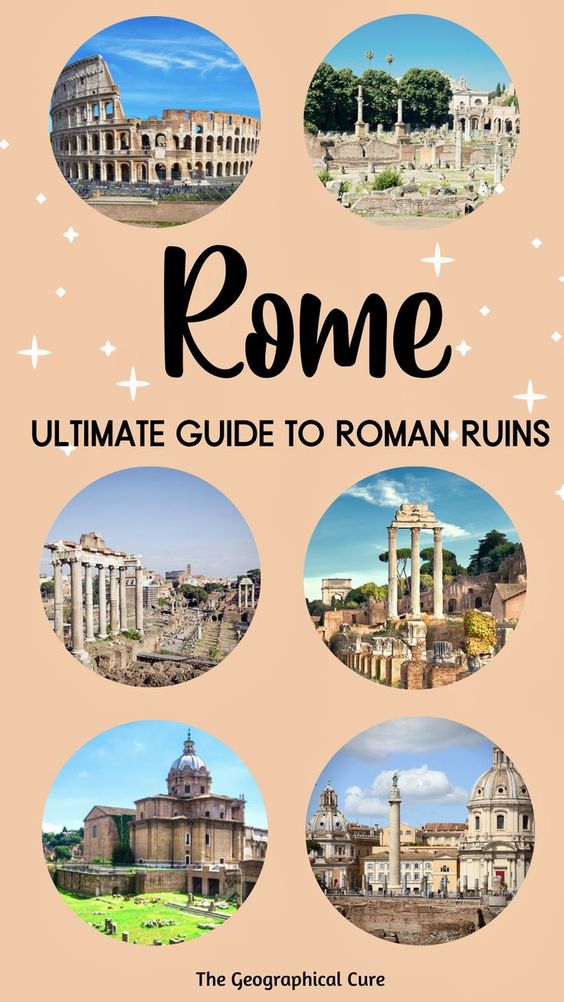
Leave a Comment Cancel reply
Save my name, email, and website in this browser for the next time I comment.
Last Updated on August 22, 2023 by Leslie Livingston
Awesome, you're subscribed!
Thanks for subscribing! Look out for your first newsletter in your inbox soon!
The best things in life are free.
Sign up for our email to enjoy your city without spending a thing (as well as some options when you’re feeling flush).
Déjà vu! We already have this email. Try another?
By entering your email address you agree to our Terms of Use and Privacy Policy and consent to receive emails from Time Out about news, events, offers and partner promotions.
Love the mag?
Our newsletter hand-delivers the best bits to your inbox. Sign up to unlock our digital magazines and also receive the latest news, events, offers and partner promotions.
- Things to do
- Restaurants
- Los Angeles
Get us in your inbox
🙌 Awesome, you're subscribed!

11 unmissable attractions in Rome
Take a look at the best of the best attractions in Rome, from magnificent churches and ancient ruins to world-famous artworks
Rome sells itself; we all know that. An unmissable attraction in Rome is about as unmissable as you are going to find, and this famous old city is packed with iconic spots that most cities would give their right arm for. Okay, cities don’t have arms, but you get the point. The Eternal City stands head and shoulders above most for historical and cultural might, and the best attractions in Rome are seriously impressive. You’d be forgiven for thinking Rome can’t possibly deliver on all its hype. Well, prepare yourself because it hits all the notes and then some. It has world-beating restaurants , fabulous bars , genre-defining galleries and all the history you could hope for. These are the most essential attractions in Rome, your ultimate Eternal City bucket list.
This article includes affiliate links. These links have no influence on our editorial content. For more information, see our affiliate guidelines .
An email you’ll actually love
Best Rome attractions

1. Colosseum
- Attractions
- Historic buildings and sites
The Colosseum is a monument of epic proportions dating from AD 72. Stories of gory battles between gladiators, slaves, prisoners and wild animals have emerged from this Flavian amphitheatre with a seating capacity of over 50,000 people; nowhere in the world was there a larger or more glorious setting for mass slaughter. This is a necessary pilgrimage for history buffs and the ideal starting point to take in the Roman remains of the city: the jaw-dropping Forum, the Domus Aurea and the Pantheon.
Where? Piazza del Colosseo.
Time Out tip: The best time to visit the Colosseum is early in the morning, or if you prefer, in the late afternoon before closing to avoid the sun.

2. Roman Forum and Palatine
The oldest of Rome’s fora, the Foro Romano (Roman Forum), was once the centre of state ceremony, commerce, law and bureaucracy. Above the Colosseum to the west (and visited on a cumulative ticket with the Foro Romano and the Colosseum) is Rome’s birthplace, the Palatine. Later, the Palatine became the home of the movers and shakers of both the Republic and the Empire as sumptuous palaces were built. The choice of location was understandable: the Palatine overlooks the Foro Romano yet is a comfortable distance from the disturbances and riff-raff down in the valley.
Where is it? Via della Salara Vecchia.
Time Out tip? Since there are no gift shops or cafes on the grounds, it's the perfect excuse to pay a visit to the vegan-friendly Grezzo Raw Chocolate serving a delectable range of chocolate desserts.

3. Musei Vaticani and Cappella Sistina
- Art and design
If you met the Pope, what would you say? Well, you probably won't, but you can join an audience with him on Wednesday mornings. If the weather is fine, he'll hold this general audience in St Peter's Square; otherwise, it takes place in the Sala Nervi audience hall. Expect to join clusters of Catholic devotees and flocks of camera-waving tourists. Afterwards, you can take the opportunity to wander through St Peter's Basilica, admire Michelangelo's stunning frescoes in the Sistine Chapel and visit the famous 'Belvedere Apollo' and 'Laocoön' at the Museo Pio-Clementino among the Vatican Museums.
Where is it? Vatican City - close to San Pietro Metro.
Time Out tip: Look out for the moving tapestry Supper at Emmaus.

4. Pantheon
The Pantheon is the best-preserved ancient building in Rome. Hadrian built it in AD 119-128 as a temple to the 12 most critical classical deities. The simplicity of the building’s exterior remains largely unchanged, and it retains its original Roman bronze doors. Inside, the Pantheon’s glory lies in the dimensions, which follow the rules written by the top Roman architect Vitruvius. The diameter of the hemispherical dome is equal to the height of the whole building; it could potentially accommodate a perfect sphere. At the centre of the dome is the oculus, a circular hole 9 metres (30 feet) in diameter, the only light source and a symbolic link between the temple and the heavens.
Where is it? Piazza della Rotonda.
Time Out tip: When in Rome, avoid queues by arriving early. On the way, you can stop for a traditional breakfast at the very classic and quaint Caffe Novecento.

5. MAXXI
Even from a distance, it’s pretty clear that the Museum of the Arts of the 21st Century (or MAXXI, for short) is a celebration of all things modern. Designed by cutting-edge architecture firm Zaha Hadid and opened in 2009, the MAXXI is a dramatic, impression-leaving work of art. Not forgetting, of course, that it houses the works of some of Italy’s most exciting and boundary-pushing contemporary artists.
Where is it? Via Guido Reni.
Time Out tip: If you have a bit of an eye for architecture, don't miss out on Environments by Women Artists, running until October.

6. Musei Capitolini
This is the city that has nurtured the art of Michelangelo. Housed in twin palaces on opposite sides of his piazza del Campidoglio are the Capitoline Museums, the oldest public gallery in the world, having opened their collection to the public in 1734. Once inside, you can admire breathtaking paintings by Titian, Tintoretto, Veronese and Caravaggio and beautifully crafted statues by the Baroque genius Bernini. While on the art trail, don't miss the Borghese Gallery and the Palazzo Barberini Galleria Nazionale d'Arte Antica.
Time Out tip: If required, remember to print out your tickets ready for entry.

7. Santa Maria in Via
- Religious buildings and sites
Perk yourself up with a cupful of miraculous water in the church of Santa Maria in Via. In 1286 a stone bearing an image of the Virgin’s face floated to the surface of a well, over which this church was later built, and locals and visitors alike are still going crazy for the water.
Where is it? Largo Chigi.
Time Out tip: Just moments away from Fontana de Trevi, we recommend visiting both sites before rounding off the afternoon with a woodfire pizza at Piccolo Buco.

8. Fontana di Trevi
- Monuments and memorials
Worm your way through the heaving crowds of its tiny piazza, and you’ll see why everyone makes such a fuss about the Fontana di Trevi. Basking in the glow of constant camera flashes, Trevi’s gleaming travertine looks stark beneath the roaring washes of water. The sculpture itself is a fantastical scene of conch-blowing tritons, sharp rocks and flimsy trees, all bursting from in front of the wall of the Palazzo Poli. No one knows why people started chucking coins in the water, but you probably should – it gets drained once a week, with all the money going to the Italian Red Cross. Our top tip? Avoid the crowds by going as late or early in the day as possible.
Where is it? Piazza di Trevi.
Time Out tip: With such a high footfall, the fountain can be a hotspot for pickpockets, so take extra care when requesting a photo from a fellow tourist. To be on the safe side, we'd recommend investing in a selfie stick.

9. Piazza di Spagna
Piazza di Spagna takes its name from the Spanish Embassy to the Vatican but is chiefly celebrated for the elegant cascade of stairs down from the church of Trinità dei Monti. Known in Italian as the Scalinata di Trinità dei Monti, the English Grand Tourists referred to them as the Spanish Steps. At the foot of the stairs is a delightful boat-shaped fountain, the Barcaccia; it’s ingeniously sunk below ground level to compensate for the low pressure of the delicious Acqua Vergine that feeds it. The steps are best seen first thing in the morning before the crowds arrive.
Where is it? Piazza di Spagna.
Time Out tip: After climbing all those steps a scoop of gelato from Venchi is a must.

10. Pincio
- Parks and gardens
Overlooking Piazza del Popolo, and now an integral part of the Villa Borghese, is one of the oldest gardens in Rome: the Pincio. The Pinci family commissioned the first gardens here in the fourth century. Pincio is best known for its view of the Vatican at sunset, with the dome of St Peter’s silhouetted in gold. The paved area behind the viewpoint is popular with cyclists (bikes can be hired nearby) and skaters. To the southeast of the Pincio is the Casina Valadier, now a pricey restaurant with a to-die-for view.
Where is it? Viale Gabriele D'Annunzio.
Time Out tip: Once you're at the top, don't rush off after your snaps, instead take in the gorgeous views – you could even set up a picnic spot in the gardens of Villa Borghese for a relaxing afternoon. Just make sure it's a shaded area and always have an umbrella to hand. Trust us.

11. Central Lake Park (Laghetto dell’E.U.R)
As Rome is one of the best cities to get lost in, I took a little detour on my way to Euroma 2, swapping the swarms of busy shoppers for the tranquil footpaths, sweeping views and manicured hedgerows of Central Lake Park. Situated in the EUR neighbourhood in southern Rome EUR neighbourhood, the lake is a great place to come if you want to avoid the overcrowded centre, relax, and bask in the gorgeous summer sun for a few hours. Originally designed by Marcello Piacentini and completed in 1959 ahead of the 1960 Rome Olympics, this manmade lake is a prime spot for cycling, canoeing, and, of course, a picnic.
Where is it? Laghetto dell’E.U.R
Time Out tip: Find a place to perch under the cherry blossoms facing the water, grab a frisbee, and you're all set.

[image] [title]
Discover Time Out original video
- Press office
- Investor relations
- Work for Time Out
- Editorial guidelines
- Privacy notice
- Do not sell my information
- Cookie policy
- Accessibility statement
- Terms of use
- Modern slavery statement
- Manage cookies
- Advertising
- Time Out Market
Time Out products
- Time Out Worldwide
- Android app
Rome Travel Guide
Courtesy of joe daniel price | Getty Images

24 Best Things to Do in Rome
Take time to enjoy la dolce vita – even a week isn't long enough to experience everything Rome has to offer. From historic tours through ancient Rome to admiring art-filled institutions to climbing the Spanish Steps or St. Peter's Basilica ,
- All Things To Do
- 1-Day Itinerary
- 2-Day Itinerary
- 3-Day Itinerary

Colosseum (Colosseo) Colosseum (Colosseo)
U.S. News Insider Tip: A normal ticket includes the Colosseum, Roman Forum and Palatine Hill (valid for 24 hours) and you can visit all three in one day. It doesn't include a visit to the Colosseum's underground tunnels. For that, you'll have to book a guided tour. – Laura Itzkowitz
The site of many bloody gladiatorial fights, the Colosseum, which was opened in A.D. 80, could then hold about 50,000 spectators. With a circumference of 573 yards and sitting on marshland, experts say the Colosseum is an engineering wonder… not to mention an animal and human rights atrocity. Not only were gladiators pitted against each other, but gladiators fighting animals and animal-on-animal fights were common as well. Today, it's considered one of the world's most famous landmarks .

Vatican Museums and Sistine Chapel Vatican Museums and Sistine Chapel
U.S. News Insider Tip: The Vatican Museums contain some of the greatest artworks ever made, but it's also one of Rome's most crowded spots. Consider paying a bit extra to join an early morning tour before the museum opens or check for late opening hours. – Laura Itzkowitz
While Vatican City is home to both the Roman Catholic Church's governing body and its leader, the pope, this small nation within Rome offers a wealth of attractions open to visitors of any faith.

St. Peter's Basilica (Basilica di San Pietro) St. Peter's Basilica (Basilica di San Pietro) free
The epicenter of Roman Catholicism, St. Peter's Basilica is centered in Vatican City and is renowned for its stunning architecture. What's more, it's open daily for free. (Though it's closed on Wednesday mornings for pope appearances.) Many visitors enjoy trekking to the top of the dome. For a fee of 8 euros (about $8.65), you can climb the 551 steps to the summit; for a fee of 10 euros (about $10.80), you can take an elevator to a terrace where you'll climb just 320. Regardless, you'll take in a panorama of Rome's spectacular landscape. If you've come hoping to catch a glimpse of the pope, you should consider attending the Wednesday General Audience, when he addresses the crowd in St. Peter's Square with prayers and songs. It's free to attend, but tickets are required ; you should request them well in advance of your visit. You'll also want to make sure he is in residence; check the Vatican website to view the schedule. No ticket is required to see the pope on Sundays, when he usually address the crowd in St. Peter's Square at noon.
Keep in mind that this is an active church with daily Mass services. Likewise, a stringent dress code is enforced: No short skirts, low-cut tops, hats or bare shoulders, and be sure to cover any tattoos. Because St. Peter's Basilica is one of the area's major attractions, there is almost always a long queue – though it tends to go fast. Recent travelers recommend you spring for a tour guide ; the depth of insight they bring to the basilica really makes the experience. For more information on tours, read our tips for visiting the Vatican and its attractions.

Popular Tours

Skip-the-Line Group Tour of the Vatican, Sistine Chapel & St. Peter's Basilica
(6304 reviews)
from $ 53.21

Vatican Museums, Sistine Chapel & St Peter’s Basilica Guided Tour
(32095 reviews)
from $ 107.51

Rome: Colosseum VIP Access with Arena and Ancient Rome Tour
(3423 reviews)
from $ 54.19

Roman Forum Roman Forum
Though it's not as popular as the Colosseum (but located nearby), the Roman Forum is more interesting, according to some reviewers. The Roman Forum comprises much of the Ancient Rome's most important structures, from shrines to government houses to monuments. Although much of the complex is in ruins, you can see the remains and imagine the former glory of the Arch of Septimius Severus, the Temple of Saturn, the Arch of Titus and the House of the Vestal Virgins, among other structures.
Recent travelers called a visit to the Roman Forum a "must," but they do advise future visitors to rent or stream an audio guide or sign up for one of the best Rome tours (according to reviewers, little is written on the informational plaques). Past visitors also suggest allotting plenty of time to see the ruins and wearing weather-appropriate attire as there is little to no shade at the site.

Trevi Fountain (Fontana di Trevi) Trevi Fountain (Fontana di Trevi) free
A must-see on many travelers' itineraries, the Trevi Fountain is situated amongst a high concentration of hotels , shopping and nightlife in the Trevi district. Finished in the mid-1700s, the Trevi is a powerful example of a baroque design with a distinctly mythological character. The god of the sea, Oceanus, emerges from the pool, flanked by his trusty Tritons.
According to Roman lore, throwing one, two or three coins into the Trevi, with your right hand over your left shoulder ensures you'll return to Rome; you'll fall in love with an attractive Roman; and you'll marry that same Roman. An added bonus? The city collets the money tossed into the fountain and donates it to a local charity.

Pantheon Pantheon
U.S. News Insider Tip: After visiting the Pantheon, stop for an espresso at the historic Tazza d'Oro Caffè or walk a few blocks to the old-school gelateria, Giolitti, for a cone of the good stuff. – Laura Itzkowitz
The Pantheon, a former Roman temple and now a present-day church, is known for its perfect proportions, which is amazing, seeing as it was raised in A.D. 120. While you're there, you can also pay your respects to Raphael, as well as Italian kings Victor Emmanuel II and Umberto I, who are all buried there.

Piazza Navona Piazza Navona free
U.S. News Insider Tip: To enjoy a coffee or Aperol spritz on the piazza, grab a table at Camillo, but if you want to eat, it's best to avoid the tourist trap restaurants on the piazza and explore the side streets instead. – Laura Itzkowitz
The centuries-old Piazza Navona is perhaps one of the best-known public squares in Rome. People sipping coffees while watching street performers and artists fill the square. Cafes abound, and there are a number of shops, too, although recent visitors said both tend to be expensive. You'll also find a number of impressive monuments, including one by Gian Lorenzo Bernini ( Fountain of the Four Rivers ) and another by Francesco Borromini (Sant'Agnese in Agone).

Fontana dei Quattro Fiumi Fontana dei Quattro Fiumi free
Much like Piazza del Popolo , Piazza Navona 's centerpiece features an obelisk. However, in this case, the obelisk is surrounded by one of Bernini's masterpieces: Fontana dei Quattro Fiumi. The four figures at each corner of the statue are a personification of the four rivers best known to Europe in the 1600s. The rivers are the Ganges (Asia), the Danube (Europe), the Nile (Africa) and Río de la Plata (Americas). Animals, plants and other iconography help to further differentiate the four nudes.
Travelers invariably have high praise for the fountain's artistry, saying that it is a must-see.

Rome: Colosseum, Roman Forum, and Palatine Hill Guided Tour
(4333 reviews)
from $ 58.64

Vatican Museums Sistine Chapel with St. Peter's Basilica Tour
(2352 reviews)
from $ 48.87

Pompeii, Amalfi Coast and Positano Day Trip from Rome
(2816 reviews)
from $ 172.67

Spanish Steps (Piazza di Spagna) Spanish Steps (Piazza di Spagna) free
U.S. News Insider Tip: During the era of the Grand Tour, the area around the Spanish Steps earned the nickname of the English Ghetto. Immerse yourself in the area's English past with a visit to the Keats-Shelley House or afternoon tea at Babington's. – Laura Itzkowitz
Found at the Piazza di Spagna, the Spanish Steps (which get their name from the nearby Embassy of Spain among the Holy See) are another must-do for many travelers. Here, visitors can tread the same stairs that writers and artists have climbed for centuries. The steps are especially alluring come spring when they're flanked by blooming azaleas.

Piazza del Popolo Piazza del Popolo free
U.S. News Insider Tip: If you want to do some people-watching on the piazza, skip the expensive and overrated Rosati and go to Canova across the piazza instead. It was frequented by famed filmmaker Federico Fellini, whose drawings decorate the halls inside. – Laura Itzkowitz
Piazza del Popolo is yet another Roman square where you can take in phenomenal architecture and magnificent sculpture. The square dates back to the mid-1500s and is the historic center of Rome. In fact, three major roads intersect here: Via di Ripetta, Via del Corso and Via del Babuino.

Galleria Borghese Galleria Borghese
U.S. News Insider Tip: Don't forget to purchase your timed ticket in advance. Afterward, spend some time strolling through the Villa Borghese park, which has attractions like a little lake, a replica of Shakespeare's Globe Theatre and a few small museums. – Laura Itzkowitz
A favorite among travelers to Rome, the Galleria Borghese is half-villa/half-museum, and it has some resplendent gardens, too. Originally commissioned by Cardinal Scipione Borghese in the 17th century to shelter his massive art collection, it's now considered one of the premier art galleries in the city. The villa's extravagant rooms, spread across two floors, are filled with famous works, including Canova's Venus Victrix, Bernini's sculptures David and Apollo and Daphne, and Caravaggio's "Boy with a Basket of Fruit" and "David with the Head of Goliath," among other masterpieces.

Campo de' Fiori Campo de' Fiori free
The Campo de' Fiori is worth visiting twice in a trip – once during the day for its bustling market, and again as the sun sets for its convivial nightlife. According to historians, the Campo de' Fiori looks much the same as it did in the early 1800s, except for the numerous pizzerias, cafes and gelaterias that line the periphery.
Recent travelers raved about the people-watching throughout the day; the fresh veggies and fruits at the market and the hopping bar scene at night. Some warned that the market is overrun with tourists and not the most authentic market experience in Rome. Even if you don't plan on eating or buying anything within the area, the architecture alone may be enough of a draw, as it was for some.

Church of St. Louis of the French Church of St. Louis of the French free
If you're a fan of Caravaggio, you'll want to visit the San Luigi dei Francesi, or the Church of St. Louis of the French. Inside this church near Piazza Navona are three of the baroque artist's works, including the "The Calling of St. Matthew" (one of his most famous paintings), "Saint Matthew and the Angel" and "The Martyrdom of Saint Matthew."
Recent visitors recommend stopping in the church, especially if want to get a glimpse of some of Caravaggio's most famous works. Several reviewers recommended reading up on the works before visiting as there is no information within the church. However, you can access a prerecorded audio tour by downloading it to your smartphone from a QR code available on-site.

Skip the Line: Vatican Museums & Sistine Chapel with St. Peter's Basilica Access
(3898 reviews)

Skip the Line Vatican & Sistine Chapel Tour with Basilica entry
(3096 reviews)

Colosseum & Ancient Rome Tour with Roman Forum & Palatine Hill
(20035 reviews)

Capitoline Museums (Musei Capitolini) Capitoline Museums (Musei Capitolini)
The Musei Capitolini (Capitoline Museums) dates back to the 1400s, and it holds Rome's symbol, the bronze Capitoline She-wolf. According to lore, the wolf nursed the half-wolf, half-god founders of the city, twins Romulus and Remus. Its namesake museum contains busts of Roman emperors, statues – including a famous one of Marcus Aurelius – and paintings by Caravaggio and Battista, among others. It also offers spectacular views of the Roman Forum .
Several travelers mention that though the Capitoline Museums wasn't high on their list of things to do or see, they're very happy they did see it. Reviewers also urge visitors to look up at the magnificent ceilings. Some note that the museum has a bit of an odd layout with little information about the paintings. Others say the staff can be rude.

Trastevere Trastevere free
If you want a look at the real Rome, experts and travelers strongly recommend you visit Trastevere. Located southeast of Vatican City, this neighborhood is home to the Basilica of Santa Maria in Trastevere, as well as numerous restaurants and neighborhood shops (it's often compared to New York City 's Greenwich Village or Paris 's Left Bank thanks to its charming cobblestone streets and narrow roads).
Although a little farther from the city center, Trastevere is a hit with visitors who appreciated the distance, noting that after so many days weaving through crowds and getting stuck in tourist traps, it's nice to explore a quieter neighborhood (with cheaper, more authentic food). Travelers also said they felt like they experienced a genuine look into life as a Roman after having visited Trastevere.

Santa Maria della Vittoria Santa Maria della Vittoria free
This featured chapel from Dan Brown's "Angels & Demons" is now heavily trafficked by Robert Langdon wannabes. But baroque art fans might want to brave the crowds for a look at Gian Lorenzo Bernini's Cornaro Chapel, which features the Ecstasy of St. Teresa statue.
Recent visitors can't stop gushing about Santa Maria della Vittoria. Many said the church is nothing short of stunning, noting that the detail of Bernini's Ecstasy of Saint Teresa is truly incredible. However, travelers also noted that the church is relatively small compared to some of the city's other masterpieces, so prepare for a tight space during peak tourist season (summer). Others warn of odd opening times.

Museo Nazionale di Castel Sant'Angelo Museo Nazionale di Castel Sant'Angelo
The Castel Sant'Angelo has had many purposes over its lifetime. Originally built as a mausoleum for Roman emperor Hadrian, the castle has also been a place of protection for popes during invasions, papal residences, military barracks and a prison. Today, it's a museum showcasing not only the site's military history but also incredible frescoes (which were added to the building when the castle became a residence).
For many visitors, admiring the frescoes and learning the history of the site made for a pleasant stop. However, the top draw for many are the views. The top floor terrace (Terrace of the Angel) provides outstanding vistas of Rome.

Basilica di San Clemente Basilica di San Clemente free
Archaeology buffs might find the Basilica di San Clemente interesting as it's a veritable nesting doll of churches. It's a second century pagan temple, underneath a fourth-century church, which is underneath a 12th-century church. Enter the 12th-century church from the street level, take stairs down to the fourth-century one and finally end up at a shrine for Mithras, the god whom was known to gain popularity in the second and third centuries. The oldest structure is believed to have been an ancient mint.
Travelers are fascinated by the story of the church and recommend visiting for the history lesson that it provides. Past travelers also said you should ignore the panhandlers who linger around the church, as some pretend to be affiliated with the church and tell visitors they can't enter unless they give a donation. The church is free to enter, but there is a fee to go down to the lower levels, which people say is worth the cost. To visit the lower levels, you'll pay 10 euros (about $11) for adults and 5 euros (about $5) for students up to age 26. Children younger than 16 explore for free.

Colosseum, Palatine Hill and Roman Forum Guided Tour
(2457 reviews)
from $ 65.15

Skip-the-Line Vatican, Sistine Chapel & St. Peter's | Small Group
(3572 reviews)
from $ 96.65

Self Guided Tour Colosseum Skip the Line Ticket
(2095 reviews)
from $ 20.53

Ancient Appian Way Ancient Appian Way free
The Ancient Appian Way (Via Appia Antica) has a history that dates back to 312 B.C. and includes the site of Spartacus' execution (in 71 B.C.), the tomb of Caecilia Metella, and many a Roman military march. These days, it stretches for 38.5 miles, though several monuments and historic sites are centered around an approximately 2-mile stretch along Parco dell'Appia Antica. The park sits roughly 2 miles south of the Colosseum .
Recent visitors said the Appian Way is worth the long trek. Some even recommend hiring a tour guide to tag along with you, as even the smallest details along the walk provide a lot of insight into days past. Many agreed that visitors should come prepared with good walking shoes and water. Other advised visiting during the day as some areas can be seedy at night.

Colle del Gianicolo Colle del Gianicolo free
To the west of the Tiber River (near another top attraction, Trastevere ), Colle del Gianicolo, or the Janiculum Hill, is just waiting to be climbed. Although a hike, the site provides unobstructed, panoramic views of the Eternal City. Once at the top, visitors will be able to spot some of Rome's most famous buildings, including St. Peter's Basilica and the Altare della Patria. Interestingly, since it sits outside the ancient city, it's not considered one of the seven hills of Rome. Along with the spectacular views, you'll also spot a few monuments, including the Fontana dell'Acqua Paola, or Il Fontanone, which was originally built in the early 1600s.
Travelers report being impressed by the views of Janiculum Hill, with many recommending a visit at sunrise or sunset for a truly breathtaking experience. Though many don't consider it a "must-see," especially for first-time visitors, reviewers did concede that a trek here offers a nice respite from the city's crowded tourist spots.

Palazzo Doria Pamphilj Palazzo Doria Pamphilj
Rome is full of aristocratic palaces whose splendors are hidden behind closed doors. One such place is the Palazzo Doria Pamphilj right on the bustling Via del Corso. Enter and you'll find yourself in a quiet courtyard that feels a world away from the crowds. Upstairs, spend some time marveling at the hall of mirrors, which looks like a smaller version of the one at Versailles , with gold-framed Venetian mirrors, antique statues and chandeliers. The palazzo dates all the way back to the 16th century and the gallery that encircles the courtyard was renovated in the 18th century, with the paintings that form the family's private art collection still displayed as they were in the 1700s. Among them are paintings by Raphael and Caravaggio. In the Velázquez Cabinet at the end of one of the halls is a marble bust of Pope Innocent X by Gian Lorenzo Bernini and a portrait of the pope by Velázquez.
For a few extra euros, you can also visit the "secret apartment," which is supposedly still used sometimes by the princess. Inside it, you'll see the family's furniture and personal objects, like a desk with writing implements, hairbrushes and beds. It's far more intimate than the typical museum experience and might just make you feel like you've stepped into a scene from the Oscar-winning film "La Grande Bellezza," director Paolo Sorrentino's modern-day take on "La Dolce Vita."

Jewish Ghetto Jewish Ghetto free
Sandwiched between the Tiber River and Campo de' Fiori is a neighborhood that was historically home to Rome's Jewish population, the oldest Jewish community in Europe. A papal edict in 1555 created the ghetto, which was walled off from the rest of the city until 1888. It also established laws about what professions Jews could and couldn't hold. To learn more about the neighborhood, you should visit the Jewish Museum of Rome attached to the Great Synagogue, which displays religious artifacts and explains the area's history in a series of panels. A guided tour of the Great Synagogue is included in the museum's admission price and is the only way to see the ornately decorated synagogue without attending religious services.
Recent visitors praised the beautiful synagogue and said the neighborhood is a "hidden gem" in Rome. Travelers say the neighborhood is worth a few hours of your time.

Mercato di Testaccio Mercato di Testaccio free
For a less touristy alternative to the market at Campo de' Fiori , venture beyond the historic center to the Mercato di Testaccio. The large covered market is filled with stalls selling fresh fruit, vegetables, fish and meat, where Romans do their daily shopping. It's also home to a handful of stalls where you can purchase prepared food, like sandwiches and pizza. Take a number and wait your turn for delicious pizza al taglio at Casa Manco. Ask for a few small slices so you can try more than one topping.
For sandwiches, the place to go is Mordi e Vai, a hole-in-the-wall stall serving sandwiches made with the offcuts that form the backbone of Roman cuisine. Indeed, the quinto quarto tradition of Roman cooking was born in right here in Testaccio. The neighborhood was once home to the city's slaughterhouse and the working-class families who lived here created recipes using the less prized cuts of meat, including the organs, that were cheaper. Many restaurants in the neighborhood are known for this type of cooking, with signature dishes like trippa alla romana (Roman-style tripe with tomato sauce, pecorino and mint) and coda alla vaccinara (oxtail stew). If you're not into that kind of stuff, Mordi e Vai always has a vegetarian option available.

Colosseum Arena Floor & Ancient Rome | Semi Private Max 6 People
(692 reviews)
from $ 134.66

Tuscany Guided Day Trip from Rome with Lunch & Wine Tasting
(3672 reviews)

Expert Guided Tour of Colosseum Underground OR Arena and Forum
(3784 reviews)

MAXXI MAXXI
If you've had enough of ancient and Baroque art, consider visiting one of Rome's modern and contemporary art museums. MAXXI – an acronym for the National Museum of 21st Century Art – is located in the residential Flaminio neighborhood north of Piazza del Popolo and was designed by the late Iraqi-British starchitect Zaha Hadid. The building itself is a masterpiece of modern architecture, with dramatic sweeping lines, steel staircases that seem to float in the air, and galleries with glass ceilings. The collection comprises more than 400 works of art by Italian and international artists, including Andy Warhol, Francesco Clemente and Gerhard Richter, as well as a collection of material related to architecture. It ranges from photography and film to art installations and performance art.
Before you go, check to see what's on display. Past exhibitions have featured Bob Dylan's videos, the work of Italian filmmaker Pier Paolo Pasolini, and the architecture of Lina Bo Bardi, a midcentury modern trailblazer and one of the few female architects working at that time. MAXXI has also hosted special off-site exhibitions and events, including guided tours of Casa Balla, the apartment of futurist artist Giacomo Balla.

Things to Do in Rome FAQs
Explore more of rome.

Best Hotels

When To Visit
If you make a purchase from our site, we may earn a commission. This does not affect the quality or independence of our editorial content.
Recommended
The 18 Best Napa Valley Wineries to Visit in 2024
Lyn Mettler|Sharael Kolberg April 23, 2024

The 25 Best Beaches on the East Coast for 2024
Timothy J. Forster|Sharael Kolberg April 19, 2024

The 50 Best Hotels in the USA 2024
Christina Maggitas February 6, 2024

The 32 Most Famous Landmarks in the World
Gwen Pratesi|Timothy J. Forster February 1, 2024

9 Top All-Inclusive Resorts in Florida for 2024
Gwen Pratesi|Amanda Norcross January 5, 2024

24 Top All-Inclusive Resorts in the U.S. for 2024
Erin Evans January 4, 2024

26 Top Adults-Only All-Inclusive Resorts for 2024
Zach Watson December 28, 2023

Solo Vacations: The 36 Best Places to Travel Alone in 2024
Lyn Mettler|Erin Vasta December 22, 2023

26 Cheap Beach Vacations for Travelers on a Budget
Kyle McCarthy|Sharael Kolberg December 4, 2023

The 50 Most Beautiful White Sand Beaches in the World
Holly Johnson December 1, 2023

Things to do in Rome: attractions & landmarks
Top 25 rome tourist attractions, sightseeing, what to do & highlights.

Top 25 Best things to do in Rome Italy, sightseeing and all must-see sites, tourist attractions, famous museums, Roman monuments, travel guide and historic landmarks. What to do, highlights and best attractions to see in Rome?
Best things to do in Rome Italy - Top 25 Rome attractions
Rome is a city full of museums, historic squares, rich food culture, Roman landmarks and other highlights. The Italian city has more to offer than just the main Rome tourist attractions like the Colosseum , the Pantheon and St. Peter’s Basilica in Vatican City. To prepare your visit to this city, our travel guides shows you the top 25 of the most famous sightseeing and most beautiful Rome attractions . Click one of the must-see highlights, places to visit or Roman landmarks for more information on this unique monuments, museums , tourist attractions and best things to do in Rome Italy :

Rome sightseeing partnerlinks: Things to do in Seville , Barcelona tourist attractions , Florence tourist attractions and Dubai
Most visited landmarks

Top 25 Things to do in Rome

Colosseum & Tickets

Sistine Chapel & Vatican Museums

St.Peter's Basilica & Tickets
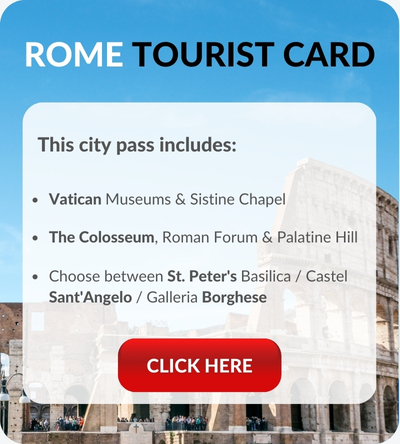
10 top things to do in Rome in 2024

Feb 29, 2024 • 13 min read
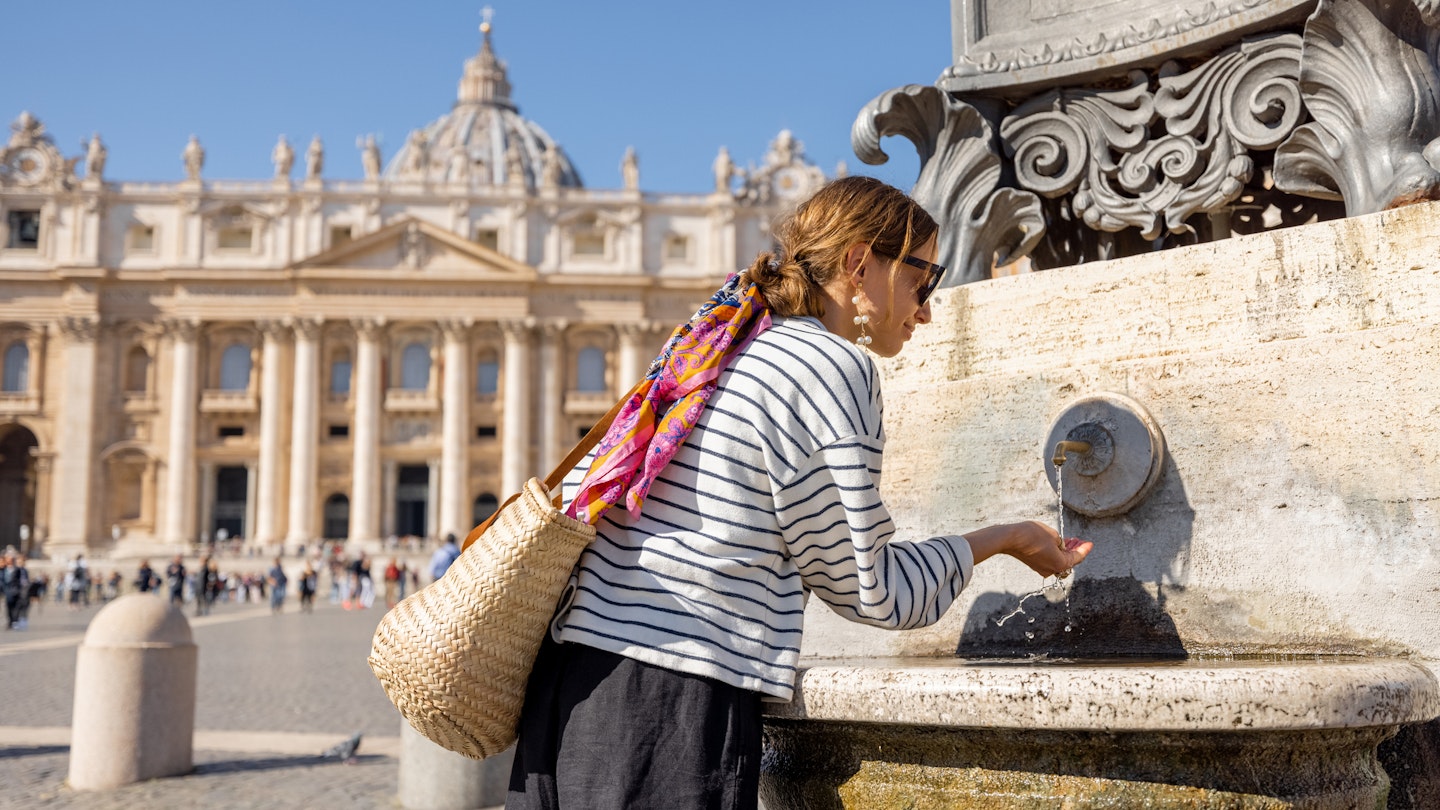
Here are the best things to see and do on visit to Rome © RossHelen / Getty Images
One thing every Roman and visitor can agree on is that there is no shortage of things to do in Italy's charismatic capital.
The biggest challenge on a trip to Rome will be discerning your must-see sights, while also accepting it's impossible to fit everything into one vacation. There may be historical monuments, museums and ancient sites around every corner but there's more to this city than standing in the long lines often required to view them up close.
The Eternal City is massive, endlessly entertaining and some of your best times will involve wandering down random streets and watching the world go by with an espresso in hand. Get planning now with our ten favorite experiences in Rome.
1. Lose yourself in Ancient Rome (but not all in one day)
Any Italian will tell you how downright anarchic Rome is and immediately after, every one of them will say, “but Rome is Rome.” There is simply no place like it in the world, and the only thing to do is abandon yourself to all of its chaotic charms. Even though you are extremely likely to meet hordes of people at any moment, how could you possibly skip the very sites that make the city extraordinary?
It would be bananas to visit Rome and not stand in front of the Colosseum , even though you’ll be one in a sea of gladiators-in-training. You must stand underneath the dome of the Pantheon even though you’ll wait in a considerable line ( one you’ll now pay for , fyi). And though you’ll be surrounded by cameras, souvenir sellers and tour groups, it would be almost unthinkable not to witness the singular beauty of the Trevi Fountain .
So don’t. Take it all in and let the experience find you. Touch the walls of ancient buildings and think about how they’ve been standing for millennia, or fix your eyes on the impossibly intricate carvings of marble and statues. Wander around the major sights, stumble across the minor ones and remember that you only have to move one or two streets over to find yourself in a calm corner of the capital.
Planning tip: When you make your plans in Rome, space out the heavy hitters and give yourself time to soak everything in at a pace that suits you. If you’re only in Rome for three days, think about dedicating a half day to the Colosseum, Palatine Hill and Forum , and then leave yourself the rest of the afternoon or evening to stroll through other parts of town that are a little less trafficked. Plus, that leaves you plenty of time to…
2. Learn the subtle art of the aperitivo
Don’t call it happy hour, because the aperitivo is so much more than a discount drink after a day at the office. And trust me, there is a science to doing it right: the aperitivo is a pre-dinner drinks ritual meant to whet the appetite, not satiate or drown it in cheap booze. Though one can probably find evidence of such imbibing throughout human history, the modern aperitivo dates back only a couple of centuries to the popularization of vermouth and other herbal drinks in the late 1700s.
Since then, Italians have been unwinding with friends and beverages before settling in for dinner and doing so in ever more creative ways. These days, the aperitivo is increasingly varied and always accompanied by snacks, which have also become more elaborately prepared for pairing. Just don’t fill up on any of it – after all, it is but a prelude of what is to come at dinner.
Local tip: Rome is one of the best cities in Italy to sample a wide range of aperitivi , as every bar does things slightly differently and there are far worse ways to spend one’s time than sampling them all. If you’re in the market for luxury, try snagging a spot on the coveted rooftop of Terrazzo Borromini overlooking Piazza Navona . If your tastes run trendier, check out the mixology at Freni i Frizioni in Trastevere . For a classic Roman moment, head over to Ai Tre Scalini in Monti, where the vine-covered streets provide a beautiful backdrop for the most poetic of aperitivi .

3. Spend a day in the Vatican City
Whether you go as a tourist or a pilgrim, the impact of seeing the Vatican for the first time is hard to overstate. From the outside, this half-kilometer-square city-state is dwarfed by the imposing dome of St Peter’s Basilica and framed by the long embrace of Bernini’s square: this alone is enough to make it worth the trip, but once you step inside the Vatican buildings you cannot help but be taken aback.
Start at the Vatican Museums , a complex of 26 structures that spans 7km (4.3 miles) of halls and galleries. While you could spend an eternity craning your neck to see it all, a few hours is enough to get a sense of the unparalleled catalog that the Museums contain. Finish by heading through the claustrophobic staircase (you’ve been warned, but it’s worth it) to the Sistine Chapel , still breathtaking no matter how many people are there sharing the view.
After you’ve hopefully stopped for lunch and a refresh, the Dome awaits. St Peter’s Basilica is a marvel of engineering, architecture, and sheer will: after all, it took more than a century to bring into being and it passed through the hands of many of Italy's most iconic figures along the way. Everything about the Basilica is imposing, so don’t be surprised if the sheer scale of it is overwhelming on the first visit. That’s just another reason to come back.
Planning tip: A dress code is still enforced pretty strenuously. To be safe, wear pants or skirts that cover your knees and tops that cover your shoulders. When in doubt, bring a light scarf with you (it's always worth having a scarf in Rome !).

4. Work your way through Rome’s museums
Although the Vatican Museums are amongst the largest in the world, they are far from the only ones to visit in Rome. What’s more, many of the city’s most interesting museums are slightly off-piste for most visitors, so you may find yourself enjoying an unexpectedly peaceful afternoon in even the busiest periods of the year. In a city overflowing with history and culture, there’s a museum for everyone.
If you can’t get enough of Ancient Rome, the Capitoline Museums on the Campidoglio offer that and more, with works dating from the 3rd century BCE to the 17th century. For an even deeper dive into historical artifacts, the National Roman Museum houses a priceless collection in four separate buildings around the city, each a work of art in its own right.
Classical art lovers are spoilt for choice as well: from the Galleria Borghese to Palazzo Colonna , there are majestic collections around just about every corner. But there’s always space for more, and modern art has a well-established place in Rome. The National Gallery and MAXXI have incredible collections from contemporary artists, all of which are worth seeing.
Local tip: If you like to hunt around, go on the lookout for Rome’s eight “ small museums ”, each of which is located around the city and some in the strangest places. Oh and bonus, they’re all free to enter !
5. Head underground to discover hidden history
Hiding in (almost) plain sight next to the Colosseum, the Domus Aurea is one of the most enigmatic and least explored remnants of Ancient Rome. The sprawling complex was built sometime after the fire of 64CE that destroyed much of the city, under the order of Emperor Nero.
Over time it was buried and remained undiscovered until the Renaissance when intrepid artists like Ghirlandaio and Raphael did their version of urban spelunking to witness the painted “underground grottoes”. You don’t have to be nearly as athletic to get there today: the Domus Aurea underground tour offers an incredible chance to tour some of the ancient palace. It maintains a cool and constant underground temperature, making it the perfect place to escape the Roman sun.
Local tip: The Domus Aurea is also home to a cat sanctuary – if you’re a cat lover, try to spot the friendly felines hanging out among the complex.

6. Take in the views from the city's hills
It’s easy to forget the sheer scope of the city when you’re shuffling through jampacked cobblestone alleys, and it makes all the difference to remind yourself of it now and then. Greater Rome covers nearly 500 sq miles, though the vast majority of its most well-known sites are located within a much smaller area of about five sq miles. Luckily, there are a few key points around the city center where you can get a sense of where you are and admire the beauty of this ever-expanding metropolis.
Climb up the Janiculum Hill for one of the most impressive panoramas you’re likely to see and if you time it right, you may be there for the cannon shot that fires every day at noon (don’t worry, they’re blanks). If you’re wandering during the golden hour (right before sunset), make your way to the Giardini degli Aranci on the Aventine Hill for a perfectly framed picture that no camera could ever capture. Enjoy the walk back down through the frequently overlooked Rose Garden , which offers its own unique perspective on the neighboring Palatine Hill.
Detour: If you’ve got the time and a bus map, head to Parco Mellini in Monte Mario outside of the city center for a dramatic view that stretches far beyond the Aurelian walls.
7. Shop sustainably in Rome's secondhand stores
Though you’ll find every designer in the world has a shop somewhere in the city, Rome has a fabulous thrift shop and market culture where you can find clothing, antiques and just about anything else you could imagine. The Mercatino dell’Usato chain has stores all over the city, and many are an adventure in themselves for people who love scouting out finds. If you’re near the Aventino, check out tiny Affare Fatto , a thrift store that often has eclectic furnishings left behind by diplomats leaving for their next mission.
But the open-air markets are an entity unto themselves, and if you are soothed by the chaos of commerce, this could be the itinerary for you. The market at Via Sannio near San Giovanni has a bustling vibe and is open almost all week with antiques, jewelry, clothing and small independent producers alongside vintage sellers. Time it right to find the ecosolidale market open on Via del Porto Fluviale in Ostiense and you may just get the couture purchase of a lifetime.
If you’re in town on Sunday you cannot miss the mind-boggling Porta Portese market, which takes over the district just south of Trastevere with kilometers of curios. Don’t be surprised if you find a famous designer rummaging along next to you. If you need to keep up on secondhand Rome, black-belt-level thrift shopper Desirée at the Pewter Thimble has you covered.

8. Experience the best of Rome’s many parks
Rome has a lot of parks. In fact, Rome has the most hectares of greenery in Europe and each of its parks serves an important historical, cultural and natural purpose for citizens and travelers alike. Though it may not be the first thing that you think of when you start filling out your wishlist of things to do in the city, you don’t want to miss the chance to wander through some of the most beautiful urban oases in the world.
The most famous park in Rome is undoubtedly Villa Borghese , and with good reason. Covering 80 hectares (197 acres) of the Pinciano district in the city center, the park has boating, tons of trails, theaters, and of course the Galleria Borghese Museum. But other green spaces abound in the city, and each one provides a refuge from the heat of the summer or the occasional winter gray. Check out the intimate Villa Celimontana near the Colosseum or the Parco del Colle Oppio for a different view of the iconic stadium (that also includes a skate park).
Detour: For those looking for less manicured nature, sign up for a bike tour of the Parco della Caffarella , one of the most untouched areas in the city. And while you’re there, take a walk back in time along the Appia Antica , a site so inspiring that it will put to rest any rumors of Rome’s impending demise.
9. Taste local produce at Rome's incredible markets
It wouldn’t be a Roman holiday without copious amounts of food, the quality of which will leave you pining for its equal once you’ve returned home. And while you could spend a lot of time (and money) sampling restaurants around the city, make better use of both by getting to know the food markets all over Rome.
If you’re coming and going from Termini station, you’ll be spoilt for choice at the Mercato Centrale , which brings together chefs and producers from all over Italy under one postwar roof. Steps away, the Nuovo Mercato Esquilino is a feast for cooks looking for more niche fruits, vegetables, and proteins; you’ll find halal butchers selling alongside pig farmers from the Roman countryside, and fresh fish from the Adriatic.
If you start to get peckish as you head towards the Tiber, make a detour to the Mercato Testaccio for local cheeses, cured meats, veggies, and wines that would make any picnic rival a fine dining experience. Should you be further north near the Vatican, the Mercato Trionfale is the largest in Rome and guaranteed to have something for everyone. For weekend warriors braving the crowds at the Circo Massimo , the nearby Campagna Amica market is a fantastic place to test out your Italian, since you won’t go wrong with whatever you wind up buying.
Local tip: Aperitivo starts at lunchtime on Saturdays and Sundays, meaning you should too.
10. Eat out at Rome's best restaurants
For every majestic monument or glittering tribute reaching up to the heavens, everyone knows that the real reason we come to Rome is to eat. But Roman food, once religiously tethered to the traditional “quinto quarto” philosophy of using every part of an animal, has undergone something of a renaissance in recent years.
Young chefs are reinterpreting the classics, resulting in the explosive flavors of Santo Palato in San Giovanni and the home-style goodness of Romanè in Prati. Vegetarians and vegans are also well served in the capital: from the picturesque Mater Terrae in Piazza Navona and the stealthily innovative Rifugio Romano near Termini Station to the irrepressibly lovable Romeow Cat Bistrot in Ostiense, there is no shortage of meatless options in the Eternal City.
Of course, if you’re in search of the classics, they’re right there too. Reserve early and often at Armando al Pantheon , and hope that someone cancels at Felice a Testaccio so that you can get your cacio e pepe (pasta dish with cheese and pepper) done just the way you dreamt of it. Nothing will ever taste quite like the bread from Antico Forno Roscioli , and no one will ever be able to convince you that the slabs of pizza from Gabriele Bonci’s Pizzarium aren’t crumbs sent to lead you straight to heaven.
Local tip: Ever wondered why Italians gasp when you order a cappuccino after a meal? They normally drink coffee after eating as a tool for digestion, as the acidity and caffeine help to speed up the process. By now they’re pretty used to non-Italians asking for milky beverages after a meal but if you want to do like the Romans, skip the dairy (or try a macchiato).
This article was first published Sep 11, 2015 and updated Feb 29, 2024.
Explore related stories
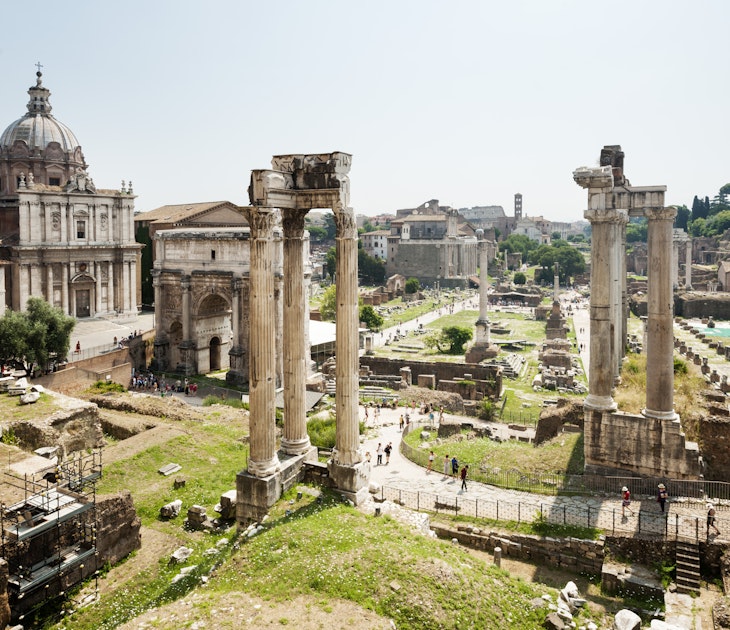
Apr 19, 2024 • 4 min read
A new walkway will make it easier to navigate Rome's ancient sites. But what does it mean for the locals?

Feb 27, 2024 • 6 min read

Feb 19, 2024 • 7 min read

Jan 11, 2024 • 8 min read

Jan 3, 2024 • 4 min read

Oct 17, 2023 • 10 min read

Jan 2, 2023 • 12 min read
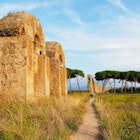
Feb 28, 2022 • 5 min read

Sep 18, 2020 • 6 min read

Aug 9, 2020 • 4 min read
Essential Ancient Sites to Visit in Rome
:max_bytes(150000):strip_icc():format(webp)/martha_bio-56a3c8865f9b58b7d0d3b5fe.jpg)
The glories of ancient Rome are easily accessible to the visitor. Some sites can be visited for free while others are part of Rome Passes and Cards . Most ancient sites are in Rome's historic center so you can visit several places in one day. Even if you don't have time to take an in-depth look, just walking by some of these places is incredible and gives you an overview of ancient Rome's history.
The Colosseum of Rome
TripSavvy / Taylor McIntyre
Ancient Rome's huge amphitheater, holding up to 55,000 people, was built by Emperor Vespasian in 80 A.D. and was the scene of many deadly gladiatorial and wild animal fights. Today you may see men dressed in gladiatorial costume as you walk between the Colosseum and the nearby Arch of Constantine, built in 315 A.D. On Sundays, the Via dei Fori Imperiali leading to the Colosseum is closed to traffic so it's a great place for a stroll (if you don't mind the souvenir vendors).
Ticket lines can be long but there are several ways to buy Colosseum tickets faster including buying a Colosseum and Roman Forum pass online from Select Italy or booking a tour .
The Pantheon
TripSavvy / Stella Levantesi
Rome's Pantheon, the temple of all the gods, was built between 118-125 A.D. by Emperor Hadrian. In the 7th century it was made into a church by early Christians and now is lined with tombs. Go inside to see the spectacular dome. Admission is free. The Pantheon is the best-preserved building of ancient Rome and today is surrounded by a pleasant and lively piazza, a nice place to sit in the evening and enjoy a drink. A good nearby restaurant is Armando's, on a street coming off the piazza.
Roman Forum
The ancient Roman Forum is a huge complex of ruined temples, basilicas, and arches. It was the ceremonial, legal, social, and business center of ancient Rome (The food stalls and brothels were removed in the second century B.C.). To get a good view, walk up the Capitoline Hill behind the museums. Give yourself at least 1-2 hours to wander around, then continue up to the Palatine Hill, also included in the ticket.
The Palatine Hill
TripSavvy / Christopher Larson
The emperors and aristocrats of ancient Rome lived on the Palatine Hill starting in the first century B.C. The Domus Flavia and Domus Augustana, built in the first century A.D., where the official residence of the emperors for over 300 years. Admission also includes the Palatine Museum, the Roman Forum, and Colosseum.
The Capitoline Hill Museums
Above the Roman Forum, the Capitoline Hill was Rome's symbolic center and held the Temple of Jupiter. Today there are two museums, the oldest public museums in the world, the Palazzo Nuovo, with Greek and Roman sculptures, and the Palazzo dei Conservatori, with art galleries, sculptures, and frescoes. One ticket gives you admission to both. Just like in ancient Rome, the hill still has the best view of Rome's center.
Piazza Navona
Originally built as a stadium in the first century for athletic contests and chariot races, Piazza Navona is now lined with luxurious cafes and is the home to three lavish Baroque fountains. The much-touted ice-cream dessert, tartufo , is said to have originated here and you can still try it in the cafes as a splurge.
Baths of Diocletian
The Baths of Diocletian, once covering 32 acres, were the largest public baths or thermae in ancient Rome. Although much of the original structure has been destroyed, remains of the baths are now part of the National Roman Museum. Several painted tombs have been moved and reconstructed inside the baths. They can be seen when you visit the baths, open every day except Monday. The baths can be visited with the Four museums ticket and Rome archeology card.
Baths of Caracalla
At the foot of the Aventine hill are the monumental ruins of the Baths of Caracalla, used from the 2nd to 6th century A.D. Taking a bath was a social event for the people of ancient Rome and the huge complex could hold up to 1600 bathers! Besides baths, they held an array of facilities such as a gym, art galleries, gardens, and shops selling food and drinks.
Trajan's Market
Thought to be the world's oldest shopping mall, the arcades in Trajan's Market are now believed by many to be administrative offices for Emperor Trajan. The shops and apartments were built in a multi-level structure and you can visit several of the levels. Highlights include delicate marble floors and the remains of a library. The Museum of the Imperial Forums houses a wealth of artifacts from all of ancient Rome's forums.
Roman Houses Under Saints John and Paul Church
Under the Church of Saints John and Paul are excavations of Roman buildings, including what's believed to be the house of the two saints and an early Christian worship site. The Roman buildings were discovered during excavations to find the tombs of John and Paul and are now open to the public along with a small museum.
Via Appia Antica and Catacombs
The Via Appia was once the major road to ancient Rome with construction starting in 312 B.C. The Appian Way is now a 10-mile long archaeological park, lined with ruins of tombs and monuments. A good way to visit is by bike, although you may also enjoy walking it. Some of the catacombs, burial places of the early Christians, are open for public tours - check for the time of the English tour when you arrive.
The Roman Guy offers a good guided Appian Way Catacomb tour that includes a tour under San Clemente Church and transportation.
Ostia Antica
Although not actually in Rome, the ruins of the ancient Roman port of Ostia Antica, easily accessible from Rome on public transportation, are well worth a visit. It's a huge complex and you can easily spend several hours wandering around the old streets, shops, and houses. You should plan at least a half day for this trip.
The 25 Top Attractions in Rome, Italy
Top 6 Tourist Attractions in Italy
10 Unique Guided Tours in Rome
What to Know About Visiting the Roman Colosseum
3 Days in Rome: What to See and Do
The 14 Best Day Trips from Rome
Roman Amphitheaters in Italy
Buying Tickets for the Colosseum in Rome
A Visit to the Forum in Rome
12 Free Things to Do in Rome
Where to Go in Rome to Take the Best Photos
What to See in the Roman Forum
Rome's Palatine Hill: The Complete Guide
10 Neighborhoods You Need to Know in Rome
The Top 23 Things to Do in Italy
Sightseeing in Rome With Kids

Log in with user name:
Log in with social media:
Get FREE email communications from Fodor's Travel, covering must-see travel destinations, expert trip planning advice, and travel inspiration to fuel your passion.
- Things To Do
- Restaurants
- Neighborhoods
- Travel Tips

The 10 Best Ancient Sites in Rome

From the Colosseum to the Pantheon, there are some parts of Roman history you need to see for yourself.
The ancient Roman Emperor Augustus famously declared, “I found Rome a city of bricks and left it a city of marble.” And though many of the Eternal City’s most incredible ancient sites have been left in ruins, gazing upon them lets you imagine what Rome might have been like when men roamed the streets in togas and gladiators battled to the death. Between the Colosseum, the Roman Forum, and the many bathhouses, markets, and theaters, you could spend a lifetime visiting all of Rome’s ancient sites and archeological ruins. The city is so saturated with them that any time construction workers start digging, they’re bound to discover more relics that have to be preserved. If you’ve got a limited amount of time to explore, these 10 ancient sites are a good place to start.
Top Picks for You

Roman Forum
One of the Eternal City’s most emblematic sites, the Roman Forum stretches out between the Capitoline and Palatine Hills. This vast area filled with crumbling columns, the ruins of temples, palaces, and shops was once the hub of the ancient world and the center of political, commercial, and religious life in the city. The various ruins span almost 900 years, from around 500 BC to AD 400. There are no signs marking what they were once used for, so it’s worth going on a guided tour if you want to distinguish the complex of the Vestal Virgins from the Temple of Saturn.
Perhaps the monument most symbolic of ancient Rome, the Colosseum is one of the city’s most fascinating—and popular—tourist attractions. The Emperor Vespasian commissioned it around AD 70–72 and his son Titus officially opened it in AD 80 with 100 days of games, including wild animal fights and gladiatorial combat. It was the largest amphitheater in the Roman world, with seating for 50,000 people, until it was abandoned and later used as a quarry for projects like the Basilica di San Pietro and San Giovanni in Laterano. It underwent a restoration in 2016 courtesy of Tod’s CEO Diego della Valle.
Recommended Fodor’s Video
Circus maximus.
It might be hard to imagine now, but the grassy area between the Palatine and Aventine Hills was once the site of the largest hippodrome in the Roman Empire . The huge oval course was rebuilt under Julius Caesar and later enlarged by subsequent emperors. During its heyday, it hosted epic chariot races and competitions that sometimes lasted as long as 15 days.
Built as a pagan temple to the gods, the Pantheon is Rome’s best-preserved ancient site, perhaps because it was later consecrated as a church. It was originally constructed by Augustus’s son-in-law Agrippa in 27 BC and was later rebuilt by the emperor Hadrian around AD 120. Step inside and you’ll be amazed at its perfect proportions and the sunlight streaming in from the 30-foot-wide oculus. It’s truly a wonder of ancient engineering.
Foro di Traiano
Located on the road that leads from Piazza Venezia to the Colosseum, Trajan’s Forum was the last of Imperial Rome’s forums—and the grandest. Comprising a basilica, two libraries, and a colonnade surrounding a piazza, it’s connected to a market that once bustled with commercial activity in the shops, taverns, and administrative offices tasked with feeding the citizens. It’s now home to the Museo dei Fori Imperiali, which displays archeological relics and has a video presentation showing what the forum was like in its heyday.
Baths of Caracalla
Though visitors to Rome often skip over the Terme di Caracalla , film buffs will recognize the site from the nightclub scene in La Dolce Vita and from the scene with the disappearing giraffe in La Grande Bellezza . Cinematic significance aside, the site is a testament to ancient Rome’s bathing culture. It was essentially a massive spa, with saunas, baths, an Olympic-size pool, and two gymnasiums for boxing, weightlifting, and wrestling. Little of its splendor remains today, but it was once richly decorated with marble, frescoes, mosaics, and sculptures.
Bocca della Verità
Legend has it the mouth in this ancient stone face will bite off the hand of a liar, and tourists line up to stick their hand inside the mouth and put it to the test. (Gregory Peck’s character tricks Audrey Hepburn’s Princess Ann into thinking he lost a hand inside it in a scene from Roman Holiday .) You’ll find the enigmatic face in the portico of the Church of Santa Maria in Cosmedin , near the Circus Maximus.
Teatro Marcello
It may look a bit like a smaller version of the Colosseum, but the Teatro Marcello was once ancient Rome’s largest and most important theater. Julius Caesar ordered the land for the theater to be cleared, but he was murdered before it was built. It was inaugurated in AD 12 by Augustus and hosted performances of drama and song. It’s kept that purpose even today, at least during the summer when it hosts concerts.
Appia Antica
Head to the southeastern edge of the city to the Appia Antica Park and you can walk on the same stones that ancient Roman soldiers and citizens once trod. This ancient thoroughfare once stretched all the way to Brindisi, some 300 miles away on the Adriatic Coast. Today it’s a perfect spot for bike rides and picnics in the grass under the shadow of Rome’s emblematic umbrella pines.
Ara Pacis Augustae
Now housed in a modern glass-and-travertine building designed by American architect Richard Meier, the Ara Pacis Augustae has some of the most incredible reliefs you’ll see on any ancient monument. It was commissioned to celebrate the Emperor Augustus’s victories in battle and the Pax Romana, a peaceful period that followed. You’ll have to imagine how richly painted the scenes once were, but you can still admire the carvings depicting ancient Rome’s creation myths on the sides of the altar.

Sign Up Today
Start your 14 day free trial today

The History Hit Miscellany of Facts, Figures and Fascinating Finds
10 Key Historic Sites to See in Rome
Explore the centre of the ancient world with our guide to the 10 key historic sites in rome, featuring the colosseum to the musei capitolini and beyond..

Peta Stamper
06 mar 2024.
From wonders such as the immense Colosseum to the legendary Palatine Hill, the impressive Pyramid of Cestius and the long history of San Clemente, Rome is brimming with amazing historic places. Other top archaeological sites to see tend to include the famous Ostia Antica and the beating heart of the city: the Roman Forum.
With a legacy that spans over 2,000 years of history, the eternal city has scintillating archaeological attractions around every corner. Whether you’re on a whistle-stop tour of the city or just don’t want to miss the essentials, we’ve put together a guide to the 10 Key Historical Sites in Rome.
History Hit Holidays
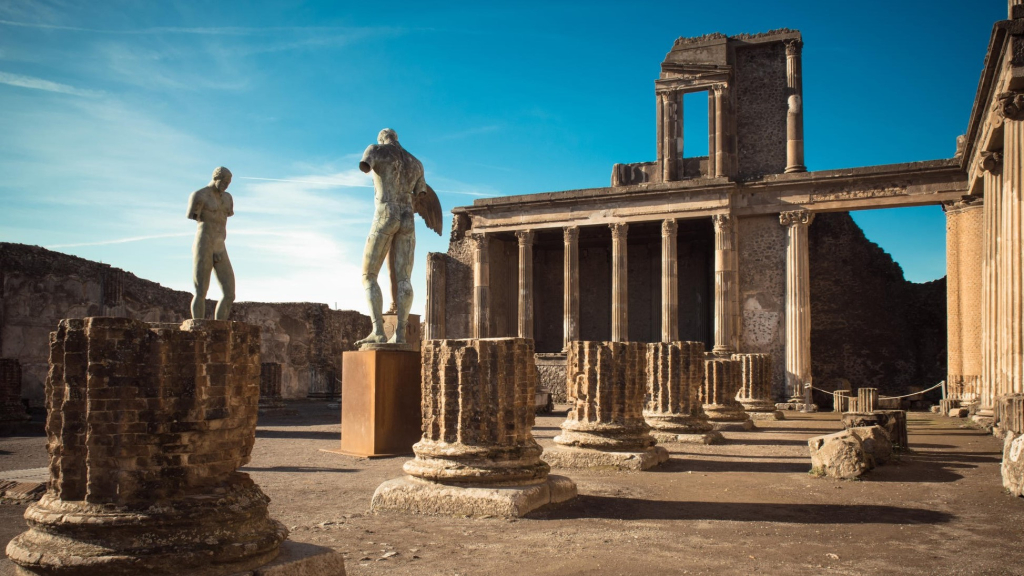
Uncover Pompeii with Sophie Hay and Tristan Hughes
What historical sites should i visit in rome the top 10.
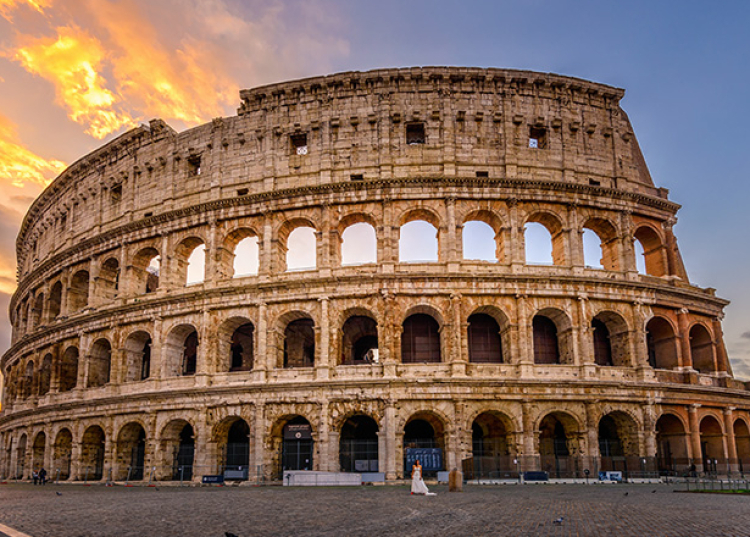
1. The Colosseum
The Colosseum is a site like no other. Beyond a shadow of a doubt, nothing represents the sheer power and magnificence of the Roman Empire like this stunning piece of ancient architecture.
The Colosseum, or ‘Colosseo’ in Italian, was once the largest amphitheatre in the Roman Empire. It was built in the 1st century AD by the Emperor Vespasian as a place for the people of Rome to enjoy. Originally named the Flavian Amphitheatre after Vespasian’s family name, the man who brought the Roman Empire back from the brink would not live to see its completion.
The Colosseum remained the amphitheatre of Rome until the end of the Roman Empire. This was the place where gladiators, lions and those accused of crimes were put to the test, often fighting to the death.
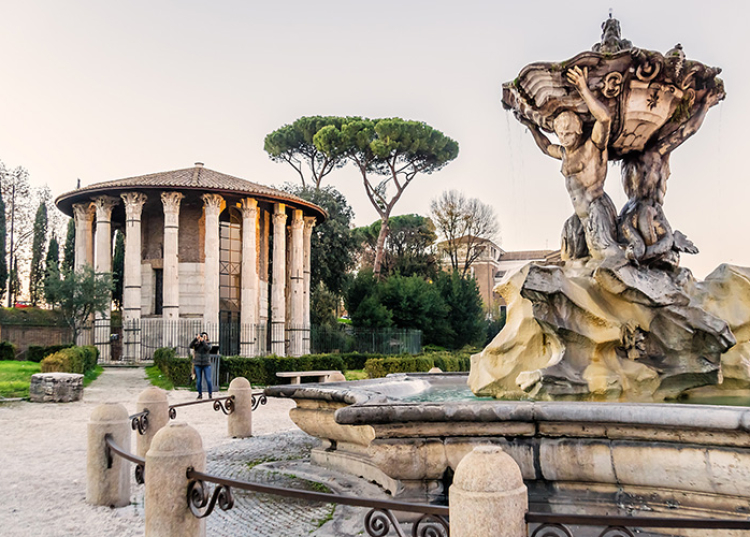
2. Temples of the Forum Boarium
The Temples of the Forum Boarium are two of the best preserved Roman temples to have survived from the Republican era, and together marked an important commercial and religious spot nestled by the Capitoline, Palatine and River Tiber. Comprised of two temples, the Temple of Hercules Victor and the Temple of Portunus, the Temples of the Forum Boarium date back to approximately the 2nd century BC.
Beginning in the late 1990s, the site saw new landscaping and conservation efforts towards both temples, resulting in the site we see today. Backed by tall trees and endless Roman blue skies, the temples are in fantastic condition, providing visitors with a sense of the bustling ancient cattle market dominated by these structures.
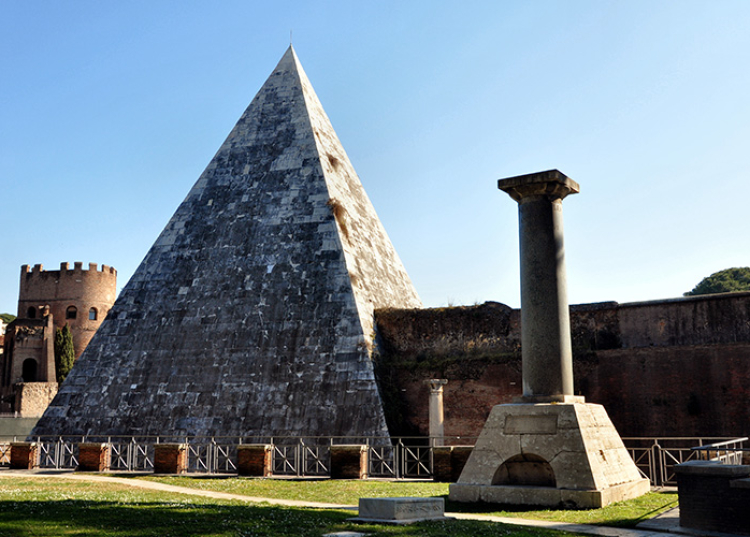
3. Pyramid of Cestius
The Pyramid of Cestius is the tomb of affluent magistrate Caius Cestius which was built in the 1st century BC in Rome, Italy. Constructed of white marble and brick, this ostentatious 35-metre high tomb was built in this style due to the popularity of all things Egyptian which swept through Rome after Egypt was incorporated into the Empire.
For those embarking on the Grand Tour during the 18th and 19th centuries, the Pyramid of Cestius was a must-see. Percy Shelley described it as “one keen pyramid with wedge sublime” in a 1821 elegy for the poet John Keats.
Ring-fenced by a guard railing, the Pyramid of Cestius continues to provide a dramatic, awe-inspiring feature to the ancient Roman landscape – a true feat when you consider the monuments it shares the city with.
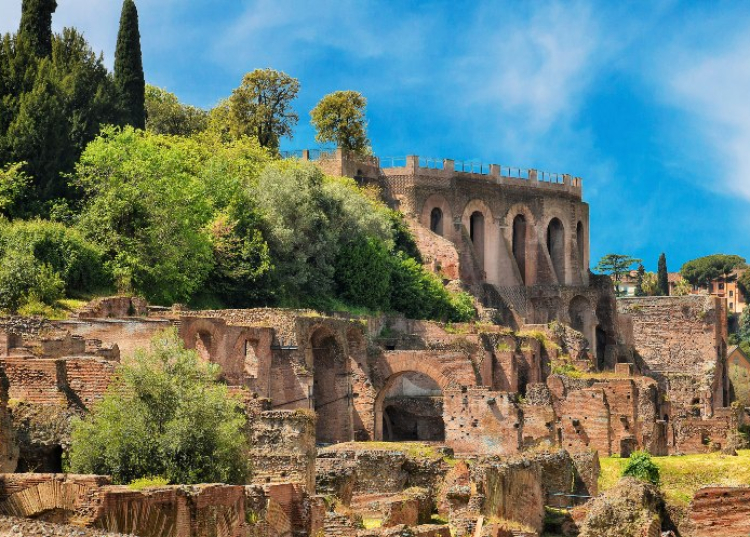
4. Palatine Hill
The Palatine Hill or Palatino is considered as the birthplace of Rome. One of Rome’s 7 hills, the Palatine Hill is closely linked with the city’s history and today houses some of its most ancient and important sites.
Legend has it that the twins Romulus and Remus were taken to Palatine Hill by the she-wolf who raised them , and here they founded a village which would become Rome .
In a dispute over who was the rightful leader of the new settlement, Romulus eventually killed his brother at the Palatine Hill, thus becoming the namesake of Rome. Indeed, the Palatine Hill is where the earliest huts of Rome were found, supposedly built under the remit of Romulus himself.
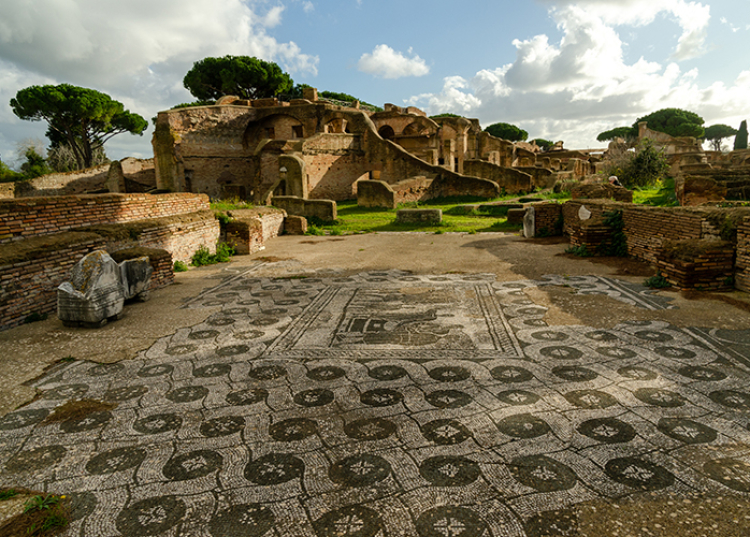
5. Ostia Antica
Ostia Antica is an extraordinary Roman site just outside the city centre that contains the ruins of the ancient port town that once served as the gateway to Rome. Tracing its roots back to at least the 4th century BC, Ostia Antica served as Rome’s principle port for hundreds of years: a witness and monument to the rise of the ancient superpower, its dominance and eventual decline.
Today, visitors can view a great many ruins from the ancient town including a well preserved Roman theatre, the Baths of Neptune, remains of the military camp, temples to ancient deities, the forum and even Ostia Synagogue, which is the oldest known synagogue site in Europe.
Yet Ostia Antica is so much more than these notable elements: it contains a huge range of well-preserved typical Roman dwellings, shops, flats and warehouses – even a Roman public toilet. These remains combine to provide visitors with a vivid picture of an ancient Roman town and allows you to get a real feel for day-to-day life in ancient Rome.
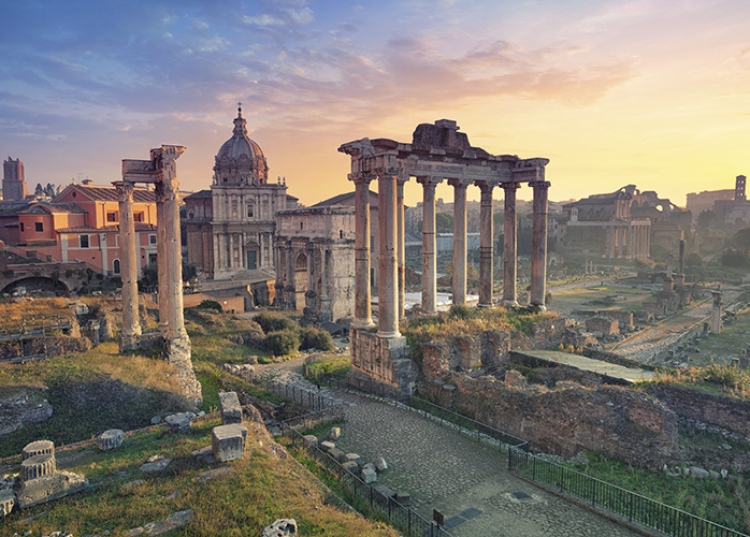
6. Roman Forum
The Roman Forum, or Forum Romanum, was the very centre of ancient Rome. Throughout the lifespan of Roman civilisation the Forum served as the focus of political, civic, and religious life.
For over a millennia the Forum’s changing nature reflected the constant shifting in the fortunes of the religious, military, and political natures of the Roman world . The Roman Forum witnessed elections , public speeches, criminal trials, social gatherings, and religious ceremonies among many others.
Today, though much of the grandeur of the Roman Forum has been lost to the ages, it is still a spectacular display of ancient Roman life.
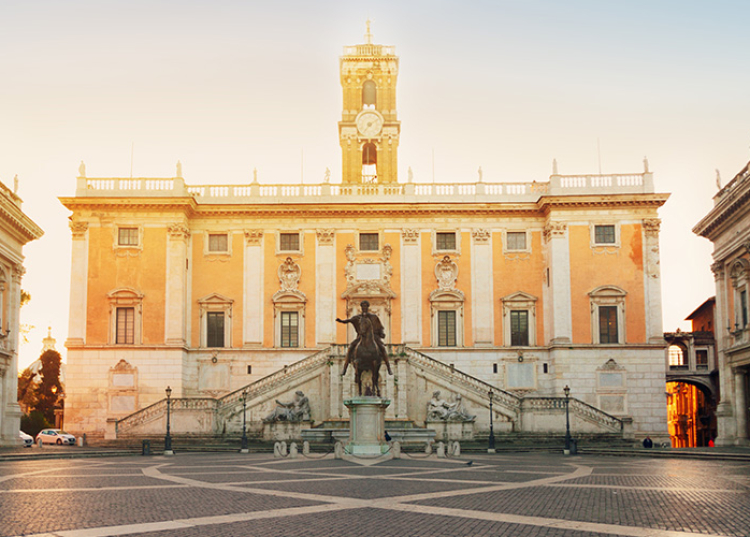
7. Capitoline Museums
Musei Capitolini – the Capitoline Museums – stand on the ancient Capitoline Hill in the centre of ancient and modern Rome , and host a huge wealth of artefacts from the ancient, medieval and renaissance periods.
Comprised of 3 main buildings, namely Palazzo Nuovo , Palazzo dei Conservatori and Palazzo Senatorio, the Musei Capitolini are located near the Roman Forum and a short walk from the Colosseum.
Current exhibitions include ‘The legacy of Caesar and the conquest of time’, exploring the marble timekeeping and history of Rome from its origins to the imperial age, and ‘The Torlonia Marbles’ which displays the world’s most prestigious private collection of ancient sculptures.
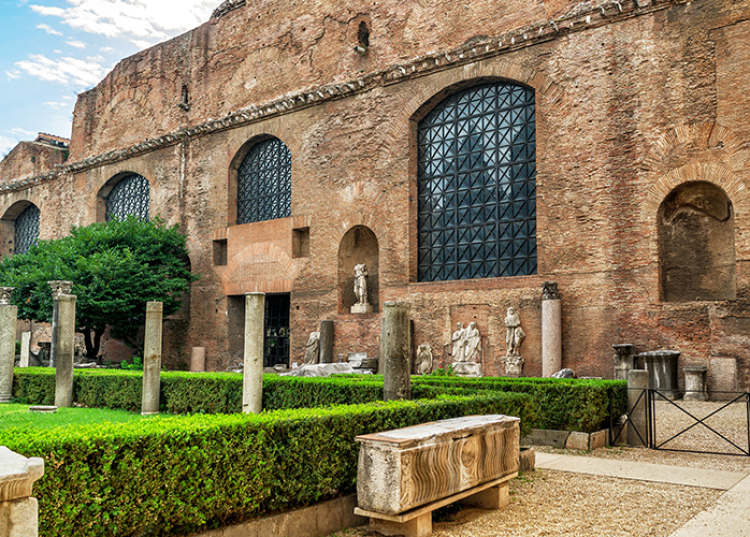
8. Baths of Diocletian
Once the largest ancient baths complex in the world, the Baths of Diocletian – or Terme di Diocleziano – was built between 298 AD and 306 AD in honour of the Roman Emperor Diocletian. Today, they are open to the public as part of the National Roman Museum in Rome, Italy.
One of the key tourist attractions for those wishing to view the baths is the Museo Nazionale Romano – Terme di Diocleziano – which is part of the Rome National Museum (shown on map, above). The museum, which opened in 1889, was built within the Baths of Diocletian and contains several collections from the ancient world. Although the museum contains many interesting exhibits, it gives little insight into the original baths themselves.
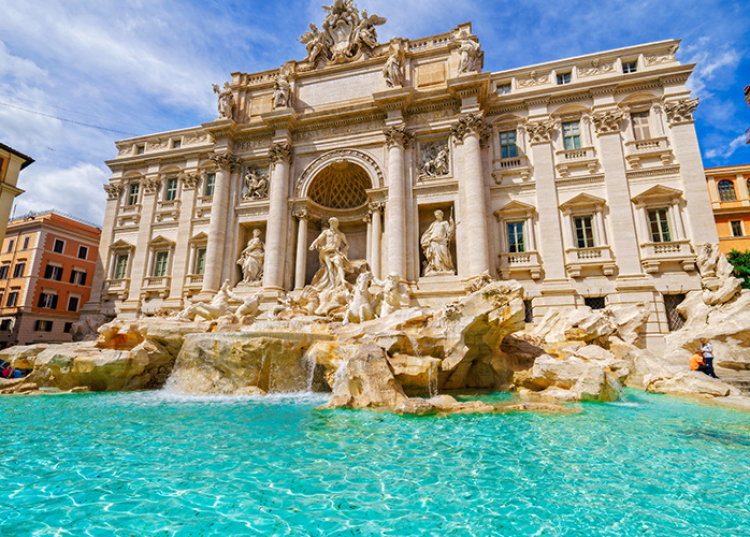
9. The Trevi Fountain
The Trevi Fountain is an iconic 18th century monument in Rome . A stunning depiction of ancient deities and resplendent with frescos of legends and myths, the Trevi Fountain attracts floods of tourists keen to throw their coins into its waters to assure their return to Rome – or so goes the myth.
Located in Rome’s Trevi district abutting the palazzo Poli, the Trevi Fountain was built on the site of an earlier fountain that was demolished in the 17th century. The Trevi Fountain marks the intersection of three major Roman roads – from which it gains the name ‘Trivium’ – and was the terminus of the Acqua Vergine. Revived from the Aqua Virgo of ancient Rome, this ancient aqueduct once served the Baths of Agrippa.
Any trip to Rome is not complete without visiting the 85 foot tall Trevi Fountain to throw a euro over your left shoulder into the fountain’s clear pool.
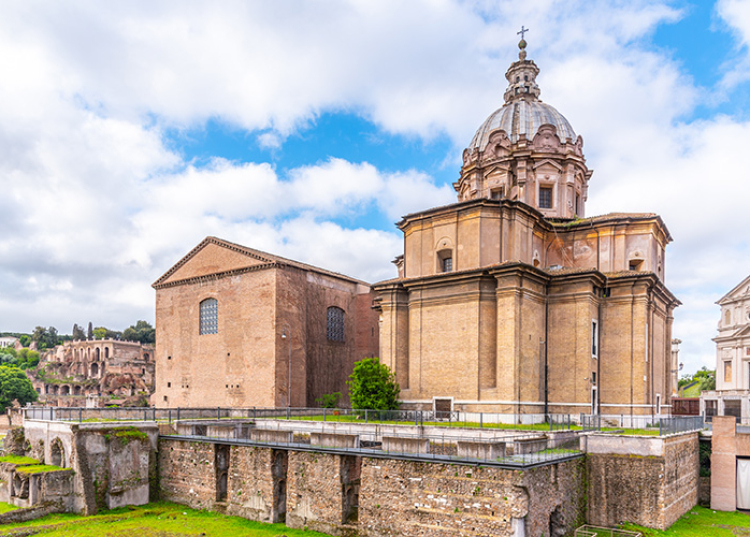
10. Curia Julia
The Curia Julia in the Roman Forum was the senate house in Ancient Rome, built under Julius Caesar and later restored by Diocletian after being damaged by fire. The Curia stood at the very heart of the ancient city, both physically and politically, and would have borne witness to some of Rome’s most famous events and figures.
Curia Julia is one of many curia – which roughly translates to ‘meeting house’ – which existed during the course of the Ancient Roman civilisation and was the administrative centre of the empire.
Unusually for an Ancient Roman building, the Curia Julia stands intact due to its conversion into the church of Saint Adriano in 623 AD by Pope Honorius I.

22 Best Places to Visit in Rome | 2024 (with Photos)

Mary Adelana - Travel Writer
Last Updated: March 25, 2024
Hey there! I'm Mary, sharing my top recommendations for exploring the beauty and charm of Rome through captivating photos and insightful travel tips. Let's embark on a journey of discovery and make unforgettable memories in the Eternal City!

Rome, the Eternal City, is a must-visit destination for any traveler. The Italian capital city is known for its rich history, art, and delicious cuisine.
While the Colosseum, the Roman Forum and the famous churches are essential attractions in Rome, there is so much more to explore.
In this guide, we take you on a journey to discover 22 of the best places to visit in Rome, from ancient ruins to squares filled with cafes and street performers.
Whether you are a first-time visitor or a seasoned traveler, there is always something new to discover during your Roman holiday.
Most Recommended Thing to Do
Top Choice Hotel
Our Top Choice Restaurant
Our Top Choice Bar for Nightlife
Freni e Frizioni
Best Time to Visit
Spring or fall; avoid summer and winter crowds.
Average Temperature
The average temperature in Rome, Italy is mild.
Transportation Options
Buses, trams, metro, taxis, bikes, scooters, walking, rideshare.
Average Cost ($, $$, $$$)
My Top Recommendation
Start your day with a leisurely stroll along the Tiber River, where the gentle breeze carries the whispers of centuries-old tales. Make sure to visit the Vatican City, where the majestic St. Peter's Basilica and Michelangelo's breathtaking frescoes in the Sistine Chapel will leave you in awe.
Indulge in delectable Italian cuisine at local trattorias, savoring every bite of homemade pasta and gelato. As dusk falls, climb the Spanish Steps to the Piazza Trinità dei Monti for a panoramic view of the city bathed in a golden glow.
What You'll Need to Bring
- Comfortable walking shoes
- Travel adapter
What Not to Miss
- Vatican City
- Trevi Fountain
- Roman Forum
What to Avoid
- Pickpocketing and petty theft
- Eating near major tourist attractions
- Using unlicensed taxis
Table of Contents

1. The Colosseum
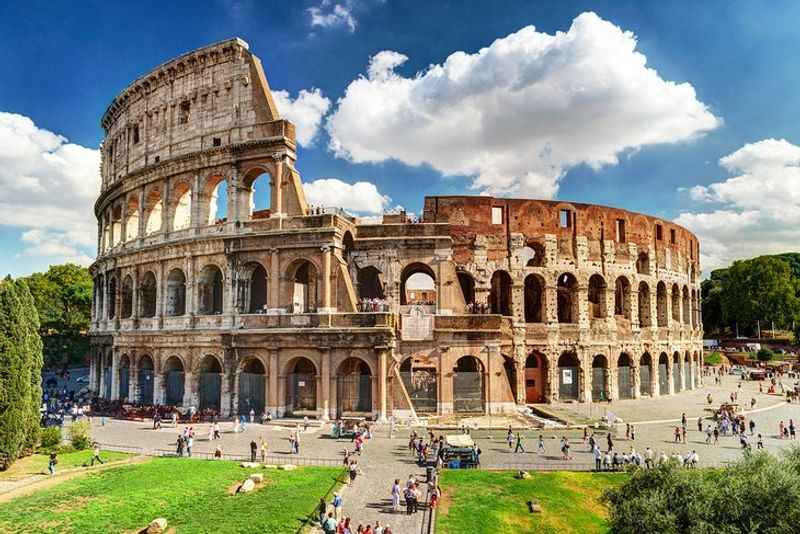
The Colosseum is an iconic symbol of the ancient Roman Empire. It was built over 2,000 years ago and could hold up to 50,000 spectators.
It was used for public spectacles, such as gladiator fights, animal hunts, and mock sea battles.
The Colosseum is a testament to the incredible engineering skills of the ancient Romans and their love for entertainment.
Visiting the Colosseum is a great way to experience a piece of ancient history firsthand.
2. The Pantheon
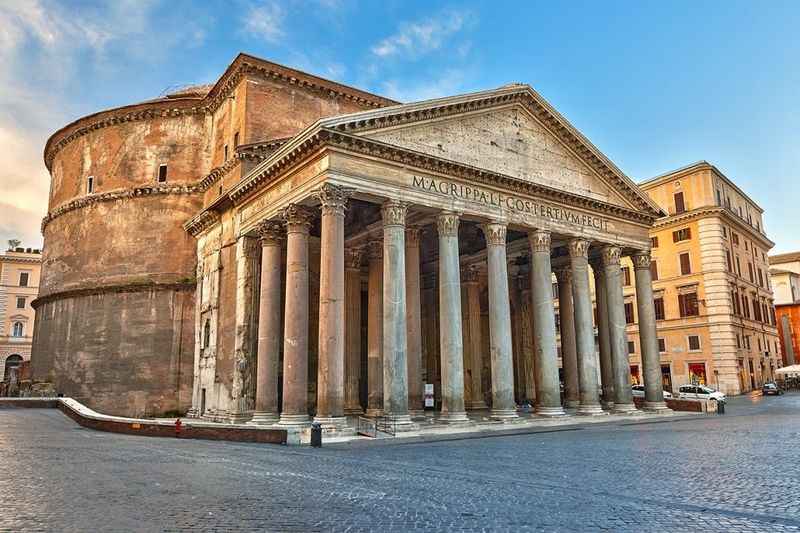
Emperor Hadrian commissioned the construction of the Pantheon in 118 AD. Originally built as a place of worship for the Roman gods, it is probably the best-preserved ancient building in Rome.
The temple has been used as a Christian church since the 7th century and is home to numerous tombs of famous Italian kings, as well as the painter Raphael.
The Pantheon embodies the greatness of the Roman Empire and is a testament to the ingenuity of the ancient Romans.
3. The Roman Forum
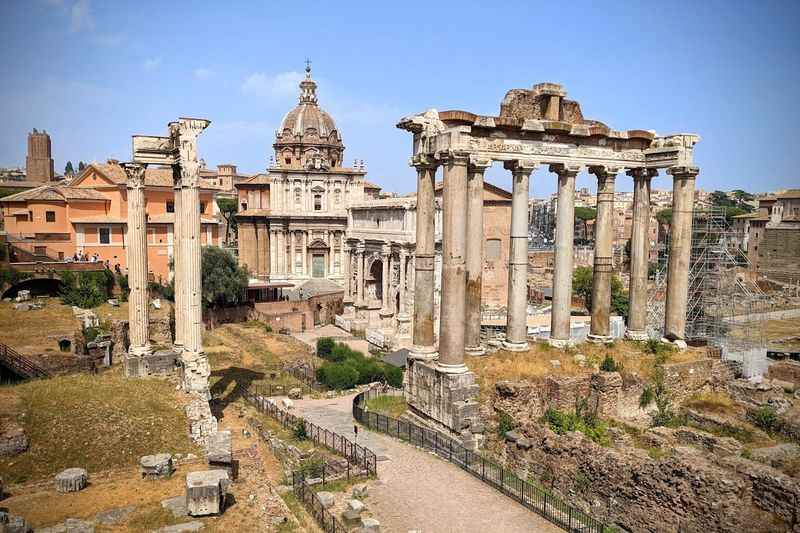
The Roman Forum is also one of the top sights in Rome. This sprawling plaza used to be the center of political and social life in ancient Rome.
Today, the Roman Forum is home to some of the most impressive ruins in the city.
The Roman Forum is home to numerous ancient ruins and historical landmarks, including the Temple of Caesar, the Arch of Titus, and the Temple of Vesta.
Visitors to the Roman Forum can explore the ancient ruins, marvel at the stunning architecture, and learn about the history of ancient Rome.
4. Vatican City
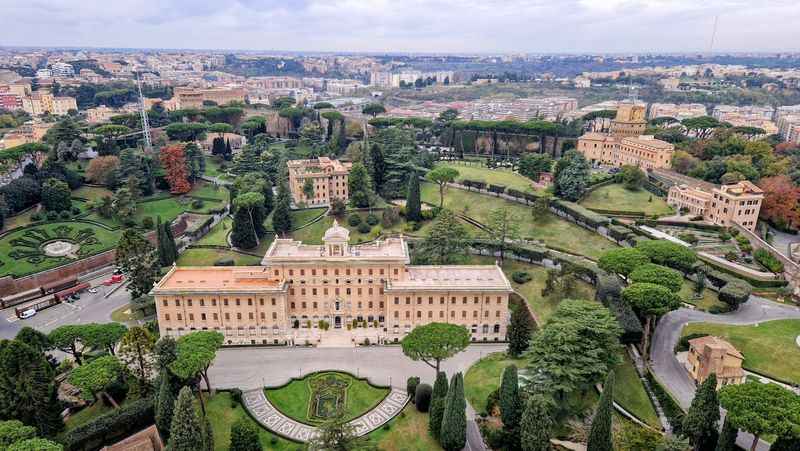
Vatican City is the smallest sovereign state in the world and is home to some of the most important cultural landmarks in the world.
The city-state is the headquarters of the Roman Catholic Church and home to St Peter's Square.
Visitors to Vatican City can explore the magnificent St. Peter's Basilica, the awe-inspiring Sistine Chapel, and the Vatican Museums, which are home to a vast collection of art and artifacts from throughout history, including works by artists such as Michelangelo, Raphael, and Botticelli.
5. The Sistine Chapel
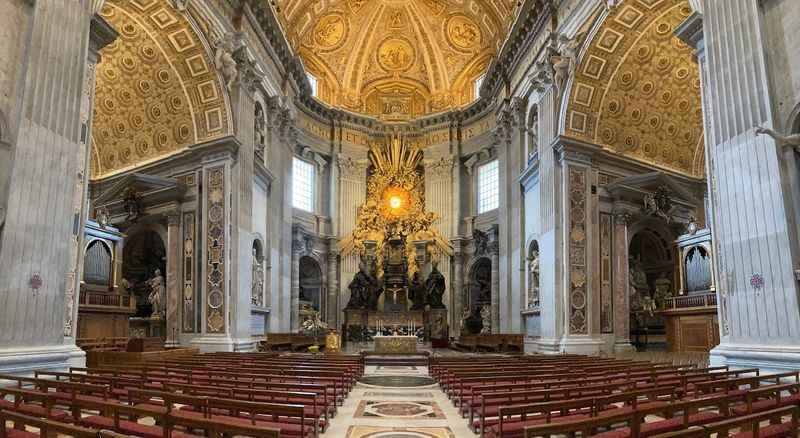
The Sistine Chapel is one of the most famous cultural landmarks in the world, located within the Vatican City in Rome.
It was built in the 15th century and is known for its stunning Renaissance art and architecture, including the famous ceiling painted by Michelangelo.
The Sistine Chapel is part of the Vatican Museums and offers visitors a unique opportunity to see some of the most famous works of art in the world.
Visitors can marvel at the incredible ceiling of the chapel, including Michelangelo's iconic "Creation of Adam" and "The Last Judgment."
6. Vatican Museums
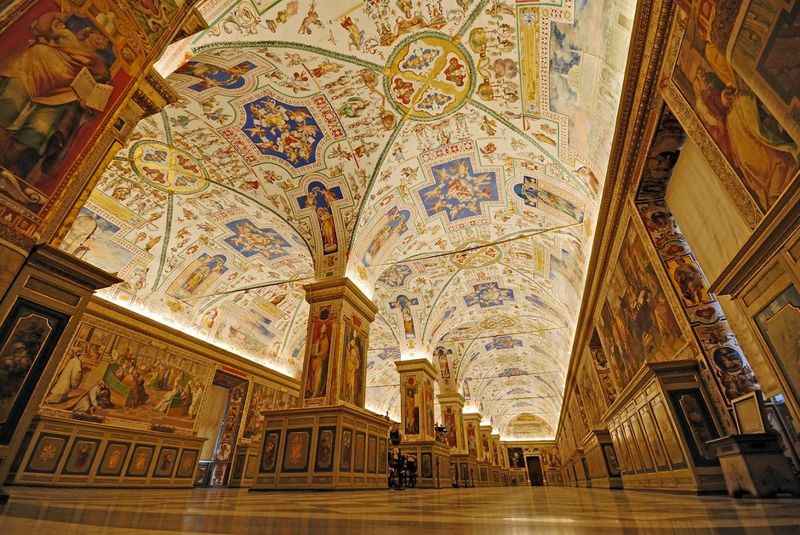
The Vatican Museums are a treasure trove of art and culture located within the walls of Vatican City.
The museums contain an impressive collection of art and artifacts that have been collected by the Catholic Church over the centuries.
One of the highlights of the museum is the Raphael Rooms, a series of four rooms painted by the famous Italian artist Raphael in the early 16th century.
The Raphael Rooms are considered some of the most important works of art from the High Renaissance period.
7. Fontana di Trevi (Trevi Fountain)
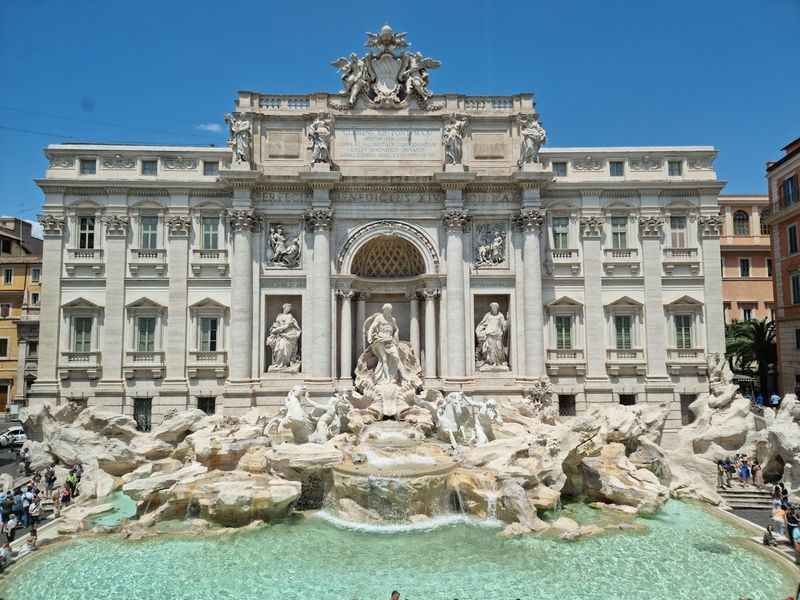
The Trevi Fountain is one of the most popular tourist attractions in Rome and probably the most famous fountain in the world.
Built in the 18th century, the fountain on the Piazza di Trevi features a magnificent sculpture of the god of the sea, Neptune, flanked by two tritons.
Visitors can toss a coin into the famous Trevi fountain, which is said to ensure a return trip to Rome, as well as good luck and prosperity.
The fountain is a true masterpiece of Baroque art, with its intricate carvings, glistening waters, and stunning sculptures.
8. Spanish Steps and Piazza di Spagna

The Spanish Steps are a grand staircase of 135 steps that connect the Piazza di Spagna with the French Church Trinità dei Monti at the top.
The steps were built in the 18th century and are a popular gathering spot for locals and tourists alike.
The Piazza di Spagna, at the base of the steps, is a bustling square that is home to several cafes, restaurants, and designer shops.
Visitors to the Piazza di Spagna can enjoy the stunning Baroque architecture and soak up the atmosphere of one of Rome's liveliest neighborhoods.
9. Piazza Navona
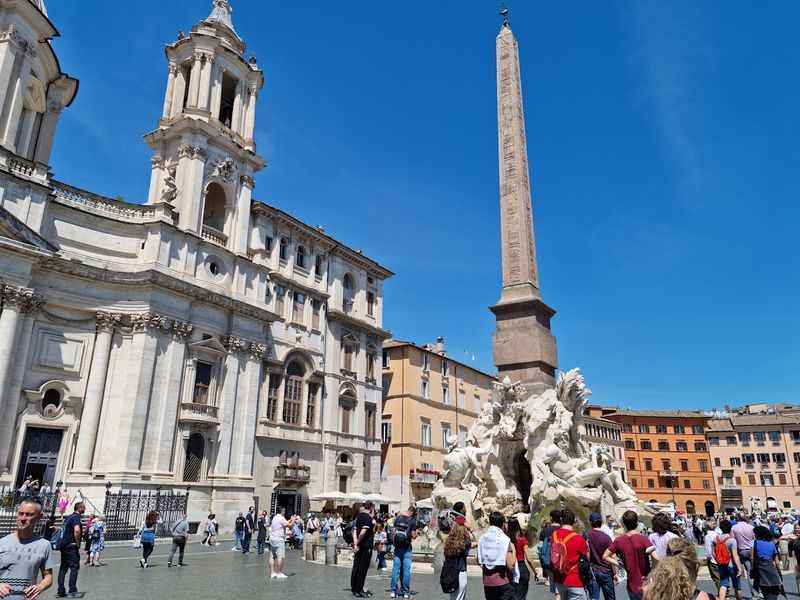
Piazza Navona is one of the most beautiful squares in Rome. It was built in the 1st century AD and is known for its stunning Baroque architecture, including the famous Fontana dei Quattro Fiumi (Fountain of the Four Rivers) designed by Bernini.
Piazza Navona is also home to several other fountains, beautiful buildings, and a lively atmosphere that draws visitors from all over the world.
Piazza Navona is a great place to enjoy some Italian gelato, watch the street performers, and take in stunning architecture.
10. Villa Borghese

Villa Borghese is a beautiful and expansive public park located in the heart of Rome.
Villa Borghese covers an area of over 80 hectares and is home to a variety of attractions, including museums, galleries, fountains, and gardens.
One of the most popular attractions in the park is the Galleria Borghese, which houses an impressive collection of art, including works by Caravaggio, Rubens, and Leonardo da Vinci.
Visitors to Villa Borghese Gardens can take a stroll, relax by the lake, or enjoy a picnic on the grass.
11. Piazza del Popolo and Santa Maria del Popolo
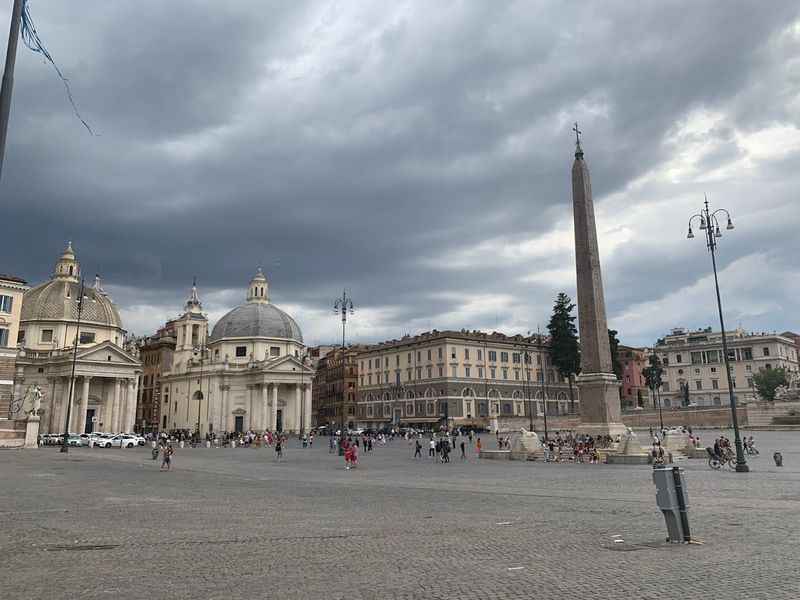
Piazza del Popolo is one of the most famous public squares in Rome, known for its grandeur and historical significance.
At the heart of the square is the Egyptian obelisk, which dates back to the reign of Pharaoh Ramses II in the 13th century BC.
Surrounding the square are several important landmarks, including the city gate ‘Porta del Popolo' and the Santa Maria del Popolo church, which features beautiful artwork by Caravaggio and Raphael.
The church has a fascinating history, having been built on the site of an ancient Roman temple, and later associated with the legendary Emperor Nero.
12. Palatine Hill
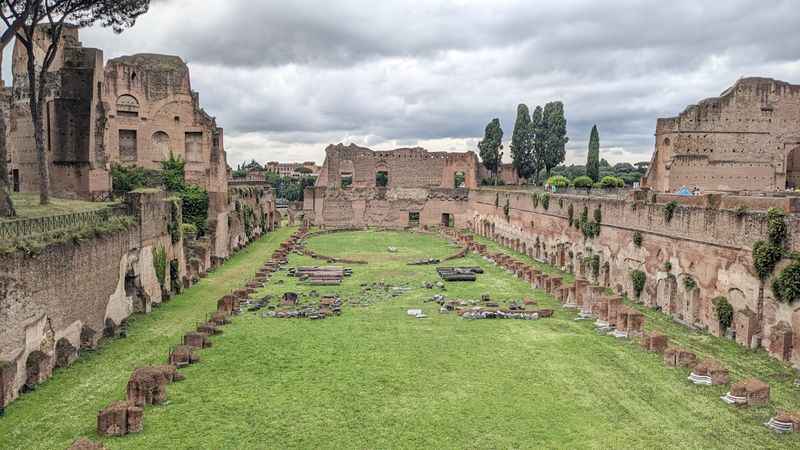
Palatine Hill is one of the seven hills of Rome and is considered the birthplace of the city.
It is located in the central part of Rome and is known for its stunning views of the Roman Forum and the Colosseum.
Visitors to Palatine Hill can explore the ruins of several ancient palaces, including the Palace of Domitian and the Palace of Augustus, as well as the remains of the Hippodrome, which was once used for chariot races.
The hill is also home to the Farnese Gardens, a stunning botanical garden.
13. St. Peter's Basilica and St. Peter's Square
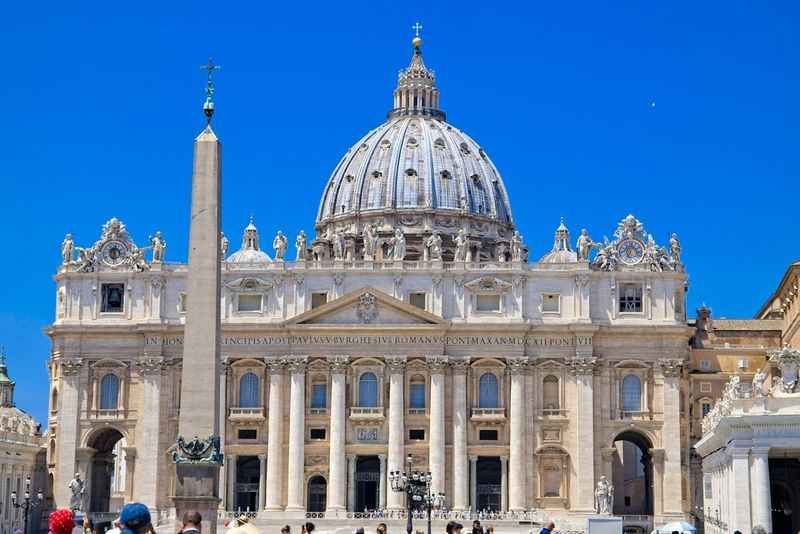
St. Peter's Basilica, located within the Vatican City, is one of the most famous churches in the world and is a must-visit destination for anyone traveling to Rome.
The Basilica is known for its stunning Renaissance and Baroque architecture, including the famous dome designed by Michelangelo.
Visitors to St. Peter's Basilica can marvel at Michelangelo's "Pieta" sculpture and Bernini's "Baldacchino" canopy.
St. Peter's Basilica is the largest church in the world and home to the tomb of St. Peter. Another highlight is the Egyptian obelisk in the center of St. Peter's Square.
14. Via Appia Antica
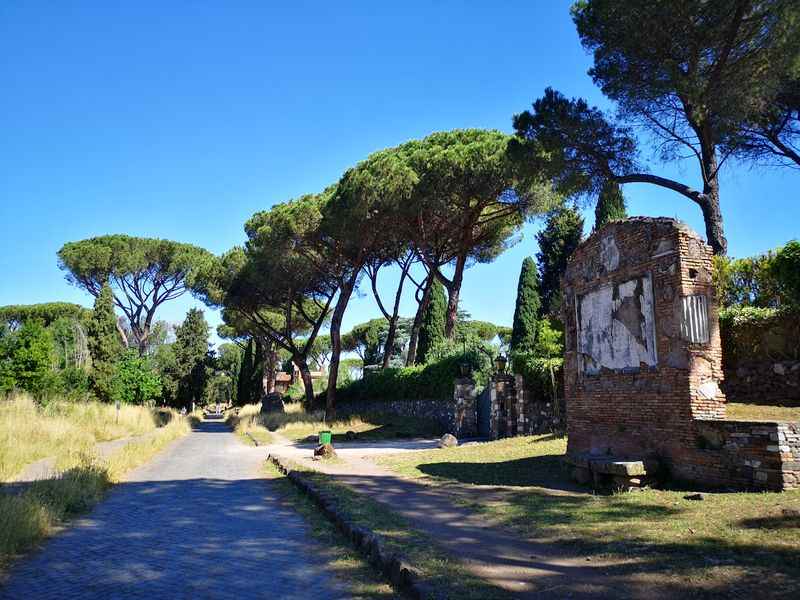
Via Appia Antica, or the Appian Way, is one of the oldest and most famous roads in Rome.
Originally built in 312 BC, the road stretches for over 350 miles. It was located just outside the city walls and was an important transportation route in ancient Rome.
Some of the highlights of a visit to the Appian Way include the Catacombs of San Callisto and San Sebastiano, where early Christians were buried, the Villa of the Quintilii, a sprawling estate once owned by wealthy Roman nobles, and the Circus of Maxentius.
15. The Circus Maximus

The Circus Maximus is an ancient Roman chariot racing stadium located in the valley between the Aventine and Palatine hills in Rome, Italy.
It was originally built in the 6th century BC and was expanded over the centuries to become the largest stadium in the Roman Empire.
The site hosted various types of events, including chariot races, gladiatorial contests, and other Roman games, which were an important part of the city's culture and entertainment.
With its grand size and historical importance, the Circus Maximus offers a fascinating glimpse into Roman life and the ancient world.
16. Piazza Venezia
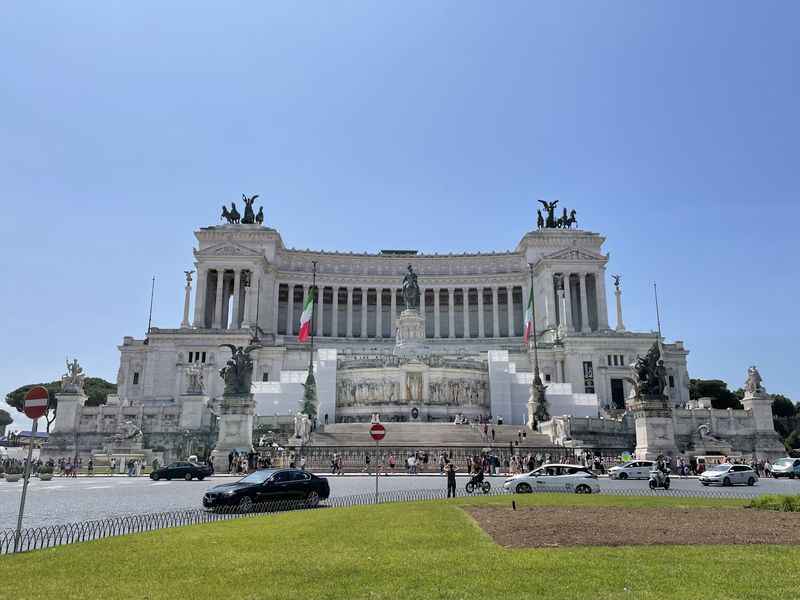
Piazza Venezia is a famous square located in the heart of Rome, Italy.
The square is home to some of the most important landmarks in the city, including the Altare della Patria (the Monument to Vittorio Emanuele II), the Palazzo Venezia, and the Trajan's Column.
Piazza Venezia is a bustling hub of activity. Visitors can admire the stunning architecture and monuments, take a stroll through the square's beautiful gardens, or enjoy a coffee or gelato in one of the many cafes and restaurants in the area.
17. Campo dei Fiori Market

Campo dei Fiori market is one of the most lively outdoor markets in Rome.
Located in the heart of the historic city center, it offers a colorful array of fresh fruits, vegetables, meats, cheeses, flowers, and other local products.
The market's history dates back to the 19th century and it was once a gathering place for local farmers and traders.
Today, it is a popular destination for tourists and locals alike, who come to soak up the lively atmosphere and experience the authentic flavors of Rome.
18. Capitoline Hill and the Capitoline Museums
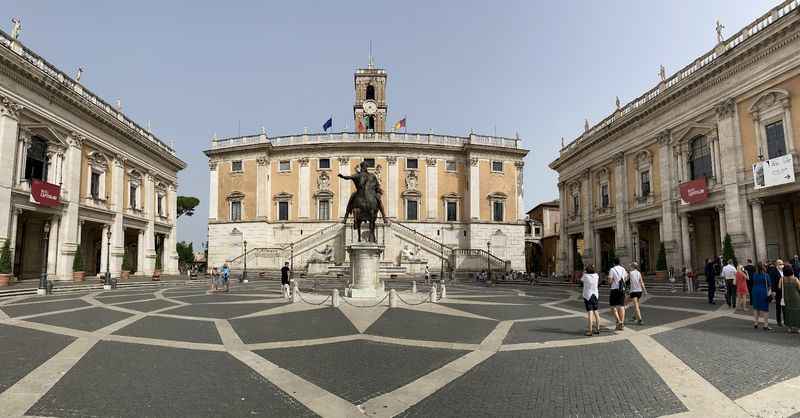
Capitoline Hill, or Campidoglio in Italian, is one of the seven hills of Rome and an important historical site.
It was the political and religious center of ancient Rome and is now home to many of the city's most important museums and monuments.
Visitors can admire the equestrian statue of Marcus Aurelius in the center of Piazza del Campidoglio, as well as the famous Capitoline Museums, which house a vast collection of ancient artifacts, including the famous Capitoline Wolf sculpture.
19. Vittoriano
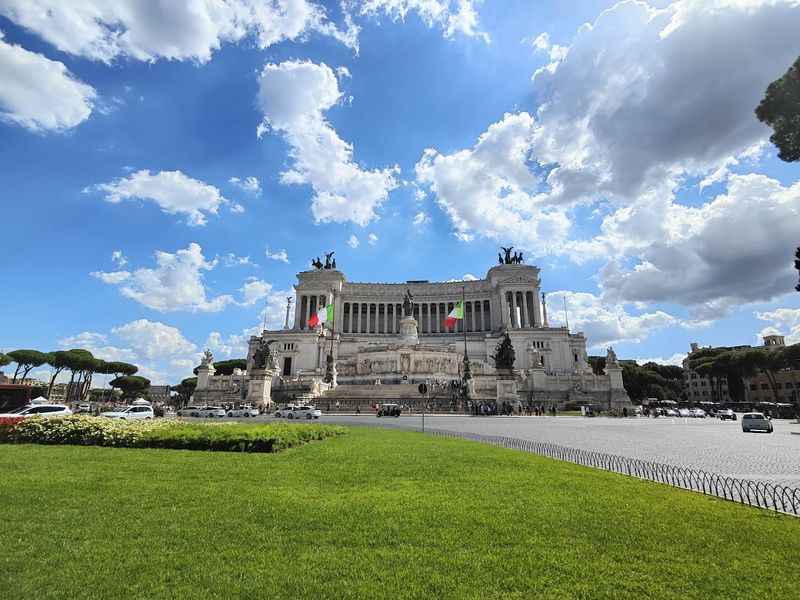
The Vittoriano, also known as the Altare della Patria, is a monument located in Piazza Venezia. It was built in honor of Victor Emmanuel II, the first king of a unified Italy, and is one of the most important landmarks in the city.
The massive white marble structure features a grand staircase, numerous sculptures, and an equestrian statue of Victor Emmanuel II.
The Vittoriano is a symbol of Italy's national identity and a must-visit destination for anyone traveling to Rome.
20. Castel Sant'Angelo
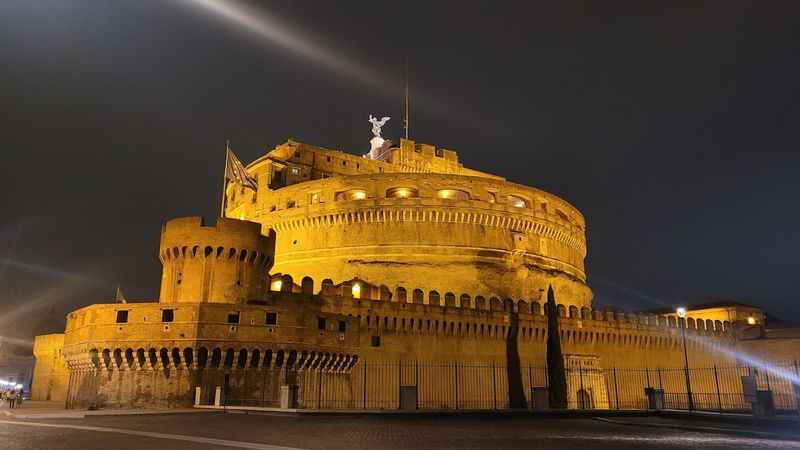
Castel Sant'Angelo is a towering cylindrical fortress located on the banks of the Tiber River in Rome.
Originally built as a mausoleum for the Roman emperor Hadrian, it was later converted into a castle and used as a papal residence and a prison.
Visitors to the mausoleum of Emperor Hadrian can explore the castle's many levels and take in stunning views of Rome from the castle's ramparts and terraces.
A visit to Castel Sant'Angelo offers a unique opportunity to experience the city's ancient architecture and engineering up close.
21. Largo di Torre Argentina
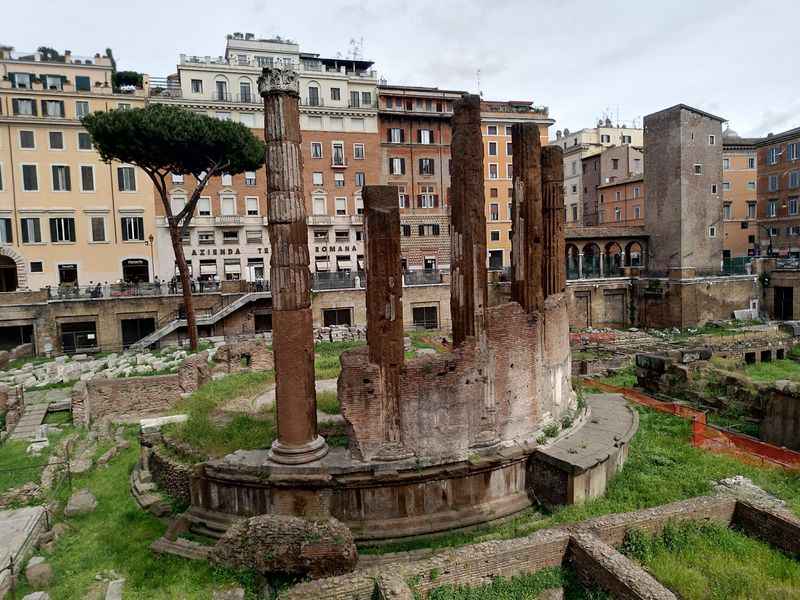
Largo di Torre Argentina is a square located in the heart of Rome, famous for being the site of the remains of four ancient Roman temples, and the spot where Julius Caesar was assassinated.
Today, the square is home to a sanctuary for cats, where hundreds of cats roam free among the ruins.
The place offers a unique opportunity to interact with Rome's famous feline residents, making it a must-visit destination for cat lovers and history buffs alike.
22. Rome's National Museum
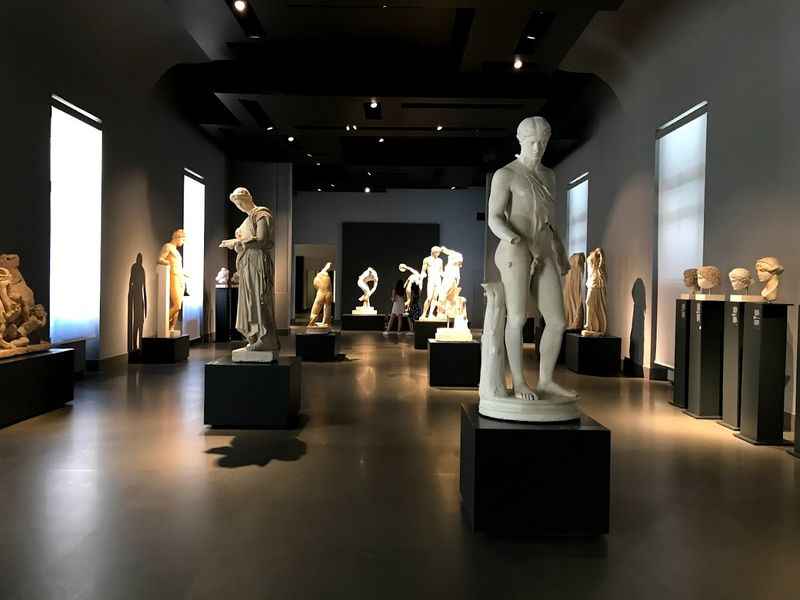
Rome's National Museum is a must-visit destination for history buffs and art lovers alike.
It boasts an impressive collection of ancient Roman artifacts and works of art, including sculptures, mosaics, frescoes, and other decorative objects.
The museum's exhibits span over 1,000 years of Roman history, from the Republic to the Empire, including the iconic Farnese Hercules statue, the Hellenistic-era Boxer at Rest, and the beautiful frescoes from the Villa of Livia.
FAQs: The Best Places to Visit in Rome
In this section, we provide answers to common questions relating to the best places to visit in this city.
What is the most visited place in Rome?
The most visited place in Rome is undoubtedly the Colosseum. This ancient amphitheater was completed in AD 80. Millions of tourists flock to the Colosseum every year to marvel at its architecture, learn about its bloody history, and take in the stunning views of the surrounding area.
What you shouldn't miss in Rome?
There are so many incredible sights to see in Rome, but some of the things you definitely shouldn't miss include the historic center, the Vatican Museums, the Pantheon, the Trevi Fountain, Piazza Navona, St. Peter's Basilica at St. Peter's Square, the Roman Forum, Piazza del Popolo, the Mausoleum of Roman Emperor Hadrian, and the Roman houses and baths in the Forum of Trajan.
You should also make sure to visit Rome's National Museum, try some of the local cuisine, and explore some of the charming neighborhoods like Trastevere and Monti.
What should be visited in Rome?
You should visit the Colosseum, the Roman Forum, the Pantheon, the Trevi Fountain, the Vatican Museums (especially the Sistine Chapel), St. Peter's Basilica at St. Peter's Square, the Spanish Steps, the Capitoline Museums at Piazza del Campidoglio, Basilica di Santa Maria Maggiore, the church of San Luigi dei Francesi, Basilica di San Clemente, and the Piazza Navona.
You should also make time to stroll around the charming streets of the historic center, watch the street artists, take in the views from Gianicolo Hill, and enjoy the best ice cream when you visit Rome.

What is the most beautiful area of Rome?
Rome is full of beautiful areas, but one of the most picturesque places to see in Rome is the Trastevere neighborhood. This bohemian area on the west bank of the Tiber River is known for its narrow streets, colorful buildings, and lively nightlife.
The Pincio, one of Rome's oldest gardens commissioned by the Pinci family in the fourth century, is another lovely area. It is part of Villa Borghese and is famous for its Vatican view at sunset from overlooking Piazza del Popolo. You can also easily undertake a number of day trips from Rome and explore more beautiful areas.
Summing Up: 22 Best Places to Visit in Rome
Rome is a city that offers a wealth of attractions that make a Rome tourist map hard to read. From the Roman Forum to the stunning art of the Vatican Museums, the 22 exciting Rome attractions will leave you breathless.
Whether you're strolling through the beautiful Piazza Navona or climbing the Spanish Steps, every corner of Rome is filled with history and beautiful architecture.
Don't forget to visit St Peter's Square, the Villa Borghese Gardens, Piazza Venezia, Piazza del Campidoglio, and other top sights during your city trip to fully experience the beauty and grandeur of Rome's main tourist attractions.
So book your tickets and visit Rome to experience these wonders for yourself and create memories of the Eternal City that will last a lifetime.
The Colosseum
The pantheon.

St. Peter's Basilica and St. Peter's Square
The sistine chapel.

Fontana di Trevi (Trevi Fountain)
Related articles, featured in.

- TAXI FARES CALCULATOR
- BOOK PRIVATE TOUR
- Hotels near Termini
- 3 Star Hotels
- 4 Star Hotels
- 5 Star Hotels
- Apartments For Rent
- Best Hostels
- Hotels near the Colloseum
- Fiumicino Airport
- Ciampino Airport
- Termini Railway Station
- To Florence
- To Ostia Antica
- Famous Roman Dishes
- Best Pizza Places
- Best Pasta Places
- Local Italian Food
- Best Gelato Places
- Best Rooftop Bars
- Sistine Chapel
- Vatican Museums
- Borghese Gallery
Roman Forum
- Trevi Fountain
- Spanish Steps
- Castel Sant’Angelo
- Navona Square
- Ancient Sites and Ruins
- Galleries and Museums
- Parks and Gardens
- Squares and Fountains
- Beaches near Rome
- To Alberobello
- How to Choose a Hotel in Rome
- 2025 Pilgrims of Hope Jubilee
- Rainy Days in Rome
- What to See in 3 days
- Buying a Sim Card in Italy
- Tickets to Vatican museums
- Renting a Car in Rome
- Apps for Tourists
- Souvenirs from Rome
- Free Things to Do
- Unusual Things to do
- Public Transport
- Italian food and wine
- Sightseeing Tour at Sunrise
- Sightseeing Tour by Car
- St Peter’s Basilica
- Colosseum & Roman Forum
- Campo Marzio
- Jewish Ghetto Quarters
- Quartiere Coppedè
- Sant’Eustachio
- Marcus Aurelius
- Gaius Julius Caesar
- Octavian Augustus
Ancient Roman Sites and Ruins
Written by: Kate Zusmann
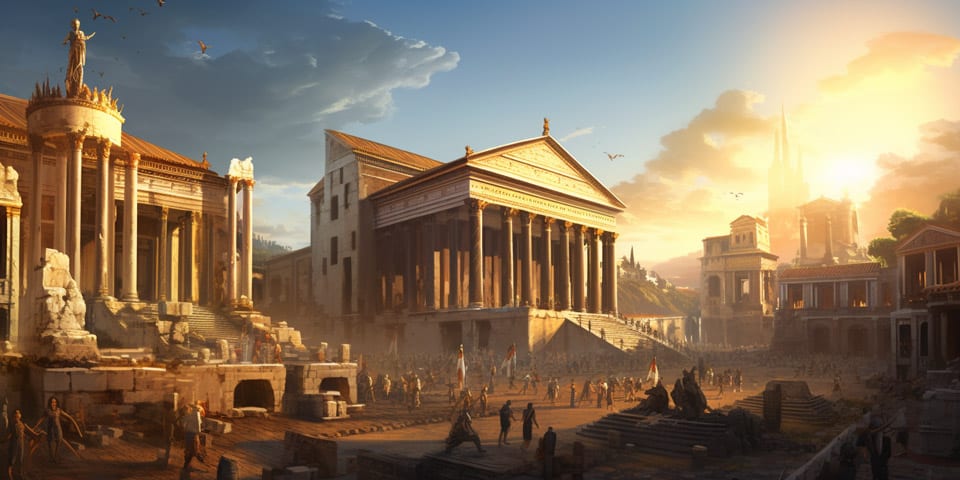
There are a lot of ancient Roman architecture sites, and they are full of history. For example, the Eternal City has existed since 753 BC, and its architecture and works of art influenced the whole world.
In addition, there are many dignities in the ancient city, most of which you can find in the historic center. Moreover, some of them are free, while others you can visit by using Rome Passes or tickets.
FAQ about Ancient Roman Sites and Ruins
Who founded ancient rome, what is the most famous place in ancient rome, where are located the oldest roman ruins, what are the oldest architectural sites in rome.
Here’s the list of famous Roman ancient sites:
The Colosseum
The Colosseum or Coliseum is perhaps the grandest construction in the history and culture of ancient Rome. It was created around 70-72 A.D. by Emperor Vespasian of the Flavian dynasty as a gift to the Roman people.
Moreover, the site had been the most prestigious place for entertainment in the capital and empire for four centuries.
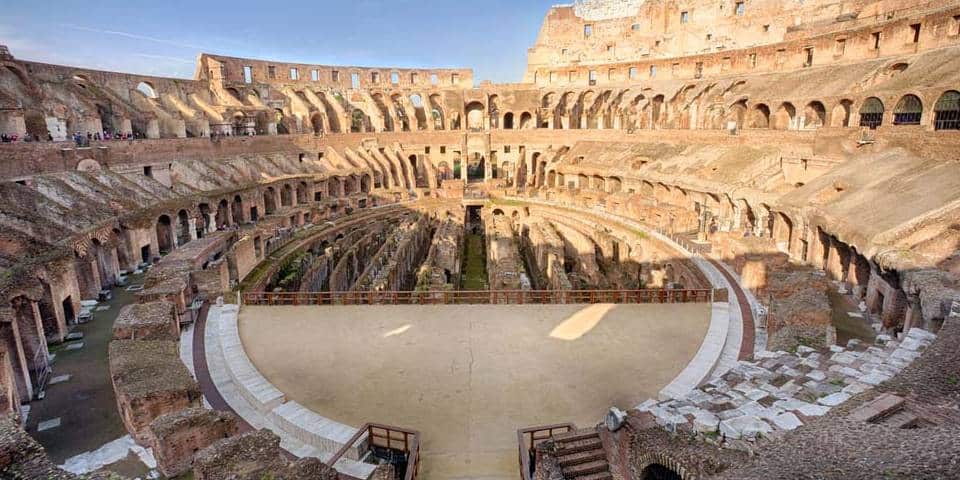
Throughout the theater’s existence, two-thirds of the original construction has been destroyed and renovated several times. However, it remains one of the most famous touristic destinations in the world and an iconic symbol of Rome.
The Pantheon
The Pantheon is an ancient temple dedicated to the Roman gods. Moreover , it is an embodiment of the greatness of the Roman Empire. It is assumed that the temple was built in 2 A.D. in the place of another temple, built in 27 B.C. by Marcus Agrippa Moreover, the Pantheon is one of the few buildings of ancient Rome which have survived unchanged to this day.
Nowadays, this ancient crowning glory can be found at Piazza della Rotonda.

Interesting fact: Raphael wanted to be buried in the temple because according to him, it was a place where people and gods are united. The great artist was buried in the Pantheon. This event turned the temple into a burial place of great and famous people.
The Mausoleum of Hadrian
The Mausoleum of Hadrian , also known as Castel Sant’Angelo (The Castle of the Holy Angel), has a great view and impressive history. It was built at the dawn of Christianity on the banks of the Tiber River and served as the refuge for the Roman emperor, the residence of pontiffs, a fortress, then a prison, and later – the museum and treasury.
There is a legend that the Archangel Michael appeared above the mausoleum, putting his sword back into the sheath. Thus, the end of the plague in 590 A.D. was marked. To celebrate this, the tomb received its present name.
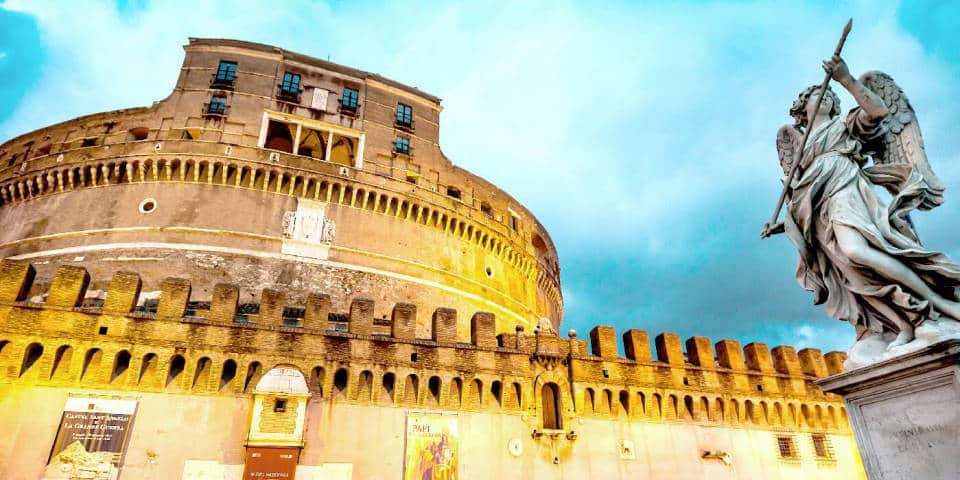
Interesting fact: in Italy and in many other European countries, you have to say “God bless you!” to any person who had just sneezed. In the Middle Ages, it was believed that the plague began with sneezing attacks and only God could heal the plague of a sick person
The Theater of Marcellus
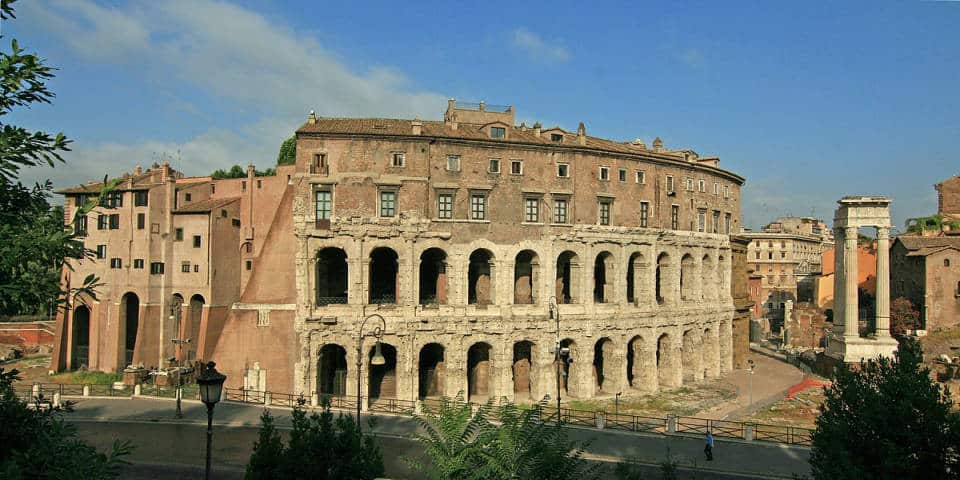
The Theater of Marcellus (Teatro di Marcello) is a structure whose construction was started by Julius Caesar . It was finished by Augustus and dedicated to his favorite nephew Marcellus. The building is one of the ancient examples of important entertainment venues for Romans.
Marcellus’s Theater is the primary version of the Colosseum, but it is not the Colosseum, which is the original Roman amphitheater
The Circus Maximus
The Circus Maximus is the giant racetrack of ancient Rome , situated on the left bank of the Tiber River, between the Palatine and Aventine hills, near the center of the modern city.
Moreover, Circo Massimo comes from the Latin Circus Maximus, where one of the meanings of the word “circus” is a hippodrome, a place for horse contests. Horse racing has been taking place for centuries in the valley between the hills.
However, the initial function of the racetrack was to host the Roman Games (Ludi Romani). The last race in the Circus Maximus was held in 549 AD, during the reign of Emperor Totila However, after it, the era of destruction began.
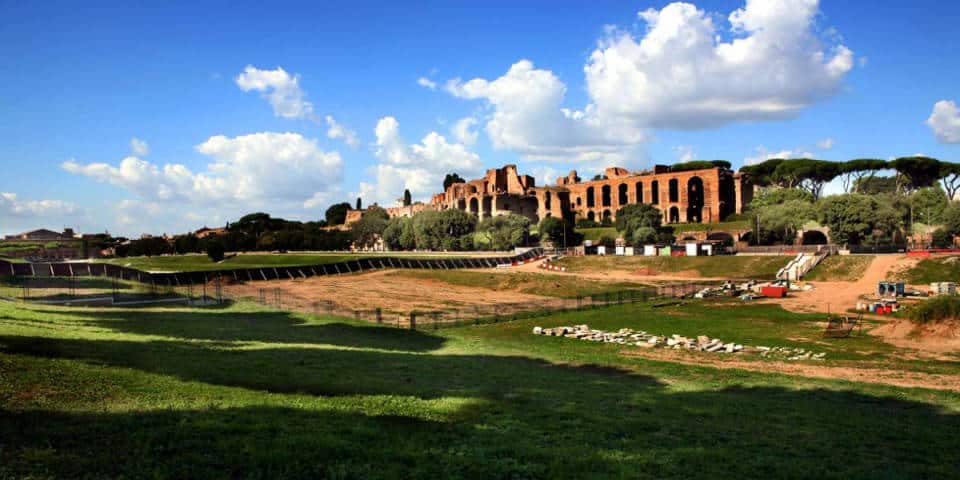
Interesting fact: In summer 2014, a concert of the legendary music band Rolling Stones during their world tour took place on the Circus Maximus, which brought together 65,000 rock fans
The Mouth of Truth
The Mouth of Truth (Bocca della Verita) is a Pavonazzo marble mask with a gloomy face of an unknown god set at the entrance of the Santa Maria church in Cosmedin. According to Medieval myth, the marble mask was used as a unique way of finding whether a person was telling the truth or not.
People, who had committed crimes or were accused of committing crimes unfairly, were brought in front of the mask. They were asked to take an oath and had to place their hand inside the sculpture’s open mouth while answering the executioner’s questions.
Ancient Romans believed that if a person was telling the truth, the mask would never move a muscle. However, if the person were telling a lie, the mouth would close and then cut off that person’s hand.
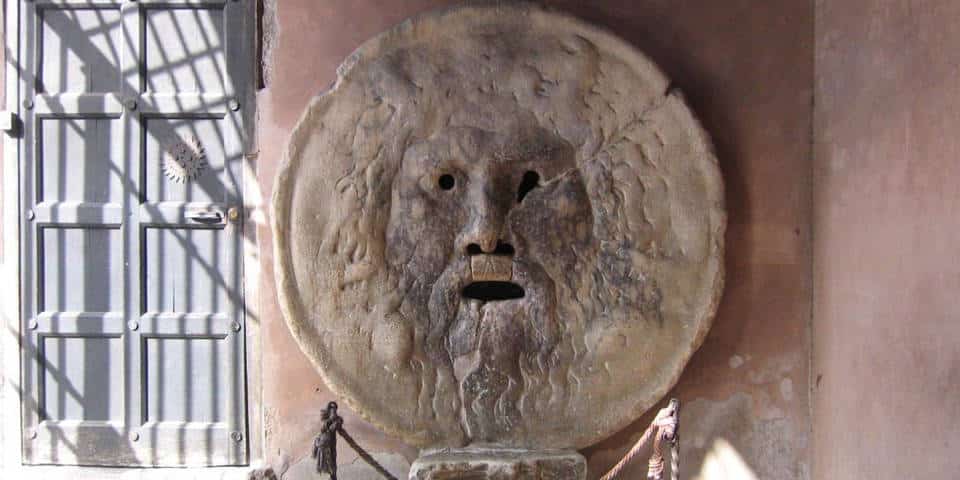
Interesting fact: The legend about the Mouth of Truth became famous when it was featured in “Roman Holiday” (1953) . The mask was used as a storytelling device in the movie and exposed the truth about the myth
The ancient Roman Forum is a vast complex of triumphal arches, marble fragments, basilicas, ruined temples, and other architectural elements from different periods. Moreover, it was ancient Rome’s ceremonial, political, religious, and business center.
The forum provides insight into the splendor that previously was the Roman Empire.
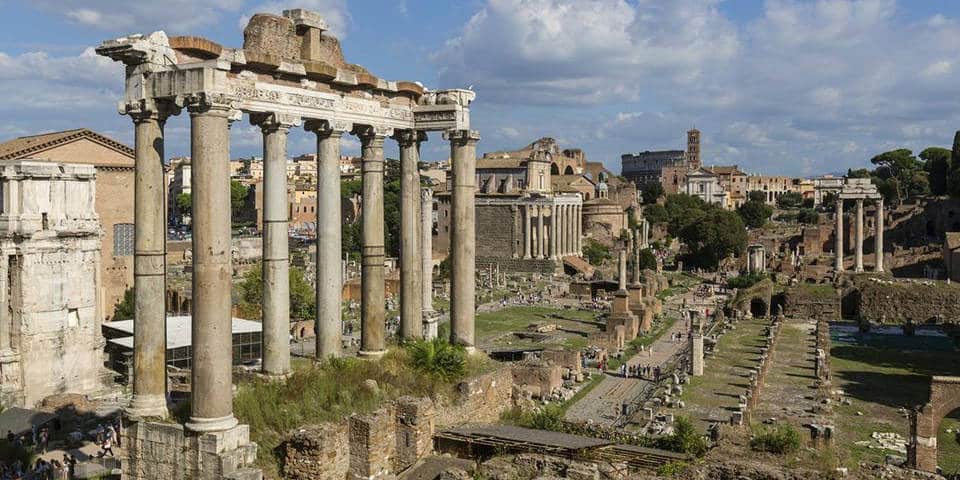
The Capitoline Hill
Located above the Roman Forum, Capitoline Hill was the symbolic center of ancient Roma and held the Temple of Jupiter.
Moreover, today you can find the two oldest public museums in the world. The first is Palazzo Nuovo with Greek and Roman sculptures, while the second is Palazzo dei Conservatori, where you will find art galleries, sculptures, and frescoes. The Capitoline Hills has the best view of the Eternal City’s historic center.
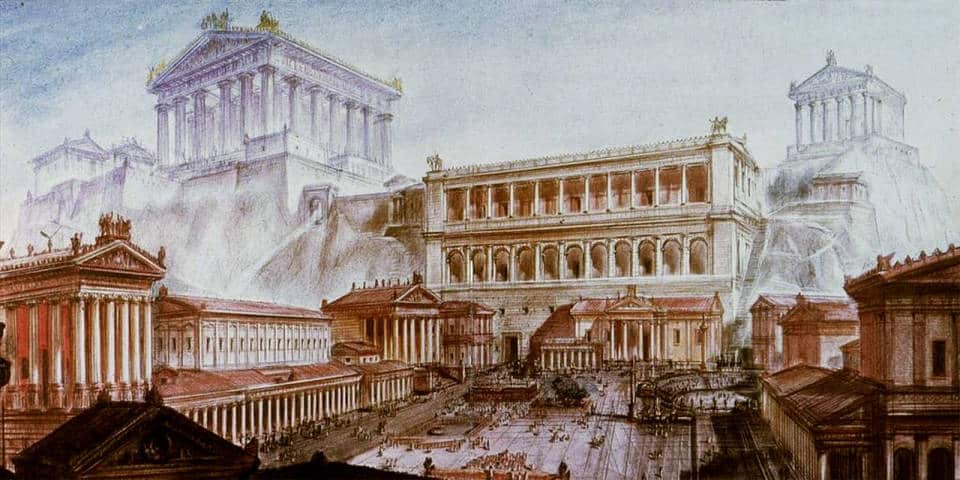
One ticket gives you admission to both museums
The Catacombs of the Appia Antica
Three of Rome’s most extensive and essential catacombs areSan Callisto, San Sebastiano, and Santa Domitilla.
Catacombs of San Callisto
Built between 250 and 300 A.D., the Catacombs of San Callisto (St. Callixtus) hold the graves of 500,000 Christians, including dozens of martyrs and 16 pontiffs.
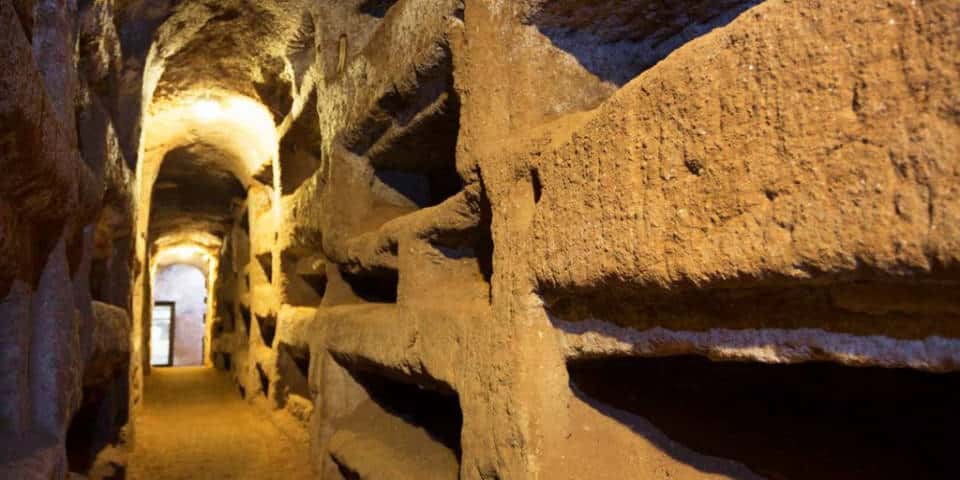
Catacombs of San Sebastiano
The Catacombs of San Sebastiano are similar to the catacombs of San Calisto. There are four floors with different paintings from the rise of Christianity, graffiti, and mosaics.
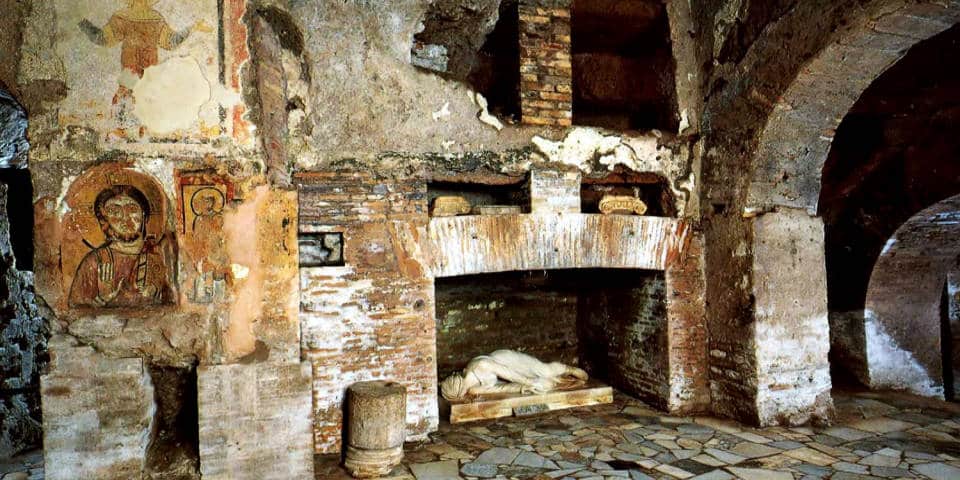
Catacombs of Santa Domitilla
These are one of the most significant and most ancient catacombs Catacombs of Santa Domitilla have four levels of graves and comprise 15 km (9.3 mi). Moreover, rich people were buried in decorated tombs of bigger size, individually or with their family members.
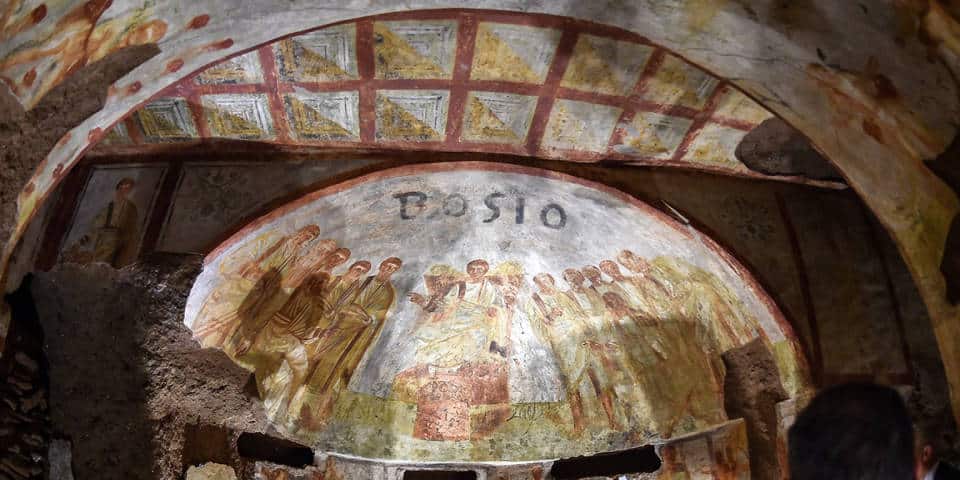
The domus of Romulus and Remus
The Domus of Romulus and Remus was created in the second century B.C. It consists of the entrance which leads to the atrium (open-roofed entrance hall) with an impluvium (the square basin in the center of the atrium, which receives rainwater from an opening in the roof) surrounded by private rooms.
The house was excavated in the years 1871-72.
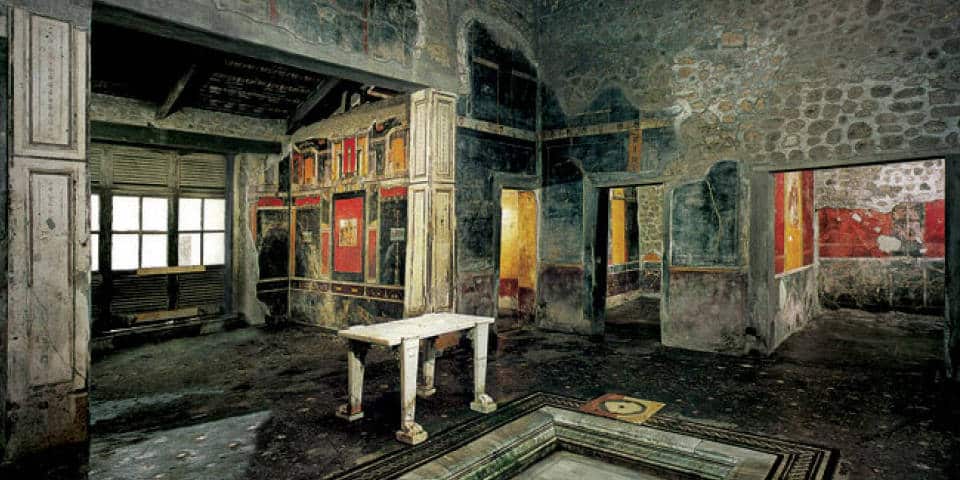
Interesting fact: during the excavation of the house, the bodies of five people were discovered. One of them died during the attempt to escape. He held numerous gold, silver and bronze coins and rings in his hands
Baths of Diocletian
The Baths of Diocletian were commissioned by Emperor Diocletian in 298 AD and had a capacity of more than 3000 people. Moreover, this bath complex was the largest in ancient Rome, and its structure was similar to that of the Baths of Caracalla.
Also, the Roman public baths worked until 537, when the Goths cut off the aqueducts trying to conquer Rome.
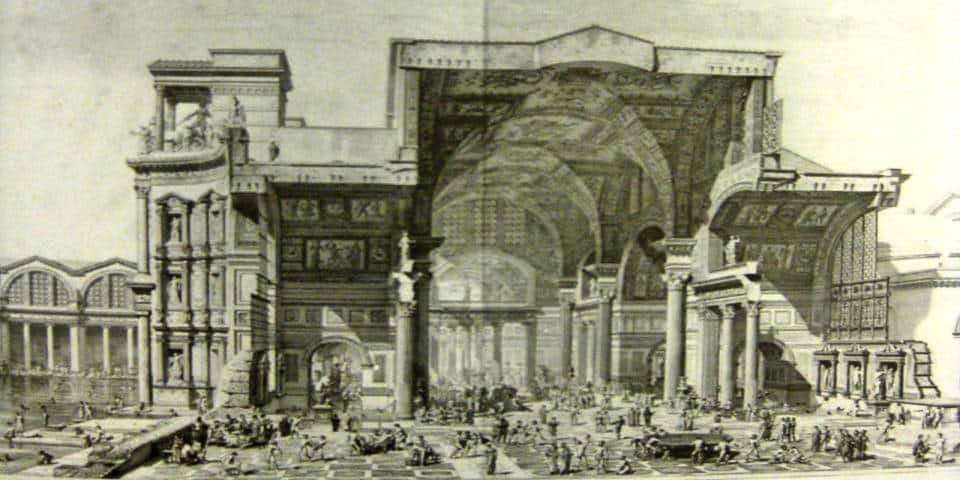
Interesting fact: During the construction of the Baths of Diocletian, thousands of Christian slaves died, while the Emeror Diocletian died in 305 because he was too tired and ill
Baths of Caracalla
The construction of the Baths of Caracalla started in the year 212 by Emperor Caracalla . It took about 5 years to finish them because a new aqueduct was built especially for the baths. The spa was not simply a place for bathing, sport, and health, but also for relaxing and studying.
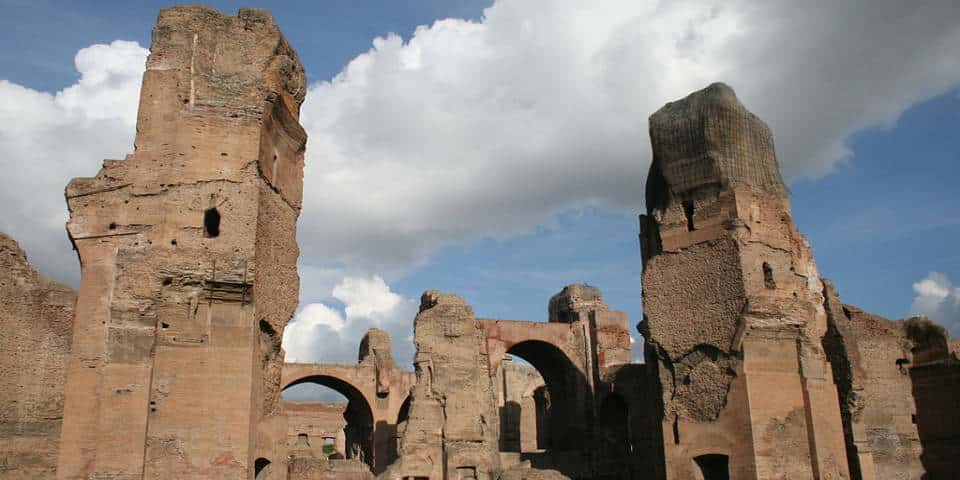
Trajan’s Markets
The Trajan’s Markets is a large complex of ruins created in the 2 nd century A.D., and it is part of the Trajan’s Forum Moreover, Trajan’s Forum, along with the forums of Julius Caesar , Augustus , Nerva , and the Templum Pacis, were constituted the center of the Roman Empire.
Moreover, it is considered the world’s first shopping mall – all the shops and apartments were built in a multi-level structure; even nowadays, you can visit several levels.
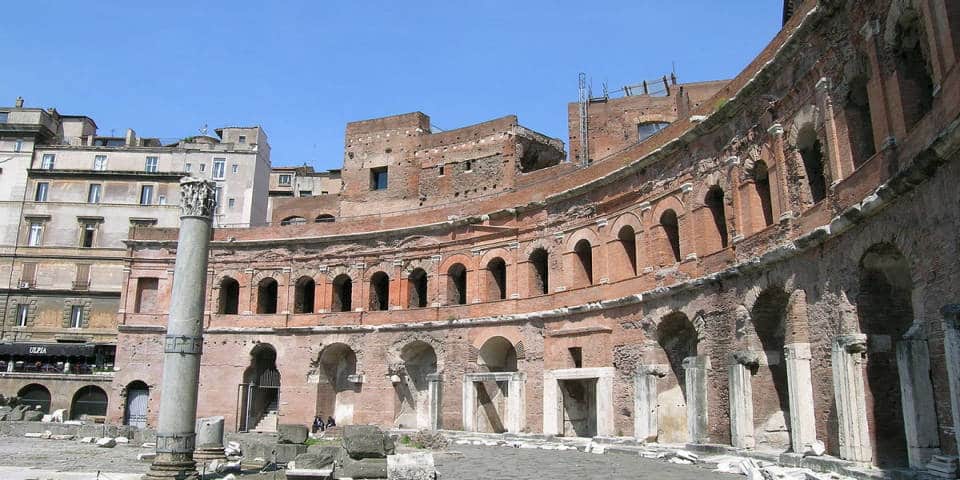
Pyramid of Cestius
The Pyramid of Cestius is the tomb of praetor Caius Cestius Epulone. It was built in the year of his death, in 12 B.C. Its height of 36.40 meters and 30 square meters at the base.
It took 330 days to build the pyramid. Nowadays, the Pyramid of Cestius is located right near the metro station “Piramide.”
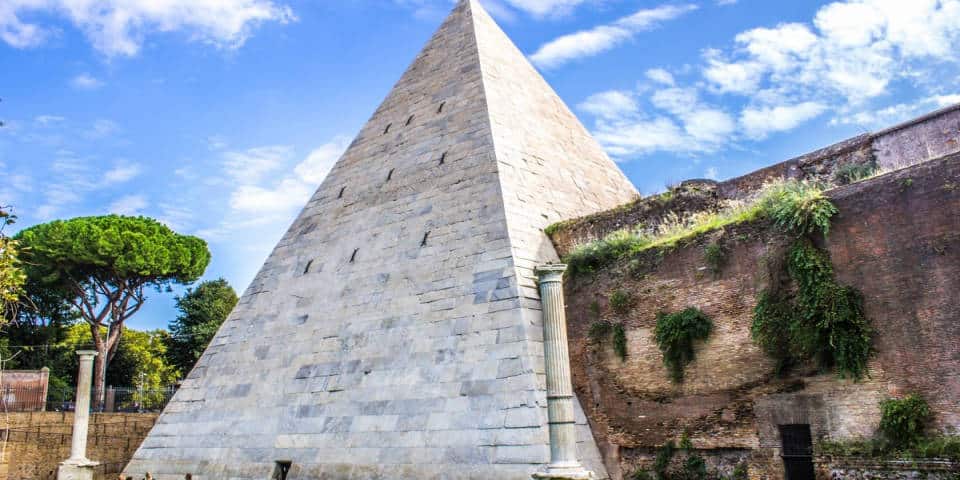
Stadium of Domitian
The stadium of Domitian (Stadio di Domoziano) was built in Rome as Tit Flaviy’s gift to Roman citizens and was used for conducting different sports events.
Here, the second name of the stadium is Agons arena, and Navona Square got its name thanks to this term. In the 1st century A.D., the stadium was called “Campus Agonis,” while closer to the Middle Ages this form transformed into “n’agone” Lastly, the name of the place was simplified to “Navona” So that, nowadays, this spot became one of the most famous Roman squares – Piazza Navona .
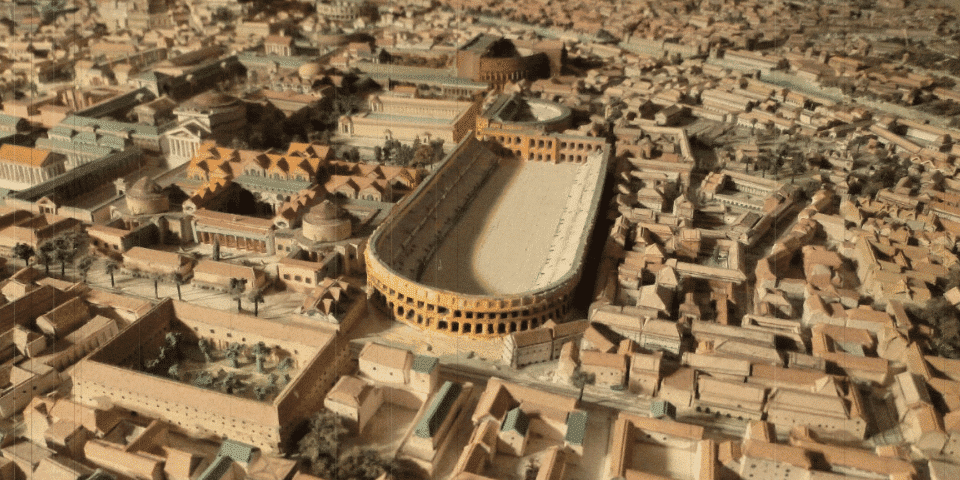
Rome is full of ancient sites with rich history and exceptional beauty.
The city represents its story in every corner. Undoubtedly, it is worth discovering all these sites for yourself, but it will take several months or even years.
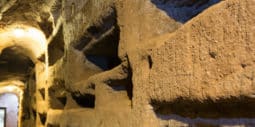
The Catacombs of St. Callixtus
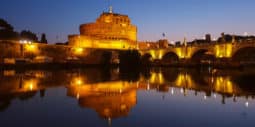
16537 views
Castel Sant’Angelo in Rome
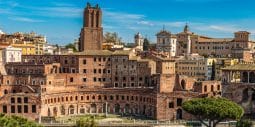
Trajan’s Market
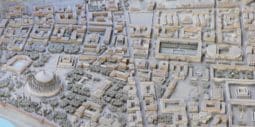
11952 views
Field of Mars in Rome (Campus Martius)
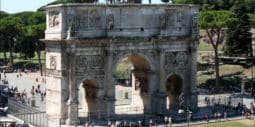
14695 views
Triumphal Arch of Constantine
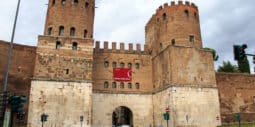
21398 views
The Aurelian Walls
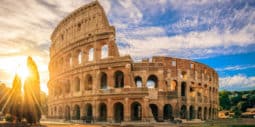
104606 views
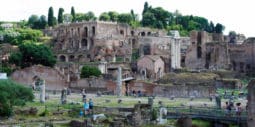
10660 views
Palatine Hill
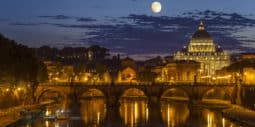
31164 views
The Tiber River in Rome
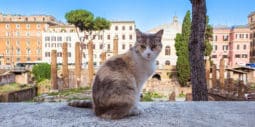
11018 views
Rome Cat Sanctuary Ruins – Largo di Torre Argentina
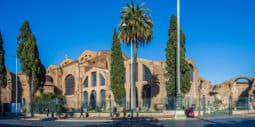
Roman Thermal Baths of Diocletian
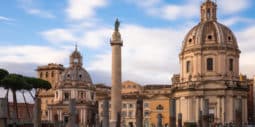
15571 views
Famous Architectural Columns in Rome
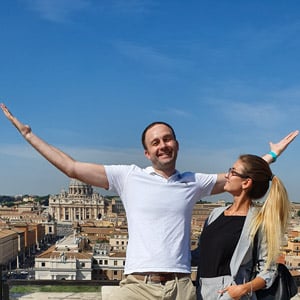
Read more about Rome

What the Colosseum Used to Look Like?

10 Famous Dishes of Roman Cuisine

How Long Did it Take to Build the Colosseum in Rome?
Rome.us © 2024. Created with love by Roman experts and guides.
Privacy Policy
Nomad Epicureans
- All Destinations
- Work with Us
- Disclosure & Privacy Policy
20 Historical Sites in Rome You Shouldn’t Miss
- July 19, 2023
A trip to Rome just wouldn’t be complete without a historical excursion or two, but how does one even begin to choose a starting point? With a glorious history spanning over 2800 years, the Eternal City boasts several scintillating ancient ruins, archaeological sites, and historic landmarks. That is why we’ve compiled a list of the best historical sites in Rome. Discover some of the places where Ancient Rome once thrived, declined, and eventually fell.
Please note that this article contains affiliate links. Learn more about it on our Disclosure page. We use ads to support our small business – we hope you don’t mind them too much.
Table of Contents
- 1 Best Historical Sites in Rome
- 2 How to get to the Best Historical Sites in Rome?
- 3 Map of the Best Historical Sites in Rome
- 4 Further Reading For Your Rome Visit
- 5 More Information About Italy
Best Historical Sites in Rome
Rome remains one of the world’s most striking and significant concentrations of ancient remains making it a goldmine for architecture connoisseurs, art lovers, and archaeologists.
Not only are these Rome historical sites worth visiting, but they also offer a glimpse into Rome’s storied past. However, you don’t necessarily have to be a history buff to appreciate the immense beauty and significance of the best Ancient Rome landmarks.
Some of these ancient sites are world-famous but there are also a few that are often overlooked by tourists and can thus be classified as hidden gems in Rome.
Finally, as this is a list of the best historical sites in Rome (those from antiquity and the Middle Ages), it doesn’t include some of the top Rome attractions such as St. Peter’s Basilica or the Trevi Fountain, both of which are relatively recent (by Roman standards).
So, without further ado, here’s our lowdown on the must-see historical sites in Rome (in no particular order):
1. Roman Forum
The best place to begin a tour of ancient sites in Rome is at the Roman Forum (Forum Romanum). Although it consists mostly of evocative ruins scattered haphazardly around a sun-baked terrain, the Forum represents almost a millennium of Roman power during the glory days of Ancient Rome.
The Roman Forum was originally just a marshy burial ground until it was developed in the 7th century BC, growing over time to become the social, political, and commercial hub of the Roman Empire.
Some of the events that took place there included triumphal celebrations, gladiatorial contests, elections, public speeches, religious ceremonies, business dealings, and more.
The ruins of some of the most significant landmarks in the Roman Forum, such as the Temple of Saturn, Arch of Septimius Severus, and the Basilica of Maxentius, are still easily identifiable, while other buildings have been reduced to evocative fragments.
The Roman Forum is perhaps the best place to experience Ancient Rome, as it’s one of the few places in the modern metropolis where you’re surrounded by antiquity on all sides. Conjuring up your imagination, be transported back in time, and see the city through the eyes of the Ancient Romans.
Make sure to check out our in-depth guide to visiting the Roman Forum .
Practical Information for Visiting the Roman Forum
The opening hours of the Roman Forum vary throughout the year. However, it is open daily from 09:00–approx one hour before sunset (last admission: 1 hour before closing).
Advance booking for the Roman Forum is required and no tickets are sold on-site. Tickets can be purchased online through the CoopCulture website, the official ticket agency for the Roman Forum.
A ticket to the Roman Forum also includes entry to the Colosseum and the Palatine Hill. Tickets cost 18 EUR but are non-refundable under any circumstances.
If you would like to purchase refundable tickets in case your plans change, you can book through GetYourGuide or Tiqets.
- Click here to book your Roman Forum tickets
Although there is plenty to see and explore at the Roman Forum, you can find very little information and signage on the site. Thus, to avoid your Roman Forum visit ending in frustration, I highly recommend booking a guided tour. Two good ones I can recommend are:
- Priority entrance to the Roman Forum, Palatine Hill & Colosseum Arena Floor, and Underground Area with a guide
- Exclusive Private Tour of the Roman Forum and Palatine Hill
2. Palatine Hill
The Palatine Hill (Palatino) is one of the seven hills of Rome and is located close to the Colosseum and the Roman Forum. It is one of the most significant historical sites in Rome and is considered to be the mythical birthplace of the Eternal City.
According to legend, the twins Romulus and Remus were brought up here by a she-wolf in a cave. After a violent disagreement between the two, Romulus killed Remus on the Palatine Hill before founding Rome here in 753 BC.
Whatever the truth of this, archaeological remains do confirm the existence of a sheep-herding population on Palatine Hill since approximately 1000 BC. As time went on and Rome grew in power and wealth, the Palatine became a fashionable residential district and was the most coveted address for Ancient Rome’s rich and famous.
Roman rulers and aristocrats built their monumental palaces and expansive villas here. Nowadays, Palatine Hill is a sprawling, crowd-free archaeological garden making it the most pleasant and relaxing of Rome’s ancient sites.
Some of the best things to see on Palatine Hill are the Domus Flavia, Domus Augustana, the Stadium of Domitian, and the Farnese Gardens, one of the first botanical gardens in Europe, laid out by Cardinal Alessandro Farnese in the mid-16th century.
The English word “palace”, the Italian “palazzo” and the French “palais” all owe their origins to the Palatine.
Don’t forget to check out the Houses of Augustus and Livia, both of which were elaborately decorated with splendid frescoes and murals, many of which remain rather well-preserved.
Practical Information for Visiting the Palatine Hill
The opening hours of Palatine Hill vary throughout the year. However, it is open daily from 09:00–approx one hour before sunset (last admission: 1 hour before closing).
Advance booking for Palatine Hill is required and no tickets are sold on-site. Tickets can be purchased online through the CoopCulture website, the official ticket agency for Palatine Hill.
A ticket to Palatine Hill also includes entry to the Colosseum and the Roman Forum. Tickets cost 18 EUR but are non-refundable under any circumstances.
- Click here to book your Palatine Hill tickets
Similar to the Roman Forum, the Palatine’s extensive ruins are time-consuming to explore and not very well marked. Thus, to avoid your Palatine Hill visit ending in frustration, I strongly recommend booking a guided tour. Two good ones I can recommend are:
3. Arch of Constantine
Situated between the Roman Forum and the Colosseum, the majestic Arch of Constantine (Arco di Costantino) is the last great monument of Imperial Rome. It was erected in AD 315 to commemorate Emperor Constantine’s victory over his co-emperor Maxentius at the Milvian Bridge in AD 312.
Standing at 21 meters in height and 26 meters in width, the Arch of Constantine is the largest of the three surviving ancient triumphal arches in Rome. It is notable for its elaborate medallions, reliefs, and statues, many of which were plundered from various earlier-period structures.
For example, the beautiful hunt-scene medallions come from a temple dedicated to Emperor Hadrian’s male lover, Antinous.
Historically, the Arch of Constantine marks a seismic shift in the history of the Roman Empire and consequently world history. Converted to Christianity by a vision on the battlefield, Emperor Constantine ended the centuries-long persecution of the Christians (during which many followers of the fledgling religion had been put to death savagely).
The Arch of Constantine served as the finish line for the men’s marathon event at the 1960 Summer Olympics in Rome. The first man across the spectacularly torch-lit arch was the Ethiopian Abebe Bikila, who ran the entire race barefoot!
The Arch of Constantine is open 24/7 and is free to visit.
4. Colosseum
Ahh, the Colosseum…is there a more renowned Italian monument in the world than this monumental amphitheater? Although it is a mere shell of its former self, the Colosseum remains ancient Rome’s greatest architectural legacy and the city’s defining image.
The construction of the Colosseum was ordered by Emperor Vespasian in AD 72 and the elliptical bowl was inaugurated in AD 80 by his son Titus.
The vast amphitheater measured 190 meters long and 156 meters wide, it had 80 entrances and could seat between 50,000 and 80,000 spectators. The Colosseum still awes onlookers today with its grandeur and might.
Naturally, a structure as grandiose as the Colosseum is one of the most Instagrammable places in Rome. Head there very early in the morning to have it all to yourself.
The Roman Colosseum has not always been called “the Colosseum.” The giant arena was originally known as the “Flavian Amphitheater” after the Flavian Dynasty, which commissioned its construction. The name “Colosseum” was only introduced in medieval times and is widely believed to be derived from the “colossal” bronze statue of Emperor Nero that once stood outside of the Amphitheater.
At its peak, the Colosseum was the scene of countless public spectacles to satisfy a bloodthirsty audience. Christians fought lions, gladiators fought each other, and wounded contestants lived or died according to the emperor’s whim, expressed by the Imperial thumb, which pointed either up or down.
Since the early 6th century, earthquakes, popes, barbarians, and the environment have all played a role in the Colosseum’s decay. You can easily spot the pockmarks that riddle its travertine walls.
Inside, a modern catwalk allows you to stand at the same level where gladiators and lions once fought to the death. Imagine the Colosseum in its glory days and envision being a spectator for the ancient games!
It is now possible to tour the Colosseum hypogeum, an intricate labyrinth of dungeons, cages, and passageways beneath the caved-in floor of the arena. They serve as a gruesome reminder of the centuries-long slaughter that took place here.
Practical Information for Visiting the Colosseum
The opening hours of the Colosseum vary throughout the year. However, it is open daily from 09:00–approx one hour before sunset (last admission: 1 hour before closing).
Advance booking for the Colosseum is required and no tickets are sold on-site. On your visit to the Colosseum, you can either wander inside on your own, take the audio guide tour, or join a guided tour.
Tickets can be purchased online through the CoopCulture website, the official ticket agency for the Colosseum. Tickets cost 18 EUR but are non-refundable under any circumstances.
If you would like to book refundable tickets, you can either book through GetYourGuide or Tiqets.
- Click here to book your Colosseum tickets
Keep in mind that access to the Colosseum arena requires a special ticket. It’s worth accessing the Colosseum arena floor and the memory of standing there will be etched in your mind long after you’ve left Rome. Book early as tickets tend to sell out fast.
- Click here to purchase a Full Experience ticket that grants you access to the arena of the Colosseum
Access to the underground passages is only possible with a special ticket. The best way to experience the remains of it is by taking a Colosseum Underground Tour where a local guide fills you in about its best-kept secrets. This tour also offers access to the Colosseum arena.
To give your Colosseum visit more context, you can also opt for a guided tour , which provides a richer experience than simply viewing the structure.
5. Area Sacra di Largo Argentina
The Area Sacra di Largo Argentina – one of Rome’s most fascinating historical sites can be found in the middle of Largo di Torre Argentina square, which is usually frantic with traffic.
While attempting construction on a completely different building between 1926 and 1930, the remains of four Republican-era temples were discovered here. Nobody knows who these temples were dedicated to, which is why they’ve been pragmatically renamed Temple A, B, C, and D.
The oldest of the four temples of Area Sacra di Largo Argentina is Temple C, which was built in the early 3rd century BC. Temple D is the largest of the four temples sits and is thought to date back to the 2nd century BC.
The Area Sacra di Largo Argentina is also home to the ruins of the Curia of Pompey, which lies behind temples B and C. The Curia of Pompey is famous for being the site where Julius Caesar, the head of the Roman Republic, was assassinated on March 15 – the infamous “Ides of March” – in 44 BC.
Caesar was murdered on the steps of the Curia of Pompey, having been stabbed 23 times by a group of his own senators, who were
opposed to his growing megalomania and believed that his death would lead to the restoration of the Roman Republic.
Today, Area Sacra di Largo Argentina is probably most famous for being home to a cat sanctuary. Hundreds of stray cats strut and stand around like silent sentinels amongst the ruins and each day dedicated volunteers work tirelessly to feed, clean, and look after the homeless felines.
Practical Information for Visiting the Area Sacra di Largo Argentina
The Area Sacra di Largo Argentina is open Tuesday-Sunday and is closed on Monday. The opening hours are 9:30–19:00 (from the last Sunday in March–the last Saturday in October); 9:30–16:00 (from the last Sunday of October–the last Saturday of March). The ticket desk closes one hour before closing time.
Tickets to the Area Sacra di Largo Argentina cost 5 EUR if purchased at the site or 6 EUR if purchased online .
6. Imperial Fora
Not to be confused with its better-known neighbor, the Roman Forum, the Imperial Fora (Fori Imperiali) is a series of five public squares built between 46 BC and AD 113 by a succession of emperors from Julius Caesar to Trajan.
The Imperial Fora were built as a means to ease the burden on the Roman Forum and accommodate the needs of Rome’s growing population. Their ruins give only a hint of what must have been undeniably majestic edifices.
The Imperial Fora, in chronological order of their construction, are:
- Caesar’s Forum, 46 BC
- Forum of Augustus, 2 BC
- Temple of Peace, AD 75
- Forum of Nerva, AD 97
- Trajan’s Forum, AD 113
Caesar’s Forum was the first of the five Imperial Fora to be built in the middle of the 1st century BC. It is dominated by pillars of the large temple dedicated to Venus Genetrix, the Roman goddess of motherhood and mother of Aeneas, from whom Caesar was said to be descended.
The Forum of Augustus was built to commemorate the emperor’s victory over the army of Cassius and Brutus, who had led the conspiracy to assassinate Julius Caesar, who was Augustus’s adoptive father.
The most impressive of all the Imperial Fora was the Forum of Trajan . Although today the Forum of Trajan consists of no more than scattered ruins, it was once regarded as one of the world’s architectural wonders.
The Forum of Trajan was the last and the most sumptuous of the imperial forums to be constructed in the Roman Empire. Trajan built the forum using the spoils of war from his conquest of Dacia (modern Romania), which was his biggest military achievement.
The most notable features of Trajan’s Forum were its colossal size, architectural grandeur, and beautiful sculptures.
Opening Hours of the Imperial Fora
The Imperial Fora can be viewed free of charge at any time from Via dei Fori Imperiali, and due to the beautiful artificial lighting, one can enjoy the walk even at night.
The views over the ruins of Rome’s Imperial Fora from the northern side of the boulevard make for one of the most fascinating strolls in Rome.
7. Trajan’s Column
The magnificent Trajan’s Column was erected by the emperor in AD 113 and celebrates his two successful wars against the Dacians (inhabitants of present-day Romania).
The 40-meter high column is covered top to bottom with bas-reliefs commemorating the highlights of the Dacian campaigns (AD 101–3 and AD 105-6). The decorative frieze winds around the column 25 times and is 190 meters long.
The statue topping the elegant marble column is of St. Peter, commissioned by Pope Sixtus in 1587 to replace what was once a statue of Trajan. When Trajan died in AD 117 his ashes were kept in a golden urn in a chamber at the column’s base but are no longer here.
Trajan’s Column is open 24/7 and can be viewed for free from Via dei Fori Imperiali.
8. Trajan’s Market
Built into the side of the Quirinal Hill that had been quarried to build the Forum, Trajan’s Market is a fine example of Roman urban architecture and was originally considered among the wonders of the Classical world.
Trajan’s Market was an ancient Roman equivalent of a multipurpose commercial center, unequaled at that time, with a covered market containing shops, taverns, depots, a residential apartment block, and government offices.
Its teeming arcades were stocked with merchandise such as silks, spices, fresh fish, fruit, flowers, wine, oil, and fabrics from the far corners of the Roman Empire
As one of the few preserved ancient high-rise structures, Trajan’s Market gives a good insight into daily Roman life from that era.
Practical Information for Visiting Trajan’s Market
You can see a large chunk of Trajan’s Market from Via dei Fori Imperiali for free (24/7). However, if you want to enter Trajan’s Market, you must go through the Museum of the Imperial Fora.
The museum allows access to certain otherwise inaccessible areas of Trajan’s Market. You can walk on the ancient streets, as well as check out interesting artifacts from all the Imperial Fora.
The Museum of the Imperial Fora is open daily from 09:30-19:30 (last entrance is at 18:30). The entrance costs 14 EUR. Tickets can be purchased online .
9. Circus Maximus
The Circus Maximus (Circo Massimo) is one of the historical sites in Rome you shouldn’t miss. Measuring 621 meters in length and 118 meters in width, this distinctive U-shaped structure with seats on three sides was once ancient Rome’s largest stadium.
Located in the valley between the Palatine and Aventine hills, Circus Maximus was built around the 6th century BC by the order of Lucius Tarquinius Priscus, Rome’s first Etruscan king. The arena was repeatedly embellished and expanded from the 6th century BC until AD 549 when the last races were held.
In its heyday, Circus Maximus’s grandstands held some 250,000 spectators cheering wildly at the horse and chariot races, athletic contests, and gladiator battles. A lavish luxury box was built high upon Palatine Hill specifically for the Emperor to admire the spectacle.
Picture the great chariot race scene from the 1956 film Ben Hur and you have an idea of what the Circus Maximus looked like in its pomp.
Indeed, if the Circus Maximus were still intact it would undoubtedly match the Colosseum for splendor.
Today, Circus Maximus is unfortunately a formless ruin, a little more than a long grassy esplanade. It still retains something of its original purpose as it used now an occasional venue for festivals, concerts, and large gatherings.
The Circus Maximus can be seen from the top of Palatine Hill or can be inspected up close if you want to go there for a stroll. It is accessible 24/7.
10. Theater of Marcellus
Found in the southern area of the Campo Marzio, between the Tiber River and the Capitoline Hill, the Theater of Marcellus (Teatro di Marcello) was the largest and most important theater in Ancient Rome, with space for around 20,000 spectators.
The Theater of Marcellus used to host cultural events such as plays, musical contests, and poetry recitals. It is still the oldest Roman theater in existence.,
Julius Caesar is credited with starting the construction of the Theater of Marcellus, but it was completed many years after his assassination (in 13 BC) by Augustus, who dedicated it to his favorite nephew, Marcellus, who had died aged 19 in 23 BC.
The theater’s architecture would become a standard feature of theatres across the empire and influence the façades of such iconic buildings as the Colosseum.
Its semicircular travertine façade has three orders, the two lower ones with the arches framed by an order of Doric semicolumns, with Tuscan capitals and no base.
It has been speculated that the Theater of Marcellus was originally built as a way to rival the Theater of Pompey, a bitter rival of Caesar’s.
The Theater of Marcellus, like many other buildings in Rome from antiquity, was pillaged in the 4th century. It was not properly restored until the Middle Ages, after which it became a formidable fortified palace for a succession of different rulers.
The Theater of Marcellus is closed to visitors and can only be admired from the outside. It is well worth the visit though as by surveying the ruins and conjuring up your imagination, you can envision throngs of ancient Roman theater lovers ready to enjoy an evening of entertainment.
11. Pyramid of Caius Cestius
You wouldn’t expect a touch of Egypt in the heart of Rome but the Pyramid of Caius Cestius (Piramide di Caio Cestio) delivers exactly that.
This imposing white pyramid made from large blocks of Carrara marble was built in the 1st century BC during the last years of the Roman Republic as a mausoleum for Caius Cestius. It stands 36 meters high and, according to an inscription on its façade, took 330 days to build.
Who was Caius Cestius you might ask? Caius Cestius, who died in 12 BC, was a wealthy praetor (senior Roman magistrate) and had spent some time in Egypt.
The Pyramid of Caius Cestius is certainly one of the more offbeat attractions in Rome. Due to its incongruity with the rest of Rome’s architecture, it’s worth visiting. Plus, it offers a great photo op!
The Pyramid of Caius Cestius can be observed from the outside at any time during the day. The pyramid’s interior can only be seen with a guided tour.
For more information on precise opening hours and tour bookings, check the website .
12. Domus Aurea
Domus Aurea (Nero’s Golden House) is one of the most intriguing historical sites in Rome. Domus Aurea was a huge, ostentatious, and somewhat megalomaniacal palatial complex covering dozens of acres.
Domus Aurea was built by Emperor Nero in an area known as the Oppian Hill after a catastrophic fire in AD 64 (allegedly started by Nero) devastated a large part of Rome. Its construction was contentious as the land on which it was built had been previously occupied by Roman homes.
Domus Aurea consisted of a series of banqueting rooms surrounded by vast gardens, pastures, woods, vineyards, thermal baths, and a small artificial lake! The whole complex occupied about 50 hectares, a total area of 25 times that of the Colosseum.
Rome was used to Nero’s excesses, but it had never seen anything like Domus Aurea before. It was once the most magnificent building on the planet.
Domus Aurea’s walls were coated in solid gold and mother-of-pearl. It had dining rooms with ivory ceilings from which rotating panels showered guests with flowers, and fitted pipes sprinkled them with perfume.
Oddly, despite all its grandeur, Domus Aurea was never intended to be inhabited. It was merely a ceremonial palace dedicated to Nero’s debauched parties and lavish entertainment, rather than a residence.
Nero barely got a chance to enjoy the imperial palace of his innermost ambitions since he committed suicide in AD 68 after he was condemned to death by the Senate.
Almost immediately after Nero’s death, Domus Aurea was filled in as a way to erase his memory. It was stripped, demolished, or built on by his successors.
However, Domus Aurea’s remnants remained well preserved with dirt and brick, and it was rediscovered in the 15th century after an unsuspecting man slipped through a crack in the hillside and fell into a secret underground chamber. Today, work has been ongoing to explore further into the complex.
Practical Information for Visiting Domus Aurea
Due to the excavations on site, Domus Aurea is only open to the public Friday-Sunday from 09:00-17:00. The site is accessible only with a guided tour with reservations required.
A tour lasts about 75-90 minutes. You can book your tour for slots between 09:15 and 16:15.
A guided tour of the Domus Aurea is fascinating and comes highly recommended. Virtual reality goggles allow visitors to discover what Nero’s Golden Palace looked like in its heyday!
Advance booking for Domus Aurea is required and no tickets are sold on-site. Tickets can be purchased online through the CoopCulture website, the official ticket agency for Domus Aurea. Tickets cost 19-23 EUR but are non-refundable under any circumstances.
If you would like to purchase refundable tickets in case your plans change, you can book through GetYourGuide.
- Click here to book a Domus Aurea Guided Tour with Virtual Reality Experience
A helmet (provided on-site) must be worn inside at all times during the guided tour. It is recommended to take a jacket as the temperature inside the building is around 10° C (50° F).
13. Ostia Antica
Founded around the 4th century BC, Ostia Antica served as ancient Rome’s main commercial port and a military base. It flourished for about eight centuries before it began to wither away when the harbor began to silt up, covering the old city with sand and mud.
Tidal mud and windblown sand-covered Ostia Antica until the beginning of the 20th century when it was extensively excavated. It is one of the best-preserved ancient Roman cities and its ruins arguably give a better insight into the everyday urban life of ancient Rome as the Roman Forum or even Pompeii.
In its heyday, Ostia Antica had 100,000 inhabitants—people of all social classes from all over the Mediterranean lived and worked here. The town was equipped with a theater, numerous temples and baths, great patrician houses, and a large business complex.
Today, Ostia Antica is an evocative site, still relatively free of the bustle of tourists and well worth visiting, especially if you don’t have time to head to Pompeii or Herculaneum.
Wandering around the wonderfully preserved mix of cobbled streets and ruins of atmospheric temples, theatres, villas, shops, apartment blocks, warehouses, temples, and baths offer a unique insight into what it was like to live in an ancient Roman town over 2,000 years ago.
Most of the ruins and monuments of Ostia Antica are scattered along the main avenue, the Decumanus Maximus. Some of the top Ostia Antica highlights you shouldn’t miss are:
- House of Diana
- Thermopolium
- Bakery of Silvano
- Forum of Corporations
- Baths of Neptune
Practical Information Visiting Ostia Antica
Ostia Antica lies about 25 kilometers (15 miles) southwest of Rome. It is easily reachable by regular trains from Roma–Porta San Paolo (next door to Piramide Metro Station, on the Rome Metro Line B).
Ostia Antica is open Tuesday-Sunday and is closed on Monday. The opening hours are 8:30–16:30 (November–February); 8:30–17:15 (March); 8:30–19:00 (April–September); 8:30-18:30 (October). The ticket desk closes one hour before closing time.
Tickets to Ostia Antica cost 16 EUR if purchased at the site or 18 EUR if purchased online . Free entrance every first Sunday of the month.
You can also see Ostia Antica on a guided tour and learn little-known details and fascinating anecdotes about this ancient port town.
- Click here to book an Ostia Antica Guided Walking Tour
- Click here to book a half-day Ostia Antica Guided Tour from Rome by Train
Ostia Antica is very spread out, so be prepared for a fair amount of walking. Wear comfortable shoes due to the rough conditions of the walking paths. Consider bringing a hat, sunscreen some water in the warmer months as the heat can be intense.
14. The Appian Way
The Appian Way (Via Appia Antica) is the most famous of the consular roads that led out in each direction from ancient Rome. It is one of the most pleasurable Rome historic sites to visit.
The Appian Way was begun in 312 BC by the censor Appio Claudio (thus its name) and by 191 BC it had been extended southeastward for some 582 kilometers (362 miles) to reach the port of Brundisium (Brindisi), the main port for Greece and the Byzantine Empire. Its primary purpose was to facilitate the swift movement of Roman troops and military supplies.
The Appian Way’s initial stretch is lined with tombs, vaults, and mausoleums of patrician Roman families—burials were forbidden within the city walls as early as the 5th century BC.
Later, it became the site of the maze of catacombs built by the early Christians. These catacombs, were where early Christians buried their dead and, during the worst times of persecution, held church services discreetly out of the public eye.
Some of the top Appian Way highlights you shouldn’t miss are:
- Gate of St. Sebastian
- Catacombs of St. Callixtus
- Church of Domine Quo Vadis
- Circus of Maxentius
- Tomb of Cecilia Metella
- Catacombs of St. Sebastian
The Appian Way often gets overlooked by most visitors to Rome which is a shame. A stroll on the Appian Way is akin to a time machine that takes you back to ancient Rome because, in a lot of ways, the Appian Way hasn’t changed much.
Although many of the Appian Way’s monuments have been reduced to rubble, there is still lots to see, and it is a wonderful area to spend a day. It’s difficult not to be impressed while traveling on the same road ancient Romans used in daily life.
Practical Information for Visiting the Appian Way
Though the Appian Way starts in Rome, it’s not the easiest place to reach on foot. I recommend coming here by public transport (bus), by bike, or on a tour.
The interesting section of the Appian Way stretches for many kilometers, and thus hiking is perhaps not the best way to explore the road. Instead, I HIGHLY recommend seeing the Appian Way on a guided tour by E-Bike , which is certainly the most enjoyable way to see the Appian Way.
You can also opt for the Appian Way E-Bike tour with a fascinating guided tour of the Catacombs .
If, however, you’re not up for a bike ride, you can simply take a guided tour of the Appian Way (incl. transport)
15. The Pantheon
No list of the best historic sites in Rome would be complete without mentioning the Pantheon, a veritable Rome must-see. Constructed to honor all pagan gods, the Pantheon was rebuilt in the first half of the 2nd century AD by Emperor Hadrian.
Today, the Pantheon is the best-preserved ancient monument in Rome and has survived for some 2,000 years, through sieges, fires, and earthquakes. Unlike many other Roman monuments that fell into disrepair, the Pantheon was consecrated as a church in the 7th century, ensuring its continued use and conservation.
The Pantheon’s exterior is rather plain except for a few flourishes. Its portico is immense, 16 massive Corinthian columns support a roof with a triangular pediment.
However, it’s the Pantheon’s sweeping and airy interior that will take your breath away. Its dome is easily its most distinctive feature and the height of the dome is the same as its diameter—43.3 meters.
What’s also remarkable is that there are no visible arches or vaults to hold the dome up. The Pantheon has no traditional windows and its circular 9-meter wide hole (oculus) in its center is still the building’s only source of natural light.
The Pantheon’s dome remains the largest unreinforced concrete dome in the world.
Being a working Catholic Church, the Pantheon is the resting place of Italian kings and prominent Italian artists such as the painter Raphael and King Victor Emmanuel II.
For anyone looking to get an idea of the sheer scale and aspiration of Ancient Rome, the Pantheon is something that shouldn’t be missed. It’s a feat of engineering every bit as staggering today as it must have been back when it was erected.
Practical Information for Visiting the Pantheon
The Pantheon is open daily from 09:00-19:00 (last entry at 18:45). The Pantheon is closed on the 1st of January, the 15th of August, and the 25th of December.
The entrance to the Pantheon costs 5 EUR. The entrance ticket can be purchased online through the Musei Italiani website . You’ll have to register first before purchasing your ticket.
Alternatively, you can also buy your Pantheon ticket directly at the ticket counter in front of the monument, using cash or card.
Additionally, you can book a Pantheon guided tour for a more meaningful experience.
Finally, expect to encounter lines stretching across Piazza della Rotonda every day. However, there is no question that the Pantheon is worth the wait.
16. Castel Sant’Angelo
The towering cylinder of Castel Sant’Angelo is an instantly recognizable silhouette on the banks of the River Tiber. This overpowering castle was built in AD 135–139 as a tomb for Emperor Hadrian, his family, and future successors (up until Caracalla in AD 217).
Castel Sant’Angelo has since served as a place of residence, a prison, a court, military barracks, and a fortress. Due to its proximity to the Vatican, the castle was most famously used as a refuge for the popes during wars and sieges (the popes escaped via a secret passageway between the Castel Sant’Angelo and the Vatican).
Today, Castel Sant’Angelo is home to a museum that boasts a large collection of sculptures, paintings, marble finds, furniture, and a wide-ranging selection of ancient arms and armor. There’s something to pique every interest.
Some of the highlights of Castel Sant’Angelo you shouldn’t miss are:
- Renaissance-style papal apartments
- Sala Paolina
- Staircase of Alexander VI
- Hall of Apollo
Castel Sant’Angelo is a fantastic place to visit if you’re interested in Roman history, religion, art, or architecture. Don’t miss the gorgeous panoramic views of Rome that can be enjoyed from the castle’s upper terrace.
The terrace of Castel Sant’Angelo acted as the setting for the final act of Giacomo Puccini’s famous opera “Tosca.”
Practical Information for Visiting Castel Sant’Angelo
Castel Sant’Angelo is open Tuesday-Sunday from 09:00-19:30 (the last admission is at 18:30). Tickets cost 14 EUR and can be purchased online on TicketOne.it , the official ticket supplier for Castel Sant’Angelo.
No reservation is necessary but is strongly recommended if you would like to avoid long queues. You can also book your tickets through GetYourGuide or Tiqets , both of which are legit third-party resellers.
17. Baths of Caracalla
The Baths of Caracalla (Terme di Caracalla) are one of the most interesting—yet least-visited attractions in Rome. The baths are the most famous of Rome’s ancient public baths.
The Baths of Caracalla were built between AD 212 and 216, during the reigns of emperors Septimius Severus and Caracalla. They were the most luxurious baths in Rome and the city’s largest until the completion of the Baths of Diocletian a century later.
The Baths of Caracalla remained in steady use until the mid-6th century when during the Siege of Rome in AD 537–538 the water supply to Rome was cut off by the Ostrogoths. The baths slowly fell into ruin over the next few hundred years due to damage sustained by wars and earthquakes.
In their heyday, the Baths of Caracalla sprawled across 25 hectares and could host 1,600 bathers at one time, with up to 8,000 visitors coming in a single day. They were wildly popular among Roman citizens who came here to enjoy the use of swimming pools, saunas, baths, and gymnasiums.
In addition, the Baths of Caracalla were also home to gardens, shops selling food and drink, art galleries, lecture rooms, and libraries. The interior of all of these was sumptuously decorated with marble, gilding, and mosaics.
The Baths of Caracalla served as a model for various grand structures such as the Basilica of Maxentius, the first Penn Station in New York City, Chicago Union Station, the Saint Louis Art Museum, and the Senate of Canada Building.
Today, the bath complex is a shell of its former self and you’ll need to use your imagination when you visit since all that’s left are the ground floor walls and collapsed vaults. Nevertheless, the Baths of Caracalla is an impressive and interesting site to visit while you’re in the Eternal City.
Practical Information for Visiting the Baths of Caracalla
The Baths of Caracalla are open Tuesday–Sunday from 09:00–approx one hour before sunset (last admission: 1 hour before closing).
Tickets can be purchased online through the CoopCulture website , the official ticket agency for the Baths of Caracalla. Tickets cost 10 EUR but are non-refundable under any circumstances.
If you would like to purchase refundable tickets, click here .
The Baths of Caracalla can be brought to life with VR goggles. The special 3D visors recreate the chambers, swimming pools, and gymnasiums, with their original lavish decorations, along with audio commentary. It costs 7 EUR for the virtual video guide.
18. Baths of Diocletian
The Baths of Diocletian were the largest and among the most sumptuous public baths in ancient Rome. They were originally commissioned by Emperor Maximian in 298 AD in honor of his co-emperor Diocletian, who never even visited Rome, and completed in 306 AD.
The notable distinction between the Baths of Diocletian and other contemporary baths was simply a question of sheer size – it is believed that in their pomp, the Baths of Diocletian could hold up to 3,000 people at a time (about twice as many as the Baths of Caracalla).
Like the Baths of Caracalla, the Baths of Diocletian featured a caldarium (a hot room), a tepidarium (a warm room), and a frigidarium (a cold room), as well as various other rooms dedicated to swimming, gymnasiums, gardens, theaters, and libraries.
The Baths of Diocletian served the ancient Romans for over two centuries until the Ostrogoths cut Rome’s water supply in their bid to conquer the city in AD 537-538. Similar to many ancient sites in Rome, the Baths of Diocletian were used as a quarry whose materials were looted and reused for new constructions.
In the 16th century, parts of the baths were converted into the Basilica of St. Mary of the Angels and of the Martyrs. Since 1889, the Baths of Diocletian have housed one of the branches of the National Roman Museum, the national collection of ancient Roman art.
Today, visitors can survey the remains of the impressive thermal complex, as well as a beautiful collection of statues and ancient works of art.
The museum’s most evocative part is the large cloister (attributed to Michelangelo) of the church whose sides are crammed with statuary, sarcophagi, and funerary monuments from all over Rome.
Practical Information for Visiting the Baths of Diocletian
The Baths of Diocletian are open Tuesday–Sunday from 09:00–18:00 (last admission at 17:00). Tickets cost 10 EUR and can be booked online through the official website .
19. Forum Boarium
The Forum Boarium (Foro Boario) is one of the places to visit if you looking for some off-the-beaten-path Rome sites.
The large square, which was ancient Rome’s cattle market, is now home to two of the best-preserved Roman temples to have survived from the Republican era – the Temple of Portunus (Tempio di Portuno) and the Temple of Hercules Victor (Tempio di Ercole Vincitore).
Both of these temples date from the end of the 2nd century BC and owe their fine state of preservation to the fact that they were reconsecrated as Christian churches in the Middle Ages.
The Temple of Portunus was dedicated to Portunus, the ancient Roman deity of harbors and ports. Set on a podium, it was built in the classical Greek style and has four Ionic travertine columns and 12 half-columns.
The smaller Temple of Hercules Victor consists of a colonnade of slender Corinthian columns arranged in a concentric ring around the cylindrical cella.
The temple is thought to be the earliest surviving marble building in Rome. It is often called the Temple of Vesta because of its similarity in shape to the building of that name in the Roman Forum.
The Forum Boarium is open 24/7 and is free to visit. Although you can’t go inside the temples, the Forum Boarium is worth visiting. There are plenty of benches dotted around the square, so you can relax and admire the temples.
20. Portico of Octavia
Located in the heart of the atmospheric Jewish Ghetto, the Portico of Octavia (Portico d’Ottavia) is the sole surviving portico of what used to be the grand piazza of Circus Flaminius.
It was originally built by Quintus Caecilius Metellus with the proceeds of his victory in Macedonia in 146 BC and was later rebuilt by Emperor Augustus in 23 BC and dedicated to his sister Octavia, the abandoned wife of Mark Antony.
The Portico was a colonnaded structure that surrounded two small temples (dedicated to Jupiter and Juno), a library, and a government building. In the Middle Ages, it was used initially as a fish market, and then later it was converted into a church.
The Portico of Octavia is open 24/7 and is free to visit.
How to get to the Best Historical Sites in Rome?
All the best ancient sites in Rome that we’ve included in this article can be conveniently reached by public transport. To find out more about how to get around Rome, check out our ultimate guide to public transport in Rome .
You may also want to check out the Roma Pass and the Omnia Card as these two travel passes allow you to access the most important museums for free or at a discounted rate.
Map of the Best Historical Sites in Rome
We’ve created a custom map containing all the best ancient sites in Rome with their exact location to ensure you’re not missing out on anything.
Further Reading For Your Rome Visit
That summarizes our comprehensive guide to the best historical sites in Rome. However, we reckon you’ll find the following resources useful for planning your trip to Rome!
→ Discover the 30 Best Things To Do in Rome! → Find Out How to Spend One Perfect Day in Rome! → Read Our Comprehensive Guide to Public Transport in Rome → Check Out the 24 Best Instagram Spots in Rome! → Find Out about the 20 Foods You Must Try in Rome! → Uncover the 11 Best Gelato Shops in Rome! → Discover How to Spend a Wonderful 48 Hours in Rome! → Check Out Our Ultimate 3 Days in Rome Itinerary! → Read Our in-depth guide to Visiting the Roman Forum! → Browse through our comprehensive guide to the Roman Holiday Filming Locations in Rome!
More Information About Italy
Venice: Check out the 19 best Venice Instagram spots !
Venice: Find out the 30 best things to do in Venice !
Venice: Check out the 30+ must-see sights along the Grand Canal in Venice !
Trieste: Discover the 18 best things to do in Trieste !
Naples: Uncover how to spend the perfect 24 hours in Naples !
Naples: Check out the 12 best pizzerias in Naples !
Caserta: Read our comprehensive guide to visiting the Caserta Royal Palace !
Pompeii: Find out everything you need to know about visiting Pompeii !
Herculaneum: Check out our definitive guide to visiting Herculaneum !
Do you agree with our list? What are some of your favorite historical sites in Rome? Share your thoughts with us in the comments below!
Hello there, fellow globetrotters! I’m Mihir, a passionate travel blogger with an insatiable wanderlust. My journey across the world is fueled by curiosity and a hunger for unique experiences. As a travel writer, photographer, and adventurer, I’ve explored more than 35 countries, aiming to provide readers with a distinctive glimpse of our diverse world. Join me as I blend captivating storytelling with stunning visuals, guiding you through hidden gems and cultural treasures. Besides traveling, my other loves are my beloved cats, architecture, art, craft beer, classic movies, history, and Australian Rules Football (Go Dons!).
Leave a Reply Cancel reply
Your email address will not be published. Required fields are marked *
This site uses Akismet to reduce spam. Learn how your comment data is processed .

23 Top-Rated Tourist Attractions in Rome
Written by Barbara Radcliffe Rogers Updated Dec 25, 2023 We may earn a commission from affiliate links ( )
In a city so filled with icons of antiquity and the Christian faith, it's hard to know where to go first. Of course, your own interests will govern your choices, but there are certain sites that are almost obligatory landmarks of Italy and top attractions in the world , such as the Colosseum and the Pantheon.
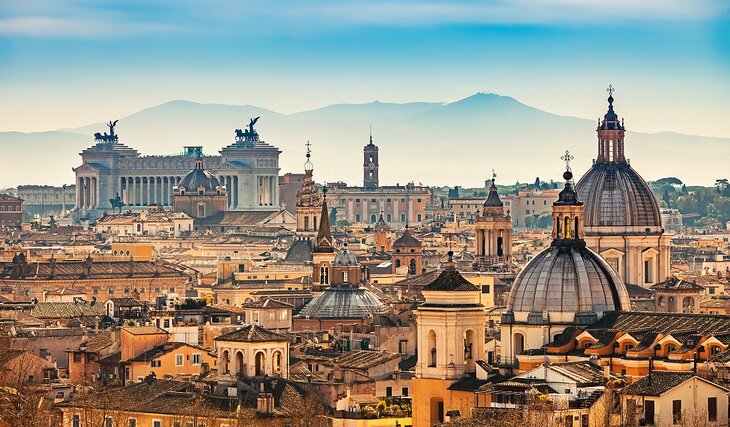
A word of caution: try to vary your experiences as you explore Rome, so that you don't visit too many ancient sites or churches in a row. And intersperse these more serious attractions with a few that are simply tourist icons: the Spanish Steps and that place all tourists must go to toss in their coin, the Trevi Fountain.
Rome is so big that it can overwhelm you, so even the most devoted sightseer needs to take some time to kick back and enjoy la dolce vita in a park or sidewalk café.
You'll be able to choose the best places to visit with this handy list of the top attractions in Rome.
1. The Colosseum and the Arch of Constantine
2. vatican city, 3. the pantheon, 4. roman forum, 5. trevi fountain, 6. vittorio emanuele ii monument, 7. centro storico & the spanish steps, 8. via del corso, rome's shopping street, 9. santa maria maggiore, 10. piazza navona, 11. piazza del popolo & santa maria del popolo, 12. palatine hill, 13. villa borghese gallery and gardens, 14. castel sant'angelo national museum, 15. trastevere, 16. capitoline museum, 17. baths of caracalla, 18. san giovanni in laterano (basilica of st. john lateran), 19. the catacombs and via appia antica (appian way), 20. palazzo doria pamphilj, 21. basilica of san clemente, 22. domus aurea: nero's golden house, 23. terme di diocleziano (baths of diocletian national museum), where to stay in rome for sightseeing, tips and tours: how to make the most of your visit to rome, rome, italy - climate chart, more things to see and do in rome.

As the Eiffel Tower is to Paris, the silhouette of the Flavian Amphitheatre is to Rome. The largest structure left to us by Roman antiquity , the Colosseum still provides the model for sports arenas - present-day football stadium design is clearly based on this oval Roman plan.
The building was begun by Vespasian in AD 72, and after his son Titus enlarged it by adding the fourth story, it was inaugurated in the year AD 80 with a series of splendid games. The Colosseum was large enough for theatrical performances, festivals, circuses, or games, which the Imperial Court and high officials watched from the lowest level, aristocratic Roman families on the second, the populace on the third and fourth.
Beside the Colosseum stands the Arch of Constantine , a triumphal arch erected by the Senate to honor the emperor as "liberator of the city and bringer of peace" after his victory in the battle of the Milvian Bridge in 312.
Lines are long and move slowly, so you can save time by joining the Skip the Line: Ancient Rome and Colosseum Half-Day Walking Tour and have a knowledgeable guide, as well.
Author's Tip: For an unforgettable experience, especially in the heat of mid-summer, visit the Colosseum on a special night tour. Not only is it cooler then, but the monument is magical with its interior bathed in golden light.
- Read More: Visiting the Colosseum: Highlights, Tips & Tours
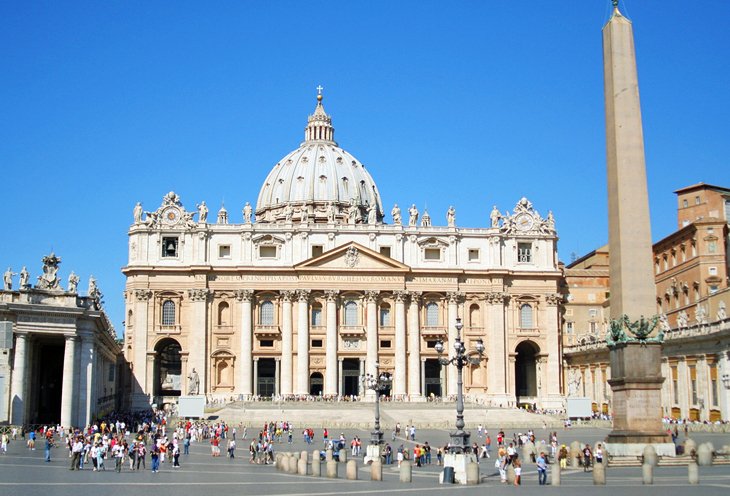
The Vatican is the smallest independent state in the world , with an area of less than half a square kilometer, most of it enclosed by the Vatican walls.
Inside are the Vatican palace and gardens, St. Peter's Basilica , and St. Peter's Square , an area ruled by the Pope, supreme head of the Roman Catholic Church. This compact space offers a lot of things to see, between its museums and the great basilica itself.
Inside St. Peter's Basilica is Michelangelo's masterpiece, Pieta , along with statuary and altars by Bernini and others.
The unquestioned highlight of the Vatican museums is the Sistine Chapel , whose magnificent frescoed ceiling is Michelangelo's most famous work.
In the Vatican Palace are the Raphael Rooms ; the Borgia Apartments ; the Vatican Library , and a number of museums that include the Picture Gallery, Museum of Secular Art, Etruscan Museum, and others. The collections you can see in these cover everything from papal coaches to 20th-century art reflecting religious themes.
Ticket lines for the Vatican's attractions are incredibly long, and you can spend several hours waiting in line. To save time, purchase a Skip the Line: Vatican Museums with St. Peter's, Sistine Chapel, and Small-Group Upgrade tour in advance. This three-hour tour allows you to bypass the long lines and walk straight into the museums with a knowledgeable guide. Headsets are provided, and you can choose from several different departure times or upgrade to an evening or small-group tour.

The Pantheon - the best-preserved monument of Roman antiquity - is remarkably intact for its 2000 years. This is despite the fact that Pope Gregory III removed the gilded bronze roof tiles, and Pope Urban VIII ordered its bronze roof stripped and melted down to cast the canopy over the altar in St. Peter's and cannons for Castel Sant'Angelo.
The Pantheon was rebuilt after damage by fire in AD 80, and the resulting brickwork shows the extraordinarily high technical mastery of Roman builders. Its 43-meter dome, the supreme achievement of Roman interior architecture , hangs suspended without visible supports – these are well hidden inside the walls – and its nine-meter central opening is the building's only light source.
The harmonious effect of the interior is a result of its proportions: the height is the same as the diameter.
Although the first Christian emperors forbade using this pagan temple for worship, in 609 Pope Boniface IV dedicated it to the Virgin and all the Christian martyrs, and since then, it has become the burial place of Italian kings (Victor Emmanuel II is in the second niche on the right) and other famous Italians, including the painter, Raphael.
Author's Tip: If you visit the Pantheon on a rainy day, be careful of the floor in the center. There is no umbrella over the hole in the roof, and the floor can get very slippery when wet.
- Read More: Visiting the Pantheon in Rome: Highlights, Tips & Tours
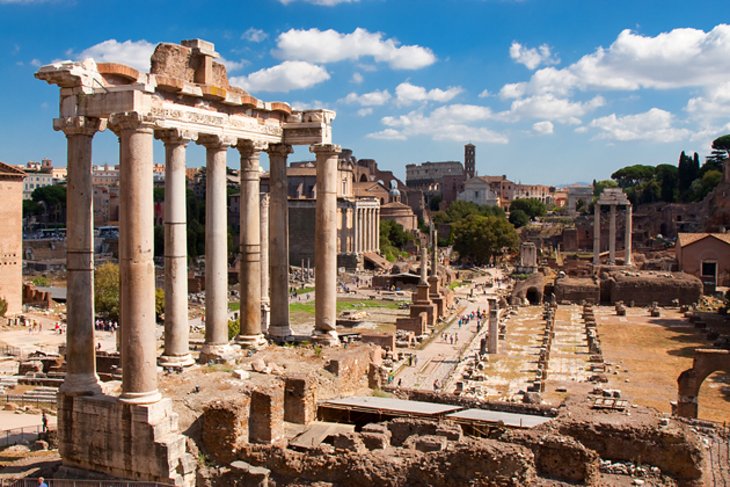
Walking through the forum, now in the middle of a throbbing modern city, is like stepping back two millennia into the heart of ancient Rome. Although what survives of this center of Roman life and government shows only a small fraction of its original splendor, the standing and fallen columns, its triumphal arches, and the remains of its walls still impress, especially when you consider that for centuries, the history of the Forum was the history of the Roman Empire and of the Western world.
Roman political and religious life was centered here, along with the courts, markets, and meeting places. After the seventh century, the buildings fell into ruin, and churches and fortresses were built amid the ancient remains. Its stones were quarried for other buildings and it was not until the 18th and 19th centuries that systematic excavations brought the ancient buildings to light from under a 10-meter layer of earth and rubble.
Highlights of the Roman Forum are the Temple of Antoninus Pius, the Temple of Castor and Pollux, the Temple of Saturn, the Arch of Septimus Severus, the Curia, the Temple of Vesta, and the Arch of Titus.
Tip for Parents: If you're traveling in Rome with children, unless they are fascinated by the Romans, the Forum might be a place best seen from above, instead of by walking through its five acres of largely ruined buildings. It is one of Rome's most popular and important tourist attractions, but it's a lot for kids to take in and it doesn't have the lure of the Colosseum's tales of lions and gladiators.
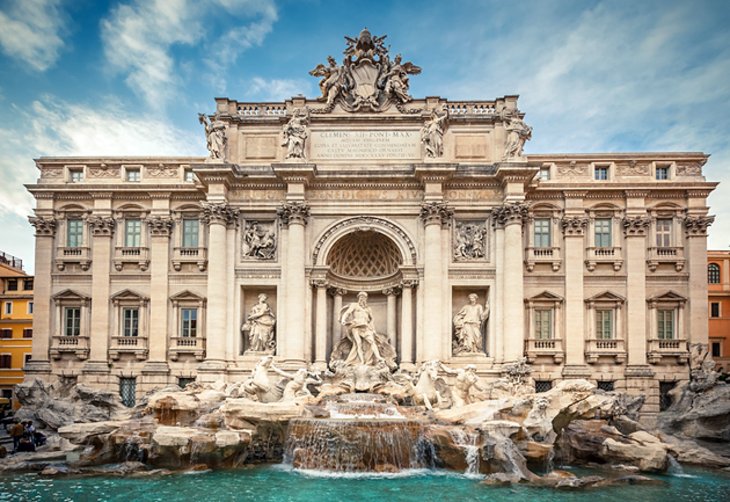
One of the city's most popular tourist attractions, this 17th-century masterpiece has been immortalized in films until it is almost a required visit. Throwing a coin (not three) into the Trevi Fountain (Fontana di Trevi) is a tradition that is supposed to assure your return to Rome.
Rome's largest fountain, Fontana di Trevi is supplied by an aqueduct originally constructed by Agrippa, the great art patron of the first century BC, to bring water to his baths. The fountain was created for Pope Clement XII between 1732 and 1751 by Nicolò Salvi, and built against the rear wall of the palace of the Dukes of Poli.
It depicts the sea god Oceanus (Neptune), with horses, tritons, and shells. The water swirls around the figures and the artificial rocks and collects in a large basin, always filled with coins.
What happens to all that money? Twice a year it is gathered using long-handled brushes, and donated to Caritas, Rome's Catholic charity.
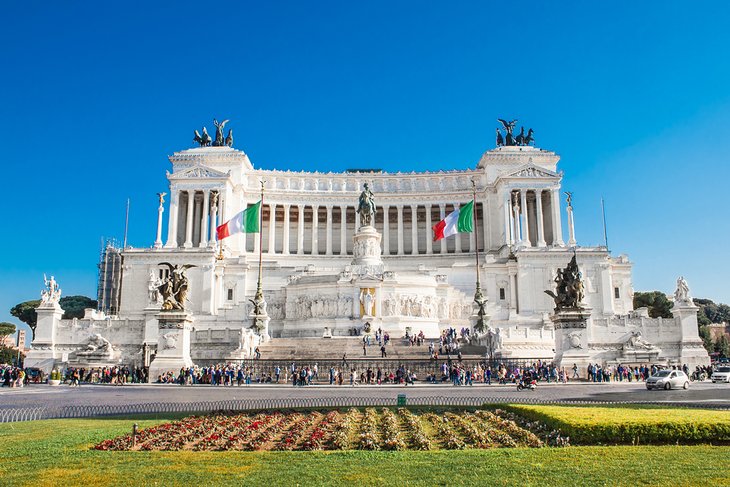
It's ironic that this grandiose monument, considered one of the national symbols of Italy, is rarely admired by Romans, who liken it to a wedding cake or a giant typewriter. Like it or not, the vast neo-classical structure crowns Capitoline Hill, the symbolic center of ancient Rome, overlooking the later city across Piazza Venezia.
Built between 1885 and 1935, it is a monument to King Vittorio Emanuele II, the first king of the unified Italy, represented here in an equestrian statue. Italy's tomb of the unknown soldier is here, along with a museum of the Italian unification. A lift will take you to the topmost terrace for 360-degree views of Rome.
Address: Piazza Venezia, Rome
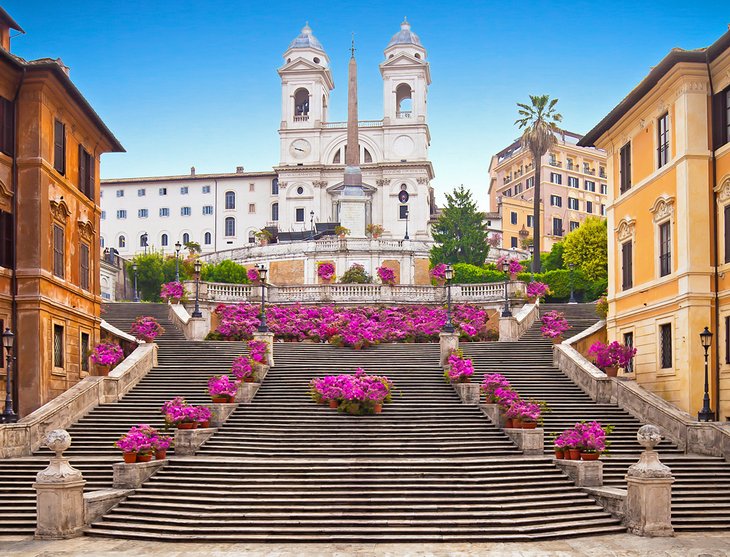
Take a look at a Rome tourist map, and you'll see one area so filled with things to do that it's hard to read the street names. This is the Centro Storico, the historic center of Rome , with so many art-filled churches, resplendent palaces, and lively squares that you could spend your whole vacation strolling its ancient streets and lanes.
Spend some time just to absorb the neighborhood's atmosphere instead of going from one of its must-see sights to the next. Along with Piazza Navona , the Trevi Fountain , and the Basilica of Santa Maria Maggiore , stop in less well-known churches, such as Santa Maria del Popolo, where you'll find works by Bernini and Caravaggio.
Pause at the Spanish Steps, the flight of irregular stairs and landings that lead up to the French church of Trinità dei Monti. The stairs take their name from Piazza di Spagna , the plaza at their base and one of Rome's most typical squares. The stairs have long been a favorite haunt of tourists.
You can no longer channel your inner Audrey Hepburn and eat gelato on the steps as she did in Roman Holiday . Sitting or eating on the steps is banned to protect them after a complete cleaning and restoration, and the ban is enforced.
The boat-shaped fountain at the foot of the Spanish Steps is known as the Barcaccia and was created by Pietro Bernini, father of the great Baroque architect Gian Lorenzo Bernini.
Via Condotti , leading southwest from Piazza di Spagna, is Rome's most fashionable shopping street , where the Caffè Greco is famous for the artists, writers, and musicians who have frequented it.
Address: Piazza di Spagna, Rome
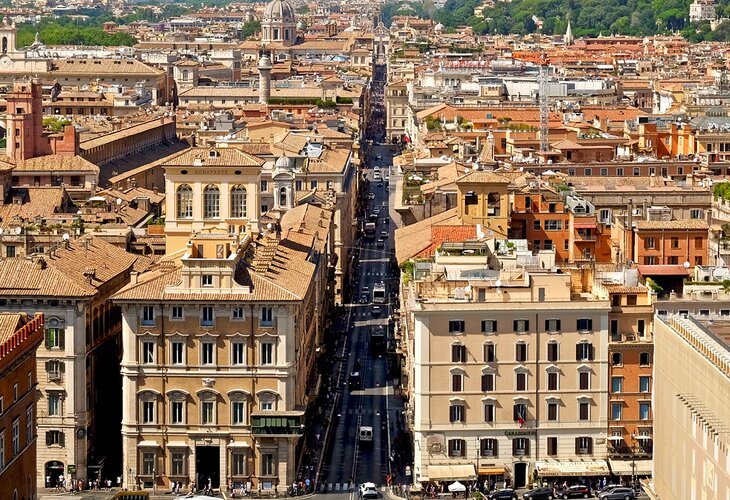
Marking a straight line from Piazza the Piazza Venezia to Piazza del Popolo, Via del Corso is Rome's Main Street . Lined with shops and places to eat, and a few palaces housing art museums, including the magnificent Palazzo Doria Pamphilj. Work is underway to restore and re-design the century-old landmark Alberto Sordi Gallery, which will reopen as Agorà, with fewer shops and more public space for arts and entertainment.
While the shops are mostly name brands, you'll find some designer boutiques here and on the radiating side streets. Not all of Italy's fashion comes from Milan's catwalks, and fashionistas will find more high-end boutiques and prestigious names on streets around Piazza di Spagna, especially Via Venizia and Via dei Condotti .
Between Piazza del Popolo, at the end of Via del Corso, and Piazza di Spagna, look for antique shops and art galleries on Via del Babuino . To mix charm and cinema history with shopping, and find small shops and galleries on the parallel Via Margutta .
Note to Movie Fans: Federico Fellini lived on Via Margutta and Gregory Peck's apartment scenes in Roman Holiday were filmed at No. 51.
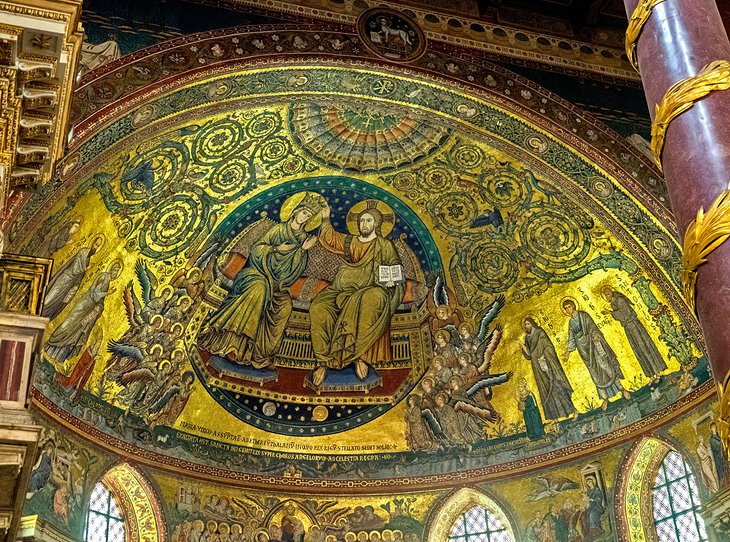
One of the most majestic of the churches in Rome , Santa Maria Maggiore has stood here since the fourth-century Pope Liberius had a vision of the Virgin directing him to build a church where snow fell the following day. Although it was August, snow did fall on the Esquiline hill the next morning, so here the great basilica was built.
Mass has been celebrated here every day since the fifth century. The three aisles of its 86-meter-long interior are separated by 40 columns of marble and four of granite, and the apse added in the 13th century is lined with mosaics of Old and New Testament themes, masterpieces of Rome's famous mosaic artists.
Rome's oldest mosaics, as old as the fourth century, decorate the upper walls, and the floor is inlaid with colored stone in the style of the expert 12th-century artisans of the Lake Como region. The first gold to reach Italy from the Americas shines on the coffered ceiling. Two popes are buried here; it's one of Rome's four papal basilicas, an important place of pilgrimage.
Author's Tip: Although admission to Rome's churches is free, you may need to put a euro in the meter to illuminate some artworks or chapels. Keep some coins handy for a better look at the mosaics in Santa Maria Maggiore. It is also a nice gesture to put a few coins in the offering boxes to help the churches maintain their priceless treasures.
Address: Piazza di Santa Maria Maggiore, Rome
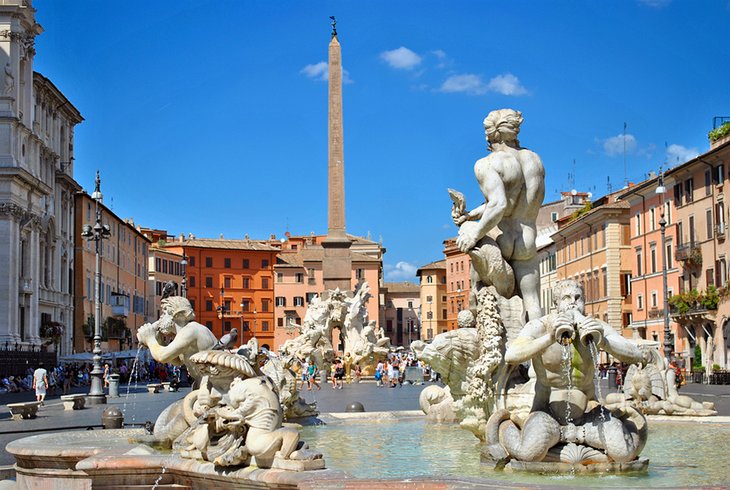
One of Rome's most characteristic Baroque squares, Piazza Navona still has the outline of the Roman stadium built here by Emperor Domitian. It was still used for festivals and horse races during the Middle Ages, and was rebuilt in the Baroque style by Borromini, who also designed the magnificent series of palaces and the church of Sant'Agnese, on its west side.
Its facade, campanile, and dome highlight the way Baroque architecture weaves convex and concave surfaces, gables, windows, columns, and piers into a unified design. In the crypt of Sant'Agnese are Alessandro Algardi's 1653 The Miracle of St. Agnes and the remains of a Roman mosaic floor. Sant'Agnese provided a model for Baroque and Rococo churches in Italy and elsewhere.
Although Borromini designed the square and its surrounding facades, it was his archrival, Bernini, who created its centerpiece, the beautiful Baroque fountain, Fontana dei Fiumi . The spirited fountain represents the four rivers then thought to be the largest on each of the known continents, with figures personifying the Nile, Ganges, Danube, and Rio de la Plata around the large basin, each accompanied by plants and animals of their respective regions.
The two other fountains in the square are the 16th-century Fontana del Moro in front of the Palazzo Pamphili, erected by Giacomo della Porta, and the 19th-century Fontana del Nettuno with its figure of Neptune. Today, the square is filled with Romans, tourists, street artists, musicians, souvenir kiosks, cafés, and during December, one of Rome's best Christmas markets.
Nearby, between the Piazza and the Pantheon, the church of San Luigi dei Francesi contains three major paintings by Caravaggio from the late 16th century, including one of his most famous, The Calling of St. Matthew. No information about the paintings is available in the church, but you can download an audio guide in English on the San Luigi dei Francesi website. The church itself is worth seeing for its elaborate ceiling and inlaid marble floors. Like others in Rome, the church is free to enter
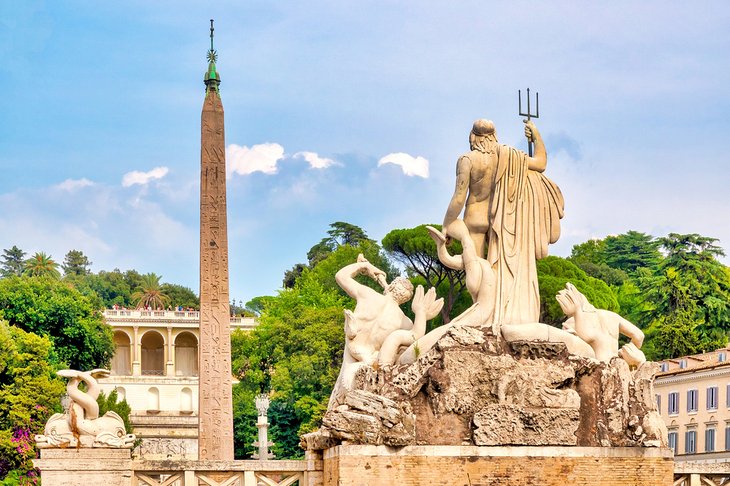
Symmetrically situated at the apex of a triangle of streets that include Via Corso, Rome's main shopping street, Piazza del Popolo was designed in the early 19 th century as the northern entrance to the city center. At its center, the Egyptian obelisk, called Flaminio, rises above a fountain, where four white marble lions spout fans of water into four round travertine pools.
Facing one side like mirror images at either side of Via della Corso are the twin churches of Santa Maria dei Miracoli and Santa Maria in Montesanto, and at the opposite side of the grand piazza is the Augustinian Basilica of Santa Maria del Popolo.
Inside, you'll find Pinturicchio frescoes and two tombs by Andrea Sansovino in the choir, and two beautiful chapels. The Chigi Chapel was designed by Raphael in 1515, and the Cesari Chapel holds two important Caravaggio paintings.
Next to the basilica, climb the steps to the Pincio Terrace for views down onto the piazza and across the city of Rome.
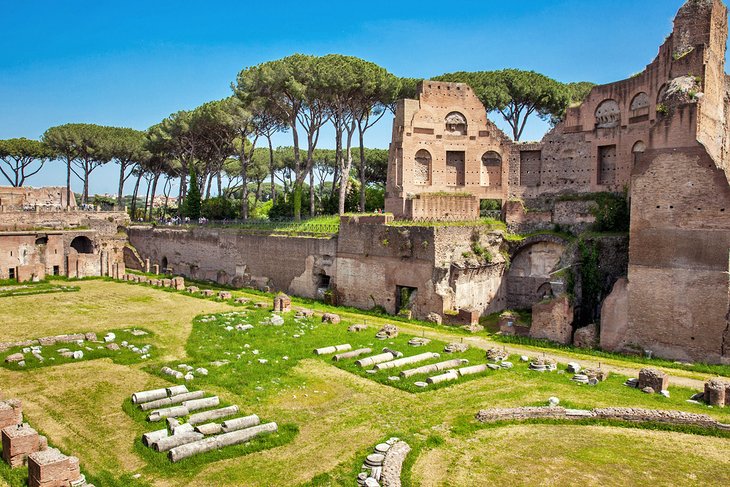
Strategically set 50 meters above the Tiber, the Palatine Hill shows evidence of Rome's earliest settlement: rock cuttings found in front of the Temple of Cybele show human activity as long ago as the ninth century BC. Later, this was the site chosen by the emperors and great aristocratic families for their palaces.
The Farnese Gardens were laid out on the hill in the 16th century for Cardinal Alessandro Farnese, a pleasure park of terraces, pavilions, lawns, flowerbeds, trees, and fountains designed as a kind of stage-setting for social gatherings.
Highlights of the Palatine Hill are the House of Livia (Augustus' wife), the semi-subterranean Cryptoporticus , Domus Flavia , Domus Augustana, and most imposing of all, the Baths of Septimius Severus. The Palatine Hill is a lovely place to explore, combining a park with magnificent and impressive ruins of ancient Rome.
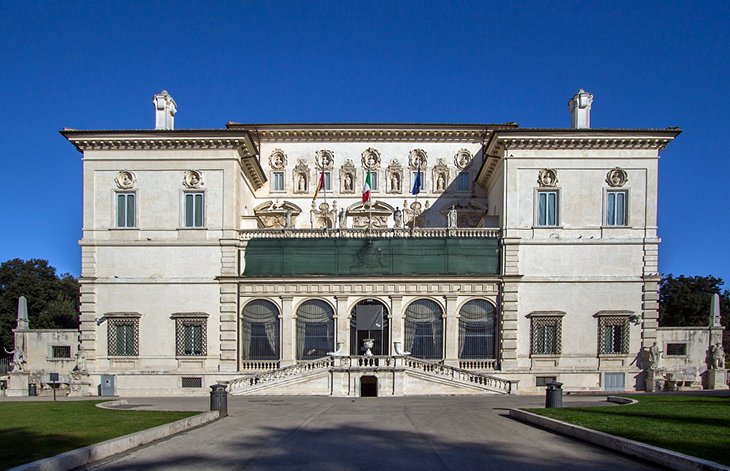
One of Rome's largest parks, the Borghese Gardens contain multiple attractions that include two museums, the most prominent of which is the Villa Borghese. Built as a party villa and to house the Borghese art collection, the gallery contains paintings, sculptures, mosaics, and reliefs, most from the 15th to the 18th century, and include works by Raphael, Titian, Caravaggio, Bernini, Dürer, and Rubens .
Elsewhere in the park, Villa Giulia was built as a summer residence for the 16th-century Pope Julius III and houses the Etruscan Museum . More villas are from the world exposition that was held in Rome in 1911.
The park is an English-style landscape garden, with walking paths and ponds where you can rent row boats. You can also rent bikes or a surrey to explore the park. There is a good zoo, Bioparco di Roma , with naturalized enclosures and a miniature trail connecting its various sections. A number of its attractions will appeal to children, including playgrounds, weekend pony rides, and occasional puppet shows.
Many of its attractions will appeal to children , including playgrounds, weekend pony rides, and occasional puppet shows, making it one of the most popular things to do in Rome for families .
One of the secrets of the Borghese Gardens is the replica of Shakespeare's Globe Theatre, where you can watch opera performances or Shakespeare plays. Plays are always in Italian, but an occasional opera is in English. You can rent a cushion and sit on the floor or you can sit in the balconies that ring the interior.
Address: Piazzale del Museo Borghese, 5
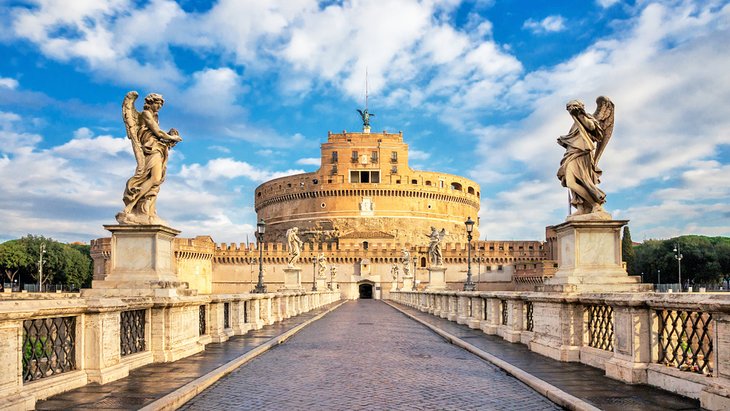
Begun in AD 135 as a mausoleum for the Emperor Hadrian and his family, Castel Sant'Angelo is a massive drum-shaped structure overlooking the Tiber near the Vatican. Over the millennia of its existence, Castel Sant'Angelo has been used as a papal residence and a fortress, and more recently as a National Museum.
In AD 271, Emperor Aurelian took advantage of its position guarding the northern approaches to the city and incorporated it into his new system of walls surrounding the city. As a bastion, it protected the city from barbarian attacks, and by the Middle Ages had become a substantial fortress. In times of peril, popes fled here across a secret elevated corridor, the Passetto di Borgo , and stored their most precious riches in the castle's treasury.
Visitors reach the castle across a pedestrian bridge lined with statues of angels (by Bernini), and ascend to its five floors on a spiral ramp. At its various levels are prison cells, a large collection of weapons, and splendidly decorated papal apartments covered in Renaissance frescoes. At the top is a terrace with stunning views of the city.
Address: Lungotevere Castello 50, Rome
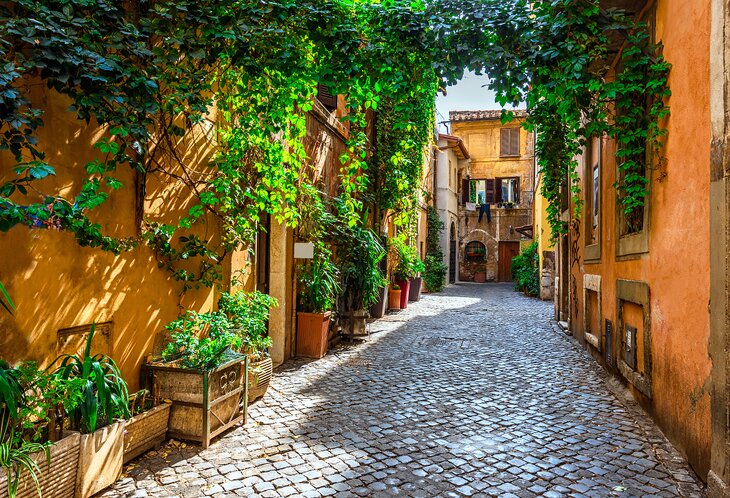
Across the Tiber River and off the most popular tourist routes, Trastevere feels like an earlier Rome, with its medieval lanes and narrow alleys . You'll find bits of Roman stonework in its old buildings, and occasional inscriptions that remind you that this was for three centuries the Jewish Ghetto, its gates closed and guarded at night.
Today it is a charming neighborhood with two outstanding churches that are rarely on tourist itineraries. In the third century, before Rome's Jewish population gravitated to this side of the river, Santa Maria in Trastevere was one of the first places where Christians could worship except in secret.
Renovated several times, the last in the Baroque period, the church interior is decorated with patterned marble floors, a gold-washed coffered ceiling, and exceptional medieval mosaics. Also with good mosaics, and a fine 13 th -century fresco, Santa Cecilia in Trastevere hides the foundations of a Roman home.
Author's Tip: It's no secret that Trastevere is a good place to find restaurants serving authentic Roman dishes, but you'll find them less crowded than those in the popular tourist areas.
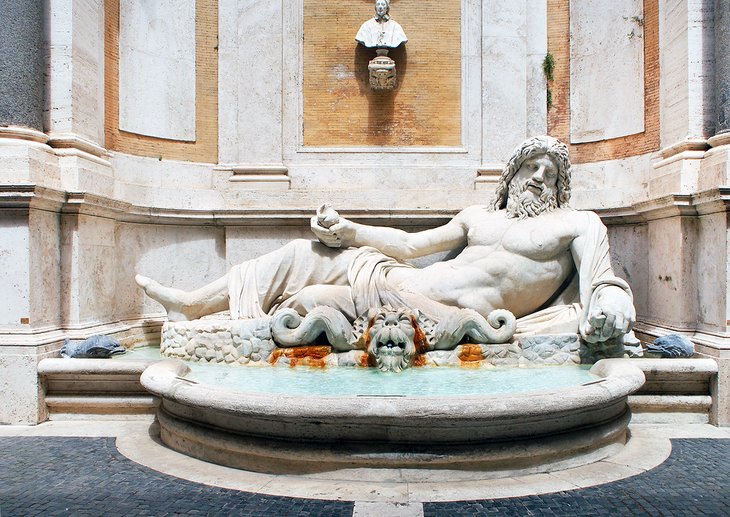
Two palaces on Piazza del Campidoglio house Europe's oldest public collection of art, founded in 1471. Primarily devoted to sculptures from across the ancient world, the highlights of the Capitoline Museum treasures include the realistic Hellenistic bronze Boy with a Thorn ; Capitoline Venus , from a 4 th -century BC original by Praxiteles; a 4.24-meter-tall Roman equestrian statue of Marcus Aurelius; a Roman sculpture of the Dying Gaul ; and the Capitoline She-Wolf , an Etruscan work from the 6th century BC.
More "modern" sculptures include a head of Medusa, by the 17 th -century Baroque sculptor Gian Lorenzo Bernini. Although the Capitoline Museum is best known for its outstanding collection of classical sculptures, its Capitoline Picture Gallery exhibits paintings by Titian, Veronese, and Rubens, along with Caravaggio's compelling John the Baptist.
Address: Piazza del Campidoglio, Rome
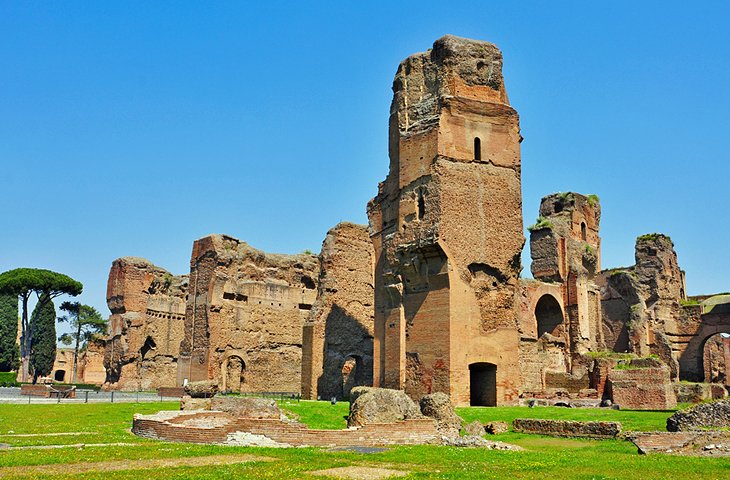
Completed by Caracalla in 216, these were much more than public baths. They were a complete sports center, with hot and cold baths, a swimming pool, dry and steam saunas, gymnastics and sports facilities, social rooms, gardens, libraries, hairdressers, and shops.
The massive and imposing structure covered an area of 300 square meters, a complex of gigantic halls whose domes and vaulting were supported by huge columns and piers. It could accommodate 1,500 people at a time. The floors and walls were covered with marble, mosaics, and frescoes; even in ruin, their splendor is still evident.
Address: Via delle Terme di Caracalla 52, Rome
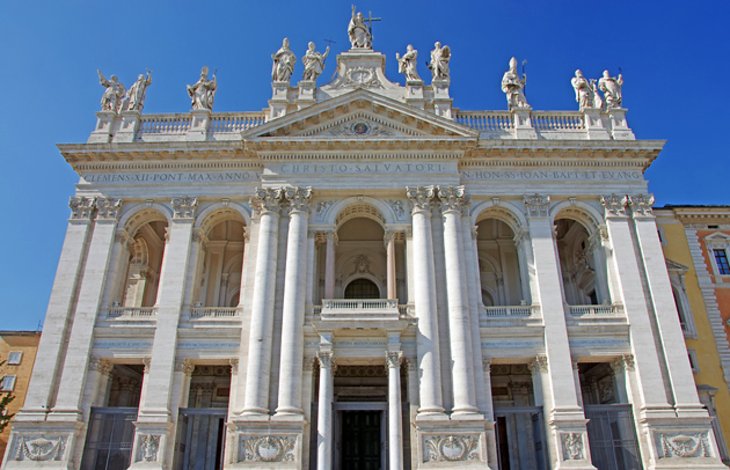
As you might expect for the episcopal church of the Pope, St. John Lateran is one of Rome's most impressive churches. After centuries of alterations, it still retains its original form from the age of Constantine, when it was built.
Its façade, by contrast, is a purely Baroque embellishment and a fine example of that period. Along with the mosaics in the apse, be sure to notice the beautiful 16th-century wooden ceiling. If the octagonal baptistery, San Giovanni in Fonte , looks a bit familiar, it's because it provided the model for later ones throughout Europe.
Built by Constantine, it is the world's oldest Christian baptistery. Across the piazza, in the church of the Scala Santa, is the Holy Staircase, 28 steps believed to have been brought to Rome in the fourth century by St. Helen, from Pilate's palace in Jerusalem.
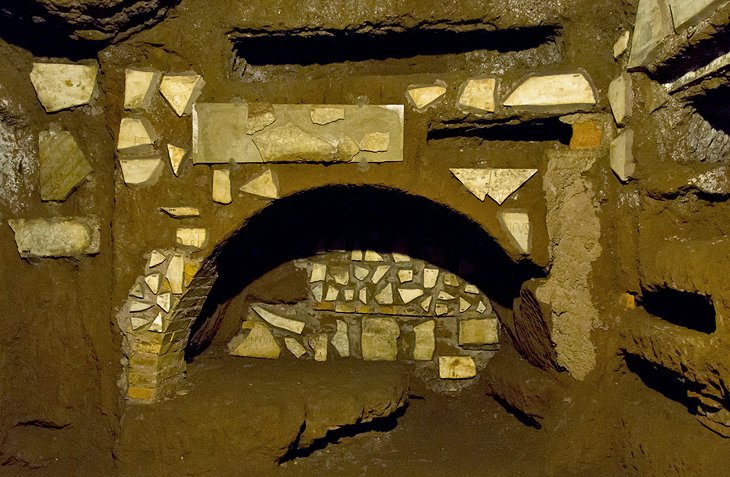
The Catacombs of San Callisto (St. Calixtus) and San Sebastiano , both underground burial places in the Via Appia Antica, are extensive — the San Callista Catacomb fills an area of 300 by 400 meters — with intricate multi-layered networks of passages and chambers carved into the soft tufa. In addition to the tombs, St. Calixtus has six sacramental chapels, constructed between 290 and 310, with both pagan and early Christian wall paintings.
In the Papal Crypt are the tombs of most of the martyred Popes of the third century identified by Greek inscriptions. San Sebastiano, one of Rome's seven pilgrimage churches, was built in the fourth century on the site of old cemeteries and catacombs that, along with the foundations of a Constantinian basilica, can be explored.
Tomb chambers are on several levels with fine paintings, stucco decorations, and inscriptions dating to the first century AD. Although venerated remains are thought to have been brought here for safekeeping during persecutions, these were cemeteries, not hiding places for Christians.
A little west of the Via Appia Antica, not far from the catacombs of San Callisto, the Catacombs of Domitilla are the largest and among the most impressive in Rome, with 15 kilometers of underground chambers and passages and a complete subterranean basilica.
Dedicated to the martyred saints entombed there, Nereus and Achilleus, the basilica was a major pilgrimage destination until the Middle Ages. More than 80 painted tombs and a second-century fresco of The Last Supper survive in its galleries.
Outside the Porta San Sebastiano, the Arch of Drusus is near the beginning of the Via Appia Antica, one of the oldest and most important of the Roman highways, built around 300 BC and extended to the port of Brindisi about 190 BC.
Running parallel with the road are the ruins of some of the aqueducts that supplied the city with water, and among the cypresses along its sides are remains of tombs belonging to aristocratic Roman families. The most prominent of these is the first-century tomb of Caecilia Metella and her husband.
Address: Via Appia Antica, Rome
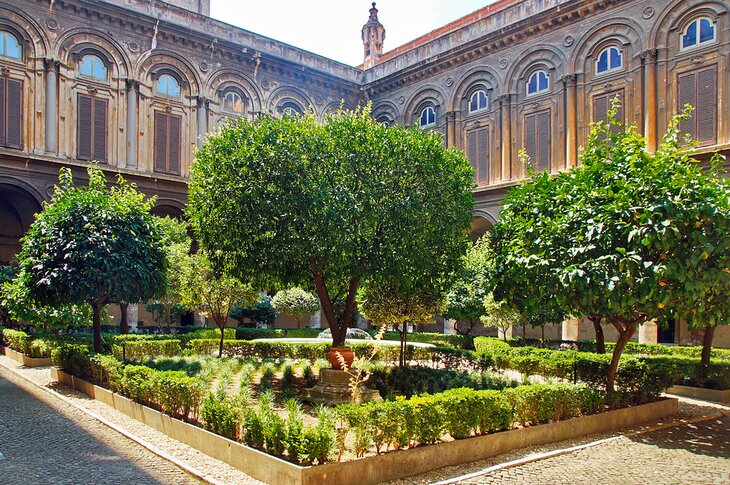
Rome's finest private collection of art is displayed in the magnificent Baroque galleries, state rooms, and chapel of the Palazzo Doria Pamphilj. Representing works by European masters from the 15 th through the 18 th centuries, the collections include paintings by Filippo Lippi, Brueghel the Elder, Correggio, and Raphael, along with major works by Caravaggio ( Rest in the Flight into Egypt) and Titian ( Salome with the Head of John the Baptist).
Velázquez's Portrait of Innocent X is one of the collection's highlights. Another image of the same Pope is a sculpture by Bernini. The palace itself almost outshines its contents, with frescoed ceilings and Baroque decoration; a good audio guide in English enlivens the tour. The gardens are beautiful, with an intricately patterned parterre with labyrinth elements.
Address: Via del Corso 305, Rome
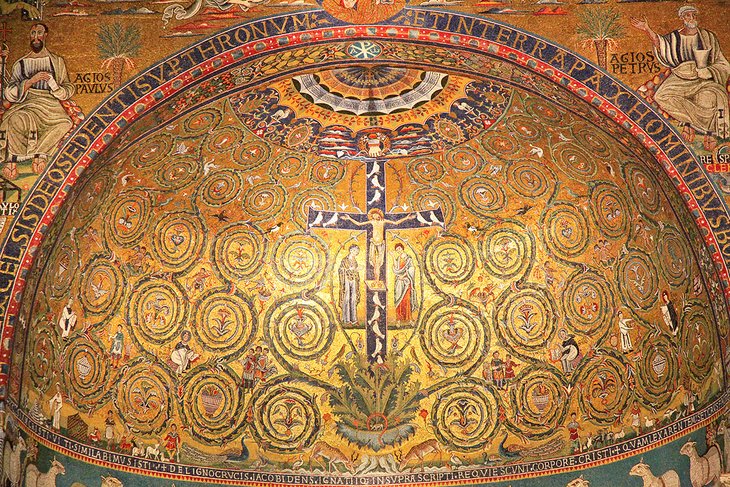
One of Rome's oldest churches and with the city's most beautifully decorated apse, covered in mosaics of Old and New Testament scenes, San Clemente has a further fascination: the multiple layers of its history as each era built upon the last.
You can descend from the 12 th -century church into a previous church, a 4 th -century basilica with Romanesque frescoes of New Testament scenes. Below that are the excavated foundations of a Roman home from the 2 nd century AD, with a shrine to the sun god Mithra, with a carved relief on the altar. From the foundations of the house, you can walk on the ancient streets of this former Roman neighborhood.
But do take time to look around the upper church, to see the mosaics, the inlaid marble floors, and the early Renaissance frescoes by Masolino in the St. Catherine's Chapel.
Address: Via San Giovanni in Laterano 108, Rome
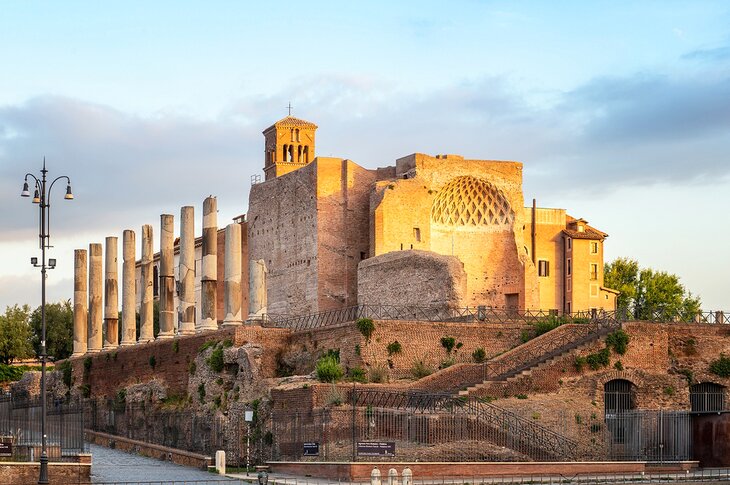
In July of 64 CE, a six-day fire destroyed almost three-fourths of the city. The cruel and unpopular emperor Nero took advantage of the cleared land to build a palace of unheard-of proportions, the Domus Aurea, or Golden House. Rooms were lined in rare marble and elaborately decorated in gold and precious stones.
The palace was never finished, and Nero's successors, attempting to erase all memory of the hated ruler and his reign, buried it, and Rome grew over it. Excavations continue to disclose more of its splendors, and you can tour the active archaeological site to see the halls and rooms that have been uncovered, some with excellent frescoes.
With the help of a video outlining the history and virtual reality technology that recreates the atrium and one hall , you can get a sense of what the palace looked like in Nero's time. Both are included in tours.
Tip: Even on the hottest days, bring something with long sleeves, as the underground excavations site is quite cold year-round.
Historical Note: Did Nero really fiddle while Rome burned? Although he took advantage of the destroyed city to build his extravagant villa, and there was disgruntled mumbling at the time that he had ordered the fire set to clear the land, no historical evidence or contemporary account mentions his playing any musical instrument.
Address: Via della Domus Aurea, Rome
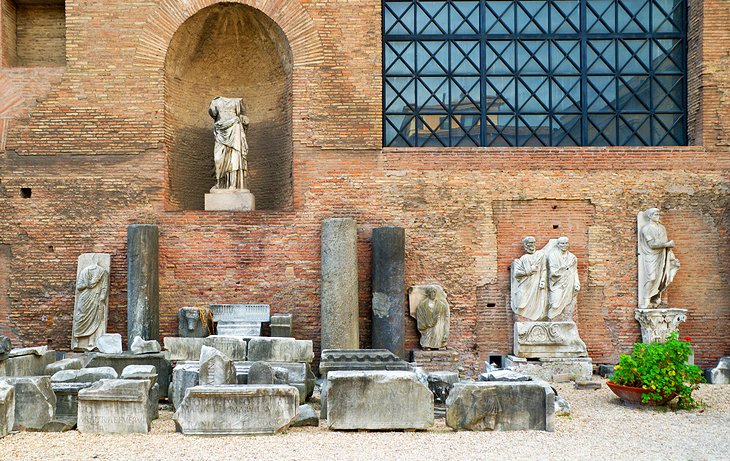
Diocletian's baths were so enormous that today, they contain two churches, large parts of a Carthusian monastery and a major museum. Michelangelo used the vast tepidarium (hot baths) as the shell for his church of Santa Maria degli Angeli , and the Museo Nazionale Romano , Rome's National Museum, fills another section with treasures of antiquity: Greek and Roman sculpture, pre-Christian and later sarcophagi, and beautiful mosaics and frescoes.
The late-16th-century church of San Bernardo alle Terme was built in a rotunda at the corner of the baths; its dome is like that of the Pantheon, but only half its size.
While Rome's main tourist attractions don't exactly cluster, most of the major ones are within a 20- to 30-minute walk of each other, so several areas are convenient for sightseeing. The Monti neighborhood is perhaps the most central to the Forum, Colosseum, Trevi Fountain, and even the Spanish Steps and Borghese Gardens. Here are some highly rated hotels in Rome's best locations for sightseeing:
Luxury Hotels :
- Palazzo Manfredi - Relais & Chateaux is next to the Colosseum, and you can overlook it while enjoying breakfast in the rooftop restaurant.
- Boutique Hotel Campo de Fiori has a rooftop garden overlooking the colorful daily market in one of Rome's most traditional neighborhoods, near the Pantheon and an easy walk from Palatine Hill and the Vatican.
- Two blocks from the Colosseum, Hotel Capo d'Africa is in a neighborhood filled with small restaurants.
Mid-Range Hotels:
- The four-star Mercure Roma Centro Colosseo is an easy walk from the Colosseum, which you can see from the hotel's rooftop swimming pool and from some of the guest rooms.
- In Monti, close to both the Colosseum and Forum, Hotel Fori Imperiali Cavalieri is surrounded by restaurants and shopping.
- Opposite the Opera House in Monti, iQ Hotel Roma has a covered rooftop terrace and modern décor.
Budget Hotels:
- Amid restaurants and shops in Monti, between the Forum and opera house, Hotel Artorius is not adjacent to any major attractions, but lies within a 20- to 30-minute walk from the Forum, Colosseum, Trevi Fountain, Vittoriano, and museums.
- Also in the lively Monte neighborhood, and an easy walk from the Colosseum and other attractions of ancient Rome, Hotel Grifo offers a rooftop terrace and free breakfast.
- On the west bank of the Tiber, south of Vatican City, Trastevere is one of the city's most colorful neighborhoods. Although Trastevere has several small B&Bs, Cassiodoro is one of its few hotels, surrounded by traditional restaurants and shops.
- Sightseeing Tour by Bus : For maximum flexibility while you're seeing all the top attractions, sign up for the Rome Hop-On Hop-Off Sightseeing Tour on an open-air double-decker bus. Accompanied by audio commentary, this convenient ticket covers all the top sights, with eight different stops, and you can hop on and off at your favorite attractions. You can choose a tour that's valid for either 24 or 48 hours and upgrade to packages that include time-saving skip-the-line admission to attractions like Palatine Hill, the Colosseum, and the Roman Forum.
- Segway Tour: Another way to see the top sights without worrying about navigating your way around the city is on the Rome Segway Tour . Included in this three-hour excursion are a brief orientation session, helmets, wet weather jackets (if needed), and audio commentary. Meet your guide near Piazza Venezia and see the sights of Ancient Rome, including the Colosseum, the Roman Forum, and Circus Maximus, learning all about them as you zoom around the city.
- Gladiator Experience : If you've always wondered what it's like to brandish a sword like Spartacus, consider signing up for the Roman Gladiator School: Learn How to Become a Gladiator experience on the Appian Way, near the Colosseum. This two-hour private lesson is suitable for anyone aged six years and older and includes entrance to the Gladiator School of Rome Museum as well as clothing and weapon hire.
- Tivoli Day Trip : Organized tours are a great way to explore the attractions in the beautiful countryside around Rome. You can relax and let a professional guide do the work without the hassle of driving, finding your way, and parking. On the Tivoli Day Trips from Rome: Villa d'Este and Hadrian's Villa tour, you can explore two World Heritage-listed historic villas, built as vacation homes for the Roman elite, as well as their gorgeous gardens. The tour includes transportation in a comfortable coach, villa admission, and headsets so you can easily hear the guide.
- Pompeii Day Trip : Another popular excursion is the Pompeii Day Trip from Rome . On this full-day tour, you can hike to the crater of Mt. Vesuvius (in summer) or visit the National Archeological Museum of Pompeii (November 16 through March 31), as well as see the sights of Pompeii. Entrance fees and lunch are included.
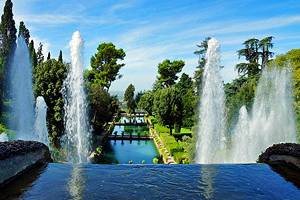
Where to Go near Rome: When you have seen Rome's ancient sites, you'll want to explore some of the city's surroundings. The town of Tivoli lies 30 kilometers east of Rome, with Hadrian's Villa and one of the most beautiful gardens in Italy .
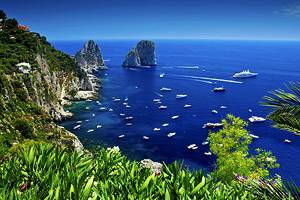
Places to Visit from Rome: In just over an hour by train, you can step into the exuberant street life of the vibrant city of Naples . From here, you are only a short ferry ride from the idyllic island of Capri , across the Bay of Naples. Or take a train the short distance to the ancient city of Pompeii , under the still smoldering cone of Mt. Vesuvius.
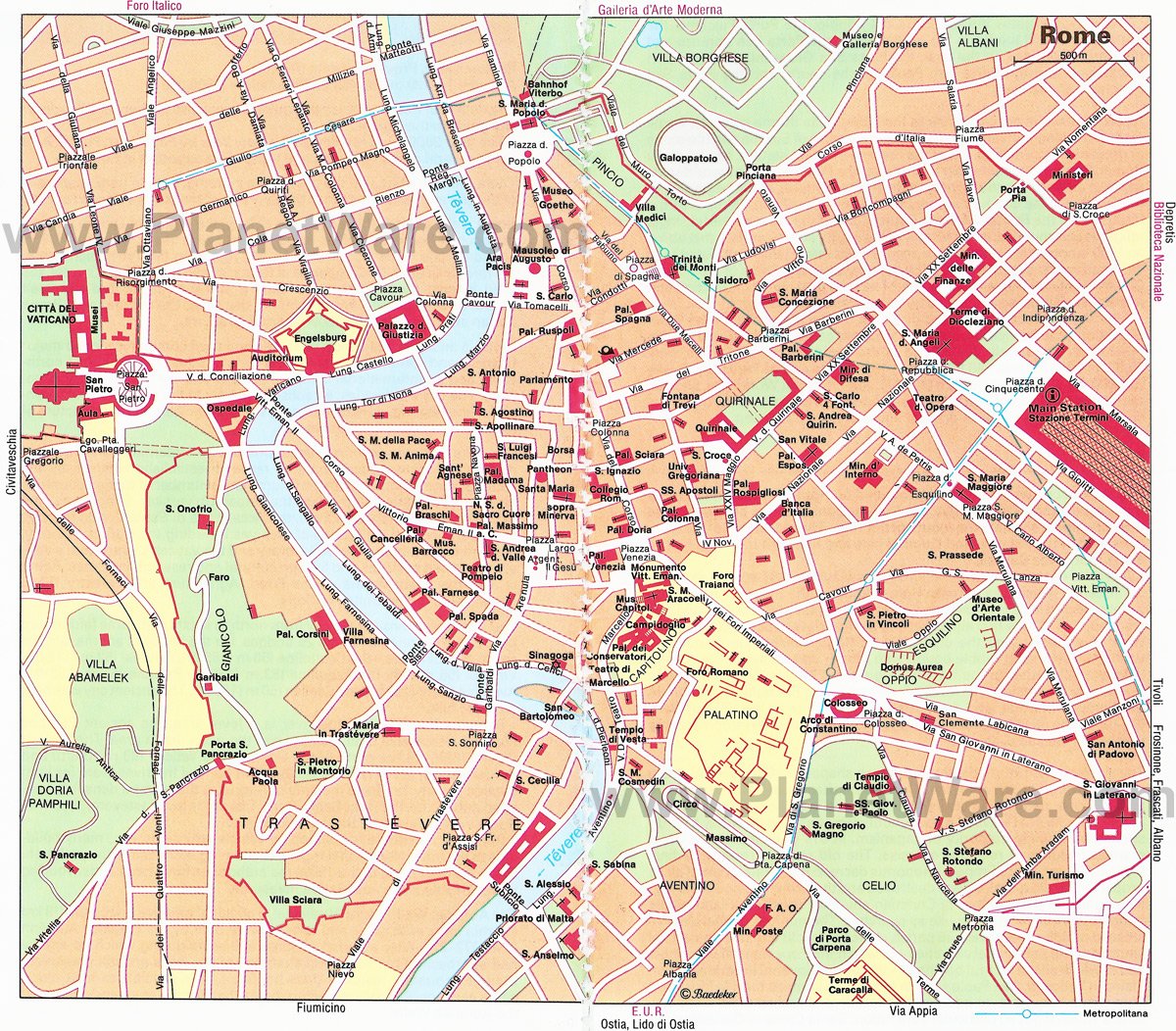
More on Italy

Top 48 Tourist Attractions in Rome (with Map)

- 7 Pinterest
It’s hard not to fall in love with Italy, and in particular with its capital. From the Vatican city to the Colosseum, there are so many tourist attractions in Rome !
To help you visit the best attractions and top sights for your next trip to Rome, TourScanner has published the ultimate list of top tourist attractions.
It’s time to get all geared up and explore our 48 exciting suggestions of places to visit in Rome!
1 – Colosseum

The Colosseum was the most extensive amphitheater in the Roman Empire, begun by Vespasian in 72 AD. It was used to show gladiator fights and hunting scenes with exotic and ferocious animals.
Nowadays it is possible to visit the Colosseum and understand how the underground theater system worked, with freight elevators, ramps, and traps that served to bring animals, gladiators and scenic machinery in front of an excited audience. Discover the Rome most iconic attraction!
2 – Trevi Fountain

The Trevi Fountain is an extraordinary work of art , much more than a simply fountain: it is the triumph of Baroque aesthetics that is embodied in natural forms.
Before leaving, do not forget to throw a coin in the fountain, in fact, the most famous popular legend connected to the fountain ensures that you bring luck throwing a coin from your shoulders and in this way you will also ensure the return to the eternal city. A walking tour in this area will allow you to discover the best of Rome’s city center. It often includes other attractions as the Pantheon and Spanish stairs.
3 – Pantheon

Visiting the Pantheon is a unique experience! A merely magnificent work that contains beauty, technique, and harmony. It’s a masterpiece of architecture and engineering. An obligatory stop that can’t miss during your visit to the Eternal City. If you have a way, enter the temple at noon, when the rays of the sun coming from the oculus become extraordinarily intense and create a truly unique effect!
4 – Vatican Museums and the Sistine Chapel

The Vatican Museums located inside the Vatican City State, represent one of the most important museums in the world serving an extraordinary collection of timeless masterpieces displayed in the fabulous Vatican palaces.
This vast collection of works of art has been accumulated over the centuries by the Popes. Inside the Vatican Museum, there is the Sistine Chapel, that deserves to be one of the most famous places to visit in the world thanks to the Michelangelo’s works.
If you want to discover all its secrets and beauties, there are many tours of the Vatican Gardens that include a guided visit of the Sistine Chapel and the Vatican Museums.
5 – Galleria Borghese

The collection of the Galleria Borghese , defined as one of the best museums in Rome , consists in sculptures, bas-reliefs, and ancient mosaics, as well as statues and paintings from the fifteenth to the eighteenth century.
In addition to being exceptional for its splendid collection, the museum is perfect in the coherence of its beautiful ensemble that implies marbles, inlays, mosaics, stuccoes, and inserts of the antique.
6 – Roman Forum

The Roman Forum was the monumental center of ancient Rome where there were the most important public and religious buildings of the city.
You can join a tour of the Roman Forum , it usually includes also a visit to the Colosseum. Nowadays it is possible to visit the remains of the old Piazza del Foro (Temple of Antoninus and Faustina, Basilica Emilia, Curia, Temple of Vesta, Ara of Caesar, Arch of Titus and Septimius Severus).
7 – Castel Sant’Angelo

Planned by Hadrian as a tomb for himself and his successors, it was initially designed by the architect Demetriano around 123 and completed a year after the death of the emperor by Antoninus Pius.
Castel Sant’Angelo is the perfect representation of the solemn Roman spaces, massive walls, and luxurious frescoed rooms and the ideal Rome attraction. Since 1925 it has housed the National Museum of Castel Sant’Angelo and houses collections of art and history as well as relics of the Italian Army in a great setting restored for the occasion.
8 – Vittoriano

The Vittoriano , also called Altare della Patria, is a monumental complex inaugurated by Vittorio Emanuele III in 1911, on the occasion of the International Exposition for the 50th anniversary of the Unification of Italy.
This attraction was designed and built to provide a tribute to the memory of the first king of Italy. After some restoration and redevelopment operations today the Vittoriano Complex hosts exhibitions and conferences and is one of the most appreciated Rome attractions.
9 – St. Peter’s Basilica

One of the biggest churches in the world, St. Peter’s Basilica is also one of the holiest temples in the world. Besides, it is where the Pope presides many liturgies all year round. The construction of the was finished in 1626.
Several renowned architects designed the temple, highlighting the works of Bramante, Michelangelo, and Carlo Maderno. It’s a must-see Rome attraction, best enjoyed with a guided tour of St. Peter’s Basilica !
10 – Mouth of Truth

Under the porch of the church of Santa Maria in Cosmedin, there is the Mouth of Truth , one of the most famous Rome attraction. The Mouth of Truth keeps its celebrity standing in the world thanks practically only to the legend that accompanies it.
His fame is due to popular tradition, for the belief that the mouth could bite the hand of someone who had not affirmed the truth.
11 – Caracalla Baths

The Roman empire has started the construction of impressive and monumental public baths, an essential center of community life for all strata of the population. In fact, the baths were not just a building for bathing, sports, and body care, but also a place for walking and studying.
There are many different kinds of Caracalla baths tours , private, skip the line, and walking tours of this magnificent baths. The vast extension of the Baths of Caracalla is a clear example of it, being one of the most extensive and most impressive monumental complexes of ancient Rome.
12 – Basilica of Saint Paul Outside the Walls

The Basilica of Saint Paul Outside the Walls , with its impressive Byzantine structure, is the largest of the patriarchal ones in Rome after St. Peter’s in the Vatican.
The emperor Constantine had built it at the beginning of the fourth century on the burial place of St. Paul, already a destination for pilgrimages. Rebuilt and enlarged less than a century later, over time it was enriched with chapels, mosaics, and precious furnishings.
13 – Trastevere

Trastevere is undoubtedly one of the most characteristic neighborhoods of all Rome, where between narrow colored alleys, Roman trattorias, markets, shops and artisan shops, it is still possible to get lost to rediscover the essence of the most authentic and genuine Rome.
Discover this enchanting neighborhood with one of the many tours of Trastevere . From Santa Maria in Trastevere to Piazza Trilussa you can still breath the typical Rome products of the past, and at nightfall, the young get together to have a chat or to drink something with friends in one of the many pubs and nightclubs.
Read more: 18 Best Food Tours in Rome for a Delicious Journey Through Italian Cuisine
14 – Piazza Navona

It is undoubtedly one of the most beautiful Roman attractions, built on the ashes of the Stadium of Domitian, was used in ancient times for athletic competitions. Today the Piazza Navona hosts street artists and painters and is a meeting point for tourist and Romans people.
Do not miss the church of Sant’Agnese in Agone and the Fountain of the Rivers, where four statues are representing the four rivers considered at the time the most important: the Nile, the Danube, the Ganges and the Rio de la Plata.
15 – Quartiere Coppedè

Designed by the Florentine architect and sculptor Gino Coppedè, the homonymous district Quartiere Coppedè has been defined by many as a fairytale experiment. This extravagant corner built between 1915 and 1927, was conceived by Coppedè as a real village.
Appears today as a mix of styles, where Renaissance symbologies, sacred aedicules, neo-Gothic chandeliers, Baroque coats of arms, triumphal Roman arches, liberty cues, Gothic towers and so on, live together to perfection.
16 – Villa Doria Pamphili

The Villa Doria Pamphili is the most extensive public park in the city of Rome, which like many other city parks originates from the country estate of a noble Roman family.
It was conceived as a country residence of the Pamphilj family, under the pontificate of Innocent X and gradually became a magnificent villa with a splendid park.
17 – Giardino degli Aranci

On top of one of the Aventino hills of Rome, between the medieval walls, remains of the ancient fort of the Savelli family stands Savello park, most commonly called Giardino Degli Aranci .
From here you can enjoy a splendid view of Rome that goes from the Tiber to the Basilica of San Pietro. The trees that give it its name were planted in memory of St. Dominic who founded his convent here.
Continuing after the Giardino Degli Aranci there is the door of Villa del Priorato di Malta. There is possible look through the keyhole, where you can admire a splendid view of the Dome of St. Peter, which appears along the avenue of the Gardens of the Order, bordered by trees.
18 – Cinecittà Studios

One of the most famous Rome attractions, where some of the masterpieces of the cinema were filmed. Cinecittà Film Studio in Rome, located approximately 9 kilometers from the center of the capital, boasts large spaces and state-of-the-art equipment.
Today it is possible to visit Cinecittà and discover the secrets of cinema and each phase of the realization of a film: from the script to the post-production, through the discovery of stage costumes, shooting techniques, the creations of the first-rate scenographers.
19 – MAXXI

The MAXXI National Museum of the XXI Century Arts is the first national institution dedicated to contemporary creatività and is the great architectural work of Zaha Hadid.
The planning of the activities reflects the vocation of MAXXI to be not only a place of conservation and exhibition but also a laboratory of experimentation and cultural innovation.
The MAXXI is famous for its complexity of the volumes, its curvilinear walls and visitors can walk inside this Rome attraction following different and unexpected paths.
20 – Piazza di Spagna

The square is today a cultural heritage of inestimable value. Located near Pincio hill, Piazza di Spagna has always been the center of the cultural and tourist life of the city of Rome.
Elegance is undoubtedly the principal characteristic of the square: the frame offered by the colored buildings, the Bernini mountain of Barcaccia and the stairway on which the Trinità dei Monti church stands, contribute to creating a refined and eighteenth-century atmosphere.
21 – Campidoglio

Since ancient times it has been an essential place for the life of the city, first as a religious place and then as a place of power when the Senate of Rome took its place.
The Campidoglio , today the seat of the municipality of Rome, is the smallest among the seven Rome’s hills, but also the most important because the first nucleus of the city was born in this point.
22 – Villa Adriana

It is the villa that the emperor Hadrian built for himself and his court in the Tiburtina countryside. It is a unique testimony for breadth, architectural and decorative features.
You can visit this villa joining one of the half or full day trips from Rome to Tivoli that often include a tour of Villa Hadrian and Villa d’Este . Today it appears as an extraordinary, immense park, spread over 80 hectares, dotted with Roman ruins, spas, and eighteenth-century farmhouses, in an atmosphere that still retains much of the ancient charm.
23 – Capitoline Museum

The oldest public museum in the world, the Capitoline Museum founded in 1471 by Sixtus IV, is divided into the two buildings that together with the Palazzo Senatorio delimitate the Campidoglio square, Palazzo dei Conservatori, and Palazzo Nuovo.
24 – San Callisto’s catacombs

The Catacombs of S. Callisto are among the largest and most important in Rome. They arose in the middle of the second century and formed part of a cemetery complex that occupies an area of 15 hectares of land, with a network of tunnels that are almost 20 kilometers long, on different levels.
In them were buried dozens of martyrs, 16 pontiffs, and many Christians. Make sure you don’t miss a catacombs tour to discover this incredible attraction.
25 – Ara Pacis

The Ara Pacis is a Roman sacrificial altar enclosed in marble with beautifully carved in high reliefs with allegorical and ceremonial scenes and adorned with plant motifs.
This monument represents one of the most important testimonies received from the Augustan art and intends to symbolize the peace and prosperity reached as a result of the Pax Romana.
26 – Arco di Costantino

Constantine, after having assembled most of the imperial power in his hands, built the last of the great triumphal arches of Rome.
The Arch of Constantine is the most extensive honorary arch that has come down to us, and this structure celebrates Constantine’s triumph over Maxentius after the battle of Ponte Milvio occurred on October 28, 312 AD.
27 – Santa Maria Maggiore

Santa Maria Maggiore is the largest of the churches dedicated to the Virgin Mary in Rome and is one of the four major basilicas of the Italian capital.
The legend said that after the explicit request of the Virgin Mary, who appeared in a dream to Pope Liberius (352-366), was built the church. It was made a century later by Pope Sixtus III on the site of a previous church.
28 – Casina delle Civette

The Casina delle Civette is located inside the park of Villa Torlonia in Rome and is one of the hidden Rome attractions of the capital. Its name derives from the fact that the owls are a recurrent decoration in stained glass and majolica.
Until 1938 the Casina delle Civette had been the home of Prince Giovanni Torlonia junior. Today it is a museum that seems to come out of a book of fables.
29 – Villa Medici

Located on the Pincio hill in Rome, Villa Medici is an architectural complex that houses the French Academy in Rome since 1803.
This splendid villa was bought in 1576 by Ferdinando de Medici, and then enlarged and equipped with a gallery of statues. Its structure with side turrets is simple and richly decorated on the back by the Florentine Bartolomeo Ammannati with stuccowork, bas-reliefs, and sculptures.
30 – Column of Marco Aurelio

Made by Commodus during his reign (180-192), the Column of Marcus Aurelius still stands out today in its original position. The monument was erected to celebrate the victorious campaigns of Marcus Aurelius on the Germanic populations of the Marcomanni and the Quadi. The column is almost 30 meters high and today gives its name to the square that houses it.
31 – Jewish Ghetto

Rome’s Jewish ghetto is one of the most important hidden treasures of the entire capital.
Visiting this small neighborhood, bordered by the Tiber on one side and Piazza Venezia on the other, represents an experience not only cultural and religious, because of the Synagogue and the Jewish Museum, but also gastronomic, thanks to the many typical restaurants scattered throughout the ghetto.
32 – Rainbow MagicLand

Rainbow MagicLand , the most extensive amusement park in central and southern Italy, is located in the municipality of Valmontone, a few kilometers from Rome.
Extending over an area of 60 hectares, this Rome’s attraction is developed around a central lake and offers its guests 38 attractions for all tastes.
33 – Via Condotti

It is one of the most elegant streets in Europe and if we wanted to give it an adjective is sophisticated. In fact, it is famous for its chic high fashion shops, a real destination for pilgrimages Made in Italy and beyond.
Via Condotti is the walk for you, if you want to immerse yourself in its atmosphere of big names like Versace, Cavalli, Armani, Bulgari, Cartier, Luis Vuitton, are just some of the names you can find there.
34 – Quirinal Palace

The Quirinal Palace is one of the symbols of the Italian State. In fact, since 1870 has been the official residence of the King of Italy and since 1946 is the residence of the President of the Italian Republic.
The visit of the Palace allows you to the discover a heritage of art, history, and culture of inestimable value. It also lets us know the location where the President of the Republic performs his functions.
35 – The National Etruscan Museum in Villa Giulia

Built between 1550 and 1555, Villa Giulia is a splendid example of a Renaissance villa built as a suburban residence.
Since 1889 it hosts the Villa Giulia Museum, the most representative museum of Etruscan civilization and welcomes not only some of the most important creations of this civilization but also Greek products.
36 – Imperial Forum

The Imperial Forum of Rome collects a series of great plazas built between 46 and 113 a.C. They were considered the center of political activity in ancient Rome, a place that over the centuries has been enriched with structures and buildings. It contains the Foro of Augusto, Foro of Cesar, Tempio della Pace, Foro di Nerva and Foro of Traiano.
37 – Trajan’s Markets

The Trajan’s Markets , built in the early second century, were destined for commercial and administrative functions due to the presence of warehouses, shops, and offices of the imperial administration.
The monumental complex, rediscovered between 1926 and 1934, is characterized by buildings that rise on several levels along the slopes of the Quirinale. The Museum of Imperial Forum was inaugurated inside in 2007, in which it is possible to admire recompositions of scores of architectural and sculptural decoration.
38 – Palatine Hill

The Palatine Hill between the second and the first century became the residential district of the Roman aristocracy. Emperor Augustus made the Palatine the official seat of power and began the construction of the imperial palaces, restructured and expanded later by Nero, Domitian, Hadrian and Septimius Severus.
39 – Lungotevere

Until the last century, the Tiber was an essential fluvial hub for the trade of Rome, thanks to the presence of the ports. Today a walk along the Lungotevere is a must.
The views that we can see in the Lungotevere are among the most beautiful in Rome. It’s a must-see Rome attraction! You can also cruise the Tiber river with an Italian aperitivo or a dinner.
40 – Domus Aurea

The Domus Aurea was the urban villa built by the Roman emperor Nero after the great fire that devastated Rome in 64 AD. The surviving part of the Domus Aurea was included in the list of World Heritage Sites by UNESCO in 1980.
Nowadays it’s possible to visit the villa, and the virtual reality of the villa allows you to see the rooms, especially the Hall from the golden vault, as they were in the days of Nero.
41 – Pincio Terrace

The Pincio Terrace is a panoramic terrace on the top of one of the seven hills of Rome, the Pincio hill. From its terrace, the eyes are lost in one of the most beautiful views of the world, where you can see the magnificent “cupola” and all the main monuments of the eternal city in a breathtaking show.
42 – Circus Maximus

The Circus Maximus was destined for various sports and athletic competitions but became famous above all for the chariot races. Recent excavations have brought to light the findings that allow us to delineate better the ancient fortitude of the circus, a myriad of shops, stalls, and taverns surrounding the racing area.
43 – Orti Farnesiani

This Botanical Garden takes its name from the Farnese family, which at the end of the 500 have bought almost the entire surface of the Palatine hill, transforming it into a splendid garden.
The Farnese garden or Orti Farnesiani , was the way of affirming the political and institutional position of the noble family. The garden was considered to be the oldest in the western world.
44 – Galleria Alberto Sordi

The Galleria Alberto Sordi was built at the beginning of the 20th century, in a period of a redevelopment of the center of Rome. Today the high part of the Galleria is destined to the lodging of some offices that belong to the Presidency of the Council of the Ministers.
The lower part, open to the public is an excellent shopping center, with brands for shopping, bookstore, and bars.
45 – Piazza del Popolo

Located at the top of a triangle of streets known as the Trident (via del Babuino – via del Corso – via di Ripetta), Piazza del Popolo constitutes the most grandiose access to the heart of Rome. The square is undoubtedly one of the most famous in the world.
The two twin churches Santa Maria di Montesanto and Santa Maria dei Miracoli, the Flaminio Obelisk (the oldest and second highest in Rome), and the two fountains of Valadier help to create the charming atmosphere of the Piazza.
46 – Terrazza del Gianicolo

Located on the Janiculum Hill, the Terrazza del Gianicolo offers one of the best views of the capital due to its strategic position overlooking the city. You can admire a breathtaking view of the entire city.
Every day at 12, three soldiers shoot a powerful cannon shot that resounds throughout the city! The tradition of the cannon dates back to Pope Pius IX who, to avoid confusion of time, established this service in 1846, for synchronizing all the bells of the Roman churches!
47 – Palazzo Montecitorio

The Palazzo Montecitorio is a historical Rome attraction where is located the Chamber of Deputies of the Italian Republic. The history of the palace began in 1653 when Innocenzo X commissioned to Gian Lorenzo Bernini to build a residence for the Ludovisi family.
Nowadays it’s possible to visit the palace with an itinerary that touches the most famous and evocative places of the parliamentary life.
48 – Olympic Stadium

Completed in 1953 the stadium was renamed Olympic Stadium after the assignment to Rome of the games of the XVII Olympic Games in 1960.
The Olympic Stadium is located at the Foro Italico, on the slopes of Monte Mario, in the north-western sector of the capital. It is owned by CONi and, in addition to hosting the home football matches of Lazio and AS Roma , is home to the final of the Italian Cup, the Golden Gala, annual meeting of athletics and numerous concerts by Italian and international artists.
If this list was not enough, get even more inspiration from our article on the 76 best things to do in Rome !
Did you enjoy browsing through our recommended places to visit in Rome? Leave a comment below to suggest us your favorite sight in Rome!
Share it on Pinterest 🙂

- Most Popular
- Special Tours
- Small Groups
- Florence tours
- Venice Tours
- Pompeii and Amalfi Tours
- Rome culinary experiences
- Cinque Terre
- Alba and Langhe
- Amalfi Coast, Capri and Pompeii
- Puglia and Matera
- Sicily and Pantelleria
- Rome Kids & Families Experiences
- Rome Kids & Families Tours
- Vatican Kids and Families Tours
- Venice Kids & Families Experiences
- Venice Kids and Families Tours
- Cooking Classes for Kids in Rome
- Sustainability
- Via Giustiniani, 23, 00186 Roma RM
(0039) 06 6624626
(0039) 338 7791615
(0039) 334 7243374
- [email protected]
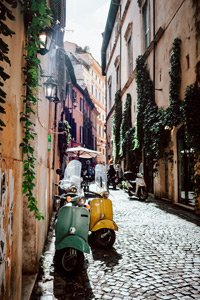
- Rome Kids & Families Tours
Famous places in ancient Rome: landmarks, monuments and historical sites
Home / Blog / Famous places in ancient Rome: landmarks, monuments and historical sites
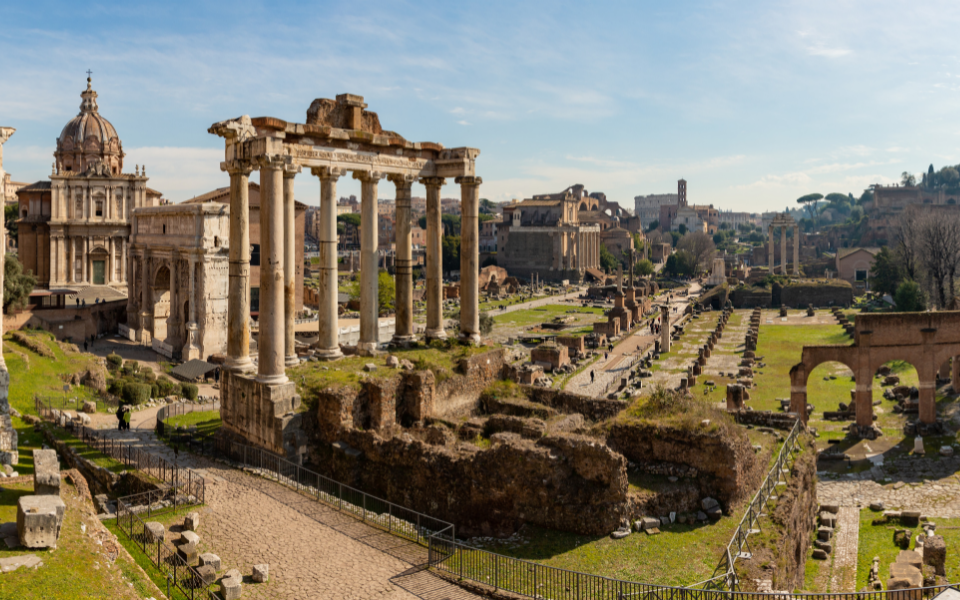
Italy with its vast historical landscape is home to numerous ancient Roman sites. These remnants are a testament to the far-reaching influence of the Roman Empire, which spanned over both continents and centuries.
While evidence of this remarkable civilization can be found in various regions it is in Italy – the heart of the empire – where some of the most iconic and well-preserved sites are harbored. Among these treasures the capital city of Rome stands out. It was the epicenter of the Roman world, adorned with awe-inspiring architecture, forums, temples, and arenas. Many of these f amous places in ancient Rome have withstood the test of time offering a remarkable glimpse into the past.
In the upcoming sections we will delve into what makes ancient Rome truly exceptional by exploring some of the famous places in ancient Rome.
These are the iconic sites that beckon travelers and history enthusiasts alike, urging them to embark on a journey of discovery. These are the destinations that one should aspire to visit at least once in a lifetime. As we help you uncover the stories, histories and significance behind each of these renowned sites you will gain a deeper appreciation for the treasures that Rome has preserved throughout the ages.
So prepare to embark on a virtual pilgrimage through time as we guide you through the must-visit landmarks of ancient Rome, each holding a piece of the city’s extraordinary past.
Top 3 historical sites in Rome, Italy
The ancient Roman landmarks are not mere historical relics but integral components of the city’s urban fabric. Each of these sites whether it be the Colosseum, Roman Forum, or the Pantheon bear the weight of a millennia of history, and together they embody an unrivaled artistic and cultural heritage. Born from the humble origins of a small settlement in 753 BC, the Roman Empire expanded to become a colossal superpower reaching its zenith in the 2nd century AD under the rule of emperors like Augustus and Trajan. However, it eventually succumbed to internal strife and external pressures leading to its gradual decline and eventual fall in the 5th century AD. Throughout this rise and fall these landmarks have stood as witnesses to the empire’s glory and its eventual transformation into the eternal city we know today, offering a tangible link to Rome’s enduring legacy.

Among the plethora of Italy monuments, Rome stands as a city that boasts an impressive array of historical treasures. Perhaps the most iconic of them all is the Colosseum, a majestic marvel that continues to leave visitors in awe with its sheer grandeur and impeccable state of preservation.
This enormous amphitheater is accessible through one of our unforgettable tours and stands as an enduring symbol of ancient Rome’s architectural prowess and entertainment extravagance. Its immense scale and intricate design are a testament to the engineering genius of the time and its history, filled with gladiatorial contests and epic spectacles, is as captivating as the structure itself. The Colosseum’s monumental presence in the heart of Rome makes it an indispensable stop for anyone seeking to immerse themselves in the city’s rich history and culture.
The Pantheon, one of the most famous buildings in ancient Rome , is a true marvel nestled in the heart of the city. Accessible through one of our carefully guided tours it seamlessly integrates into the modern urban architecture surrounding it making it a timeless masterpiece.
This architectural gem – originally built by Emperor Augustus’s son il law Agrippa and later reconstructed by Emperor Hadrian in the 2nd century AD – boasts a stunning dome that was a revolutionary feat of engineering for its time. What sets the Pantheon apart is its enduring legacy as a place of worship, transforming from a pagan temple to a Christian church, and its remarkable state of preservation, with its iconic dome still standing as the world’s largest unreinforced concrete dome. Its breathtaking interior illuminated by the oculus continues to captivate visitors, making the Pantheon an essential stop for those seeking a glimpse into ancient Rome’s architectural genius and spiritual history.

Roman Forum
For those in search of famous sites in ancient Rome the Roman Forum is an absolute must-see during your stay in the city. Do not miss the opportunity to explore it through our offered curated experience .
This historical treasure offers a captivating journey into the heart of ancient Roman life and politics. Once the bustling center of commerce, politics, and culture the Roman Forum is now a sprawling archaeological site that preserves the remnants of temples, government buildings, and monuments that were integral to the life of the empire. By strolling through its ancient pathways you’ll be transported back in time, and the ruins will come alive with stories of emperors, senators, and citizens who once walked these very streets. It is an important destination for anyone eager to explore the rich history and vibrant past of ancient Rome.

Other famous sites in Ancient Rome:
Certainly when we discuss ancient sites it is important to clarify that these three famous landmarks are not the sole attractions that were popular in ancient Rome . Ancient Rome was brimming with a multitude of remarkable sites each with its own unique historical and cultural significance.
While the Colosseum, Pantheon, and Roman Forum are undoubtedly iconic and continue to capture our imagination today, they are just a fraction of the wealth of historical and architectural treasures that existed in the ancient city. Throughout Rome and its vast empire, there were countless other temples, theaters, bathhouses, villas, and monuments that enriched the daily life and culture of the time. Exploring these lesser-known gems can provide a more comprehensive understanding of the grandeur and diversity of ancient Rome’s heritage.
Circus Maximus:
The Circus Maximus, often referred to as the most important place in ancient Rome , is steeped in history and mythology as it is said to have been commissioned by the legendary first king of Rome, Romulus. This vast, ancient stadium was a centerpiece of Roman entertainment, hosting chariot races, athletic competitions and various public events for centuries.
Situated in the valley between the Aventine and Palatine hills the Circus Maximus offered a sprawling arena that could accommodate tens of thousands of spectators making it one of the largest venues of its kind in the ancient world. Its long, rectangular shape and distinctive obelisks at both ends added to its grandeur. To truly appreciate the historical significance and scale of the Circus Maximus it is best to visit it during a calm morning or a late afternoon. These quieter times allow you to envision the ancient chariots thundering along the tracks and the enthusiastic crowds filling the stands. While much of the original structure has been lost to time the site itself still carries a powerful sense of the past, providing a unique glimpse into the entertainment and communal life of ancient Roman time.
Palatine Hill:
The Palatine Hill, a famous landmark in ancient Rome , holds immense historical significance central to the empire’s history. You can explore this ancient site with our tour to experience a captivating blend of history and archaeology. Visiting the Palatine Hill is most enjoyable during the morning or late afternoon when the weather is pleasant, and sunlight illuminates the ancient ruins. Allocate 1 to 2 hours for a fulfilling visit or more, if you are a history enthusiast or deeply interested in archaeology. This site offers a fascinating journey through time, shedding light on the empire’s history and the lives of its emperors and elites.
The Catacombs, reflecting the complex relationship between Christianity and the Roman Empire, are a network of underground burial sites scattered across Rome. Visit the catacombs with us to get a fascinating glimpse into early Christian history and the challenges faced by the faith during Roman times.
The Catacombs are of great interest due to their historical and religious significance. These subterranean chambers served as burial places for early Christians, showcasing intricate frescoes and carvings that depict the art and symbols of the era. The most renowned catacombs include San Callisto, San Sebastiano, and Domitilla, each offering a unique perspective on early Christian life.
Baths of Caracalla:
The Baths of Caracalla are a significant site in ancient Rome and have a fascinating history that is worth knowing. Emperor Caracalla, who ruled from 211 to 217 AD, commissioned these baths, which were completed around 216 AD. These baths were massive, covering about 25 acres and offering a wide range of amenities such as baths, pools, gyms, gardens, and libraries. They reflect the opulence of Roman society at the time and are a testament to the Romans’ passion for communal leisure. Today, their impressive ruins provide a glimpse into ancient Rome’s architectural and luxurious lifestyle.
The Via Appia , also known as the Appian Way, is a captivating ancient Roman road dating back to 312 BC, connecting Rome to the south of Italy. It offers a unique blend of history and physical activity making it an intriguing destination. You can rent a bike to explore its well preserved sections, passing scenic countryside and historic sites like the Tomb of Cecilia Metella and the Catacombs of San Callisto. For a memorable visit plan a half-day excursion, wear comfortable clothing, and bring water and sunscreen, especially in warm weather. It is a must-visit for history enthusiasts and active travelers.
Visiting Ancient Rome:
Why settle for just one dose of ancient Rome’s magic when you can embark on a journey through time with Walks Inside Rome’s captivating tours?
Picture yourself strolling the iconic landmarks of ancient Rome , from the awe-inspiring Colosseum to the grandeur of the Roman Forum and beyond.
But wait, there is more!
You don’t have to limit yourself to just one tour. With the option to organize multiple tours over several days you can truly immerse yourself in the rich history and culture of this remarkable city. Or, for those seeking a whirlwind adventure, take advantage of our offers that allow you to visit multiple famous Roman places in a single day, like a time-traveler on a mission to explore the past.
Even with limited days at your disposal you can unlock the secrets of ancient Rome and create memories that will transport you back to a bygone era. So why wait? Join us for an unforgettable journey through the heart of history, and let us make your Roman adventure a time-traveling delight!
Related Tours

Farmers’ Market Shopping with Roman Full Course Class | Shared
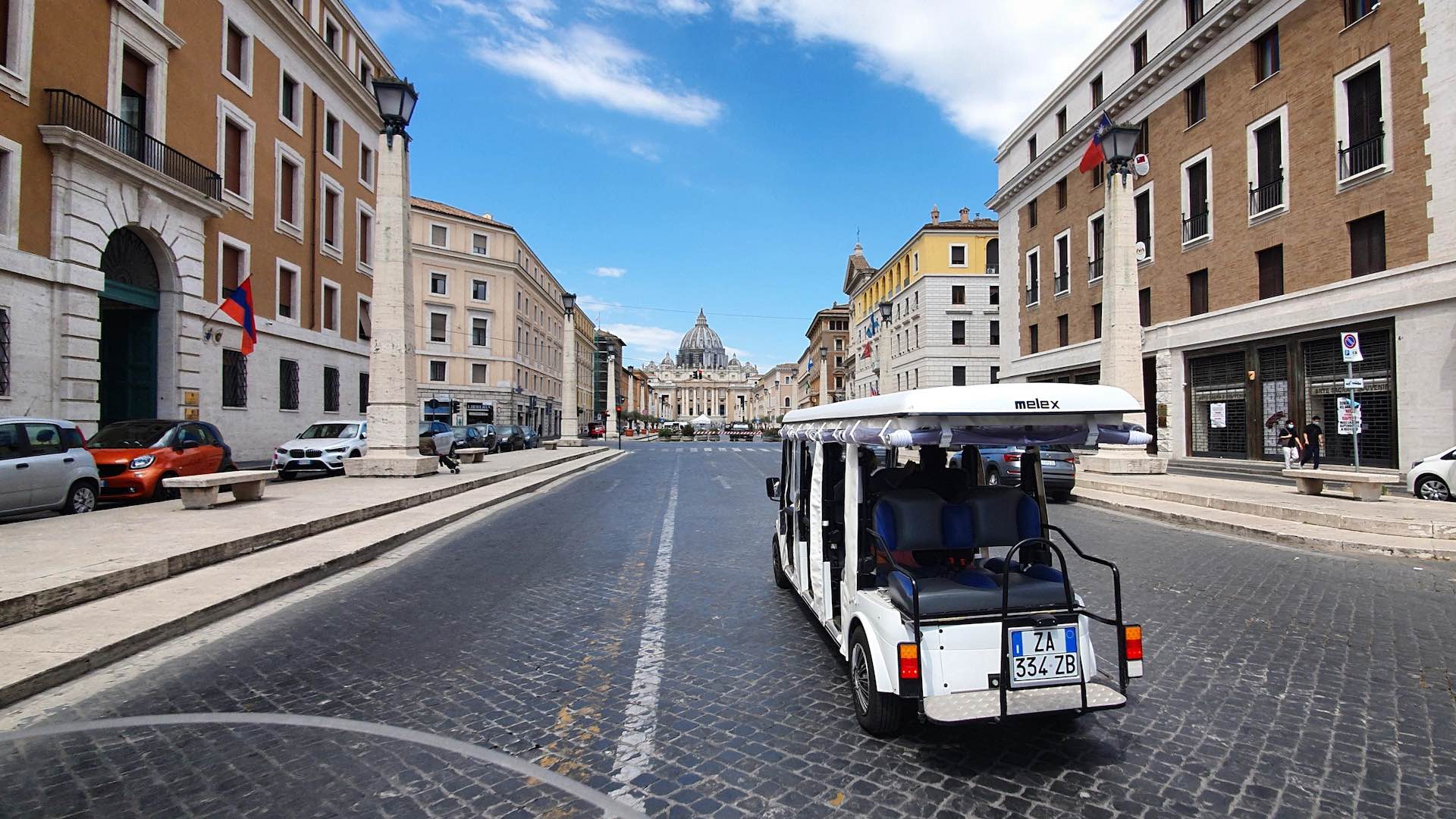
Golf Cart Tour of Rome | Private

Testaccio Food Tour | Private
- Rome Guided Tours
- Cooking Classes in Rome
- Rome for Kids Tours
- Rome Small Group Tours
- Walks Inside Rome
- +39066624626
- +393387791615
- Privacy Policy
- Cookie Policy
Forgot your password?
Lost your password? Please enter your email address. You will receive mail with link to set new password.
Back to login

Thinking about the Roman Empire? 41 best Roman ruins to visit

I’ve always been fascinated by the ancient Roman Empire, and thanks to the “thinking about the Roman Empire” meme, I’ve discovered I’m not alone! Growing up, I lived not far from the Roman ruins at Hadrian’s Wall and dreamed of seeing the Colosseum in Rome and the ancient city of Pompeii.
While the Roman Empire may have fallen centuries ago, its legacy still lives on in the form of breathtaking Roman ruins scattered across Europe and beyond. One of the best things about visiting ancient ruins is that you can so often get up close with them; at the Roman sites in this list you can walk Roman streets, visit Roman amphitheatres and even bathe as the Romans did.
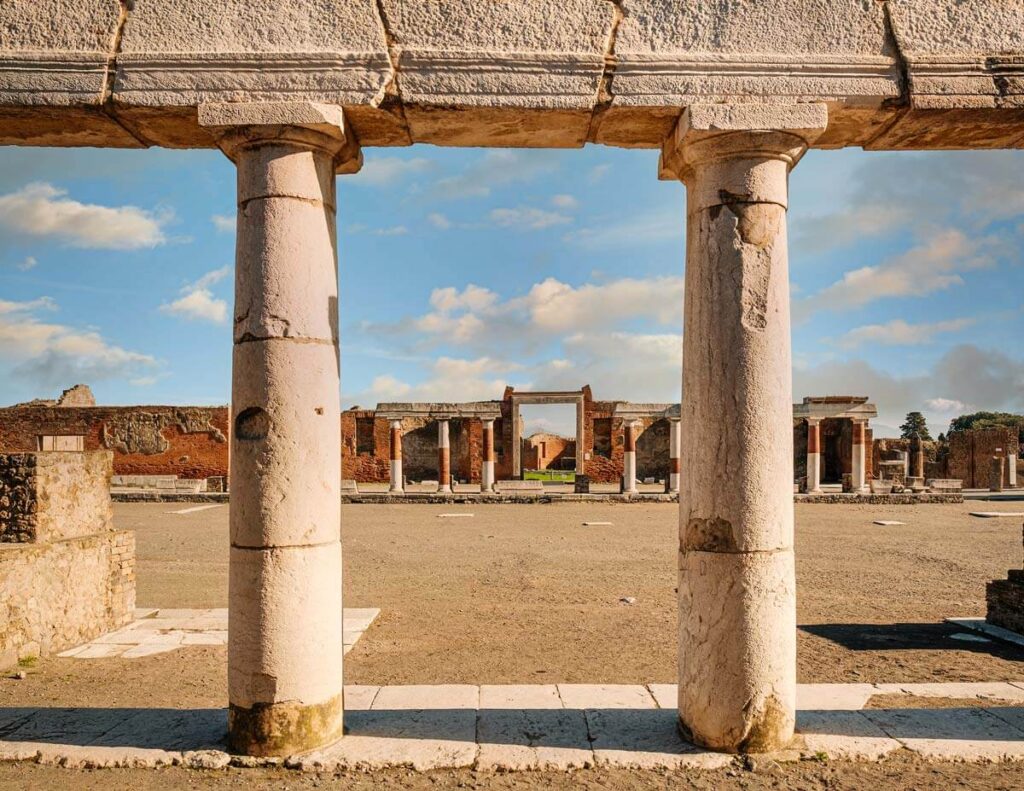
In this post I’ve rounded up some of my favourite ancient Roman sites to visit in Europe, along with a few that are on my bucket list. I hope you find it inspiring – and please tell me about your trips to Roman sites in the comments!
Roman sites to visit in Italy
If you’re interested in the best Roman ruins to visit, you have to start in Italy. You can see Roman history all across Italy, but let’s start in Rome, as the place where it all began.
The Colosseum, Rome
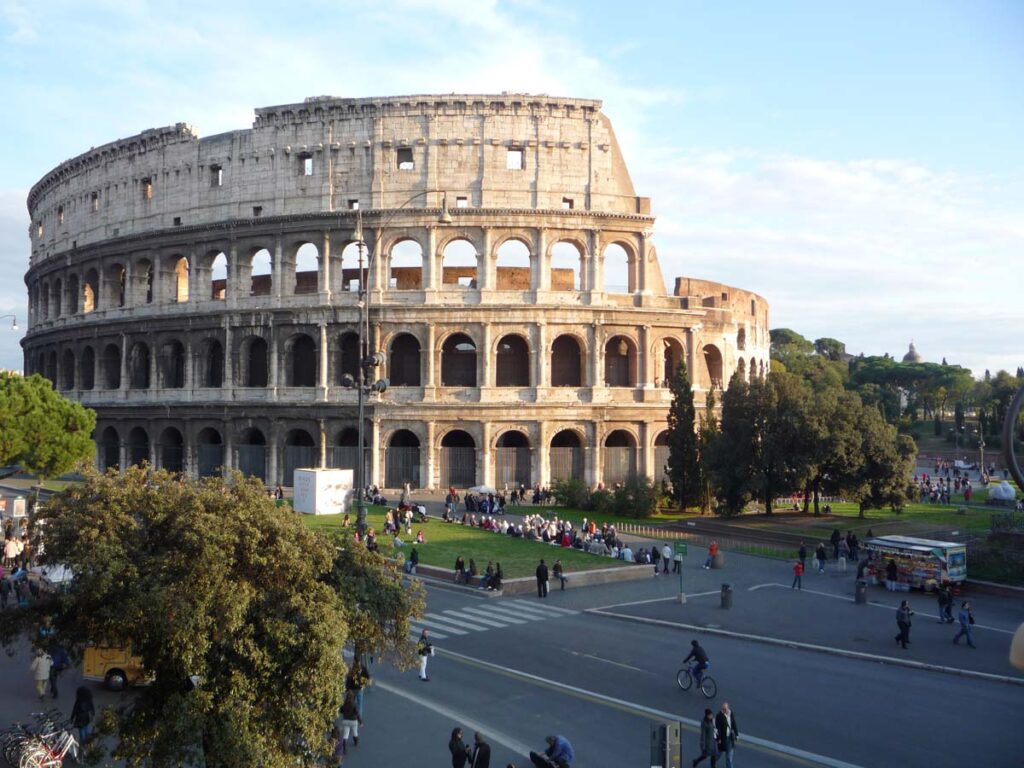
The mighty Colosseum in Rome is the Roman site that jumps straight to mind when I think about the Roman Empire. This colossal amphitheater was built in 70-80 AD under the reigns of the emperors Vespasian and Titus and could hold up to 50,000 spectators, who came to watch gladiatorial games, public spectacles, and dramas based on Classical mythology. As you walk through its arches, corridors and underground tunnels you can imagine the roar of the crowds and the heat of the battles that once took place here.
As the most famous Roman ruin and one of Rome’s most popular attractions, it’s a good idea to book your visit to the Colosseum well in advance . A guided tour, which often includes the nearby Forum and the Palatine Hill , will help you get the most from your visit.
Roman Forum, Rome
Just across the road from the Colosseum, the Roman Forum was once the hub of Roman public life and is another of the most important Roman sites in Rome. Visiting the Roman Forum lets you wander among the ruins of government buildings and ancient temples and stroll down shopping streets, just as the Roman people would have done thousands of years ago.
Like the Colosseum, the Forum fell into disrepair after the fall of the Roman Empire and was heavily plundered for its stone, leaving the famous Roman ruins that you see today.
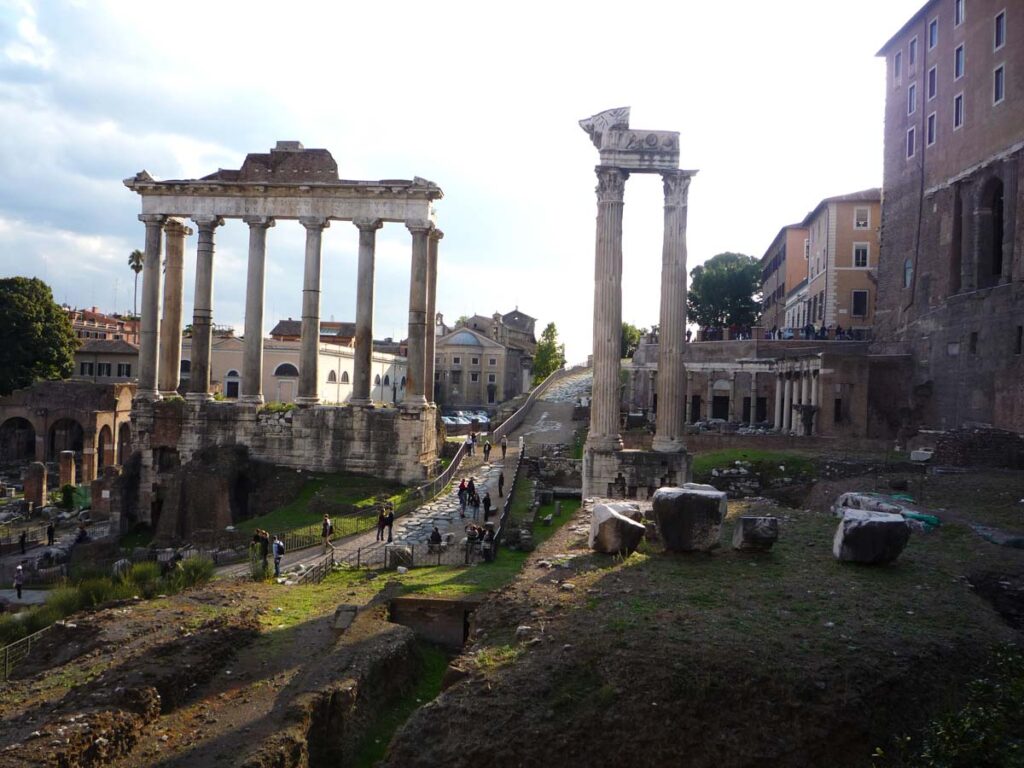
Must-sees at the Roman Forum include the 23 metre-high Arco di Settimio Severo, which was built in AD203 to celebrate Emperor Septimius Severus’s victories in the Roman–Parthian Wars. Don’t miss the Arco di Tito, which is said to have inspired Paris’s Arc de Triomphe. While it isn’t the most impressive site in the park, I was fascinated by the Tempio di Giulio Cesare, which was built by Emperor Augustus in 29BC on the spot where Julius Caesar’s body was cremated 15 years earlier.
Circus Maximus, Rome
It might sound odd, but when I visited Rome I found the Circus Maximus the most atmospheric ancient ruin in the city.
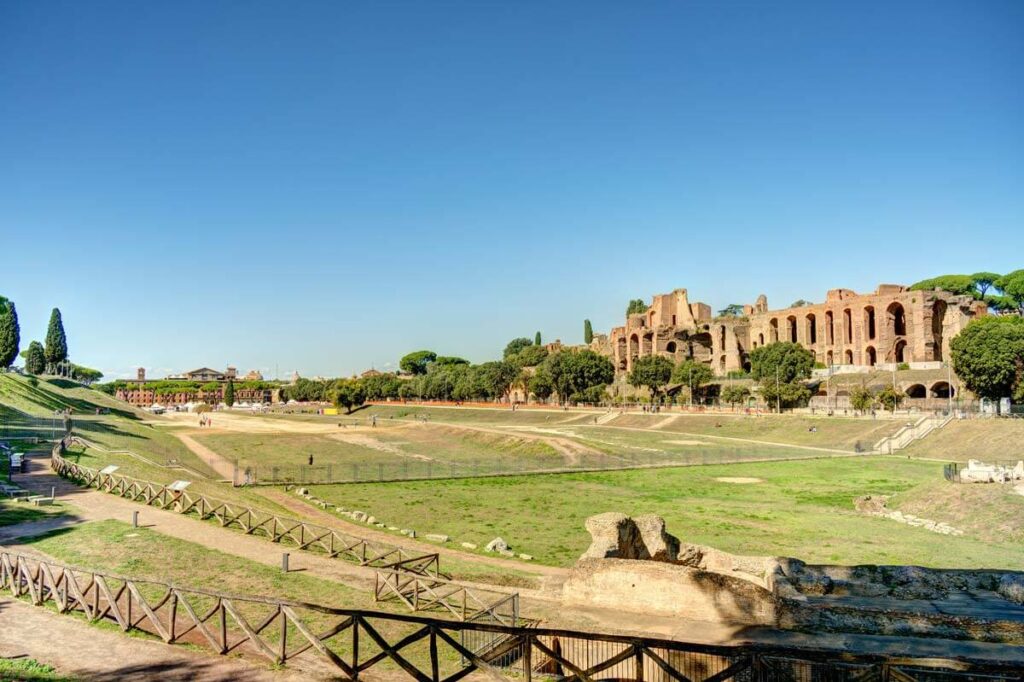
The Circus Maximus in Rome is an ancient chariot racing stadium that dates back to the 6th century BC and was later enlarged on the orders of Emperor Constantine as a show of power. It’s a vast space which could accommodate up to 250,000 spectators around an arena 600 metres long and 140 metres wide – the size of over 15 football fields.
The arena was primarily used for chariot races, but also hosted other public events like gladiatorial contests. Although much of the original structure has been lost over time, the outline of the track is still visible.
Palatine Hill
The Palatine Hill in Rome is one of the city’s Seven Hills and holds a significant place in Roman mythology and history. According to legend, it’s the site where Romulus and Remus, the city’s founders, were raised by a she-wolf. Over time, the hill became an exclusive residential area, housing emperors and aristocrats, including Rome’s first emperor, Augustus, as well as Emperor Tiberius and Emperor Domitian.
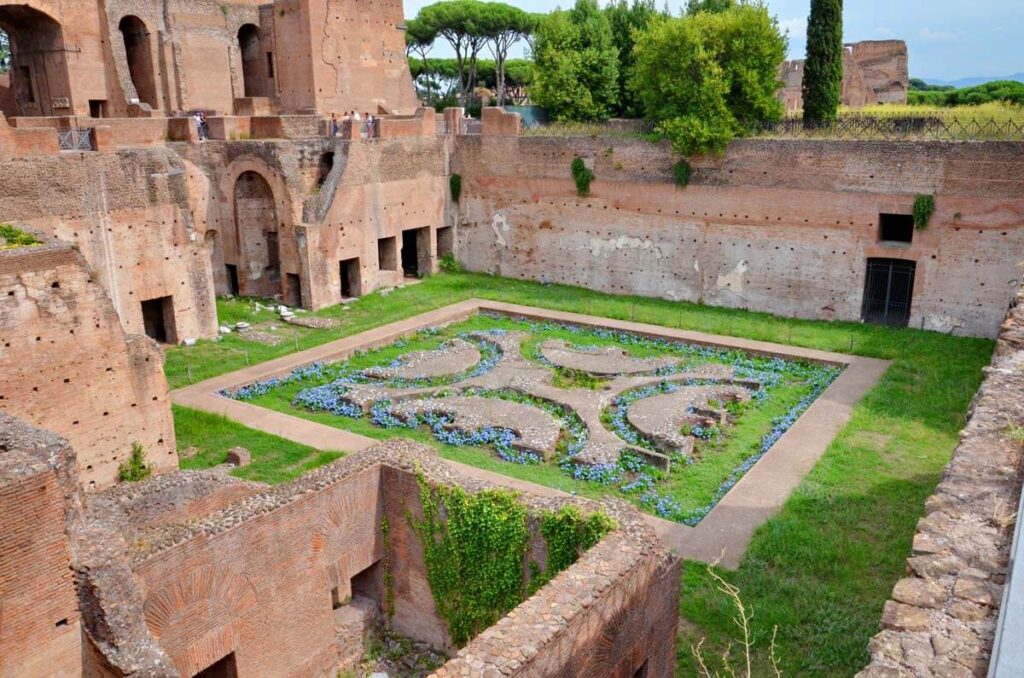
Key attractions include the Flavian Palace and the House of Augustus, filled with well-preserved frescoes. The hill offers panoramic views of the Roman Forum, Colosseum and Arch of Constantine making it a great place to visit to appreciate Rome’s ancient landscape.
Ostia Antica, near Rome
Ostia Antica, located just 30 minutes from Rome, offers a glimpse into everyday life in ancient Roman life. It was Rome’s primary seaport, and the well-preserved ruins include an amphitheatre, baths, and an array of shops and apartments.
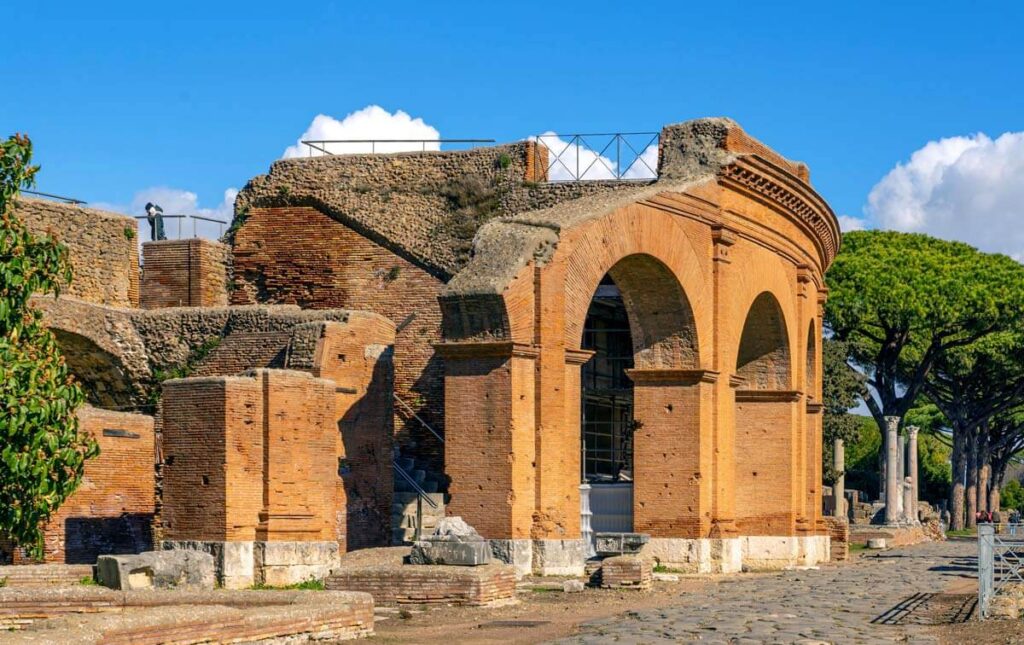
Unlike Pompeii, Ostia wasn’t destroyed by a volcanic eruption, so its decline was gradual, which adds a different layer to its historical narrative. You can wander down its old streets and practically feel the hustle and bustle of traders, sailors, and citizens from thousands of years ago.
Ostia Antica is less crowded than other sites, making it easier to explore at your own pace. While the site isn’t as large or well-preserved as Pompeii and Herculaneum (and experienced some rather questionable reconstruction), it’s a good choice if you don’t have time to travel south to see Pompeii.
More Roman sites in Rome
While the Colosseum and the Roman Forum are the most famous sites in Rome, if you have a bit more time in the Eternal City, don’t miss some of the other wonderful places to walk in the Romans’ footsteps:
- The Pantheon is far from being a ruin, but it can’t be beaten for atmosphere and sheer wonder at the Romans’ architectural skill
- The Theatre of Marcellus is even older than the Colosseum and was started by Julius Caesar
- The Sacred Area of Largo Argentina opened to the public for the first time in 2023; the archaeological site, which is home to several temples, has been designed to be fully accessible so everyone can visit
- The Baths of Diocletian were the largest bath complex in Ancient Rome; they now hold one of Rome’s best-reviewed museums
- The magnificent ruins of the Baths of Caracalla are only a short walk from the Colosseum but are much quieter, so they’re a great choice if you want to avoid the crowds
- The Domus Aurea , or “Golden House”, a lavish palace complex built by Emperor Nero after the Great Fire of Rome in 64 AD which featured gold and jewelled decoration, an artificial lake, gardens, and even a revolving dining room. After Nero’s death, much of the Domus Aurea was destroyed or repurposed, but some rooms remain and can be seen on a guided tour.
- The Castel Sant’Angelo in Rome, originally constructed as the Mausoleum of Hadrian, is a fortress that has played various roles in Rome’s history, including as a papal residence and a military stronghold. Its iconic cylindrical shape and rich history make it a must-visit landmark, and it also offers panoramic views of the city from its terrace.
Pompeii, Naples
Pompeii is an iconic Roman site, 15 miles south of Naples and located in the shadow of Mount Vesuvius, the volcano which destroyed the city in 79AD. Pompeii was a prosperous city, full of public buildings, temples, theatres, bath houses and shops, along with grand villas and ordinary homes. The site is absolutely huge and still growing, as archaeologists make fresh discoveries.
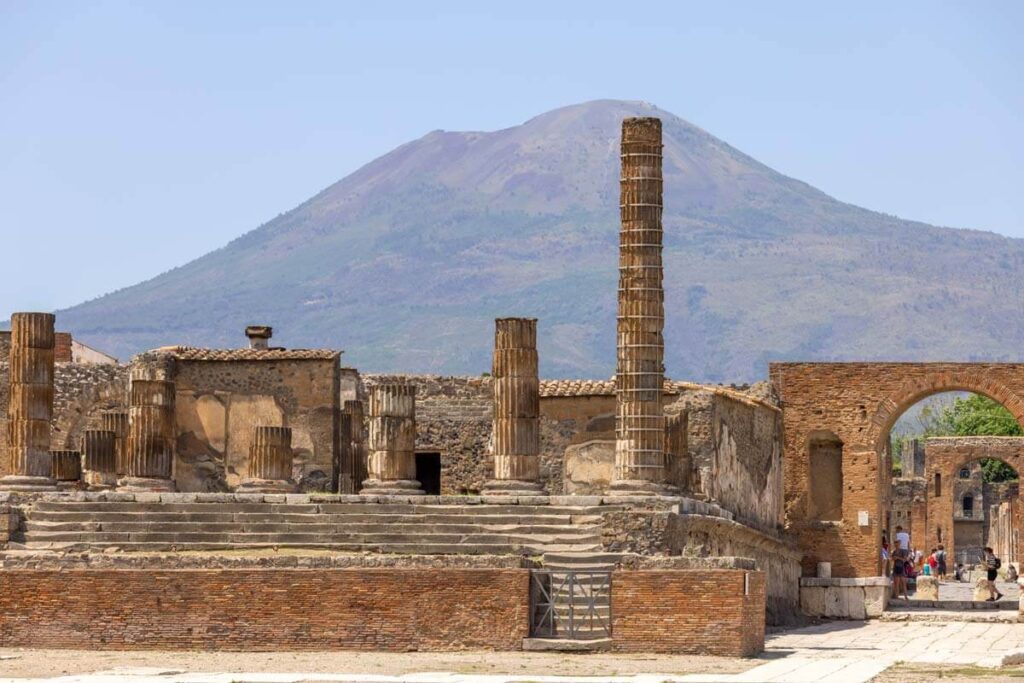
Compared to other Roman ruins, Pompeii is particularly well-preserved as the layers of volcanic rock that flew out of Vesuvius completely buried the city, leaving it just as it was on that fateful day.
With so much to see, visiting Pompeii felt to me a bit like going on a city break back to Roman times. If you want to really feel that you’ve walked in the footsteps of the Romans, a trip to Pompeii should definitely be on your bucket list.
Herculaneum, Naples
Like Pompeii, the town of Herculaneum was destroyed when Vesuvius erupted, but rather than being buried under heavy rocks, Herculaneum was covered in ash, meaning that the buildings there are some of the world’s best-preserved Roman ruins; it’s quite astonishing to think, as you’re walking around, that what you’re seeing is nearly 2000 years old.
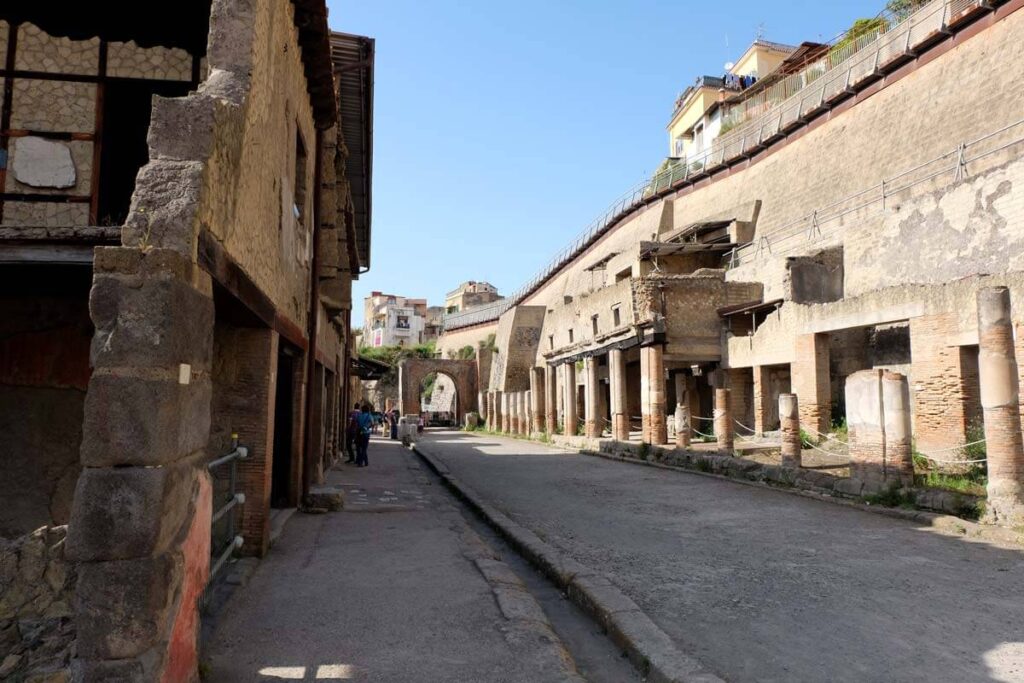
While in Pompeii most buildings were destroyed above their ground floor, in Herculaneum some of the upper floors survived.
Herculaneum is smaller and much less busy than Pompeii, so lots of visitors say they actually prefer it. Visiting Herculaneum is an easy day trip from Naples, Sorrento or the Amalfi Coast, and pairs well with a hike up Mount Vesuvius .
Verona Arena, Verona
The Verona Arena, located in the heart of Verona, Italy, is one of the best-preserved ancient amphitheatres in the world. Built in the first century, it could originally accommodate up to 30,000 spectators. Unlike Rome’s Colosseum, which is partly in ruins, the Verona Arena remains largely intact, giving visitors a more complete sense of what it was like to attend an event in an ancient Roman amphitheatres.
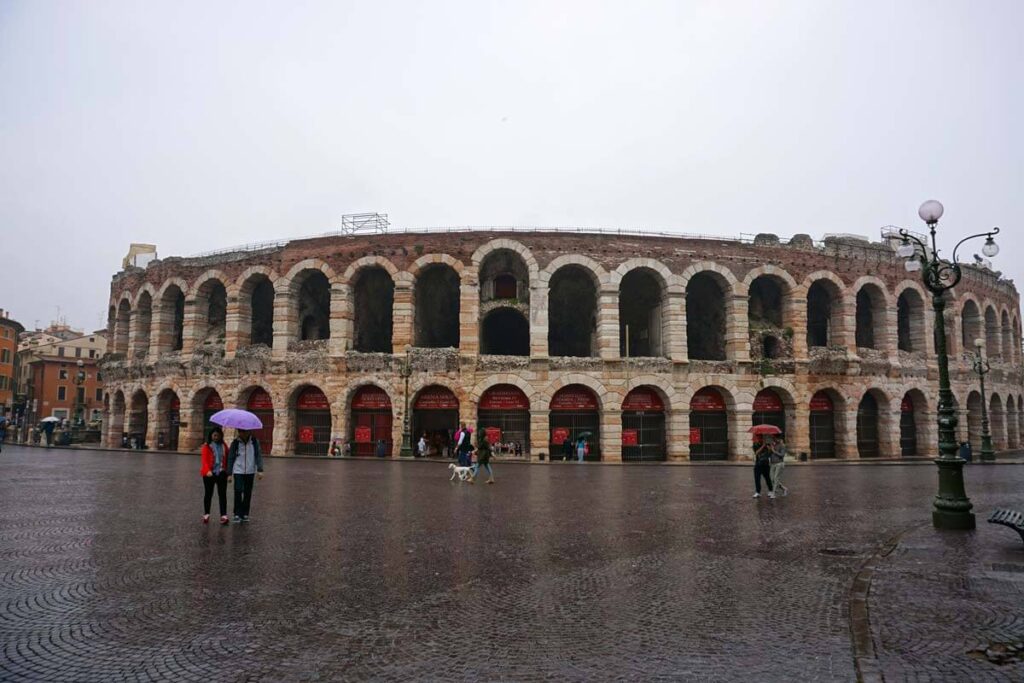
The Arena is still used today for performances, including the famous annual opera festival, which draws crowds from all over the world. If you’re visiting Verona, taking a tour during the day is great, but for the full effect, try to go to one of the performances. The acoustics are exceptional, so even without microphones, the sound carries well; sitting in the audience it’s easy to imagine yourself as an ancient Roman, enjoying the spectacle.
The Grottoes of Catullus, Lake Garda
We’ve imagined ourselves as ordinary Romans in Pompeii and Herculaneum, now let’s see how the other half lived in Ancient Rome. The Grottoes of Catullus, located on the beautiful Sirmione peninsula jutting out into Lake Garda , are not actually grottoes but the ruins of a grand Roman villa. Built around the 1st century AD, the villa had stunning panoramic views of the lake, with the Italian Alps in the distance.
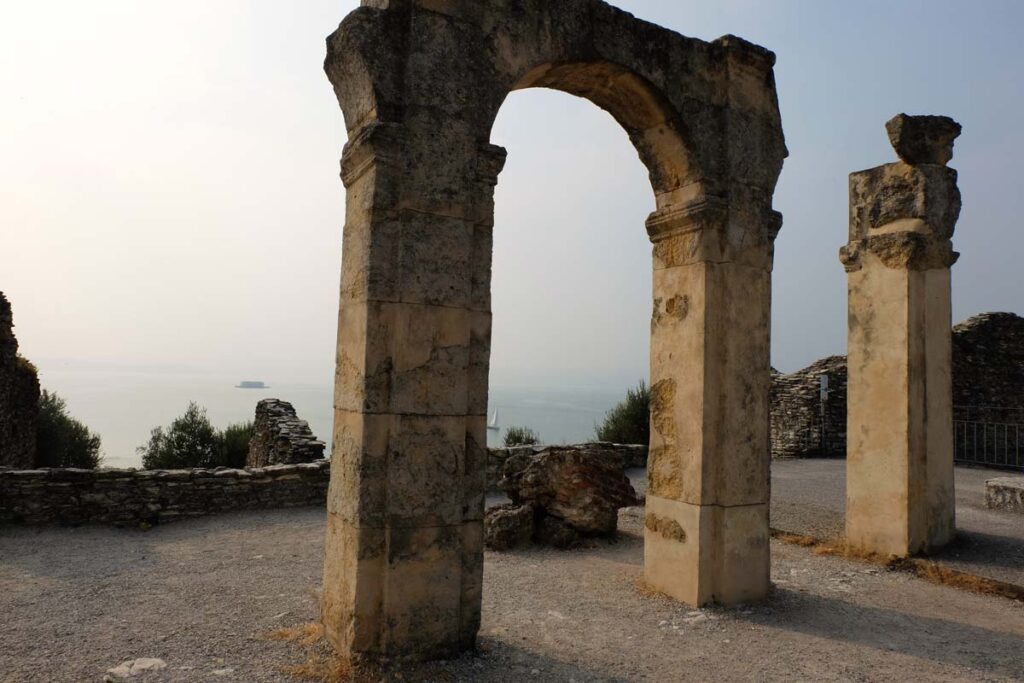
Contrary to its name, the villa is not definitively linked to the Roman poet Catullus, but it’s widely believed he could have spent time here. The site is quite expansive, featuring the remnants of a three-storey structure that includes residential quarters, porticos, thermal baths and a beautiful Olive Grove. Wandering around, I could definitely see myself as a wealthy Roman! There’s a small museum on-site to see artefacts discovered in the area.
Roman sites to visit in Britain
From the heart of the Roman Empire in Italy, let’s go to its most northerly outpost. Julius Caesar had led some small incursions into southern England in 55-54BC, but the Romans began their invasion of Britain in earnest in AD43-47. By AD70 they had conquered most of Wales and the north, and southern parts of Scotland in AD83.
There are hundreds of Roman ruins to visit in Britain (there are two within 20 minutes of where I live!) but there are two in particular that you simply cannot miss.
Hadrian’s Wall, Northumberland
Hadrian’s Wall, stretching across Northern England from the North Sea to the Irish Sea, is a remarkable feat of Roman engineering. Built on the orders of Emperor Hadrian in the 2nd century AD, the wall served as a defensive fortification for the Roman province of Britannia. Originally standing around 15 to 20 feet high and extending for 73 miles, it marked the northern boundary of the Roman Empire in Britain.
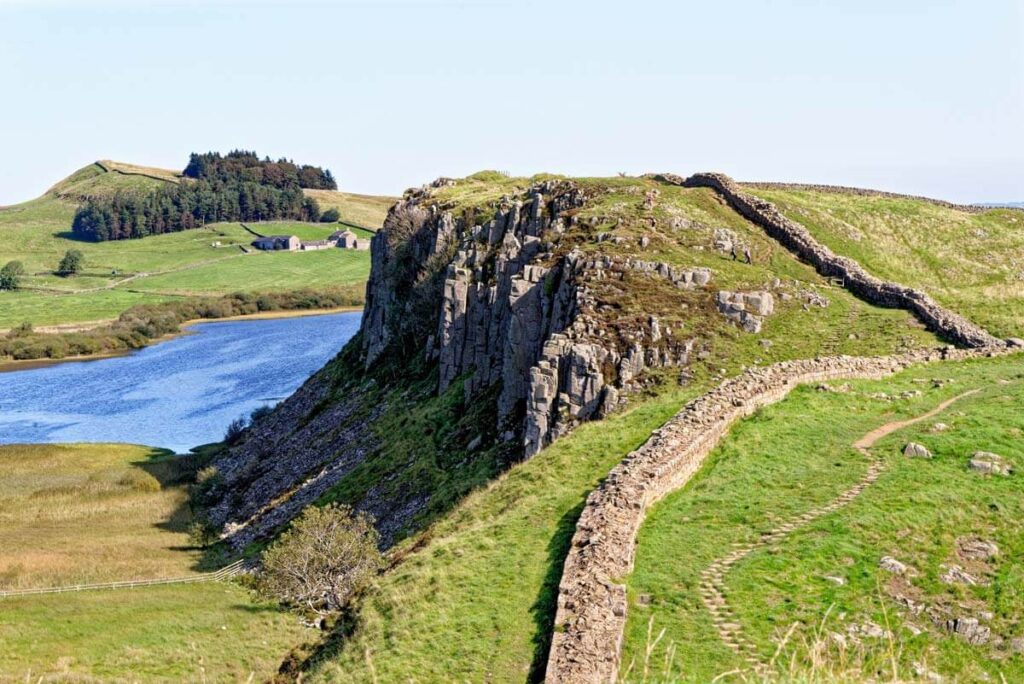
While much of the wall has eroded over time, significant sections still remain. The wall is more than just a barrier; it’s a complex military zone with forts, watchtowers, and settlements, many of which have been excavated and are open to the public.
Walking along the remaining stretches, you can almost feel the presence of the Roman soldiers who once patrolled it. At Housesteads, which is the most complete example of a Roman fort in Britain (and a popular destination for our school trips when I was a kid!), you can see how the 800 soldiers who were stationed here lived and worked.
Chester, Cheshire
In the UK, if a town has “Chester” in its name, then there’s a good chance that there’ll be something Roman to see, and that’s particularly true for the city of Chester. Chester, located in the North West of England, was founded as a fort, or ‘castrum,’ in 79 AD and was one of the main military bases during Roman Britain.
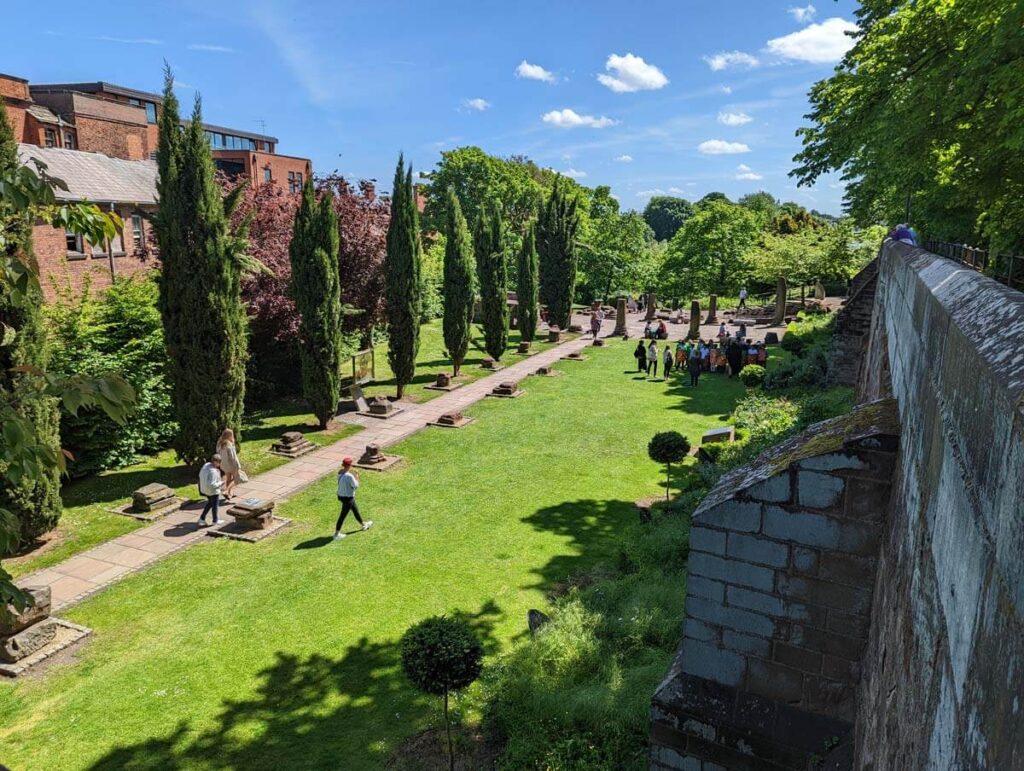
The city is perhaps best known for its Roman walls, the most complete in Britain, which you can walk along for nearly 2 miles, through the city, past the lovely cathedral and above Chester’s famous galleried shopping area, called the Rows. Parts of these walls even incorporate the original Roman masonry. Another highlight is the Roman amphitheatre, the largest stone-built example in the UK. It could hold up to 8,000 spectators and was likely used for military training as well as public spectacles.
The Deva Roman Experience museum has a reconstructed Roman street and hands-on exhibits, ideal for families and anyone keen to walk in the footsteps of the Romans.
The Roman Baths, Bath
The Roman Baths in Bath, England, are one of the best-preserved Roman spa complexes in the world. Built around natural hot springs , the site was a significant centre for relaxation and healing in Roman Britain. Constructed in the 1st century AD, the baths were part of a larger complex that included a temple dedicated to Sulis Minerva, a goddess revered for her healing powers. The baths show a unique blend of Roman and Celtic influences, as the invading Romans picked up elements of Celtic culture.
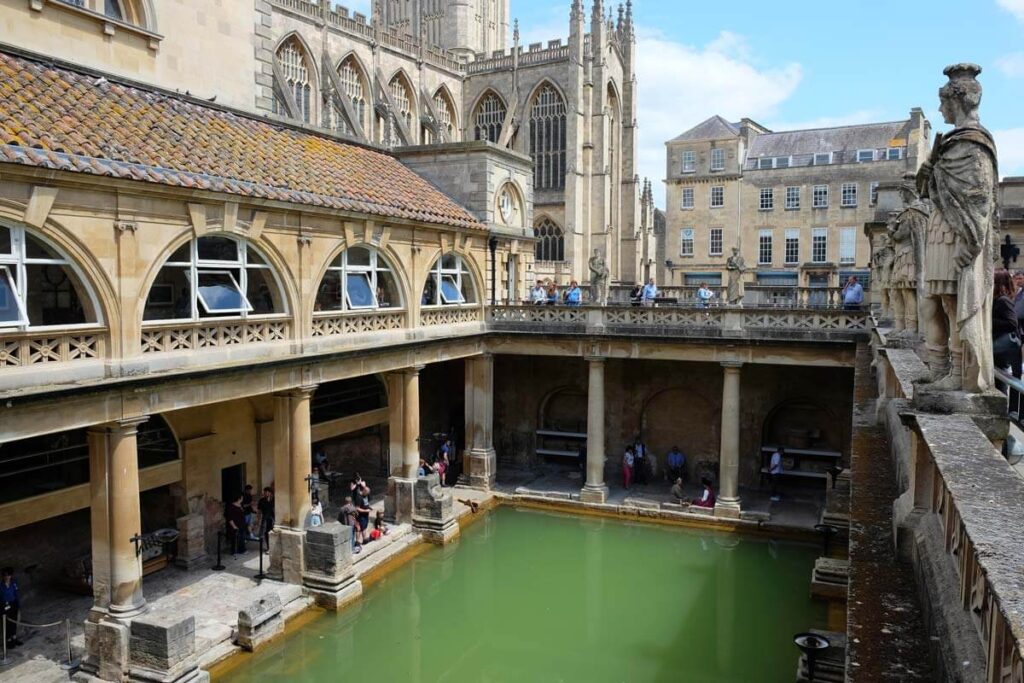
Today, the Roman Baths are one of the top things to do in Bath . Visitors can explore the Great Bath, which still contains the mineral-rich water, as well as the Sacred Spring, where offerings to the goddess were made. There’s also an extensive museum that showcases numerous discoveries, including the famous “curse tablets”, which are lots of fun to read!
Unfortunately it’s not possible to actually bathe in the Roman Baths, but you can indulge yourself with a visit to Bath’s Thermae Bath Spa , which uses water from one of Bath’s other hot springs.
Roman sites in France
From the north of England, lets head to the south of France. The Occitanie and Provence regions are home to many of France’s best preserved Roman sites.
Pont du Gard, near Nîmes
The Pont du Gard is an ancient Roman aqueduct in southern France. Built in the first century AD, it’s an engineering marvel and one of the most impressive ancient Roman structures in Europe.
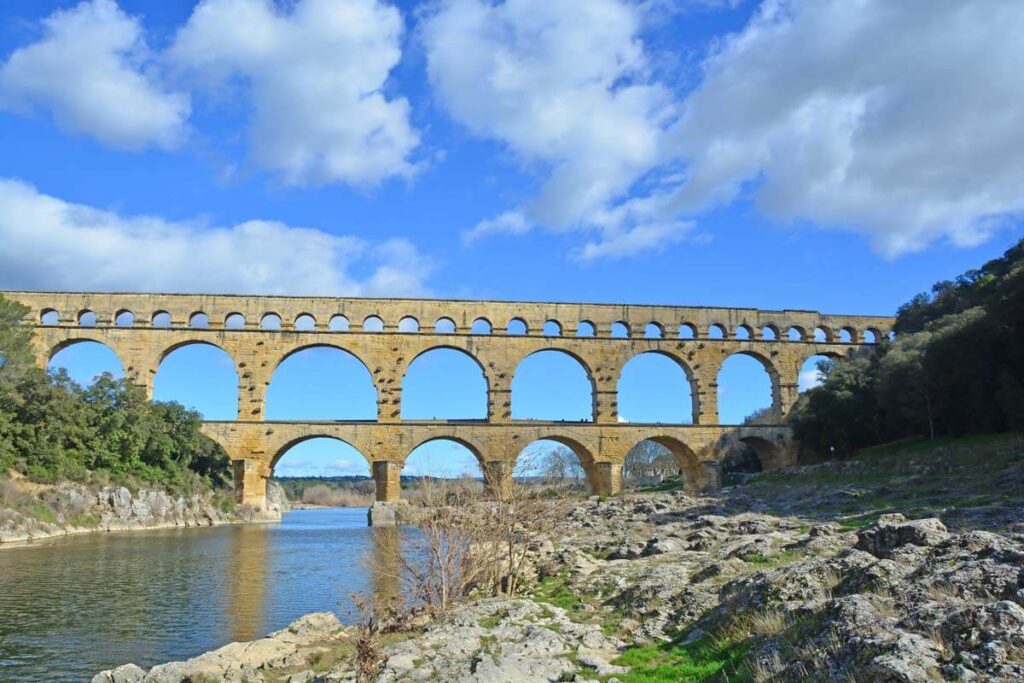
Rising to a height of 48.8 metres, it spans the Gardon River and consists of three tiers of arches. The craftsmanship is so precise that the massive limestone blocks were fitted without mortar, and it’s not surprising that it’s now a UNESCO World Heritage site.
Just a short distance away, the city of Nîmes boasts some of the most beautiful and impressive ancient Roman sites in Europe. The Amphitheatre of Nîmes could originally hold up to 24,000 spectators and featured a range of events from gladiator fights to public executions, while the Maison Carrée is a stunning Roman temple.
Théâtre Antique d’Orange, Orange
The Théâtre Antique d’Orange is one of the best preserved Roman ruins in France. Built in the early 1st century AD, it could accommodate up to 10,000 spectators and was primarily used for theatrical performances and musical shows.
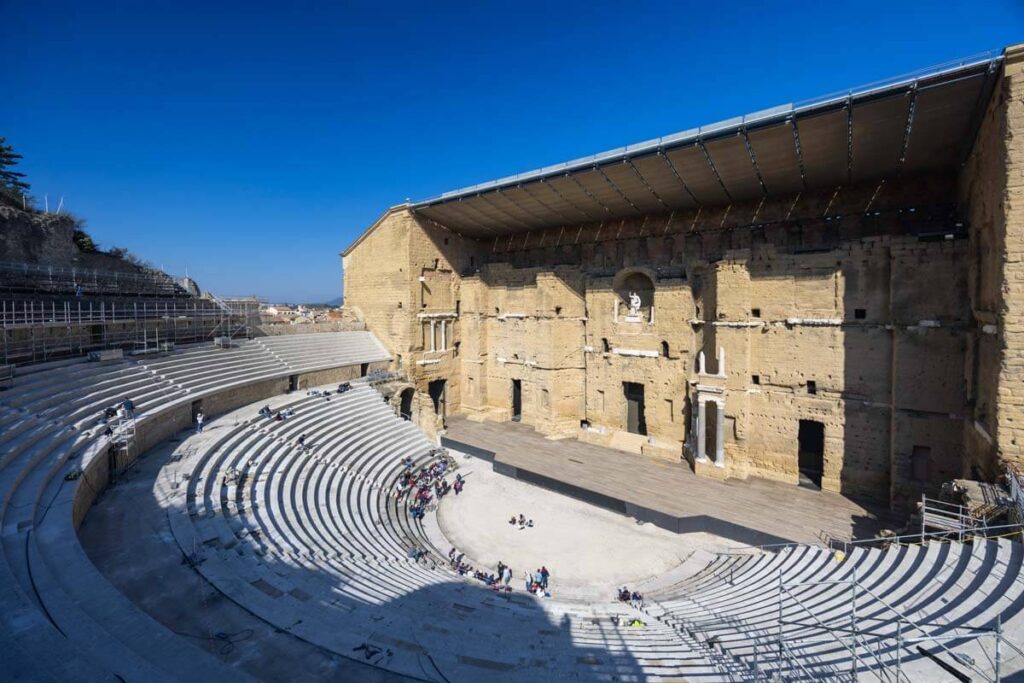
The theatre’s most striking feature is its enormous stage wall, which enhances the venue’s acoustics and provides a stunning backdrop for performances. Today, the theatre is not just a historical site but also hosts live events like the renowned Chorégies d’Orange opera festival.
Roman ruins in Greece
While you might be keener to see ancient Greek ruins when you’re in Greece, there are some beautiful Roman ruins to see too. The Roman presence in Greece can be traced back to the 2nd century BC, starting with the Roman victory over the Kingdom of Macedonia in the Macedonian Wars and ending with Greece becoming a province of the Roman Empire by 27BC.
Roman Agora, Athens
The Roman Agora, located in the shadow of the Acropolis in Athens , was constructed in the 1st century BC. Funded by Julius Caesar and Augustus, it served as the new commercial centre of the city, taking over many functions of the older Greek Agora.
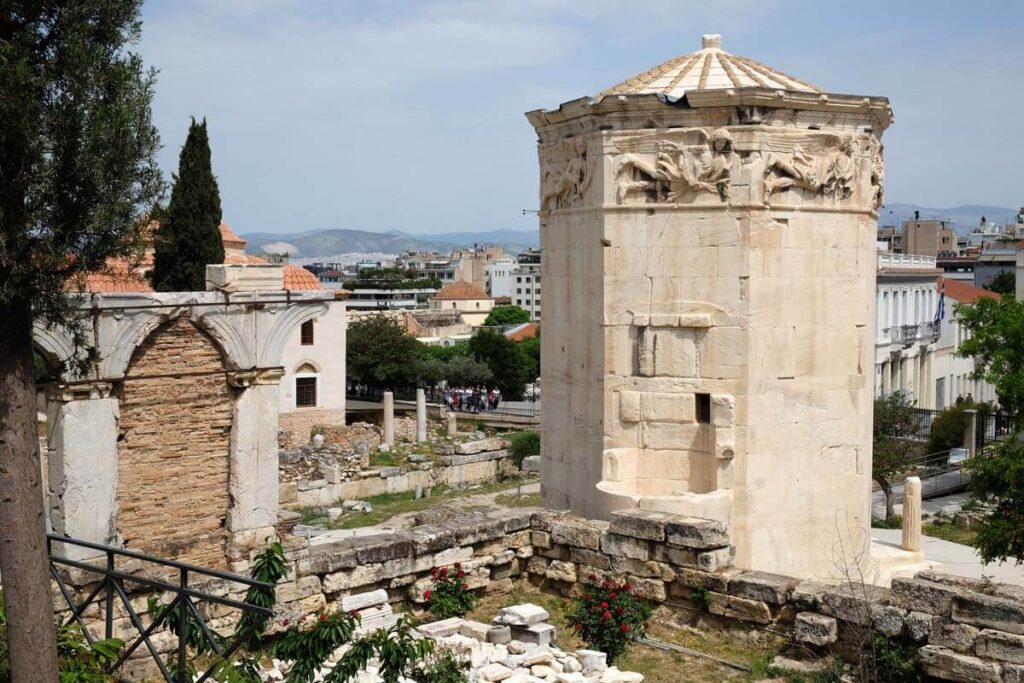
The Roman Agora is known for its Gate of Athena Archegetis, a grand entrance made up of four Doric columns, and for the Tower of the Winds, a beautiful octagonal marble clocktower that also served as a weather vane and calendar.
Roman Agora and Arch of Galerius, Thessaloniki
The Roman Agora in Thessaloniki, Greece, built in the 2nd century AD, served as the city’s social and commercial hub. Today, it offers a glimpse into urban life in the Roman Empire with its well-preserved remains, including a theatre and shops.
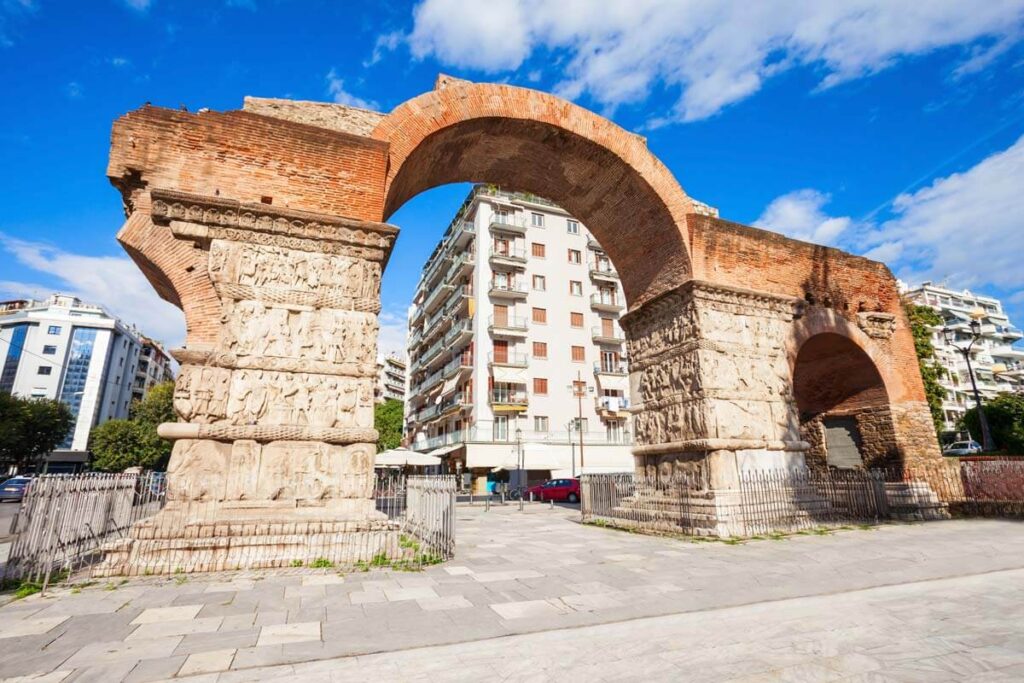
Nearby stands the triumphal Arch of Galerius, constructed in the early 4th century AD to commemorate Emperor Galerius’s victory over the Persians. This triumphal arch is renowned for its intricate reliefs depicting scenes from the campaign.
Roman ruins in Germany
Germany is more often associated with fairytale castles than Roman archaeological sites, but there are some great Roman places to see in Germany. Germany was never fully integrated into the Roman Empire, but the Romans did make significant inroads, particularly along the Rhine River, which served as a natural frontier for the empire.
The region was largely occupied by various Germanic tribes, and the Romans established military camps and trading outposts to control and defend their territory.
Fortress of Saalburg, near Frankfurt
Saalburg is a reconstructed Roman fort located near Bad Homburg in Germany. Originally built around 90 AD, it served as part of the Limes Germanicus, a line of border fortifications separating the Roman Empire from the Germanic tribes. The Saalburg housed around 600 Roman soldiers and acted as a strategic base for patrols.
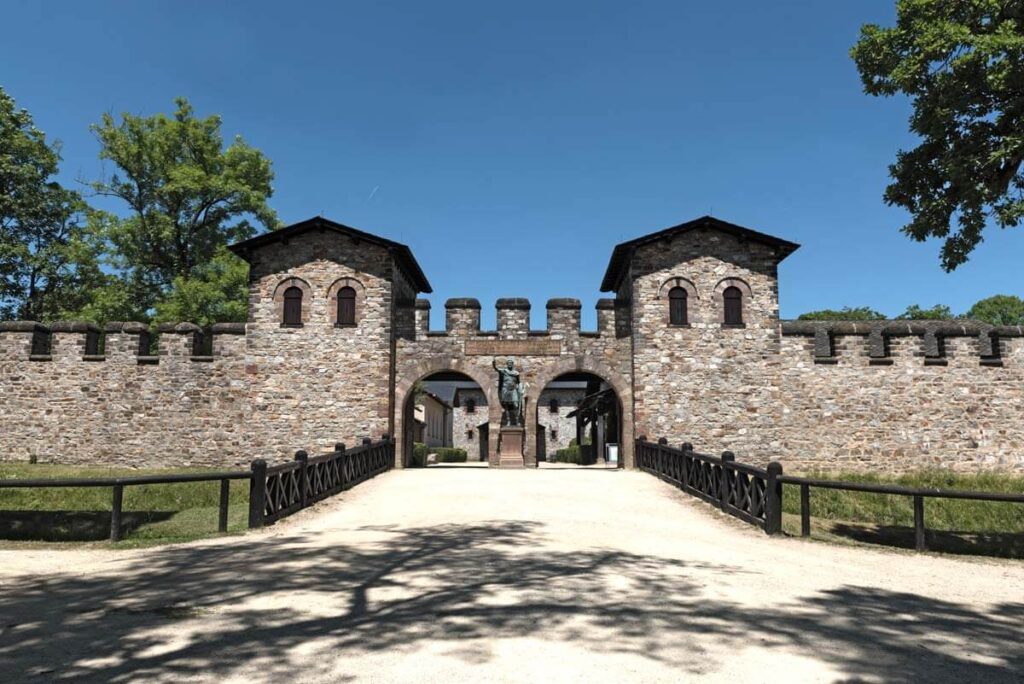
Abandoned in the 3rd century, the ruins were excavated and rebuilt in the early 20th century – the only one in the world to be so fully reconstructed. Today, it operates as a museum, offering visitors a unique chance to explore how Roman centurions lived, worked and defended the edges of the Roman empire.
Porta Nigra
The Porta Nigra, or ‘Black Gate’, is an enormous Roman city gate located in Trier, Germany’s oldest city. Built around 170 AD from sandstone blocks without mortar, its name comes from the darkened colour of the stone caused by centuries of exposure. Originally part of a larger fortification, it was used for both defensive and administrative functions.
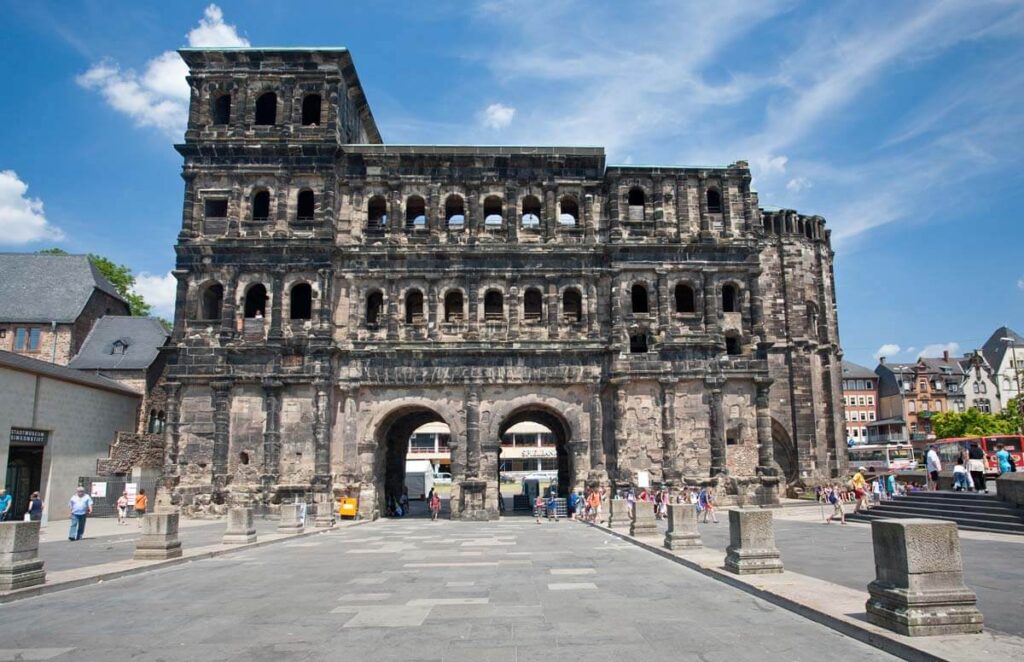
During the Middle Ages, it was transformed into a church, which likely saved it from destruction. Today, the Porta Nigra is a UNESCO World Heritage Site and one of the best-preserved Roman gates in existence. It offers visitors an authentic glimpse into Roman architecture and engineering.
Roman sites in Spain
The Romans arrived in Spain in the 3rd century BC and their influence lasted for over six centuries, shaping the region significantly. Known as Hispania under Roman rule, Spain was a crucial source of minerals, particularly silver, and became a vital part of the Roman economy. Cities like Seville, Barcelona, and Tarragona were established during this period, and their Roman heritage is still visible today.
Aqueduct of Segovia
The Aqueduct of Segovia is one of the best-preserved Roman aqueducts in Europe. Built around the 1st century AD to transport water from the Rio Frio river to the city, this engineering marvel spans 818 metres and is built of over 20,000 granite blocks, held together without mortar.
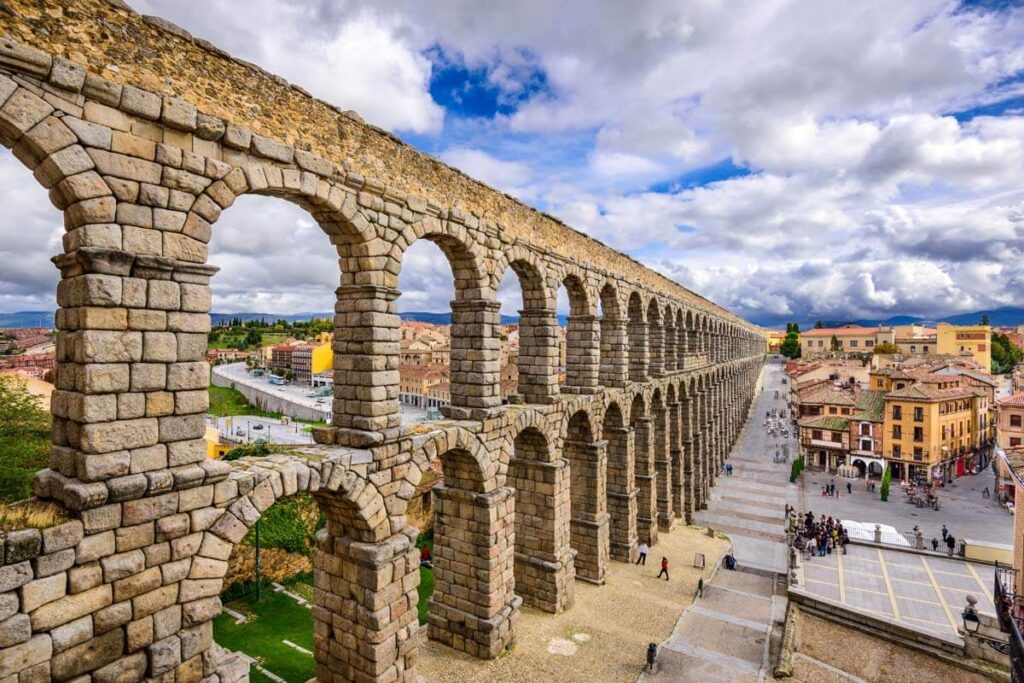
With its highest point reaching 28.5 metres, the structure comprises an astonishing 167 arches in two tiers. Now a UNESCO World Heritage Site, the ancient aqueduct is a must-visit for anyone travelling to Segovia.
Tarraco, Tarragona
Tarraco, now modern-day Tarragona, was a significant Roman settlement in Spain’s Catalonia region and served as the capital of the Roman Empire in the Iberian peninsula. As a vital port and administrative centre, its UNESCO-listed ruins offer a rich glimpse into Roman life.
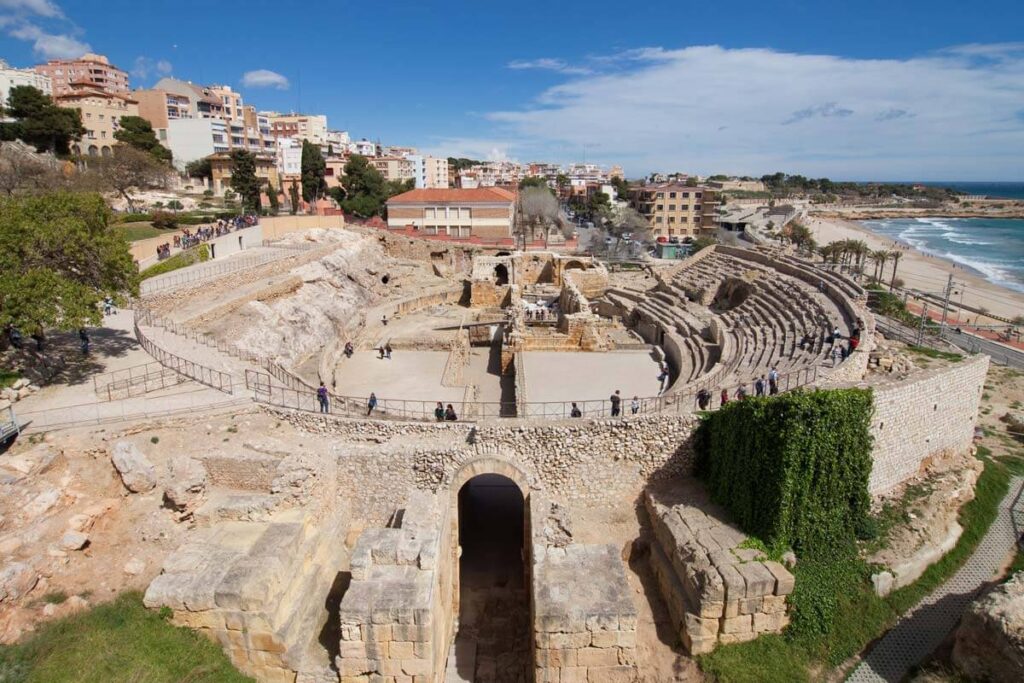
The seaside amphitheatre, which was capable of hosting 14,000 spectators at gladiatorial contests and public events is still an impressive sight. The city’s Roman walls, initially built in the 3rd century BC, are around four kilometres long and remain largely intact.
Mérida, located in the Extremadura region of Spain, has one of the largest and most important archaeological sites in Spain. Mérida was once the Roman city of Emerita Augusta and was founded in 25 BC by Roman Emperor Augustus to provide homes for soldiers who had fought in the Cantabrian Wars. The city served as the capital of the Roman province of Lusitania and was among the largest cities in Hispania.
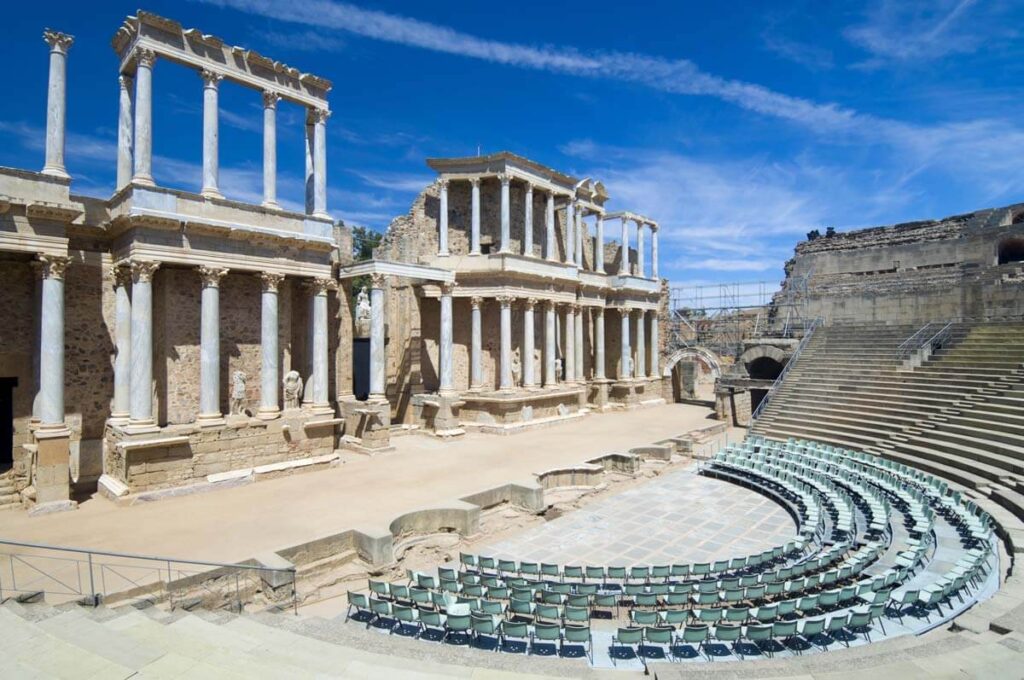
Today, it’s renowned for its extensive and well-preserved Roman ruins and is one of the most-visited ancient sites in Spain. Roman ruins to visit in Mérida include the Roman Theatre , which was capable of holding 6,000 spectators and still hosts performances during the Mérida Classical Theatre Festival. Mérida’s Roman Bridge , which spans the Guadiana River, is one of the longest of its kind.
The city is also home to the National Museum of Roman Art , which displays a collection of artefacts found in and around Mérida.
Antiquarium, Seville
The Antiquarium of Seville is an underground museum located in the city centre, underneath the famous Metropol Parasol . The Antiquarium showcases Roman and Moorish ruins that were discovered during construction work in 2009 and gives a glimpse into Seville’s ancient past.
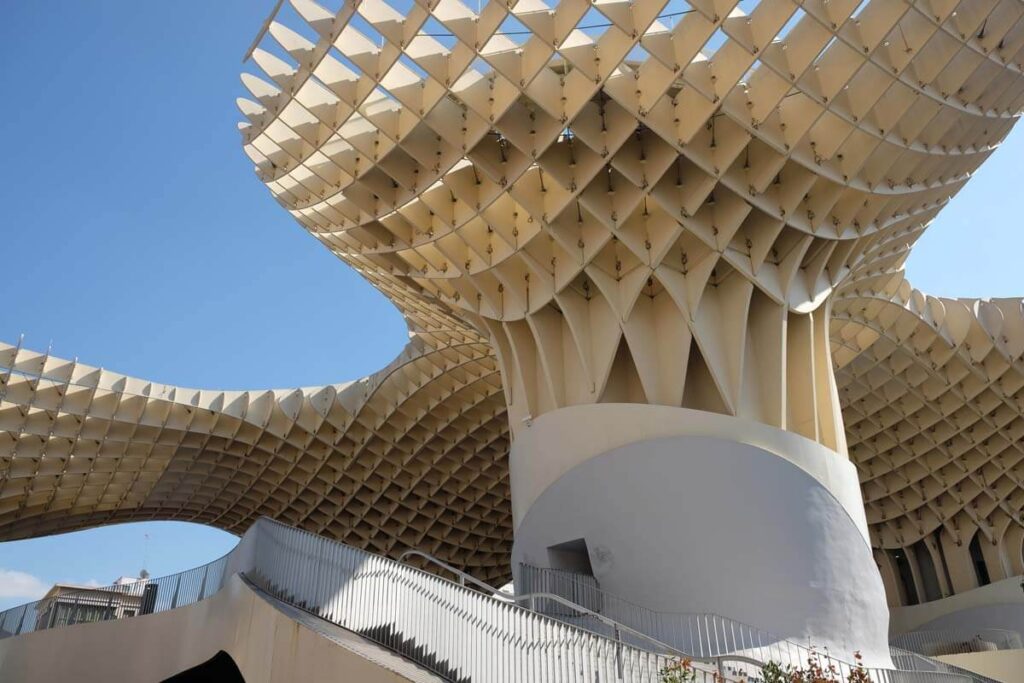
If you visit the Antiquarium you’ll be able to see well-preserved Roman mosaics, pieces of the city walls and even a Roman-era fish salting factory.
Roman ruins in Croatia
The Romans first arrived in what is now modern-day Croatia during the 1st century BC, initially focusing on the coastal areas and the Adriatic Sea before extending their control inland. Today, visiting Croatia’s Roman sites are some of the most popular things to do in Croatia.
Amphitheatre of Pula
The Pula Amphitheatre, often referred to as the Arena of Pula, is one of the most impressive Roman amphitheatres in Europe and a popular tourist attraction. Built during the 1st century AD, it could accommodate up to 20,000 spectators and was primarily used for gladiator fights and other public spectacles.
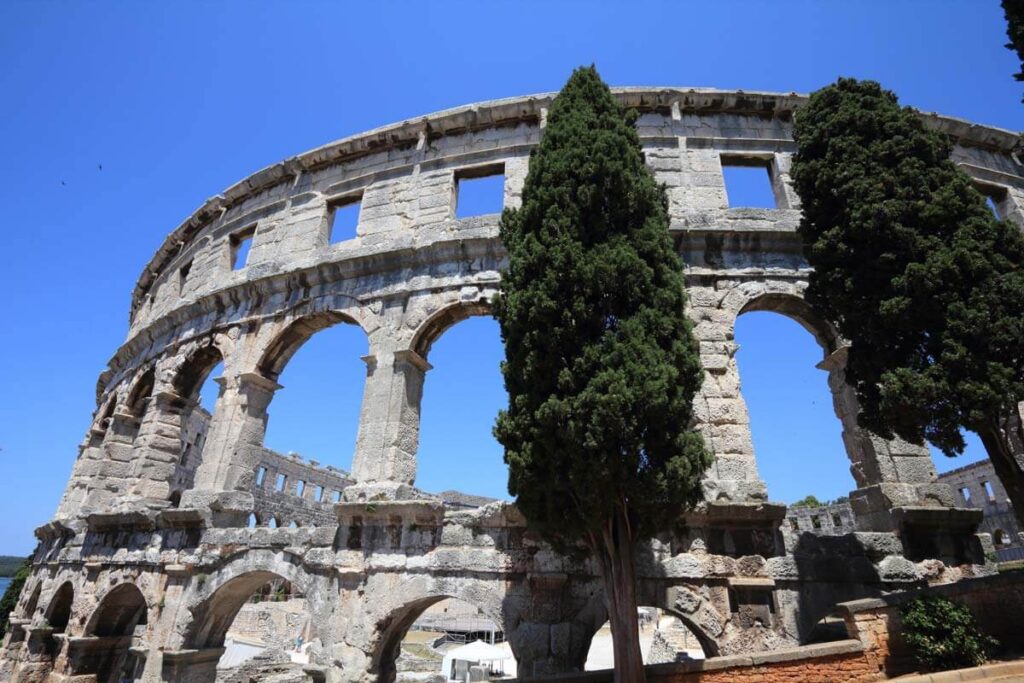
The amphitheatre’s oval shape and towering outer walls are constructed from local limestone, and it features an underground section that once housed animals and gladiators before contests. It’s still used today for concerts and cultural events.
Diocletian’s Palace, Split
Diocletian’s Palace in Split, Croatia, is an extraordinary example of Roman architecture, built between the late 3rd and early 4th centuries AD. Commissioned by Emperor Diocletian as a retirement residence, the palace is more like a fortified town. Its layout consists of a rectangular shape with two main streets which cross at a central square. If you visit, you’ll be able to see intricately carved columns, sphinx statues from Egypt, and a mausoleum that later became the Cathedral of Saint Domnius.
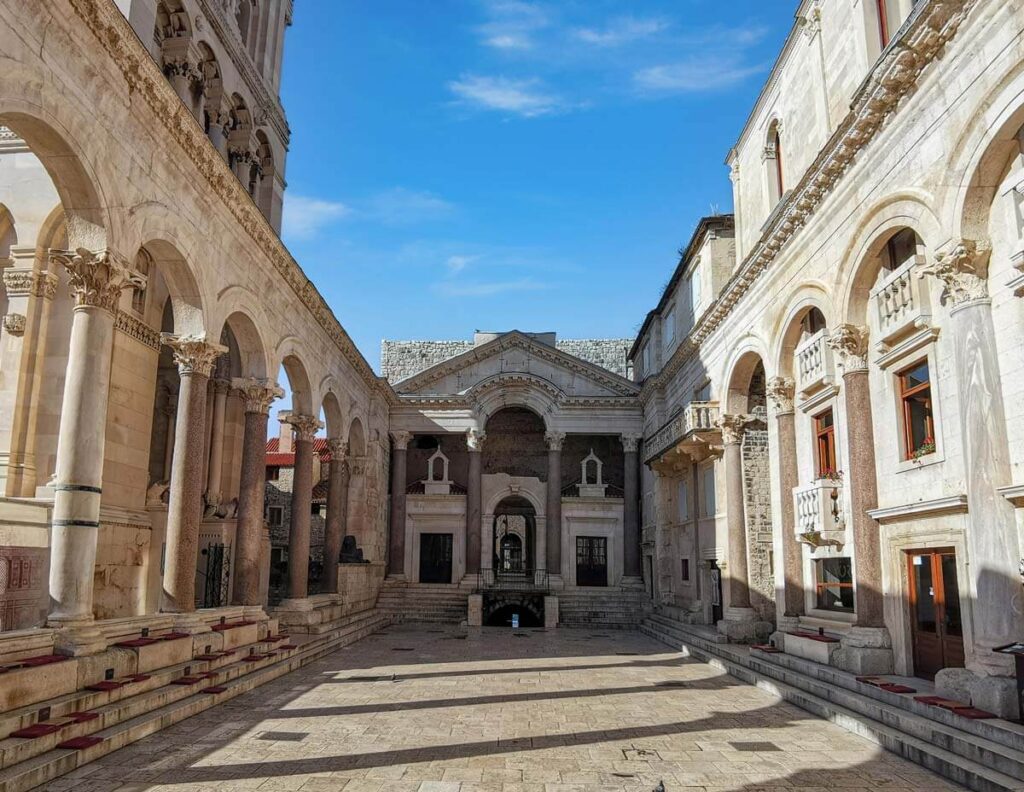
Over the years, the palace has been integrated into Split’s old town, with apartments, shops, and cafes occupying many of the ancient Roman chambers. Like many of the places to visit on this list of the best places to see Roman ruins, it’s also a UNESCO World Heritage site.
Roman sites in Turkey (Türkiye)
Turkey, which was known as Asia Minor, was a significant region in the Roman Empire, with important cities like Troy (yep, the one with the horse). If you’re in Turkey on holiday, there are lots of Roman sites that you can visit, and many of them are easy day trips from the resorts on the coast.
Ephesus, near Kuşadası
Along with Pompeii, Ephesus is my favourite Roman site that I’ve been to, and the first one I visited outside the UK. I went to Ephesus when I was a fresh-faced 18 year old who should have been more interested in drinking on Kusadasi’s bar street than dragging my friend around ancient Roman ruins!
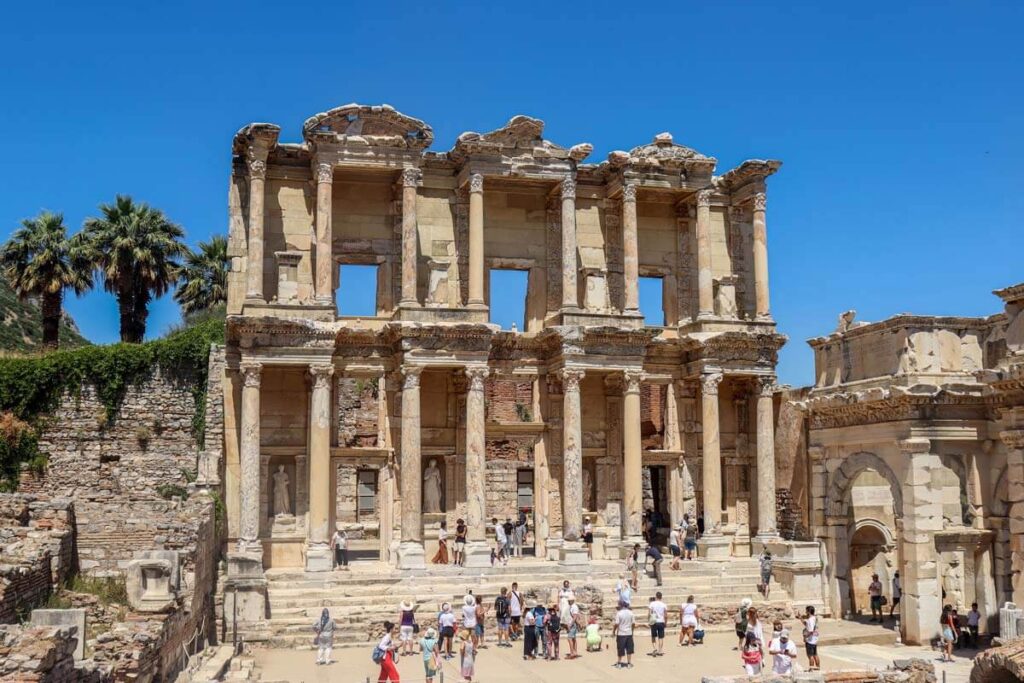
Ephesus was one of the most important cities in the Roman Empire. Established as a Greek colony in the 10th century BC, it became a major Roman city, renowned for its grand architecture and as a centre for trade and learning. The site is home to many remarkable ruins, but the beautiful Library of Celsus is the most famous building in the old city. Today, Ephesus is a UNESCO World Heritage site and an easy day trip from the resorts on Turkey’s Aegean Coast.
Side, Mediterranean Coast
Side, situated on Turkey’s southern coast, is a resort town that’s also a treasure trove of Roman history. Originally a Greek settlement, it flourished under Roman rule from the 1st century BC. Among its most impressive ruins is the ancient theatre, capable of seating around 15,000 to 20,000 spectators.
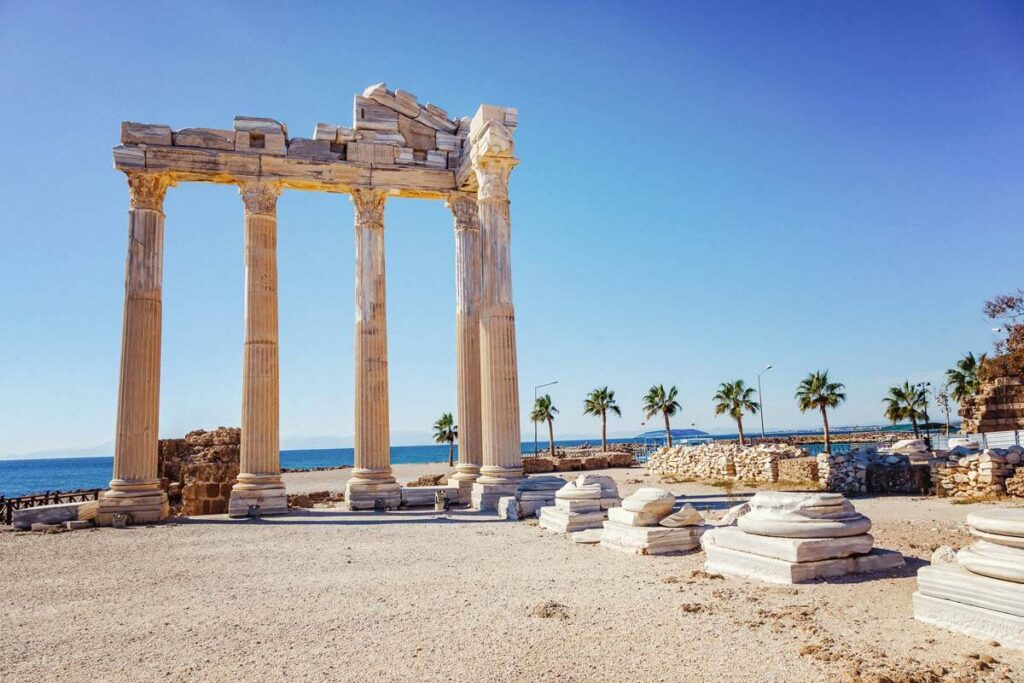
Another notable Roman landmark in Side is the Temple of Apollo, which stands near the harbour and offers stunning sunset views. There are also remnants of Roman baths, agora, and a nymphaeum (fountain).
Hierapolis, southwestern Turkey
Hierapolis has one of the most beautiful and dramatic locations of all the Roman sites on this list. Located in southwestern Turkey, you can find the ruins of the ancient city on the hill above the white travertine terraces at Pamukkale. The pools at Pamukkale are filled with natural thermal water, and it was the hot springs that attracted the Romans to the area.
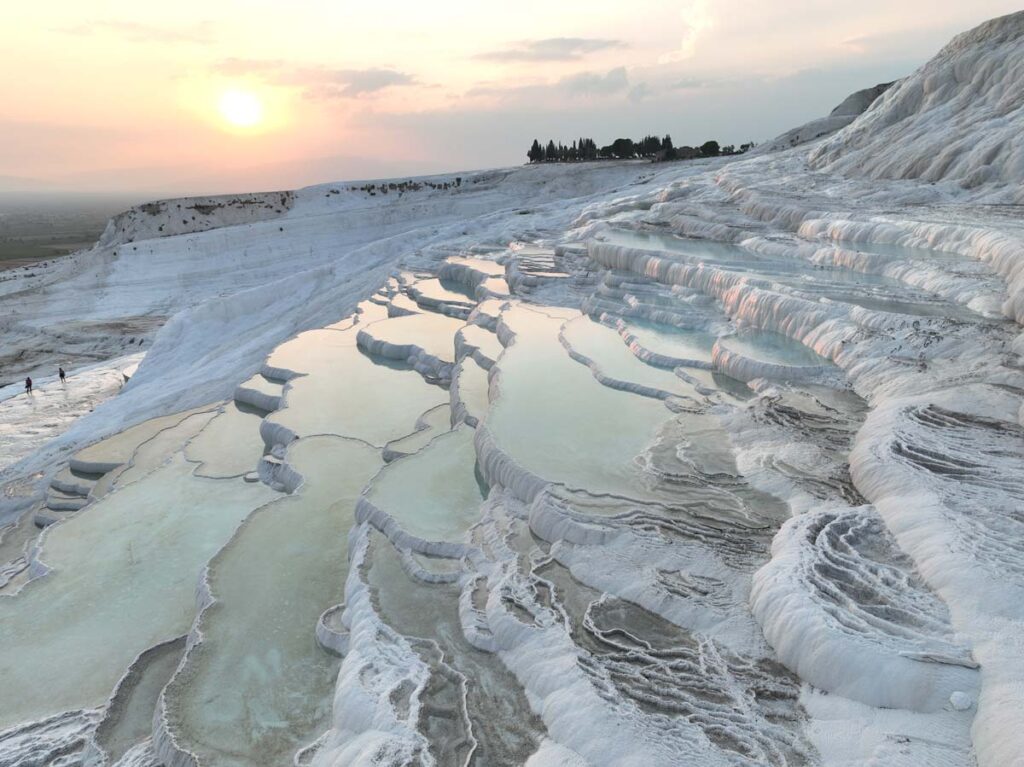
The archaeological site at Hierapolis boasts a well-preserved ancient theatre, Roman baths, and a grand necropolis with over 1,000 tombs. Hierapolis is a UNESCO World Heritage Site, visited both for its remarkable Roman ruins and its unique natural features. Visiting Hierapolis and Pamukkale is an easy day trip from coastal resorts.
More places to walk in the ancient Romans’ footsteps in Europe
Sofia, bulgaria.
In Sofia, the capital of Bulgaria, remnants of its Roman past as the town of Serdica are still visible and integrated into the modern city centre. The partially-excavated site of the Serdica Amphitheatre can be seen in the basement of the Arena di Serdica Boutique Hotel (the hotel appears to be closed but recent reviews say you can see it through the windows).
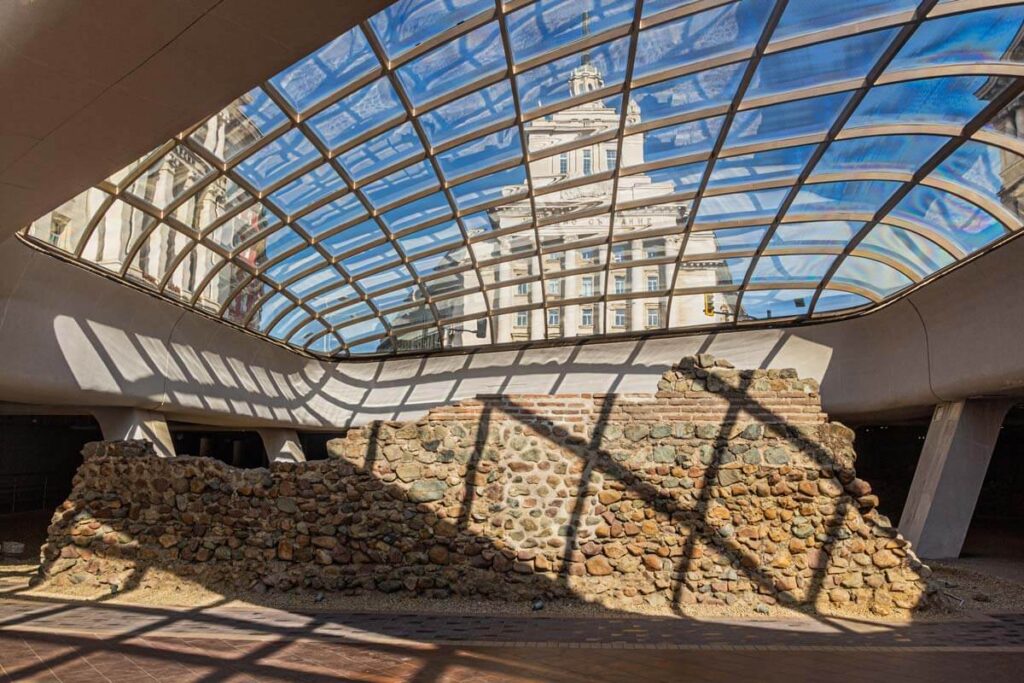
If you’re in Sofia, then don’t miss visiting Serdica Metro station . The modern railway station is in the heart of what was Serdica; you’ll walk through part of the excavated town to get to your train.
Conimbriga, Condeixa-a-Nova, Portugal
Conimbriga is one of the largest and best-preserved Roman settlements in Portugal, located near the city of Coimbra. Dating back to the 2nd century BC, the site was partially abandoned during the 5th century AD due to invasions.
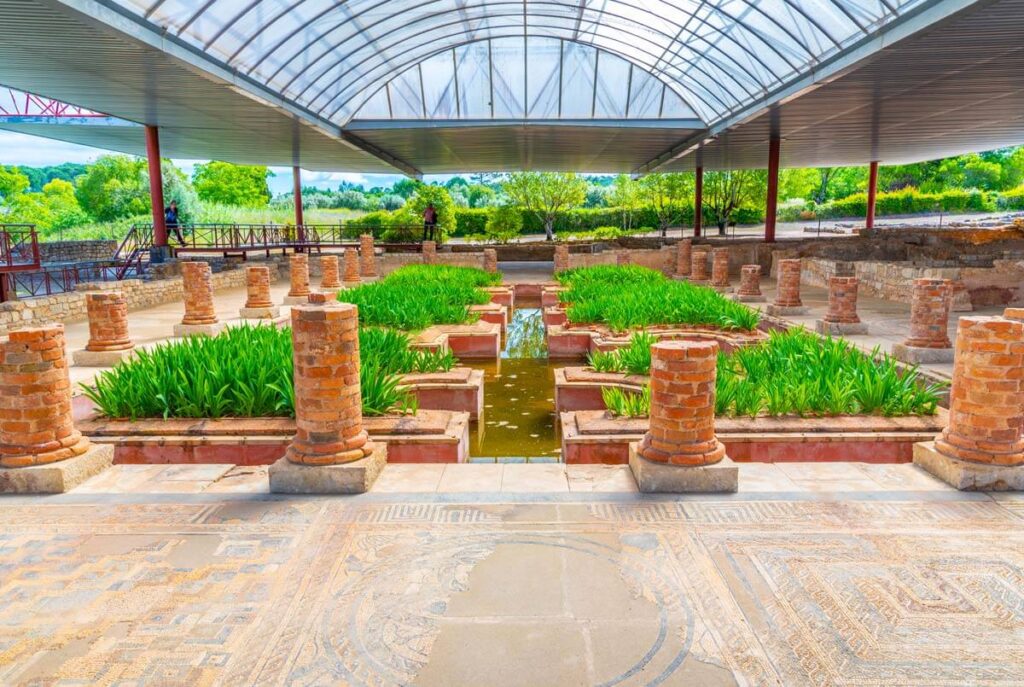
The highlight of Conimbriga is its extensive collection of mosaic floors, displaying intricate patterns and vivid colours. You’ll also find well-preserved building foundations, including those of residential homes and public baths. The site also features a forum, a basilica, and defensive walls that were built during later stages of occupation.
Final thoughts on the best Roman sites to visit in Europe
I hope you’ve found this list useful, and perhaps added a few more Roman sites to your travel plans! If your favourite Roman town, amphitheatre, fort, temple or villa isn’t on this list, then please tell me about it in the comments!
Save for later or share with a friend
Leave a comment Cancel reply
Save my name, email, and website in this browser for the next time I comment.
This site uses Akismet to reduce spam. Learn how your comment data is processed .
About Helen
14 tips for visiting Pompeii (plus how to climb Vesuvius)
Pompeii or herculaneum: which site is better to visit.
- Skip to main content
- Skip to primary sidebar
- Skip to footer

Italy Travel Experts Tours and Vacations
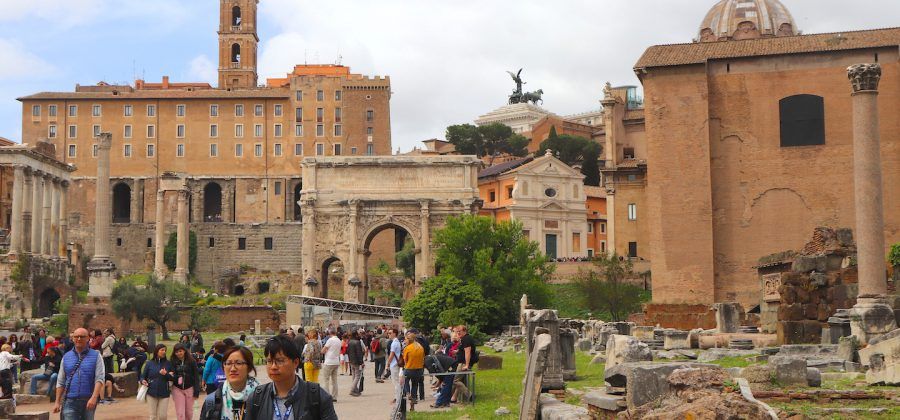
Top 13 Things To See in the Roman Forum
Mickey Iacono-Walsh Last Updated: November 17, 2022
Are you planning to explore the ancient city of Rome but not sure what to see in the Roman Forum? Written by a licensed guide of Rome, this series of articles covers all the things you should see in the Colosseum, Roman Forum, and Palatine Hill with explanations. Here’s what to look for as you explore the Roman Forum.
Pro Tip: Doing some research ahead of your trip to Rome? Bookmark this post on your internet browser. This way you can circle back to it when you’re exploring the Roman Forum. See our guide to Rome for more resources to help you plan your trip. Also, Check out our top-rated Colosseum tours , which include admission for the entire area, including Palatine Hill.
Things and Places To See in the Roman Forum
At this point, you’ll probably already have seen the Colosseum and Palatine Hill . We’ve created this list of must-see things at the Roman Forum to help guide you around this incredible archeological site. To start your journey through the Roman Forum, walk down toward the Arch of Titus.
13. Via Sacra
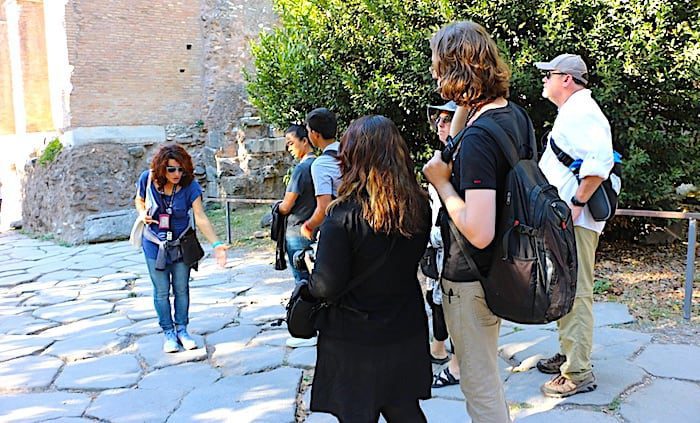
The road running through the arch is the Via Sacra or sacred way. It was an important road as you can guess by its name. In ancient Roman times, triumphant marches were held after big victories, which happened often. These marches would travel down the Via Sacra and into the city.
The road saw considerable improvements over time. The rows of colonnades, for example, and other effects to highlight its importance. The Arch of Titus, the next destination, is one of those improvements.
One of the coolest details of the Via Sacra is that you can still see the wear and tear from Roman times on the pavers. You’ll see everything from its smoothness to the crevices that wagon wheels created over time. This is definitely one of the top things to see at the Roman Forum.
Address : Via Sacra
12. Arch of Titus
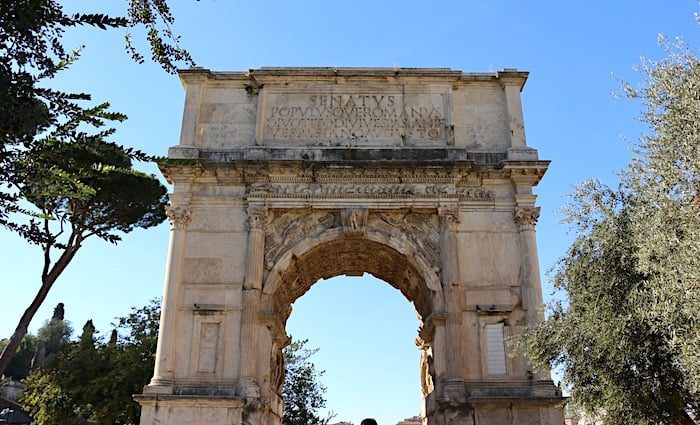
The Via Sacra extends into the Forum but not before passing through the Arch of Titus. Domitian built this arch to commemorate Titus’ famed victory that quelled the revolt in Jerusalem in which he brought 60,000 slaves and endless wealth back to Rome. As a result, they had the means to build the Colosseum.
The Arch of Titus is a considerable point of interest for many reasons. First is its position near the Colosseum on top of a hill. It is also one of only three arches that remain of the 36 original arches.
The arch gains significant interest from many people from Jerusalem or of Jewish descent because it details a major event in Jewish history. Rome controlled Judea at the time and they rebelled against the control. It had worked out pretty well for them a few hundred years earlier under the Maccabees so they gave it another shot.
Historians often refer to this war as the Great Revolt and it was exactly that. Eventually, the Romans succeeded in re-conquering Judea after breaking through three walls, which took seven months. It’s important to mention how the Romans treat war at this point.
If you tried to defend yourself but gave in fairly quickly and joined the Romans, then they treated you pretty well. It was a really good deal. They’d have wanted to take some spoils and possibly some wives, but losing would have been far worse. Victory against the Romans was also rare and often not long-lasting.
If you fought back too hard, on the other hand, you could expect far worse treatment. They’d sack your city, take everything you have, rape most of your population, and enslave as many people as they could transport back to Rome. That’s what happened in Judea. Over 60,000 slaves came back to Rome with Titus and, ultimately, built the Colosseum.
Beyond the horror story of the Roman war, the arch helps connect some historical dots. It verifies that Titus’ campaign happened and that he returned victoriously. Paper doesn’t hold up well over time, but stone does. Historians detailed most of this in writing as well as in detailed reliefs depicting the events.
Interior Decoration
On top of historical verification, the reliefs inside the arch show a huge leap forward in Roman artwork. You have to understand that at this point in history, A.D. 81, most people in Europe were living in cold wet huts fending for their lives. It was the Middle East that was prospering. The Gauls were trying to stay dry while the Romans were creating the illusion of space in travertine.
The illusion of space is when an artist uses your perspective against you to make an area look bigger and possibly even give the illusion of motion. Basically, it was baroque artwork 1,500 years before baroque artwork entered the scene. On the arch, you can see the procession of the Jews holding the menorah (seven candelabra) as they return to Rome as slaves.
On the other side, you see Titus on horseback triumphant over his enemies. In the center, look up and you’ll see the symbol of Rome, the Eagle, with wings spread. The arch is a must-see in the Roman Forum and Rome, in general.
Address : Arch of Titus
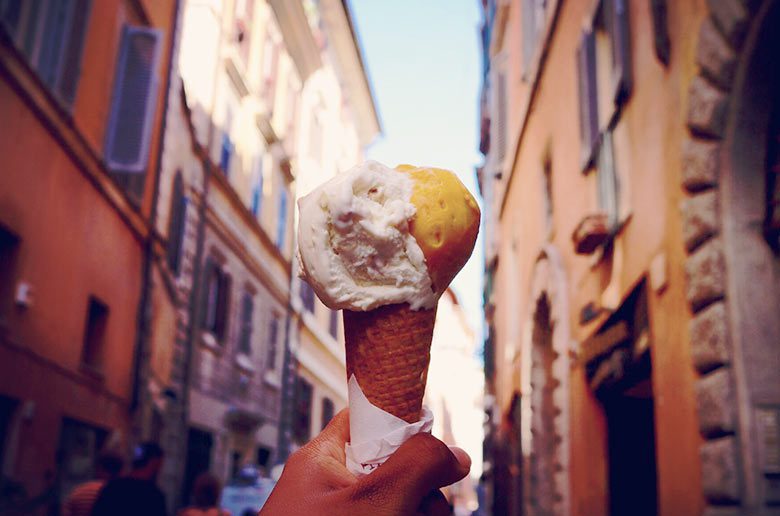
Best Seller
Try the Best Pizza and Gelato with our Prati Walking Tour
Experience Rome’s authentic flavors with our curated culinary tour of Prati, near the Vatican. Indulge in the finest pizza, pasta, cheese, and wine, including exclusive access to Pizzarium and other hidden gems.
Local Rome Food Tour in Trastevere Neighborhood
Are you looking for the best food tour in Rome? Embark on a Trastevere food tour that offers an excellent introduction to some of the best food in Rome. Led by a local foodie guide, visit some of our favorite restaurants and trattorie in Rome
Not ready to book a tour? Check out our Rome Guide for more info.
11. Temple of Venus
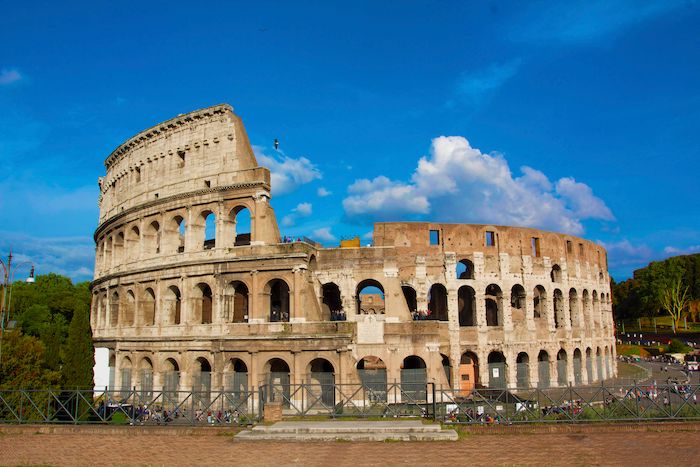
With the Arch of Titus at your back and the Colosseum to your front, you’ll see a structure to your left. Head to that building and work your way towards the Colosseum. There is a great balcony where you can take a picture like the one above. This is the Temple of Venus, a massive temple that Emperor Hadrian built.
Address : Temple of Venus
10. Basilica of Constantine (Temple of Maxentius)
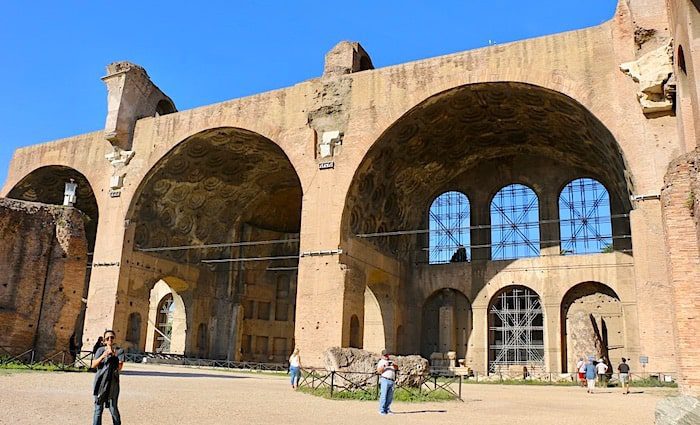
Originally the Basilica of Maxentius, this building was named for the emperor who ruled Rome before Constantine. The two of them fought a historic battle at the Milvian bridge, which is still standing today in the northern part of the city.
As the legend goes, Constantine saw a symbol burning across the sky on the eve of the battle. The next day, his soldiers drew the cross on their shields and they were successful. This victory was attributed the title of the first Christian victory ever.
The central nave of the building was an impressive 265 feet (80 meters) long and 83 feet (25 meters) wide. Today, only three arches can be seen. Originally, you can imagine there was a vaulted ceiling and another three arches symmetrically placed in front of the remaining three, creating an imposing, closed building. The entrance would have been at the southern end. At the northern end, there would have been a gigantic statue of Constantine himself.
In ancient Roman times, the word “basilica” signified a courthouse or a place to conduct business matters when the weather wasn’t permitting outside. The standard architecture consisted of a long nave, with apses on both sides, supported by huge columns. When Christianity became the main religion, they incorporated this architectural style into their churches and that’s where we get the modern meaning of the term “basilica” today.
Address : Basilica of Constantine
9. Temple of Romulus
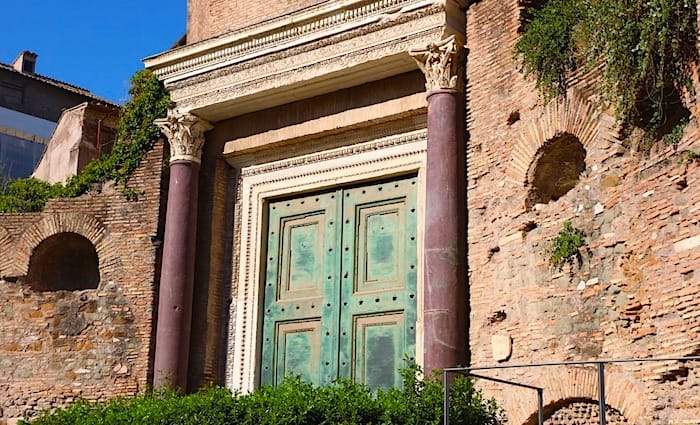
Don’t mistake this with the Romulus who founded Rome. The emperor Maxentius dedicated this temple to his son Valerius Romulus and deified him. Eventually, the emperors prohibited paganism and converted this temple into the Basilica of Santi Cosma e Damiano.
The bronze doors are original from the A.D. 309 structure. Such an old building still in such good shape deserves to be one of the top things to see at the Roman Forum.
Address : Temple of Romulus
8. Temple of Antoninus and Faustina
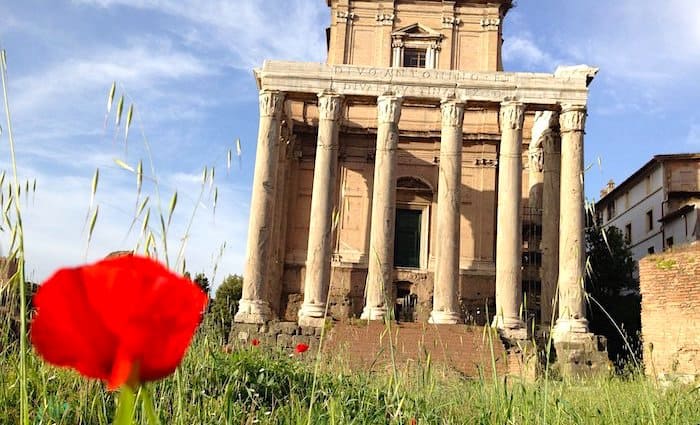
Known today as the Church of San Lorenzo in Miranda, this functioning church is adapted from the ancient Temple of Antoninus and Faustina. Though much of the structure is updated and rebuilt, the original portico encased by marble columns still stands.
Like many churches around Rome, they remodeled this church and built it upon its original structure. As with much of Rome, the various levels of the church reflect modern and ancient Rome. Another great example of this is the Basilica of San Clemente located on the other side of the Colosseum and just a 10-minute walk from the Forum.
Historians consider Antoninus Pius to be one of the five “Good Emperors”. This means that he died of natural causes and didn’t fill the tabloids of the time with crazy deeds. He was quite old already when he became emperor and lived a decent life out of the spotlight. His extremely beautiful wife, Faustina, died quite young. The emperor was so stricken with grief that he made her a goddess and built her a temple. This is a must-see at the Roman Forum for romantics.
Address : Temple of Antoninus and Faustina
7. Temple of Vesta and Eternal Flame of Rome
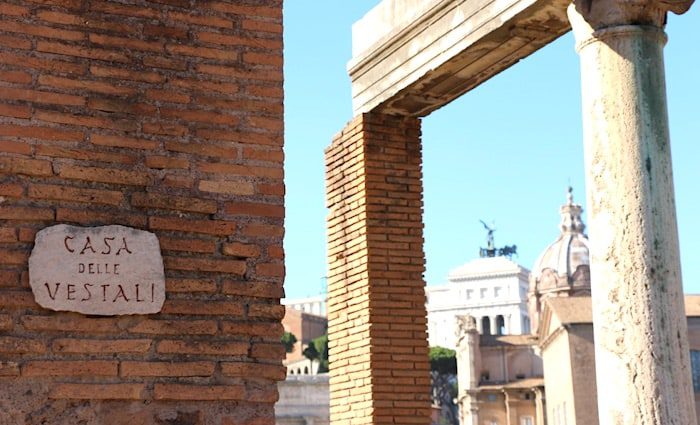
Facing the Temple of Antoninus and Faustina, turn around and you’ll see a circular altar in a shaded area on a slight hill. This is where the vestal virgins cared for the famed Eternal Flame of Rome. Originally surrounded by 20 Corinthian columns, the ruins are a good indication of what the temple may once have looked like.
Today, what remains of the temple is what Mussolini reconstructed in the 1930s after the Forum was excavated. Behind the temple, the House of the Vestal Virgins stands and leads its way up the Palatine hill. Vital to the faith of pre-Christianity Rome, the vestal virgins were priestesses who took a vow of virginity and served for 30 years, beginning in childhood.
Powerful women indeed, the vestal virgins had the power to free slaves and prisoners. Additionally, injuring one of them was punishable by death. The vestals also protected the eternal fire to Vesta, the Roman Goddess of Hearth.
As sacred as the temple was, Roman residents used Vesta’s eternal fire to kindle their own household fires. And that is why this is one of the top things to see at the Roman Forum.
Address : Temple of Vesta
6. Mamertine Prison
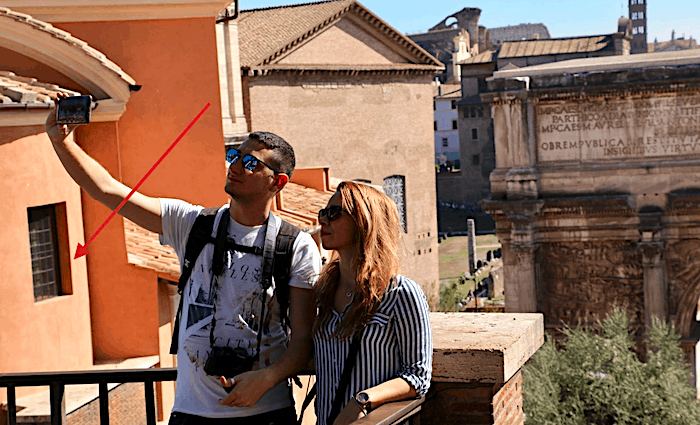
Just outside the northern-facing exit of the Forum, you’ll find the Mamertine Prison. It’s not actually inside the structure, so make sure you’re ready to leave as you won’t be allowed reentry. The prison is said to have been built as early as the 7th century B.C. and was originally referred to as the Tullianum .
According to Christian dogma, St. Peter was imprisoned here prior to his execution on the cross upside down. The prison was not intended for long-term incarceration. It was merely a place to be held prior to a trial and, eventually, execution. Its proximity to the Forum and Capitoline Hill made it accessible.
Peter was not the only prisoner of note to be held here. Jugurtha, king of Numidia, was held in the Mamertine Prison for a short stay and possibly died inside. Vercingetorix, the Gaul chieftain and nemesis of Julius Caesar who attempted unsuccessfully to unite Gaul against the Romans, also died here.
Most generals and high-profile leaders were pardoned after war with the Romans. This was part of their process of getting nations to capitulate. There were some cases of extreme hatred where Romans would be more demeaning to high-ranking opponents. The Mamertine Prison was a foul enough place to seek that revenge. Also, if you wanted to display your human spoils of war, the Palatine Hill was just a short walk away.
Address : Mamertine Prison
5. Temple of Castor and Pollux
Today, the three columns left on this temple are not much to look at, but the remains are spread around the city. The statues of these two dioscuri or demigods sit on either side of the steps leading up to the Capitoline Hill in all their glory.
They are the twin sons of Jupiter (Zeus) by a mortal mother. Hence making them demigods. They are known for their curly blond hair and white horses. Since they are strong young warriors, they were the perfect pair to be patrons to the equites or Roman knights.
Witnesses saw them aiding the Romans against the Latins at the Battle of Lake Regillus in 484 B.C. Later, they were seen in the city of Rome watering their horses at the Juturna Spring. The origin of their temple is where that spring once was but it has been enhanced and renovated multiple times.
The twins represented much of what it meant to be Roman. They were loyal to one another and fought bravely. Romans, like Christians, often chose figures that mirrored their morals and virtues.
Address : Temple of Castor and Pollux
4. Arch of Septimius Severus
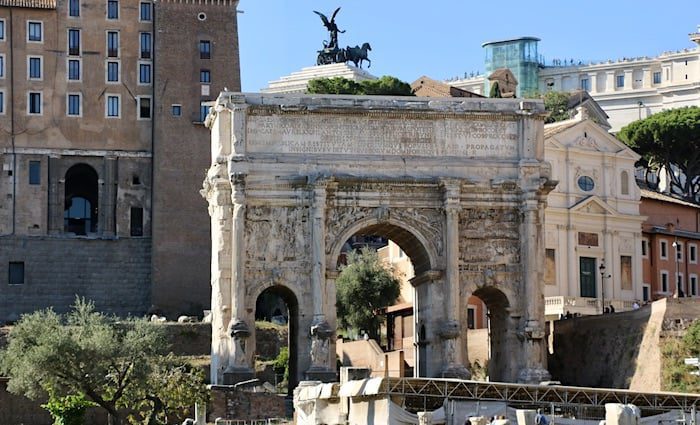
Built in A.D. 203, the Arch of Septimius Severus is one of the biggest arches in Rome. It stands as a testament to Roman hegemony in the ancient world. At this time, the Roman Empire had come to the end of its golden years and would begin to slowly deteriorate from here. Although, they didn’t know it then. For the majority of the Roman world, the Eternal City would last forever.
Emperor Septimius Severus had this arch constructed to commemorate his victory over the Parthians (modern-day Iran). The victory was bittersweet since that region had defeated a Roman army almost 300 years earlier under the leadership of Marcus Crassus. During that defeat, Crassus paid dearly with his life. He was captured and molten gold was poured down his throat to show his greed.
The richly decorated arch was also dedicated to Severus’ two sons Caracalla (who later became emperor himself) and Geta. When Septimius died, Caracalla killed his brother Geta to become the sole ruler. All monuments to Geta and any mentions of him were erased from the history books, including on the arch itself.
Address : Arch of Septimius Severus
3. Temple of Saturn
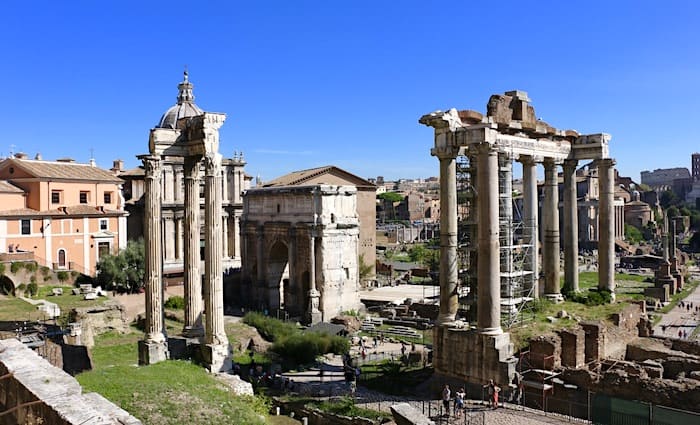
The current temple dates from the 4th century A.D. We know this because of the inscription on the architrave, which states that the Senate had rebuilt this statue after a big fire. The original temple on this same spot was built in 497 B.C.
Today, all that remains is the podium on which the temple stood and eight huge columns of granite and marble. You’ll have to use your imagination, but you can see this temple was once a great and revered place of worship.
The Roman god Saturn supposedly has his roots in the ancient Greek pantheon as the god Kronos. There’s some mystery surrounding what he was actually worshipped for, however, he was represented veiled with a sickle or pruning knife. The practical function of the temple was as the public treasury, which lasted all throughout the Republican period and, on a more limited basis, during the Empire.
The most famous event associated with the god Saturn is the major festival that took place on December 17th, the Saturnalia. This was a huge party lasting for a few days and where roles were switched. Masters waited on the slaves, gifts were exchanged, and more informal clothes were worn instead of the rigid toga. Over time, this festival is how Christmas was transformed into what it is today.
Address : Temple of Saturn
2. Temple of Julius Caesar
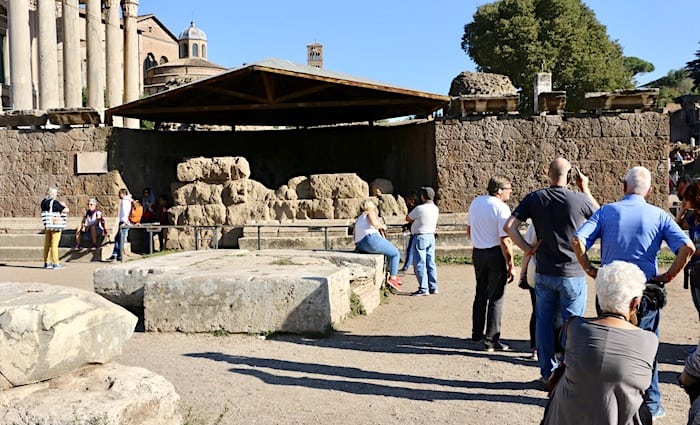
Across from the Temple of Vesta is the Temple of Caesar. In its heyday, this was the centerpiece of the Roman Forum. Dedicated to Julius Caesar and constructed by his adopted son Augustus, Julius Caesar was the first Roman deified after his death and the first to be buried in the Forum itself. For hygienic reasons, nobody could be buried within the city limits at the time, so this was a great honor.
Julius Caesar wasn’t actually considered an emperor. That honor is bestowed on Augustus. What all historians agree on, however, is that his actions led to the downfall of the Republic, which had seriously deteriorated by this point anyway. Once he was declared dictator for life, many aristocratic noblemen feared that he would try and become king. So, he was assassinated. The upheaval that followed led to the creation of the Empire.
A symbol of the Roman Empire’s power, the Temple represented the potency of the new Roman Empire and the grandeur of both Julius and Augustus. The temple is considered to be a political move by many people who were allegedly involved in the murder of Caesar. They supported the project to posture themselves as Caesar-supporters to the masses.
Address : Temple of Julius Caesar
1. The Curia (Senate House)
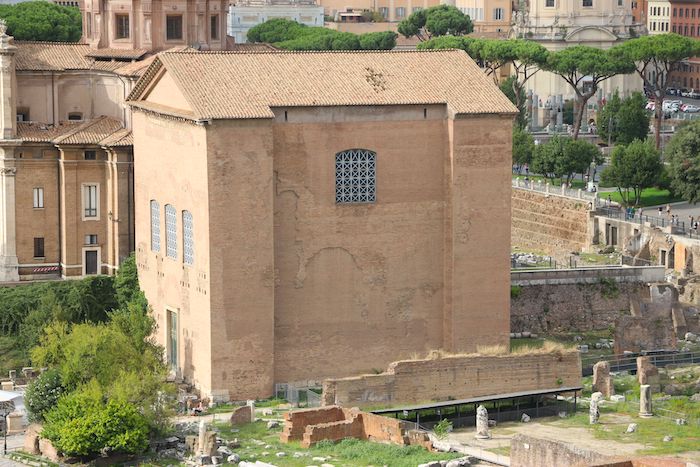
The Curia Julia or Julian Senate House is one of the most intact buildings in the Roman Forum. Unlike most others, the Curia Julia is visible in its restored state. This is due to its conversion into a church centuries later. Still, this large building was the home of the Roman Senate throughout the time of the Empire.
Many people visit thinking this was the spot where Julius Caesar was killed, but don’t be fooled! This Curia was under construction when Julius Caesar was assassinated in 44 B.C. at the Theatre of Pompey (near Largo Argentina in today’s Rome). The roof of this building collapsed in August of 2018 and luckily no one was harmed. Such a historic building is definitely one of the top things to see at the Roman Forum.
Address : The Curia

Where To Stay in Rome
Rome has a rich cultural history and many iconic landmarks to explore. Plan where to stay in the magnificent Eternal City in the best neighborhoods.
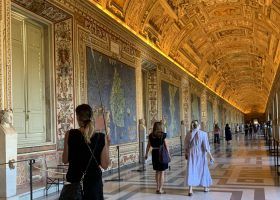
Reader Interactions
Leave a comment cancel reply.
Your email address will not be published. Required fields are marked *
- In The Press
POLICY & TERMS
- Cancellation Policy
- Terms & Conditions
- Privacy Policy
The baths of ancient Rome that you can still visit today
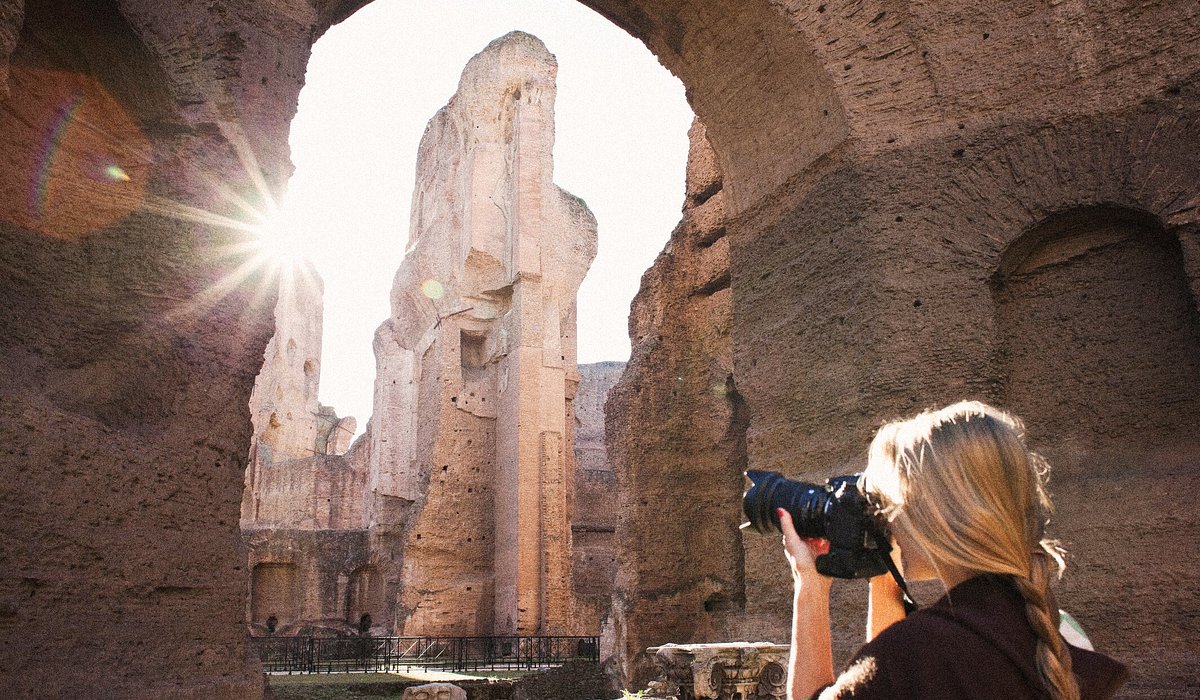
The capital of Rome once had hundreds of baths, or thermae, communal spaces of relaxation where Romans both soaked and socialized. While many of these Roman baths have since been left abandoned or destroyed over the centuries, the structures and remains of a few still stand, giving us a glimpse into the decadent bath culture of Ancient Rome.
While you might not be able to do as the Romans did and soak in the warm pools, here are some of the best-preserved baths in Rome that you can still visit and relive this ancient Roman practice.
Facts about the ancient baths of Rome
Starting with the Baths of Agrippa in 25 BC, many Roman emperors commissioned public bathing facilities, often named after the emperors who had built them. Apart from getting clean and the healing properties of the waters, above all, these Roman baths were the center of social life and activity in Rome. The Romans did all sorts of things in the baths, from eating snacks to gambling. Even politicians and the wealthy, who had marbled bathrooms in their own private residences, went to the public baths to see and be seen.
Though thermae roughly translates to mean “hot spring”, the water in most baths wasn’t naturally warm. Instead, each caldarium (a hot plunge bath) was heated by a state-of-the-art furnace and heating system. A trip to the baths usually involved a whole sequence of spa treatments, starting in the warm tepidarium (a warm room) and caldarium, and ending in the cool frigidarium (a cold pool). Some bathhouses in Rome even had gyms and libraries. The Romans sure know how to do a spa day.
As the Roman empire declined, many aqueducts and baths were left abandoned and others were looted or reused in other construction projects throughout the ages. Thankfully, there are still many of the ornate and extravagant structures that are still standing today, welcoming you through its arches to experience the charming bath culture at the height of ancient Rome.
Baths of Rome that you can visit
Baths of caracalla.

The Baths of Caracalla in Rome were commissioned by Emperor Caracalla in 212 AD and were one of the most luxurious buildings at the time with up to 1,600 Romans visiting the baths every day.
While only the huge walls and exteriors of the baths are left standing, many of the underground tunnels are still accessible and open to the public and the interiors are now a large lawn, staging plays, operas and other theatrical performances. A €10 (USD 11.40) ticket will give you access to the baths and there are also private tours that will bring you to both the complex and other attractions like the Circus Maximus , Colosseum or Aventine Hill .
Baths of Diocletian

While you won’t find any pools here, the Baths of Diocletian are one of the best-preserved structures in the city. At its peak, up to 3,000 Romans would exercise, relax, and socialize in the bathhouse every day. When the baths shut down after 230 years of operation, the complex stood half-empty for another 1,000 years until a Carthusian monastery occupied the lot in the 1560s. It eventually became what is known as the Basilica of Saint Mary of the Angels , a church originally designed by Michelangelo, built in what was once the main hall of the baths.
The Baths of Diocletian in Rome are also home to the Church of San Bernardo alle Terme and part of the National Roman Museum —all of which you can explore on a skip-the-line walking tour of the baths .
Baths of Trajan

Commissioned in 109 AD, the Baths of Trajan are one of the largest and oldest baths of Rome. Located on Oppian Hill Park right behind the Colosseum , the baths were erected on top of what was left of Emperor Nero’s Domus Aurea , a lavish palace that had been destroyed in a great fire.
Today, two parts of the baths remain visible: a semicircular wall and the Seven Halls, a complex of cisterns (nine to be accurate) that once held up to eight million liters of water.
Other ruins of ancient Roman baths
The Baths of Caracalla and Diocletian are some of the more famous baths in Rome, but there are remnants of other baths from emperors like Agrippa, Nero, and Titus that you might unwittingly stumble upon on your travels.
An arch of the Baths of Agrippa—the first public bath in Rome—stands at Via dell’Arco della Ciambella, right behind Largo di Torre Argentina . The Baths of Nero left behind two columns on Via di Sant’Eustachio, which is west of the Pantheon . And, just like the Baths of Trajan, a few structures from the Baths of Titus can be spotted on Oppian Hill Park.
Can you bathe in the ancient baths of Rome?

While you can’t bathe in the ancient Roman baths, you can take a day trip to Grosseto in Tuscany to visit the Baths of Saturnia , a group of hot springs that have been around since pre-Roman times. Soak in the bubbling thermal baths or head downstream to the Mulino Waterfalls , where you can relax in the cascading thermal pools on this full-day tour .
Recommended tours and activities

More like this:
- Fiumicino or Ciampino Airport: Which is the best airport to get to Rome?
- 7 days in Italy: How to see Venice, Florence and Rome in a week
- TripMakers: Vatican Tour Guide Francesca Romana Oddi


A Family Guide to Rome: 10 things to do with kids
T he ancient city of rome has so much to offer for kids. education, good food, and beautiful artwork around every corner. taking kids to rome can be amazing. just follow this guide to rome with kids., a family guide to rome: 10 things to do in rome with kids.
Rome! One of the most visited cities in the world, full of great food, ancient sites, history and incredible works of art. There is also so much for families to see and do! We spent one week in Rome, but could have accomplished all we did in 4-5 days if we wanted to.
Where to Stay in Rome
Deciding where to stay in the Eternal City can be tough. It’s built on hills and distances can be deceiving. You want to stay close to the sites you plan on seeing so you won’t spend your whole trip walking or driving. I’ve written this detailed guide to the best places to stay in Rome that will be helpful.
The Best Things to do in Rome with Kids
We did so much during our time in Rome and our kids honestly loved it all. The abundance of gelato didn’t hurt either. Here are our top 10 activities for your family trip in Rome:
1. Colosseum Tour with Dark Rome
I’ve never really been one for guided tours, preferring to wander at my own pace, which is also one of our travel tips whenever we go somewhere. But I’ve learned over the years that if I’m spending the time and money to take my family to these famous historical sites, then spending the extra time and money to take a tour is well worth it. We always try to book kid-friendly family tours where we can. The tour of the Colosseum with Dark Rome was fantastic.
Our guide was so great with the kids, giving them a good mix of fun and history. We all learned a lot and had lots of fun. The big bonus about booking tours is that you get to skip the lines!
Our guide was so great with our kids, even holding up little man to get a better view of the ground floor.
Lots of games to learn about ancient Roman history!
I suggest doing a bit of ancient Roman studies before going to Rome so your kids can make a connection when they are there.
2. Vatican Museum and St. Peter’s Basilica
I wish we would have done a bit more research before visiting the Vatican Museum and St. Peter’s. We had tons of tour sales people trying to get us to sign up for different tours and tickets here in Vatican City. It was so complicated and by the time we finished, I swore I would write a clear post about this so other families could be helped!
We ended up buying more expensive “skip the line” tickets, which I would never do again. We had to pick up the tickets in front of St. Peter’s, then walk a mile to the actual entrance of Vatican museums (there wasn’t even a line when we got there), then had to wait in a separate line to trade in our skip the line tickets for the “real” tickets! The whole situation was ridiculous! So I’m going to break it down for you here:
-Buying tickets to the Vatican Museum is the only way to see Michelangelo’s Sistine Chapel. You have to walk through long halls (4 miles) of the museum, with interesting (and odd) artifacts and beautiful artwork to get there. You have to pay to enter the museum. It was 16 Euros for adults and 8 Euros for children when we went. The museum is closed on Sundays. You can find hours, prices and more here.
-You do NOT have to pay to enter St. Peter’s Basilica. There is a line, but it moves quickly and is worth it.
You can find a more adult explanation of why all the genitals are missing in the Vatican here.
You can learn more about cheap Vatican tours here.
3. Campo de Fiori
This open-air farmers’ market in the heart of Rome is open every day and constantly buzzing with fresh fruits and vegetables, beautiful flowers, meats, cheeses, pastas in all sorts of shapes, and more!
It’s also a nice place to take a break in this public monument with a view of the ruins of ancient Rome. The kids loved all the sites, sounds and smells of the market! It’s also really fun to wander this piazza at night.
4. Trastevere
Wandering the streets of Trastevere gives you a taste of what Rome without all the tourist hustle and bustle is like. Old buildings, laundry strung across tight alleyways, bikes and scooters lining the streets, locals smoking out of windows, wisteria hanging everywhere and delicious cafes!
We ate at Grazi et Graziele…delicious!
5. Fountains
Rome is full of beautiful fountains! The most famous and magnificent probably being the Trevi Fountain. When you ever visit Rome, make sure you check them out. It’s crowded and crazy, but a must!
6. Villa Borghese
Besides gelato, this was probably the biggest winner for your younger kids and older kids. Rome’s central park has so many school age kids things to do here.
You can ride a carousel, rent a golf cart or Segways, see a Shakespearean play at a replica of the globe theater, play in a fountain, or just stroll through the beautiful, lush gardens (with gelato in hand of course)!
My kids really had fun roaming around here, I definitely recommend this as one of the kid-friendly attractions you can find in the area. It’s a great way to keep them entertained with many family friendly activities!
If you’re visiting Rome with a baby or toddler, this is a great place to go in Rome to let them run off some energy before bedtime or even a good place to escape the city sounds for a nice stroller nap!
7. Pantheon/Piazza Navona
I was surprised at how you can just stumble upon ancient ruins in Rome and the Pantheon is no exception. It’s just right there in the middle of Rome city center! And if you go around the corner, you’ll hit piazza Navona which has an amazing church. We lucked out and saw a youth choir sing there!
The best thing about piazzas is that there are usually no cars so the kids can run wild and dip in the fountain!
8. Take an UBER Tour
My very favorite thing to do in Rome with kids, besides eating of course, is an UBER Tour . We were exploring Trastavere and it started to drizzle. We were all a little worn out from a week of sightseeing and a little out of shape from a week of eating! We were just going to take an UBER back to our AirBnB, but saw “UBER Tour” pop up and we thought we’d give it a try. Our nice driver picked us up in a huge van that fit all 8 of us. He drove us around for about an hour and a half. He took us to all sorts of places that we didn’t even know existed!
Small, old churches with amazing art, huge fountains overlooking the city, a secluded orange garden, and much more. I have limited pictures, because my babies both fell asleep in the back seat on my lap. I was totally happy to enjoy the views from the window. Our driver would stop at each spot, drop us off and make a loop to pick us up 5-10 minutes later. No parking, or waiting for the next tour bus and no getting out of the car if we didn’t want to. The best part is that it is totally customizable. We just said, we’ve seen all the touristy stuff, show us something new! And he sure did. I thought it would also have been a great thing to do on your first day in Rome so you can get a feel for what you want to see and do and also to get a layout of the city, which is much more walkable than I originally thought. If you decide to do this, you can sign up for UBER and get $20 off HERE.
9. Drool Over Cars
So many adorable cars in italy! Just wander and check out the many tiny cars, beautiful cars and scooters (also known as bees) and buzz all around the bumpy streets of Rome!
Your kids and especially your boys would love seeing these vintage-looking cars on the road!
For reference, here’s how small these cars are! Aren’t they so adorable?!
I mean, what is the point of going to Rome if you’re not going to EAT!? Pizza, pasta, cannoli, gelato …need I say more.
I found most of the restaurants to be about the same in quality and price. Here’s a tip I use in all big cities to find those hidden gems and avoid tourist traps. Go to a busy tourist place then head directly 2-3 blocks OUT of that area.
Walk down little alleyways if you must. Also, using an app like Yelp is a huge help. Our favorite gelato stop was Gelato del Teatro. Check out my guide to finding the best gelato in Italy!
We probably went about 5 times during our week there. But whatever you do, don’t leave Rome without sitting in a piazza in the sunshine and gobbling up something tasty and then wandering down twisted, narrow cobblestone streets, gelato in hand, dodging scooters as you soak up the smell of the Wisteria growing everywhere and the bright, dripping laundry strung from the windows!
Best Tours in Rome For Kids
Rome is an amazing city to explore! It’s filled with ancient history, stunning architecture, and beautiful culture. If you’re visiting Rome with kids, there are so many things to do and see. From visiting the Colosseum, Roman Forum, and Pantheon to exploring the Trevi Fountain, there are endless activities for young ones.
To make the most out of your visit, here are some of the best Rome tours for families traveling with kids!
Ancient Rome Tour for Kids: Discovering the Colosseum and Roman Forum
As I’ve mentioned earlier, from all the tours we’ve taken during our Rome trip, having a guided tour of the Colosseum was so worth it!
Ancient Rome Tour for Kids is a family-friendly guide tour you can take to one of Rome’s most famous landmarks. This tour will take you back in time as your guide and tour leader tells stories about the Colosseum, Roman Forum, and famous archaeological sites nearby. These are what you can look forward to:
- Explore the Colosseum and Roman Forum with hands-on, interactive activities
- Led by a scholar specially trained to work with children
- Colosseum and Roman Forum & Palatine Hill
It’s a 2.5-hour tour by a licensed guide for kids and adults alike, perfect for those who are visiting Rome with kids.
Underground Rome Tour
The Underground Rome Tour is another great tour for kids, offering a unique experience. Kids will journey underground to explore the mysteries of Ancient Rome beyond what can be seen from the surface of the city.
It’s a 3-hour tour joined by an expert archaeologist where you can expect to:
- Explore the subterranean depths of Rome
- Led by an expert archaeologist
- San Lorenzo in Lucina and Vicus Caprarius
Vatican Tour for Kids
Another top-rated tour for kids is the Vatican Tour for Kids . This three-hour tour is guided by a family-friendly Ph.D. or MA-level art historian who will lead you through the famous Vatican Museums, Sistine Chapel, and St. Peter’s Basilica.
These are some activities you can look forward to:
- Discover the stunning artworks and frescoes of the Vatican Museum collections
- Accompanied by a licensed guide, specializing in Classical History
- Vatican Museums and Sistine Chapel
Rome Pasta-Making Class: Cook, Dine & Drink Wine with a Local Chef
What a great way to make your visit to Rome extra special by joining a cooking class while in Rome! The Rome Pasta-Making Class lets you experience an authentic Italian cooking session with a local chef.
Here are the highlights of what you can get from this tour:
- Learn how to make fettuccine and ravioli from scratch with a professional chef at a private cooking school in Rome’s Trastevere neighborhood.
- Get to know your chefs and fellow pasta makers over prosecco and aperitivi.
- Enjoy a live demonstration of the fine art of gelato making.
- Have a relaxed, fun experience with a small group of 14 participants maximum.
- Gain insider tips on Roman cuisine from a local chef so you can make the most of every meal during your stay.
It’s an educational yet fun-filled tour that will surely make memories with your kids.
Have you been to Rome? What are your favorite things to see, do and eat? We’d love to hear from you!
More Resources
Rome in a Day
Rome in 3 days
Cinque Terre
The Ultimate Guide to Italy
How to Find the Best Gelato in Italy
The Best Places to Visit in Italy
10 Day Italy Itinerary
If you would like to follow along with us day by day you can follow @wanderlust.crew on Instagram or on Facebook or on Twitter or sign up for our newsletter! We would love to hear from you!
The post A Family Guide to Rome: 10 things to do with kids appeared first on Wanderlust Crew .
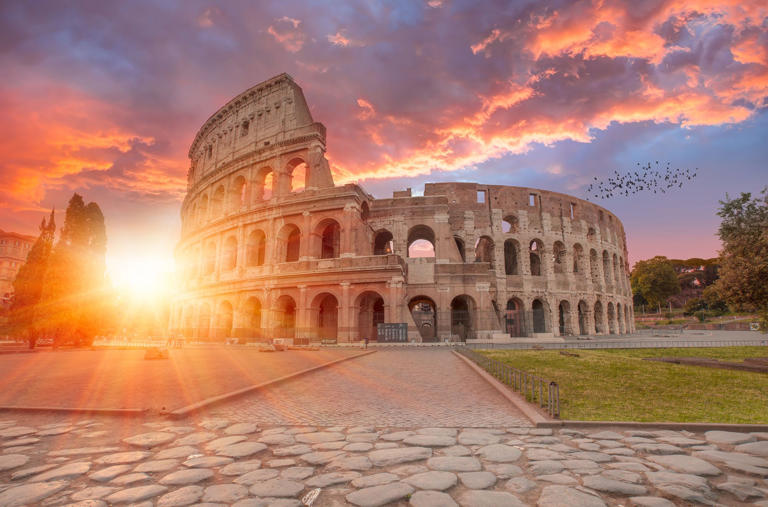

IMAGES
VIDEO
COMMENTS
4. Appian Way. Built around 312-264 BC. Appian Way (Via Appia Antica) is an ancient road that connected the city of Rome to Brindisi in Southern Italy, some 563 km (350 miles) away. Its main purpose was to help the army with the expansion of the Roman Empire.
Fantastic archaeological sites to visit in Rome Colosseum. Impossible not to start with the Colosseum.Arguably the most popular site in all of the city and the first landmark everyone rushes to, a visit to the Colosseum is a must for every first-timer.. A mighty amphitheater erected in the 1st century, this is where gory shows and fights between gladiators and gladiators against wild animals ...
Another Roman ruin to visit in Rome is the Ara Pacis monument. The Roman Senate commissioned this Altar of Peace in 13 BC to honor Emperor Augustus. It's a piece of Roman propaganda. Augustus had just defeated the barbarians. His victory marked the beginning of the Pax Romana, a 200 year golden age where arts and architecture flourished. ...
2. Roman Forum and Palatine. The oldest of Rome's fora, the Foro Romano (Roman Forum), was once the centre of state ceremony, commerce, law and bureaucracy. Above the Colosseum to the west (and ...
Colosseum (Colosseo) U.S. News Insider Tip: A normal ticket includes the Colosseum, Roman Forum and Palatine Hill (valid for 24 hours) and you can visit all three in one day. It doesn't include a ...
1. Places to visit: Colosseum The number 1 attraction of Rome is the Colosseum; the large amphitheatre that housed 65,000 spectators in Roman days.Gladiators battled each other as well as wild animals in the Colosseum's arena, which is considered one of the seven modern wonders of the world.
Tempio di Vesta. Ancient Rome. This circular temple on the Roman Forum was dedicated to Vesta, the popular goddess of home, hearth and family. The Vestal Virgins, who lived next door in…. 1. 2. Discover the best attractions in Ancient Rome including Colosseum, Roman Forum, and Palatino.
Rome's Top Monuments and Attractions. 13. Trajan's Column. Trajan's column is an incredible monument and surviving piece of propaganda from the second century A.D. The column has an incredible history and plays a very important role in our ability to put together ancient timelines. Standing at 114 feet tall (35 meters) and constructed ...
Get planning now with our ten favorite experiences in Rome. 1. Lose yourself in Ancient Rome (but not all in one day) Any Italian will tell you how downright anarchic Rome is and immediately after, every one of them will say, "but Rome is Rome.". There is simply no place like it in the world, and the only thing to do is abandon yourself to ...
Piazza della Rotonda, 00186 Roma RM, Italy. Phone +39 06 6830 0230. Web Visit website. Rome's Pantheon, the temple of all the gods, was built between 118-125 A.D. by Emperor Hadrian. In the 7th century it was made into a church by early Christians and now is lined with tombs. Go inside to see the spectacular dome.
Pantheon. Built as a pagan temple to the gods, the Pantheon is Rome's best-preserved ancient site, perhaps because it was later consecrated as a church. It was originally constructed by Augustus ...
The Pyramid of Cestius is the tomb of affluent magistrate Caius Cestius which was built in the 1st century BC in Rome, Italy. Constructed of white marble and brick, this ostentatious 35-metre high tomb was built in this style due to the popularity of all things Egyptian which swept through Rome after Egypt was incorporated into the Empire.. For those embarking on the Grand Tour during the 18th ...
Summing Up: 22 Best Places to Visit in Rome. Rome is a city that offers a wealth of attractions that make a Rome tourist map hard to read. From the Roman Forum to the stunning art of the Vatican Museums, the 22 exciting Rome attractions will leave you breathless.
Here's the list of famous Roman ancient sites: The Colosseum. The Colosseum or Coliseum is perhaps the grandest construction in the history and culture of ancient Rome. It was created around 70-72 A.D. by Emperor Vespasian of the Flavian dynasty as a gift to the Roman people.. Moreover, the site had been the most prestigious place for entertainment in the capital and empire for four centuries.
3. Arch of Constantine. Situated between the Roman Forum and the Colosseum, the majestic Arch of Constantine (Arco di Costantino) is the last great monument of Imperial Rome. It was erected in AD 315 to commemorate Emperor Constantine's victory over his co-emperor Maxentius at the Milvian Bridge in AD 312.
2. Vatican City Vatican City . The Vatican is the smallest independent state in the world, with an area of less than half a square kilometer, most of it enclosed by the Vatican walls.. Inside are the Vatican palace and gardens, St. Peter's Basilica, and St. Peter's Square, an area ruled by the Pope, supreme head of the Roman Catholic Church.This compact space offers a lot of things to see ...
Ready? 🙂. 1 - Colosseum. The Colosseum was the most extensive amphitheater in the Roman Empire, begun by Vespasian in 72 AD. It was used to show gladiator fights and hunting scenes with exotic and ferocious animals. Nowadays it is possible to visit the Colosseum and understand how the underground theater system worked, with freight elevators, ramps, and traps that served to bring animals ...
3. Visit the legendary birthplace of Rome's founders at Palatine Hill. Palatine Hill is an open-air museum with a special place in Rome's origin myth! This ancient area of Rome—considered to be one of the oldest parts of the city—is believed, in Roman mythology, to be the site where Remus and Romulus were found.
6. Park of the Aqueducts. Park of the Aqueducts (Parco degli Acquedotti in Italian) is part of the Appian Way Park and Rome's largest greenspace. It is a very peaceful place that can be a bit hard to get to but it's certainly worth it. It is what you think it is: A park with ancient Roman aqueducts running through it.
So prepare to embark on a virtual pilgrimage through time as we guide you through the must-visit landmarks of ancient Rome, each holding a piece of the city's extraordinary past. Top 3 historical sites in Rome, Italy. The ancient Roman landmarks are not mere historical relics but integral components of the city's urban fabric. Each of these ...
The hill offers panoramic views of the Roman Forum, Colosseum and Arch of Constantine making it a great place to visit to appreciate Rome's ancient landscape. Ostia Antica, near Rome Ostia Antica, located just 30 minutes from Rome, offers a glimpse into everyday life in ancient Roman life.
13. Via Sacra. The road running through the arch is the Via Sacra or sacred way. It was an important road as you can guess by its name. In ancient Roman times, triumphant marches were held after big victories, which happened often. These marches would travel down the Via Sacra and into the city.
Image: adisa / Getty Images. The Baths of Caracalla in Rome were commissioned by Emperor Caracalla in 212 AD and were one of the most luxurious buildings at the time with up to 1,600 Romans visiting the baths every day. While only the huge walls and exteriors of the baths are left standing, many of the underground tunnels are still accessible ...
A Family Guide to Rome: 10 things to do in Rome with kids. Rome! One of the most visited cities in the world, full of great food, ancient sites, history and incredible works of art.